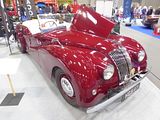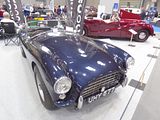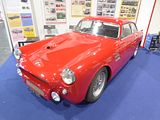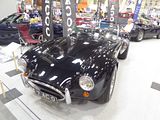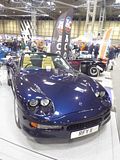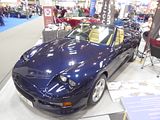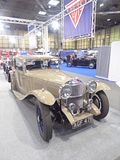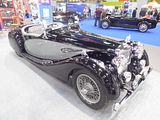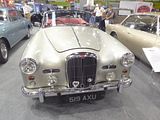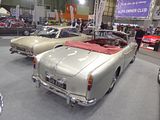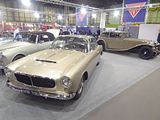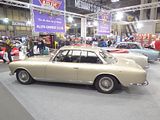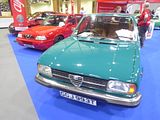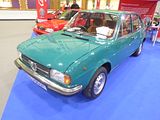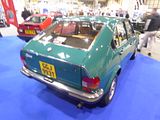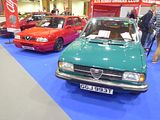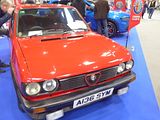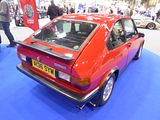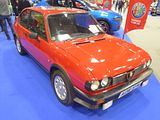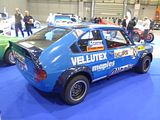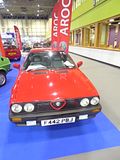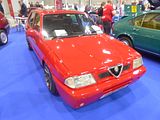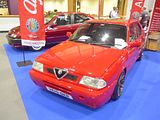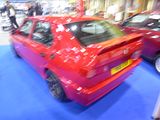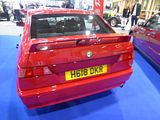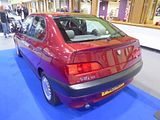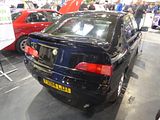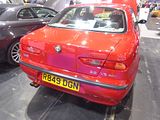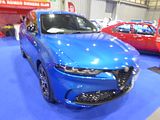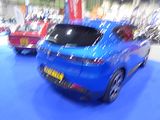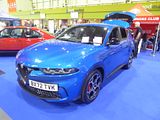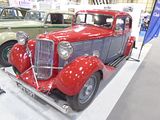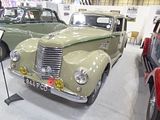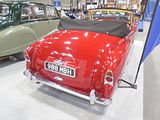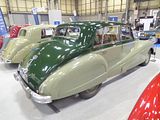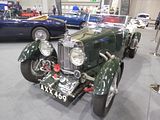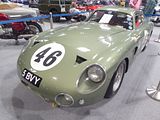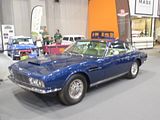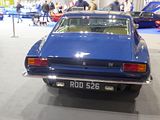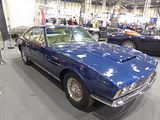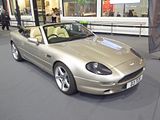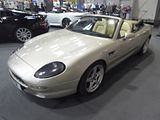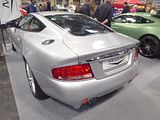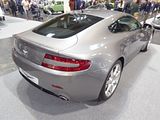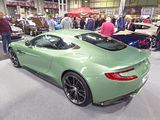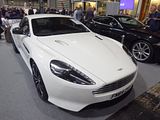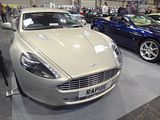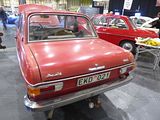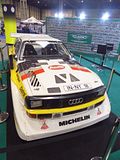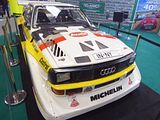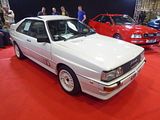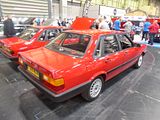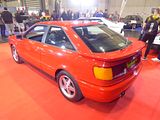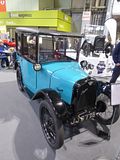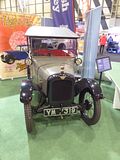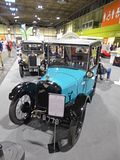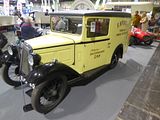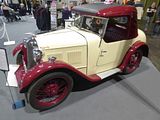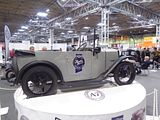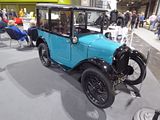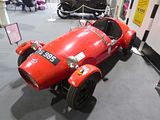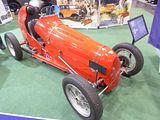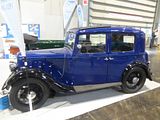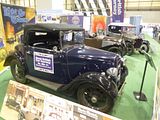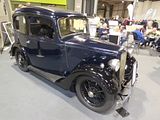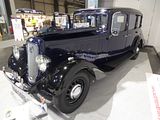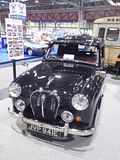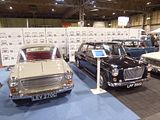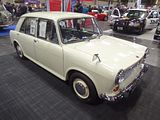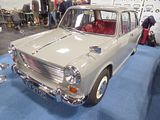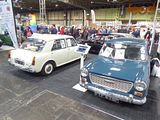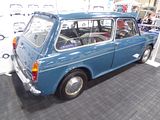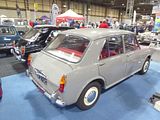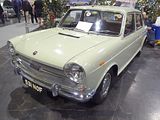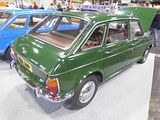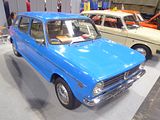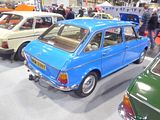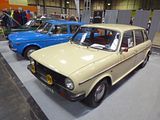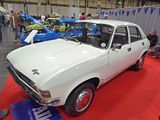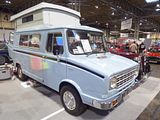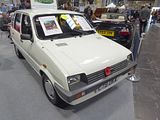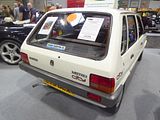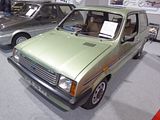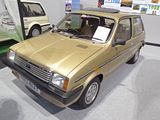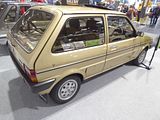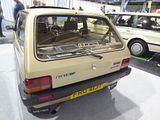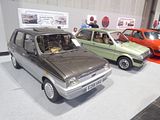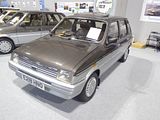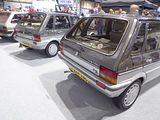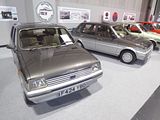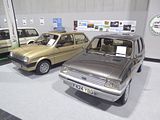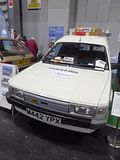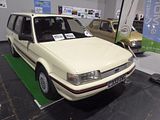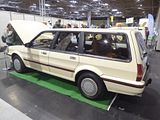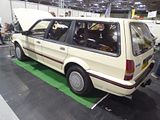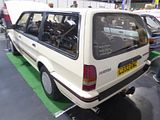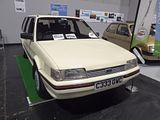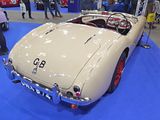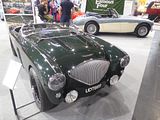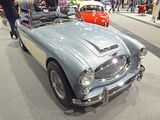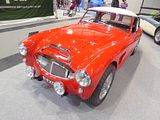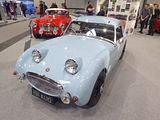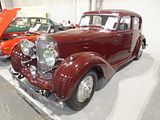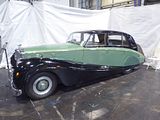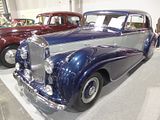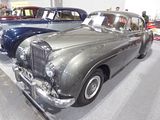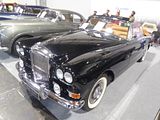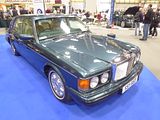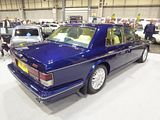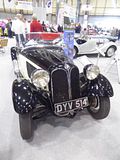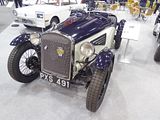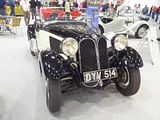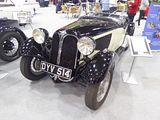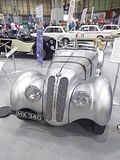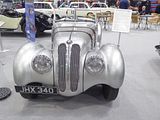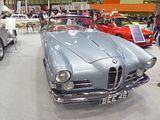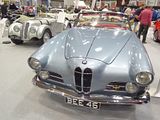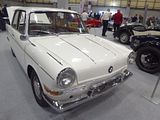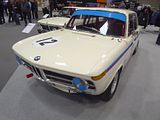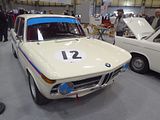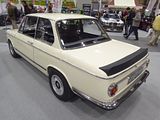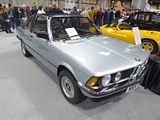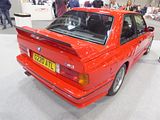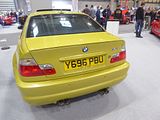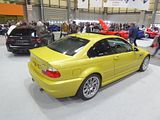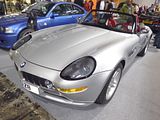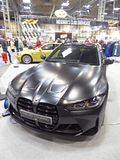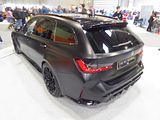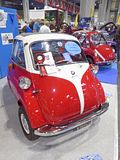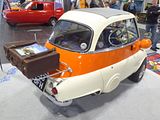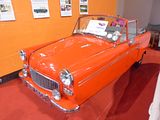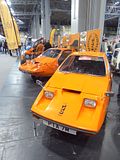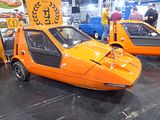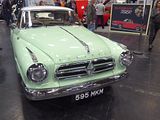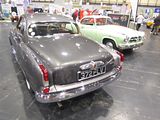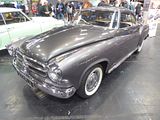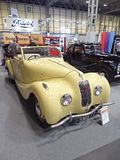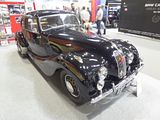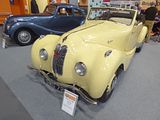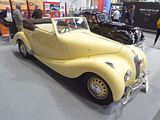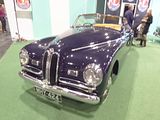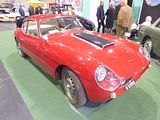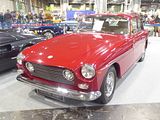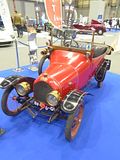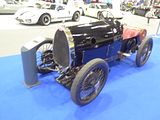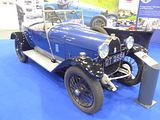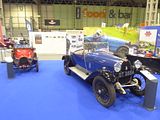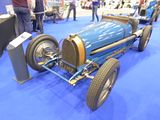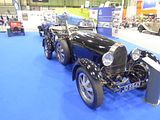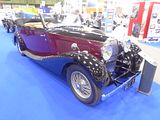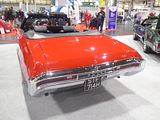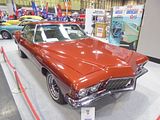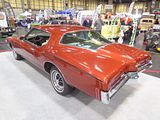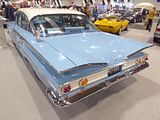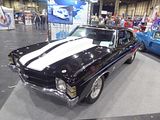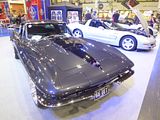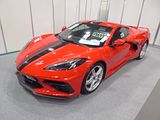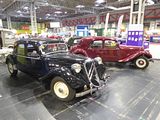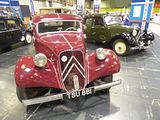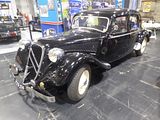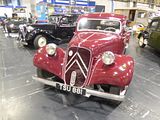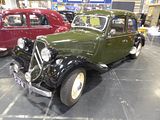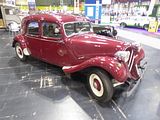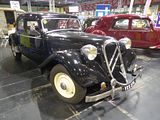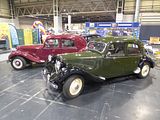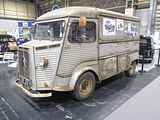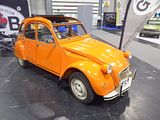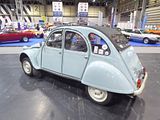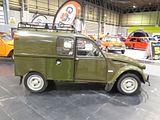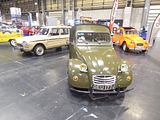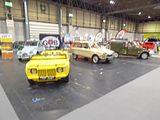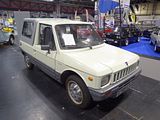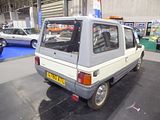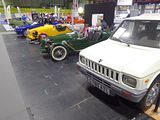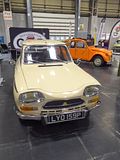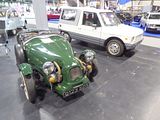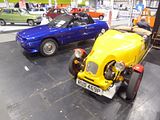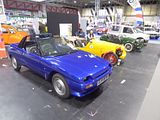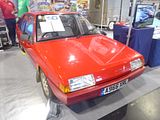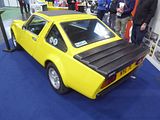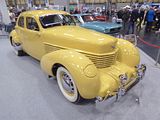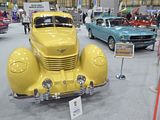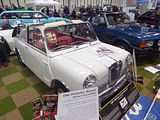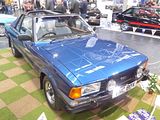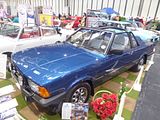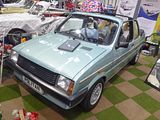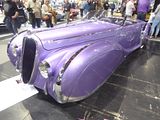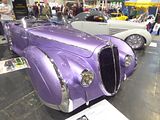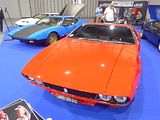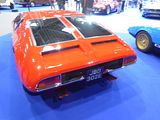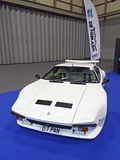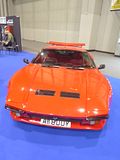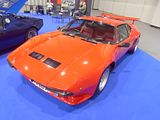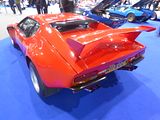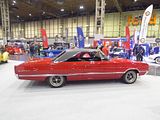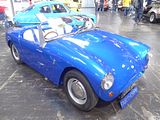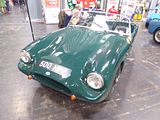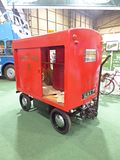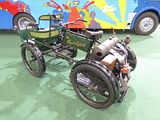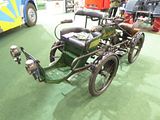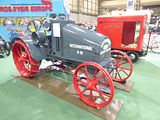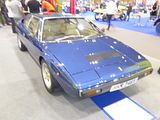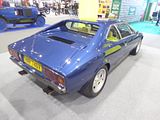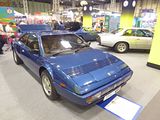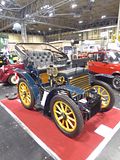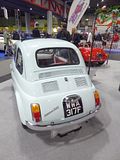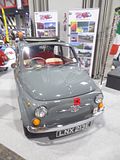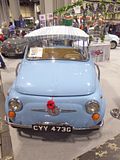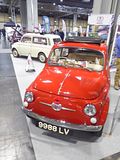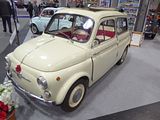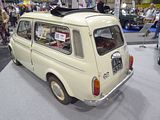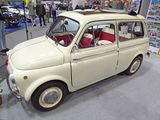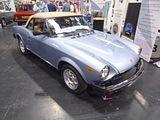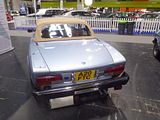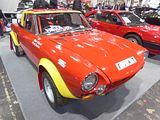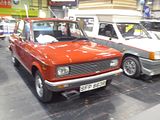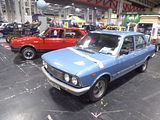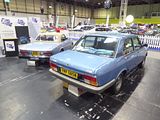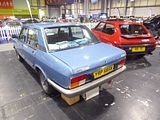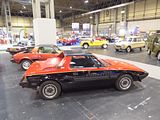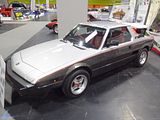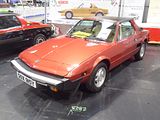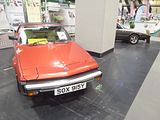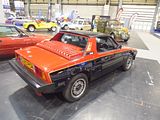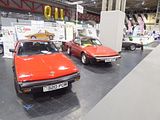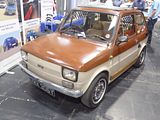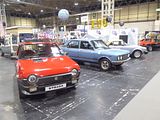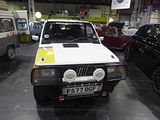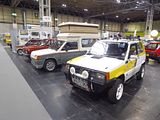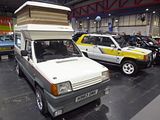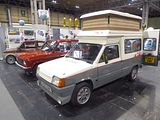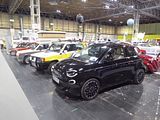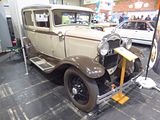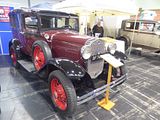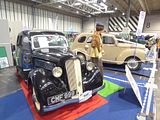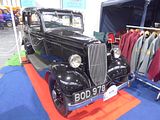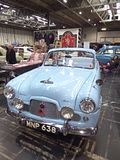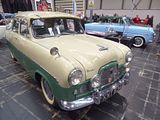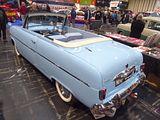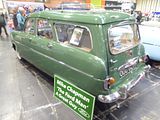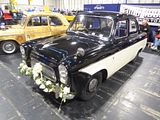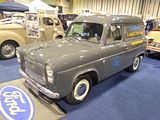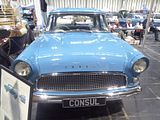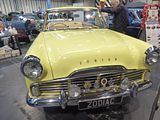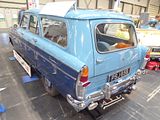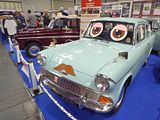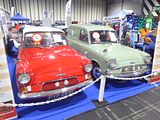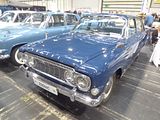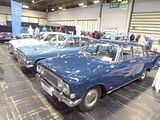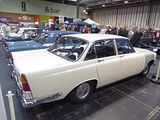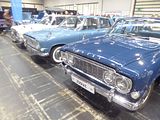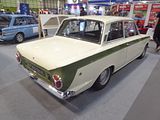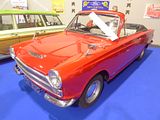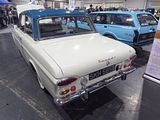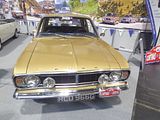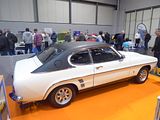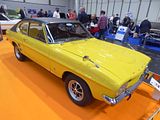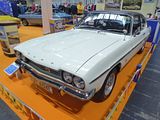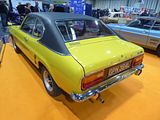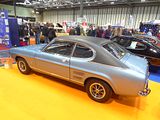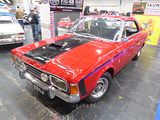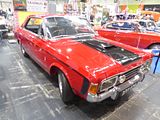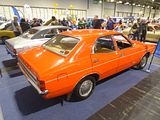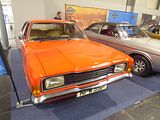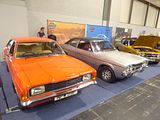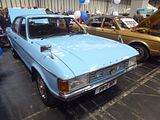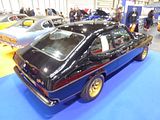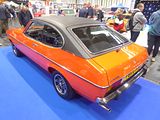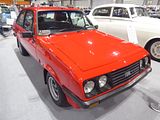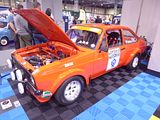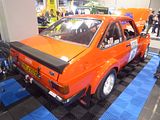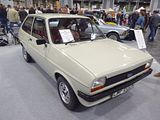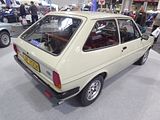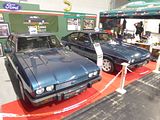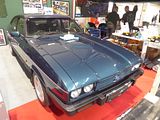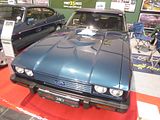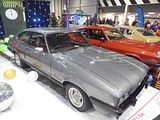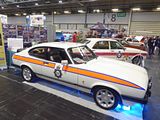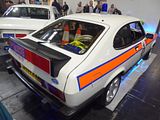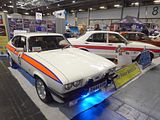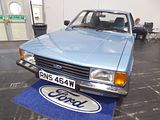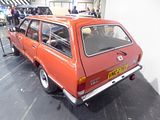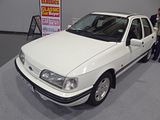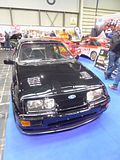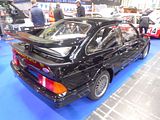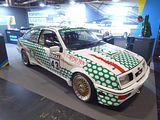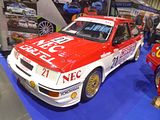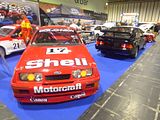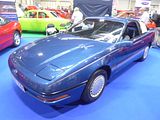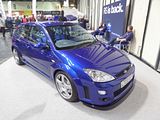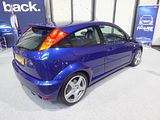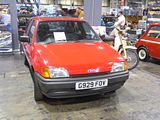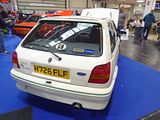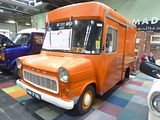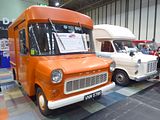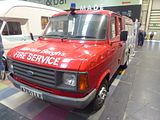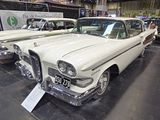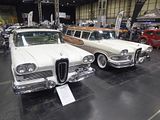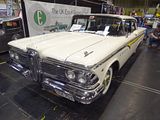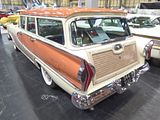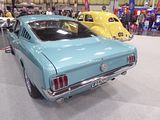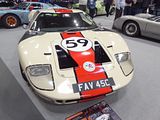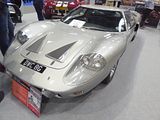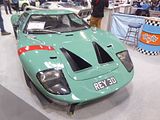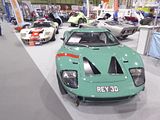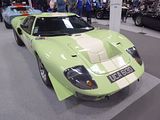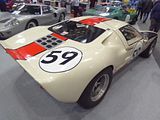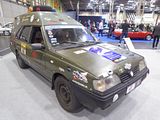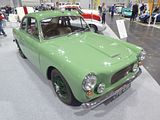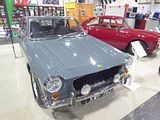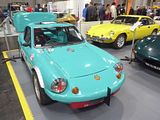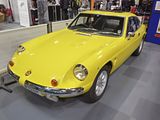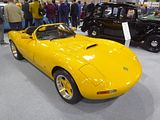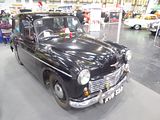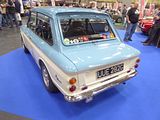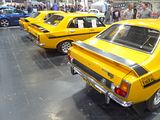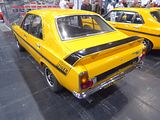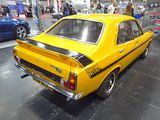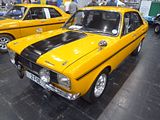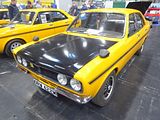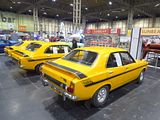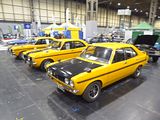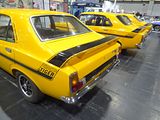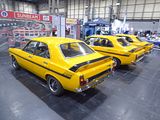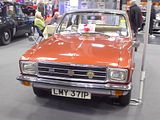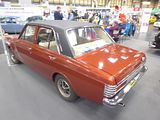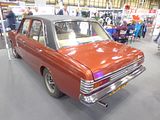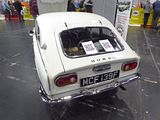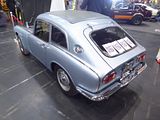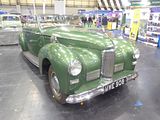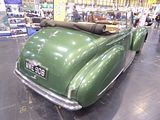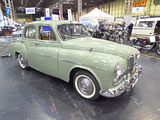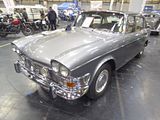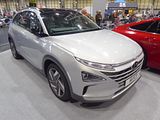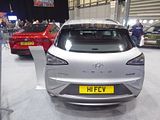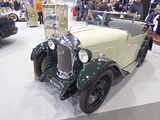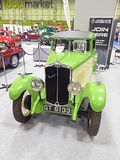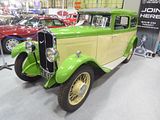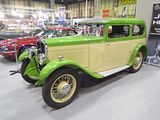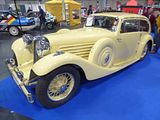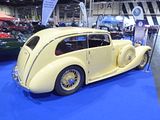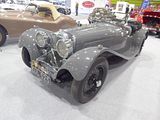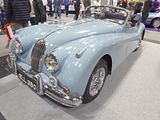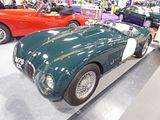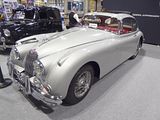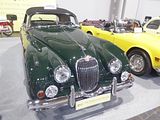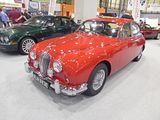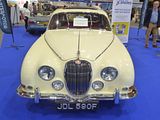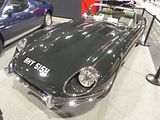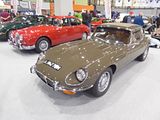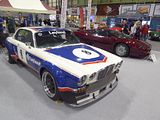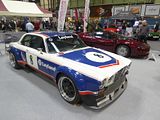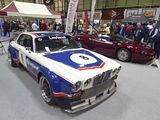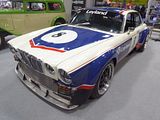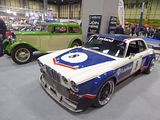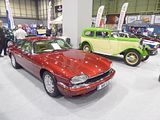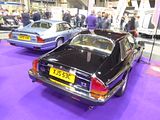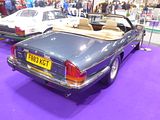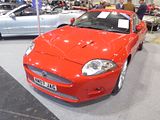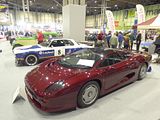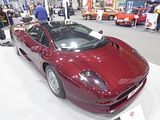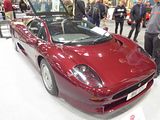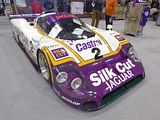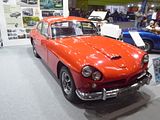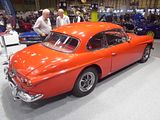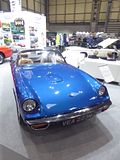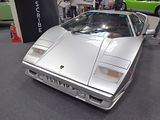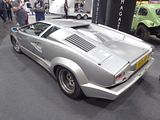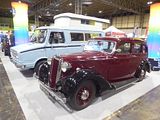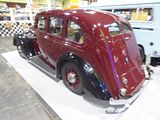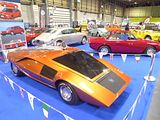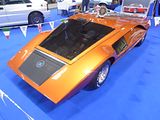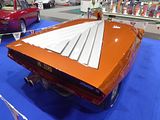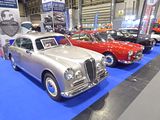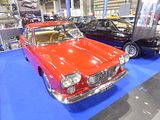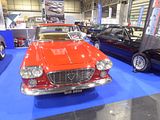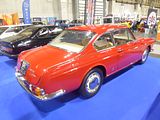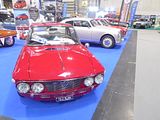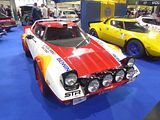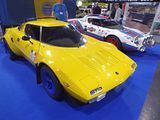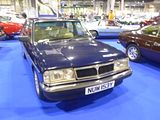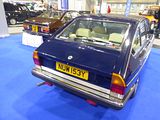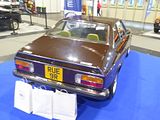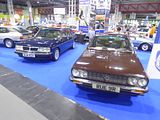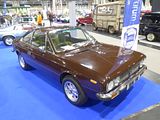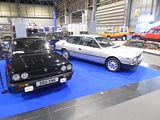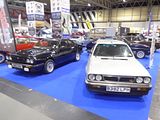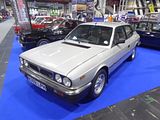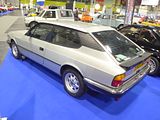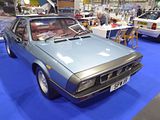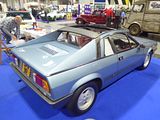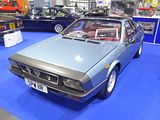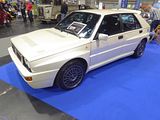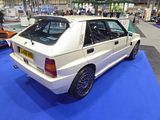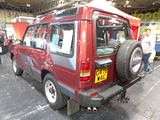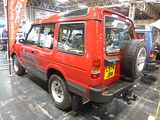The NEC Classic Car Show is a well established fixture in the schedule of events that really does mark the end of any sort of large outdoor gathering, in recognition of the fact that the hours of daylight are short and the weather is generally pretty unfavourable to classic cars by early November. For many years now, this has been the largest indoor assembly of classic cars in the UK, with the show occupying several of the halls at the NEC Complex. It is a real struggle to see it all in one day, though if you are determined and do not linger to chat much, it can just about be done, as I proved at the 2022 edition, as diary logistics meant that the friend who usually accompany me to the event all went on the first of the three days over the which the event takes place, a Friday, and I went along on the Saturday. It really does not seem to make much different from a crowd point of view which day you select, this event will be busy regardless, though it does empty out somewhat in the last couple of hours of the day which does ease things somewhat for the photographer. Pretty much every marque you’ve heard of, and some that you may not have come across before are here, though I do have it on reliable authority that if a Club wants to make a first appearance here, it is difficult to get in and they tend to get relegated to a corner somewhere, but the combination of a certain amount of moving Clubs around to different locations and the fact that most will make sure that they bring different cars each year means that the event does feel fresh even to those who have attended in several consecutive years, as I have. As well as the Car Club stands, there are a large number of trade stands and there is a sizeable autojumble and Silverstone Auctions have an extensive area of Hall 2 for a mouth-watering array of cars that they sell off during the event, so there really is something for everyone here. I failed to get into the auction area, as I ran out of time but I think I saw pretty much everything else as the 1200 photos in this report will evidence. Enjoy!
AC
The AC 2-Litre was produced between 1947 and 1956. Two and, from 1952 four-door saloons were sold. In addition, as from 1949, a small number of drophead coupés and “Buckland” tourers were produced. The car’s wetliner, aluminium cylinder block, six-cylinder 1991 cc engine was the unit first offered by the company in the AC 16, back in 1922. However, by 1947 the engine was fed by three SU carburettors, and boasted a power output of 74 bhp, increased again in 1951 to 85 bhp which was more than twice the 35 bhp claimed for engine’s original commercial application. The aluminium-panelled body on a wood frame was fitted to a conventional steel chassis with rigid axles front and rear with semi-elliptic leaf springs with, for the first time on an AC, hydraulic dampers. Until 1951 the car had a hybrid braking system, hydraulic at the front and cable at the rear with 12 in (305 mm) drums. The car changed very little during its ten-year production run, though the wheel size did increase slightly to 16 in (406 mm) in 1951. The AC 2-litre was outlived by its engine, which continued to be offered in other AC models until 1963.
AC had come back to the market after the Second World War with the staid 2-Litre range of cars in 1947, but it was with the Ace sports car of 1953 that the company really made its reputation in the post war years. Casting around for a replacement for the ageing 2-Litre, AC took up a design by John Tojeiro that used a light ladder type tubular frame, all independent transverse leaf spring suspension, and an open two seater alloy body made using English wheeling machines, possibly inspired by the Ferrari Barchetta of the day. Early cars used AC’s elderly 100 bhp two-litre overhead cam straight-six engine (first seen soon after the end of the First World War), which, according to a 1954 road test by Motor magazine, gave a top speed of 103 mph, a 0–60 mph in 11.4 seconds and a fuel consumption of 25.2 mpg. It was hardly a sporting engine, however, and it was felt that something more modern and powerful was required to put the modern chassis to good use. Joining the Ace in 1954 was the Aceca hard top coupé, which had an early form of hatchback rear door but used the same basic timber framed alloy body. From 1956, there was the option of Bristol Cars’ two-litre 120 bhp straight-six with 3 downdraught carburettors and slick four-speed gearbox. Top speed leapt to 116 mph with 0–60 mph in the nine second bracket. Overdrive was available from 1956 and front disc brakes were an option from 1957, although they were later standardised. In 1961 a new 2.6-litre straight-six ‘Ruddspeed’ option was available, adapted by Ken Rudd from the unit used in the Ford Zephyr. It used three Weber or SU carburettors and either a ‘Mays’ or an iron cast head. This setup boosted the car’s performance further, with some versions tuned to 170 bhp, providing a top speed of 130 mph and 0–60 mph in 8.1 seconds. However, it was not long before Carroll Shelby drew AC’s attention to the Cobra, so only 37 of the 2.6 models were made. These Ford engined models had a smaller grille which was carried over to the Cobra.
This is a Greyhound, effectively a 2+2 version of the better known Ace and Aceca. It was announced for the opening of the Motor Show in October 1959. The car had a two-door, four-seater aluminium body, and inherited most of the technical components of the Ace and Aceca but it had a wheelbase 10 inches or 250mm longer and coil springs in place of a transverse leaf spring at the front. A variety of engines were used, including the AC 4 cylinder, Bristol 4 cylinder and Ford 6 cylinder units as featured in the Ace. Just 83 cars were made before production ceased in 1963.
There are so many replica and recreation examples of the Cobra that it is tempting to assume that whenever you see one, that is what it is. Occasionally, of course, the car before you is actually one of the original ones from the 1960s and that is the case with this fabulous Cobra 289. Like many British manufacturers, AC Cars had been using the Bristol straight-6 engine in its small-volume production, including its AC Ace two-seater roadster. This had a hand-built body with a steel tube frame, and aluminium body panels that were made using English wheeling machines. The engine was a pre-World War II design by BMW which by the 1960s was considered dated. In 1961 Bristol decided to cease production of its engine. In September 1961, American retired race car driver and automotive designer Carroll Shelby wrote to AC asking if they would build him a car modified to accept a V8 engine. Bristol engines for the AC Ace two-seater sports car had recently been discontinued so AC agreed, provided a suitable engine could be found. Shelby went to Chevrolet to see if they would provide him with engines, but not wanting to add competition to the Corvette they said no. However, Ford wanted a car that could compete with the Corvette and they happened to have a brand new engine which could be used in this endeavour: the Windsor 3.6-litre (221 cu in) engine – a new lightweight, thin-wall cast small-block V8. Ford provided Shelby with two engines. In January 1962 mechanics at AC Cars in Thames Ditton, Surrey designed the “AC Ace 3.6” prototype with chassis number CSX2000. AC had already made most of the modifications needed for the small-block V8 when they installed the 2553 cc (156 cu in) inline 6 Ford Zephyr engine, including the extensive rework of the AC Ace’s front end bodywork. The only modification of the front end of the first Cobra from that of the “AC Ace 2.6” was the steering box, which had to be moved outward to clear the wider V8 engine. The most important modification was the fitting of a stronger rear differential to handle the increased engine power. A Salisbury 4HU unit with inboard disc brakes to reduce unsprung weight was chosen instead of the old E.N.V. unit. It was the same unit used on the Jaguar E-Type. After testing and modification, the engine and transmission were removed and the chassis was air-freighted to Shelby in Los Angeles on 2 February 1962, By this time the small-block’s displacement was increased to 4.7 L (289 cu in). Shelby’s team paired this engine along with a transmission into CSX2000, in less than eight hours at Dean Moon’s shop in Santa Fe Springs, California, and began road-testing. A few changes were made to the production version: The inboard brakes were moved outboard to reduce cost; the fuel tank filler was relocated from the fender to the centre of the trunk; the trunk lid had to be shortened to accommodate this change. AC exported completed, painted, and trimmed cars (less engine and gearbox) to Shelby who then finished the cars in his workshop in Los Angeles by installing the engine and gearbox and correcting any bodywork flaws caused by the car’s passage by sea. A small number of cars were also completed on the East Coast of the US by Ed Hugus in Pennsylvania, including the first production car; CSX2001. The first 75 Cobra Mk1 models (including the prototype) were fitted with the 4.3 L (260 cu in). The remaining 51 Mk1 models were fitted with a larger version of the Windsor Ford engine, the 4.7-litre (289 cu in) V8. In late 1962, Alan Turner, AC’s chief engineer completed a major design change of the car’s front end to accommodate rack and pinion steering while still using transverse leaf spring suspension (with the leaf spring doubling as the upper suspension link). The new car entered production in early 1963 and was designated Mark II. The steering rack was borrowed from the MGB while the new steering column came from the VW Beetle. About 528 Mark II Cobras were produced from 1963 to the summer of 1965 (the last US-bound Mark II was produced in November 1964). In 1963 to keep production focused on producing cars for Shelby American Inc., the Ruddspeed Ace was discontinued. To supply cars to the European market, AC began to market and sell the Cobra in Europe. Advertisements from the time state that the Cobra was designed to meet the requirements of Shelby American Inc. Shelby experimented with a larger Ford FE engine, of 6.4 L (390 cu in) in chassis number CSX2196. Unfortunately, the car was not able to receive the development it needed, as resources were aimed at taking the crown from Ferrari in the GT class. Ken Miles drove and raced the FE-powered Mark II at Sebring and pronounced the car virtually undrivable, naming it “The Turd”. It failed to finish with the engine expiring due to damper failure. CSX2196 was revised for the showdown at Nassau which allowed a more relaxed class division of racing. This allowed the Cobras to run with a prototype Ford GT40, GM Grand Sport Corvettes and a Lola Mk6. An aluminium 6.4-litre (390 cu in) engine was used. By the end of the first lap, the Cobra had a lead of the length of the start-finish straight. However, the car failed to finish due to brake problems. A new chassis was required, developed, and designated Mark III. The new car was designed in cooperation with Ford in Detroit. A new chassis was built using 101.6 mm (4 in) main chassis tubes, up from 76.2 mm (3 in) and coil spring suspension all around (an especially significant change up front, where the previously-used transverse leaf spring had done double duty as the top link). The new car also had wide fenders and a larger radiator opening. It was powered by the “side oiler” Ford 7.0 L (427 cu in) FE engine equipped with a single 4-barrel 780 CFM Holley carburetor rated at 425 bhp at 6000 rpm and 651 N⋅m (480 lb⋅ft) at 3700 rpm of torque, which provided a top speed of 264 km/h (164 mph) in the standard model. The more powerful tune of 485 bhp with a top speed of 298 km/h (185 mph) in the semi-competition (S/C) model. Cobra Mark III production began on 1 January 1965; two prototypes had been sent to the United States in October 1964. Cars were sent to the US as unpainted rolling chassis, and they were finished in Shelby’s workshop. Unfortunately, The MK III missed homologation for the 1965 racing season and was not raced by the Shelby team. Only 56 of the 100 planned cars were produced. Of those, 31 unsold competition models were detuned and fitted with windscreens for street use. Called S/C for semi-competition, an original example can currently sell for US$1.5 million, making it one of the most valuable Cobra variants. Some Cobra 427s were actually fitted with Ford’s 7-litre (428 cu in) engine, a long stroke, smaller bore, lower cost engine, intended for road use rather than racing. The AC Cobra was a financial failure that led Ford and Carroll Shelby to discontinue importing cars from England in 1967. AC Cars kept producing the coil-spring AC Roadster with narrow fenders and a small block Ford 289. It was built and sold in Europe until late 1969.
Rather rare than these was the much more recent Ace Brooklands. The AC Brooklands Ace is a roadster built by the British automotive company AC Cars. Launched in 1993 following two previous concept cars of 1986 and 1991, the Brooklands Ace underwent small scale production until 1997 when it received a facelift and reengineering under AC’s new owners and was relaunched. The Brooklands Ace did not prove popular, and production ceased in 2000 after a total production run of approximately 58. The Brooklands Ace traces its history back to the 1986 concept car called the Ace of Spades that featured a high proportion of Ford parts including the 2.9 V6 engine and four-wheel drive system. The car underwent significant development before reappearing in 1991 with a new design by IAD, a stainless steel chassis and a Ford 3.0 V6 engine. The second prototype was a standard two-seater, dropping the 2+2 design of the Ace of Spades. In 1993 the production model was launched, with a new specification and went into small scale production for two years before AC Cars folded in 1996. The production model is powered by a 5.0 L V8 engine from Ford and is shared with the AC Cobra, producing 225 bhp. The final version included an electric hood mechanism but the pop-up headlights from the earlier prototype had been abandoned, but the aluminium body was kept. Production ended with 46 of the original versions made between 1993 and 1996, by which time AC Cars had gone into receivership. Under new ownership in 1996, the Brooklands Ace underwent a significant redesign and re-engineering, with a relaunch at the 1997 London Motor Show as the Ace V8, dropping the Brooklands name. Sales started in 1998, but despite the changes, production reached only 12 units before ending in 2000. The external changes included a significant re-design to the bumpers, grille, lights (now rectangular instead of round), and a new bonnet. As well as production of some elements outsourced to South Africa, final assembly was undertaken in Coventry. A change of some manufacturing techniques to reduce cost and weight was also included in the refreshed design. The second generation Ace weighs 1,453 kg (3,203 lb), sits on a wheelbase of 2,472 mm (97.3 in) and an overall length of 4,420 mm (174.0 in). The engine range was increased with two 5.0 L V8 options, in 240 bhp and 320 bhp V8 supercharged variations; a 4.6 litre 320 bhp V8 32-valve fuel injected quad cam engine, and a Lotus 3.5 V8 producing 251 bhp. The 1999 London Motor Show car was originally fitted with the Lotus engine, but as it was never operational a 4.6-litre Cobra engine was later installed. A four-seater version called the AC Aceca, reviving an old AC model name, was also launched with the 4.6 L V8 engine. The 5.0 V8 achieved a top speed of 135 mph (217.3 km/h) and could accelerate from 0 to 60 in 6.9 seconds. The supercharged 5.0 could reach 155 mph (249.4 km/h) and accelerate to 60 mph in 5.5 seconds.
ALVIS
The Alvis Speed 20 is a British touring car that was made between late 1931 and 1936 by Alvis Car and Engineering Company in Coventry. It went through four variants coded SA to SD. In October 1935 the Speed 20 was supplemented by a 3½-litre car initially sold alongside their Speed 20 SD and named 3½-litre SA. After their Speed 20 was dropped from their catalogue the 3½-litre car was given a shorter wheelbase and named Speed 25 SB. The engine for the Speed 20 was a heavily modified version of the one used in the preceding Silver Eagle cars, producing 87 bhp Triple HV4 type SU carburettors were fitted. As before the engine and clutch unit sat on flexible conical rubber mountings in a system used by Alvis from 1925. The chassis was new and lowered by making it a “double drop” type where the side rails go over the front and rear axles. A centralised lubrication system was fitted allowing oil to be provided to moving suspension parts through a maze of pipework. Both front and rear suspension used half-elliptic leaf springs and the self-servo brakes, with 14 in (356 mm) drums, were mechanically operated. The four-speed manual gearbox was mounted in-unit with the engine. The car could be fitted with a variety of coachwork. Standard bodies were a four-door sports saloon from coachbuilders Charlesworth, a four-seater sports coupé or four-door tourer by Cross & Ellis, but some cars were supplied in chassis form and carried bodies by coachbuilders such as Vanden Plas. The 4-speed gearbox had synchromesh on the top three gears and a “silent third”. It used a single plate clutch, offside change lever, open tubular propellor shaft with metal joints (arranged in a straight line), and a spiral bevel fully floating back axle. Approximately 400 of the SA cars were made. The SB launched at the October 1933 London Motor Show had a new cruciform braced chassis, slightly longer at 124 in (3,150 mm), with independent front suspension using a single transverse leaf spring with a long solid anchorage in the centre. Steering was improved using new designs employed for racing Alvis cars since 1925. Road shocks were not transmitted from one wheel to the other nor did they affect the steering wheel and the gyroscopic effect was eliminated. Rear springs damped by Hartford Telecontrol dampers are long and underslung. The engine remained the same but the new all-silent gearbox, the first of its type, gained synchromesh on the bottom gear as well and was mounted separately from the engine. A built-in jacking system was fitted as standard. As with the SA, a wide range of bodies were fitted to the cars. Large Lucas 12 in (305 mm) P100 headlamps became standard, adding to the sporting appearance of the car. The Times motoring correspondent tested and after describing its technical features in detail reviewed the car. Salient comments have been summarised as follows. The four-seater saloon was described as “distinctly fast in acceleration and speed” with a comfortable body such that a passer-by looks twice at it. A third person could be squeezed into the back seat. The four windows in the four doors allowed a good view all round. It was noted that each front wheel was independently steered and sprung in the manner introduced on the Alvis Crested Eagle and used on Alvis’s racing cars since 1925, the aim being to provide good directional stability, road-holding and comfort. The steering and suspension was a star feature, the steering action exceptionally steady and light. The car does not heel or roll and there is little wheel bounce. The best speeds on second and third gears were 48 and 68 mph, 90 mph should be possible in top. Providing on the road such rapid acceleration and high rates the engine ran fairly quietly and with smoothness yet displaying exuberant spirits. The action of clutch and new gear change was pleasing. For 1935 the engine grew to 2762 cc by increasing the stroke to 110 mm (4.33 in) and the range designation became SC. Modifications were also made to the complex steering gear, and the front damping was improved. Twin electric fuel pumps were provided. At the rear the chassis was stiffened by having side members above and below the axle. The final SD version for 1936 was similar to the SC but had a larger fuel tank and slightly wider bodywork. A 130 in (3,302 mm) wheelbase version became an option. . This car is a 1933 SA Series Speed 20
This supremely elegant car is a 1937 Speed 25/4.3 Offord 2 seater, a multi-International Concours winner, and it was brought over all the way from USA for the Show.
Conceived in 1956, this design was launched as the TD21, and it was quite a departure from the lovely, but rather “post-war” TC21. However, on its arrival in dealer’s showrooms, it quickly set about changing established views of the Alvis. Following the loss of coachbuilders Mulliner and Tickford (who were now tied to other companies), Alvis turned to the Swiss coachbuilder, Graber whose tradition of producing sleek, modern and very elegant saloons and dropheads proved a good fit in terms of the way Alvis saw their future. Graber first presented this new style to the Alvis board in late 1957 who were very impressed with the Swiss company’s flowing design and commissioned the body to be built on the new TD chassis. To ease logistical problems, Park Ward of London, built the Graber designed bodies in the UK. The Alvis Three Litre TD21 Series I was produced between the end of 1958 and April 1962, and was powered by the TC’s 2993 cc engine, uprated by 15bhp to 115 as a result of an improved cylinder head design and an increased compression ratio. A new four-speed gearbox from the Austin-Healey 100 was incorporated, while the suspension remained similar to the cars predecessor, independent at the front using coil springs and leaf springs at the rear, but the track was increased slightly and a front anti-roll bar added. From 1959 the all drum brake set up was changed to discs at the front retaining drums at the rear. In April 1962, the car was upgraded with four wheel Dunlop disc brakes in place of the disc/drum combination, aluminium doors, a five-speed ZF gearbox and pretty recessed spotlights either side of the grille, these improvements coming together to create the TD21 Series II. The car would be updated in 1963 to create the TE21, with its distinctive dual headlights proving a recognition point, and the later TF21, continuing in production until 1967 at which point Alvis ceased car manufacture.
In 1946 Graber made his first Alvis body and by 1953 acquired the Swiss distribution rights for Alvis Cars. In 1955, in response to a customer order from Alvis, they produced what would turn out to be the first two of several Graber bodied prototypes on an Alvis chassis. During the 1950s links between Graber and Alvis became close. After the long-time Alvis designer G.T. Smith-Clarke left the company, Graber presented in 1955 his Graber bodied Alvis TC 21/100 “Grey Lady” which somehow combined classical elegance with a thoroughly modern pontoon format body. The new Alvis bodies went into series production, under licence by the British firms firstly with Willowbrook and later Park Ward. Park Ward took the Swiss drawings and adapted them to produce a car with more interior space than the Graber original. All the subsequent Alvis TD TE and the very last TF21 followed Graber’s basic blueprint. Meanwhile, in central Switzerland Graber continued to build to order special bodied cars based on Alvis chassis at a rate of not more than ten per year. These included four seater coupe bodied cars (sometimes described by the English as saloons), cabriolets, and four four-door specials. Graber’s bodies were lower than the standard bodied Alvis cars with more steeply raked A and C pillars. When customers requested improvements, Graber was happy not merely to produce special bodies but also to redesign or adapt aspects of the chassis and running gear. The car seen here is a TF21 Graber, one of just 7 that were built.
ALFA ROMEO
It was nice to see a number of examples of the AlfaSud here. These characterful small cars evoke a very positive reaction, with many people wistfully recollecting one that they, or their parents, owned back in the 1970s, but observing that the car, whilst divine to drive, simply rusted away almost before your very eyes. There are a lot more of these cars left in the UK than you might imagine, but most of them are on SORN, needing massive restorations that may or may not ever happen. That should not detract from the splendour of the models on show at this event. Alfa Romeo had explored building a smaller front wheel drive car in the 1950s but it was not until 1967 that firm plans were laid down for an all-new model to fit in below the existing Alfa Romeo range. It was developed by Austrian Rudolf Hruska, who created a unique engineering package, clothed in a body styled by Giorgetto Giugiaro of ItalDesign. The car was built at a new factory at Pomigliano d’Arco in southern Italy, hence the car’s name, Alfa Sud (Alfa South). January 18, 1968, saw the registration at Naples of a new company named “Industria Napoletana Costruzioni Autoveicoli Alfa Romeo-Alfasud S.p.A.”. 90% of the share capital was subscribed by Alfa Romeo and 10% by Finmeccanica, at that time the financial arm of the government controlled IRI. Construction work on the company’s new state sponsored plant at nearby Pomigliano d’Arco began in April 1968, on the site of an aircraft engine factory used by Alfa Romeo during the war. The Alfasud was shown at the Turin Motor Show three years later in 1971 and was immediately praised by journalists for its styling. The four-door saloon featured an 1,186 cc Boxer water-cooled engine with a belt-driven overhead camshaft on each cylinder head. It also featured an elaborate suspension setup for a car in its class (MacPherson struts at the front and a beam axle with Watt’s linkage at the rear). Other unusual features for this size of car were four-wheel disc brakes (with the front ones being inboard) and rack and pinion steering. The engine design allowed the Alfasud a low bonnet line, making it very aerodynamic (for its day), and in addition gave it a low centre of gravity. As a result of these design features, the car had excellent performance for its engine size, and levels of roadholding and handling that would not be equaled in its class for another ten years. Despite its two-box shape, the Alfasud did not initially have a hatchback. Some of the controls were unorthodox, the lights, turn indicators, horn, wipers and heater fan all being operated by pulling, turning or pushing the two column stalks. In November 1973 the first sport model joined the range, the two-door Alfasud ti—(Turismo Internazionale, or Touring International).Along with a 5-speed gearbox, it featured a more powerful version of the 1.2 engine, brought to 67 hp by adopting a Weber twin-choke carburettor; the small saloon could reach 160 km/h. Quad round halogen headlamps, special wheels, a front body-colour spoiler beneath the bumper and rear black one around the tail distinguished the “ti”, while inside there were a three-spoke steering wheel, auxiliary gauges, leatherette/cloth seats, and carpets in place of rubber mats. In 1974, Alfa Romeo launched a more upscale model, the Alfasud SE. The SE was replaced by the Alfasud L (Lusso) model introduced at the Bruxelles Motor Show in January 1975. Recognisable by its bumper overriders and chrome strips on the door sills and on the tail, the Lusso was better appointed than the standard Alfasud (now known as “normale”), with such features as cloth upholstery, headrests, padded dashboard with glove compartment and optional tachometer. A three-door estate model called the Alfasud Giardinetta was introduced in May 1975. It had the same equipment of the Alfasud “L”. It was never sold in the UK and these models are particularly rare now. The Lusso model was produced until 1976, by then it was replaced with the new Alfasud 5m (5 marce, five speed) model, the first four-door Alfasud with a five-speed gearbox. Presented at the March 1976 Geneva Motor Show, it was equipped like the Lusso it replaced. In late 1977 the Alfasud Super replaced the range topping four-door “5m”; it was available with both the 1.2- and 1.3-litre engines from the “ti”, though both equipped with a single-choke carburettor.The Super introduced improvements both outside, with new bumpers including large plastic strips, and inside, with a revised dashboard, new door cards and two-tone cloth seats. Similar upgrades were applied to the Giardinetta. In May 1978 the Sprint and “ti” got new engines, a 78 hp 1.3 (1,350 cc) and a 84 hp 1.5 (1,490 cc), both with a twin-choke carburettor. At the same time the Alfasud ti received cosmetic updates (bumpers from the Super, new rear spoiler on the boot lid, black wheel arch extensions and black front spoiler) and was upgraded to the revised interior of the Super. The 1.3 and 1.5 engines were soon made available alongside the 1.2 on the Giardinetta and Super, with a slightly lower output compared to the sport models due to a single-choke carburettor. All Alfasuds were upgraded in 1980 with plastic bumpers, new instrument panel, headlamps and rear lights as well as other revisions. The Ti version was now fitted with a twin-carburettor version of the 1490 cc engine that had been fitted to the Sprint the previous year, developing 95 bhp A three-door hatchback was added to the range in 1981 in either SC or Ti trim and the two-door Ti and Giardinetta were deleted from most markets around this time. Belatedly in 1982 the four-door cars were replaced by five-door versions as by now, most of its competitors were producing a hatchback of this size, although some also produced a saloon alternative. The range was topped by the five-door Gold Cloverleaf, featuring the 94 hp engine from the Ti and enhanced interior trim. In 1983 an attempt to keep pace with the hot hatchback market, the final version of the Alfasud Ti received a tuned 1490 cc engine developing 105 PS Now named Quadrifoglio Verde (Green Cloverleaf) this model was also fitted with Michelin low profile TRX tyres on metric rims as well as an enhanced level of equipment. The five-door Alfasud saloons were replaced by the 33 models in 1983. The 33 was an evolution of the AlfaSud’s floorpan and running gear, including minor suspension changes and a change from four-wheel disc brakes to front disc and rear drum brakes to reduce costs. The three-door versions continued for a further year before being replaced by the unsuccessful Alfa Romeo Arna a joint venture between Alfa Romeo and Nissan.
There had been a much longer wait for a Coupe version of the AlfaSud than there had been for the larger Alfetta, with the Alfasud Sprint being presented to the press in September 1976 in Baia Domizia and shown at the Turin Motor Show in November some five years after the launch of the saloon. Designed by Giorgetto Giugiaro like the AlfaSud, whose mechanicals it was based on, it had a lower, more angular design, featuring a hatchback, although there were no folding rear seats. The AlfaSud Sprint was assembled together with the AlfaSud in the Pomigliano d’Arco plant, located in southern Italy—hence the original “Sud” moniker. Under the Alfasud Sprint’s bonnet there was a new version of the AlfaSud’s 1186 cc four-cylinder boxer engine, stroked to displace 1,286 cc, fed by a twin-choke carburettor and developing 75 hp at 6,000 rpm. Mated to the flat-four was a five-speed, all-synchromesh gearbox. The interior was upholstered in dark brown Texalfa leatherette and tartan cloth. Options were limited to alloy wheels, a quartz clock and metallic paint. In May 1978 the AlfaSud Sprint underwent its first updates, both cosmetic and technical. Engine choice was enlarged to two boxers, shared with the renewed AlfaSud ti, a 78 hp 1,350 cc and a 84 hp 1,490 cc; the earlier 1286 cc unit was not offered anymore, remaining exclusive to the AlfaSud. Outside many exterior details were changed from chrome to matte black stainless steel or plastic, such as the wing mirrors, window surrounds and C-pillar ornaments; the B-pillar also received a black finish, the side repeaters changed position and became square, and the front turn signals switched from white to amber lenses. In the cabin the seats had more pronounced bolsters and were upholstered in a new camel-coloured fabric. Just one year later, in June 1979, another engine update arrived and the AlfaSud Sprint became the AlfaSud Sprint Veloce. Thanks to double twin-choke carburettors (each choke feeding a single cylinder) and a higher compression ratio engine output increased to 85 hp and 94 hp, respectively for the 1.3 and 1.5. In February 1983 Alfa Romeo updated all of its sports cars; the Sprint received a major facelift. Thereafter the AlfaSud prefix and Veloce suffix were abandoned, and the car was known as Alfa Romeo Sprint; this also in view of the release of the Alfa Romeo 33, which a few months later replaced the AlfaSud family hatchback. The Sprint also received a platform upgrade, which was now the same as that of the Alfa Romeo 33; this entailed modified front suspension, brakes mounted in the wheels instead of inboard like on the AlfaSud, and drum brakes at the rear end. Three models made up the Sprint range: 1.3 and 1.5, with engines and performance unchanged from the AlfaSud Sprint Veloce, and the new 1.5 Quadrifoglio Verde—1.5 Cloverleaf in the UK. A multitude of changes were involved in the stylistic refresh; there were a new grille, headlamps, wing mirrors, window surrounds and C-pillar ornaments. Bumpers went from chrome to plastic, and large plastic protective strips were added to the body sides; both sported coloured piping, which was grey for 1.3 cars, red for the 1.5 and green for the 1.5 Quadrifoglio. At the rear new trapezoidal tail light assemblies were pieced together with the license plate holder by a black plastic fascia, topped by an Alfa Romeo badge—never present on the AlfaSud Sprint. In the cabin there were new seats with cloth seating surfaces and Texalfa backs, a new steering wheel and changes to elements of the dashboard and door panels. Sprint 1.3 and 1.5 came with steel wheels with black hubcaps from the AlfaSud ti. The newly introduced 1.5 Quadrifoglio Verde sport variant was shown at the March 1983 Geneva Motor Show. Its engine was the 1,490 cc boxer, revised to put out 104 hp at 6,000 rpm; front brake discs were vented and the gearing shorter. In addition to the green bumper piping, also specific to the Quadrifoglio were a green instead of chrome scudetto in the front grille, a rear spoiler and 8-hole grey painted alloy wheels with metric Michelin TRX 190/55 tyres. Inside a three-spoke leather-covered steering wheel, green carpets and sport seats in black cloth with green embroidery. In November 1987 the Sprint was updated for the last time; the 1.3 variant was carried over, while the 1.5 engine was phased out and the 1.5 QV was superseded by the 116 hp Sprint 1.7 Quadrifoglio Verde. The 1,286 cc engine was directly derived from the 33 1.7 Quadrifoglio Verde, and could propel the Sprint from 0 to 100 km/h in 9.3 seconds; to cope with the increased engine power, the 1.7 QV adopted vented brake discs upfront. the coloured piping and side plastic strips were deleted, and the Quadrifoglio had alloy wheels of a new design. A fuel injected and 3-way Catalytic converter-equipped 1.7 variant, with an engine again derived from a 33, was added later for sale in specific markets. There were a total of 116,552 Sprints produced during its lifespan, which lasted from 1976 to 1989. 15 of these formed the basis of the Australian-built Giocattolo sports car, which used a mid-mounted Holden 5.0 group A V8 engine. The Sprint had no direct predecessor or successor.
Follow on to the much-loved AlfaSud was the Alfa 33. Despite the low survival rate, believe it or not, the 33 is actually the best selling Alfa in history, with just under a million of them sold between 1983 and 1994. One reason why precious few seem to have survived is that the 33 struggled even new to gain the affections of the enthusiasts in the way that the model’s predecessor, the AlfaSud, did, so when rust and old age came on, the vast majority of the cars were simply scrapped. There were two distinct generations of the 33. The first ran from 1983 until 1990 and then a major facelift was applied with new front and rear styling to bring the looks more into line with the new 164. A mild facelift was applied to the first 905 series cars in late 1986. Exterior alterations were limited to clear indicator lens, wheel covers and alloy wheels of new design, the adoption of side skirts on all models, and a new front grille. Two-tone paint schemes were discontinued. There were more significant changes inside, with a more conventionally designed dashboard and steering wheel, which superseded the innovative moveable instrument binnacle. All 1.5 variants now had the 105 PS engine from the now discontinued 1.5 QV; a TI (Turismo Internazionale) trim level was exclusive to the front-wheel drive 1.5 hatchback. Changes were made to the suspension, brakes and gearbox, with closer-spaced ratios. A new 1,712 cc 116 bhp engine was introduced on the 1.7 Quadrifoglio Verde, which replaced the 1.5 QV. The 1.7 engine was developed from the 1.5 by enlarging bore and stroke; it also used new cylinder heads, incorporating hydraulic tappets. To cope with the increased power the new QV was equipped with vented front brake discs. The 1.7 QV looked close to its predecessor, but had lost the grey mid-body stripe and gained new alloy wheels, wind deflectors on the front windows, more pronounced side skirts and a rear body-colour spoiler on the boot lid. Inside it featured a leather-covered steering wheel, red carpets, and leatherette-backed sport seats upholstered in a grey/black/red chequered cloth. Diesel models were offered in some continental markets, but these were not sold in the UK, where only 1.5 and 1.7 Green Cloverleaf hatchback models were sold, as well as a market-specific 1.7 Sportwagon estate; all three were also available in “Veloce” versions, outfitted by Alfa Romeo GB with a colour-matching Zender body kit.
When it came to replacing the 33, Alfa decided that they needed not just a five door hatch, but a three door as well, just as had been offered with the AlfaSud. The three door model, the Alfa Romeo 145 (Tipo 930A) was first to appear, making its debut on static display at the April 1994 Turin Motor Show and then at the Paris Motor Show in July. A simultaneous European commercial launch was planned for 9 September, but it was delayed until October. It was only in April 1992 that work had begun on a second car, the 146 or Tipo 930B, derived from and to be sold alongside the 145; with its more traditionally Alfa Romeo style it was aimed at a different clientele, that of the outgoing Alfa Romeo 33. The 146 premiéred in November 1994 at the Bologna Motor Show and went on sale in May 1995. The two cars shared design plans and interior components from the B-pillar forwards, but with very different looking rear ends. Based, as they were, on the Fiat Group’s Tipo Due (Type Two) platform, the 145 and 146 had a unibody structure, front MacPherson strut and rear trailing arm suspensions. A peculiarity of these cars is that they were designed to be fitted with both longitudinal engines (the older Boxers) and with transverse engines (the diesels and the Twin Spark). The former were mounted in the same configuration as on the 33 or Alfasud, that is longitudinally overhanging the front axle with the gearbox towards the cabin; the latter in the conventional transverse position with the gearbox to the left side. All engines were coupled to 5-speed manual transmissions. Steering was rack and pinion, with standard hydraulic power assistance. At launch the engine line-up for both cars comprised a 1.9-litre inline-four turbo diesel and the boxer petrol engines from the 33, in 1.3 8-valve, 1.6 8-valve and range topping 1.7 16-valve flat four forms. Depending on the market, the engines were available in either or both base and better equipped L (for “Lusso”) trim levels; L trim standard equipment was richer on larger engined cars. Flagship sport models with the two-litre 16-valve Twin Spark inline-four engine from the Alfa Romeo 155 arrived a year after the début: the 145 Quadrifoglio and 146 ti. Each of the two-litre versions had a unique trim level; both included richer standard equipment than L trims, like ABS, leather-wrapped steering wheel and shifter knob and available Recaro sport seats. The 145 Quadrifoglio (145 Cloverleaf in the UK), launched at the September 1995 Frankfurt Motor Show and on sale from October,had deep body-colour side skirts with “green cloverleaf” badges and 5-hole alloy wheels. The 146 ti went on sale in February 1996. It came with painted side skirts, a boot spoiler and 12-hole alloy wheels. Two-litre cars were equipped with stiffer suspension, uprated all-disk braking system, ABS, wider, lower-profile tires and ‘quick-rack’ direct steering (also seen on the 155, GTV and Spider) which improved responsiveness, but also compromised the turning circle. The sporty suspension set-up was harsher than many others in its category at the time, but this was in line with the Fiat Group’s marketing of Alfa Romeo as a sporting brand and it is said to have resulted in class leading handling. From January 1997 all the boxer engines were phased out in favour of 1.4, 1.6 and 1.8 versions of the Twin Spark 16-valve engine.1.8-litre cars adopted the sport chassis, steering and brakes of the Quadrifoglio/ti, and also offered some of their optional equipment such as the sport seats. At the same time the interior was updated: a new air conditioning system, a redesigned dashboard an upholstered insert were fitted. Outside changes were minor: new wheel covers and alloy wheels and a wider choice of paint colours. In late 1997 Alfa Romeo introduced the Junior, a trim level targeted at young buyers that combined the sport styling and chassis setup of the range topping models with the affordable entry-level 1.4 powertrain, later with 1.6 engine too. Based on the 1.4 L, Junior cars were distinguished by the Quadrifoglio’s side skirts with “Junior” badges, specific 15 inch alloy wheels, and by the stainless steel exhaust tip (as well as, on the 146, the boot spoiler) from the ti. A year later 1.8 and 2.0 Twin Spark engines received the updates first introduced on the Alfa Romeo 156; thanks to variable length intake manifolds the two powertrains gained 4-5 PS and reached peak torque at engine speeds some 500 rpm lower. At the Geneva Motor Show in March 1999 Alfa Romeo introduced the restyled ’99 line-up for both models. The new common rail direct injection 1.9 JTD turbo diesel replaced the 1.9 TD. The main changes outside were new, body-colour bumpers with round fog lights and narrow protection strips; the interior got new upholstery and detail trim changes such as chrome vent surrounds. Optional side airbags complemented the already available passenger and standard driver airbags. The Junior trim level was discontinued, in favour of “pack sport” option package that included side skirts, rear spoiler, alloy wheels, leather-wrapped steering wheel and sport seats, all standard features on the two-litre models. A second “pack lusso” package offered leather steering wheel, velour upholstery and mahogany wood trim. In September of the next year, at the Paris Motor Show the all-new Alfa Romeo 147 was presented Eventually, in 2000, the 145/146 cars were superseded by the all-new 147, which was a far bigger commercial success, with its acclaimed styling front end and improved quality. Still, many enthusiasts feel that it lost a little of the special feel and Alfa Romeo that the 145 had. 221,037 145s and 233,295 146s were built, There are depressingly few survivors of either model in the UK,
When the 156 was launched in 1997, things looked very bright for Alfa. Striking good looks were matched by a driving experience that the press reckoned was better than any of its rivals. The car picked up the Car of the Year award at the end of the year. and when it went on sale in the UK in early 1998, waiting lists soon stretched out more than 12 months. Reflecting the way the market was going, Alfa put a diesel engine under the bonnet, launched a (not very good, it has to be admitted) automated transmission with the SeleSpeed, added a very pretty if not that commodious an estate model they called Sport Wagon and then added a top spec 3.2 litre GTA with its 250 bhp engine giving it a performance to outrun all its rivals. And yet, it did not take long before the press turned on the car, seduced by the latest 3 Series once more, citing build quality issues which were in fact far from universal. The 156 received a very minor facelift in 2002 and a more significant one in late 2003 with a new front end that was a clue to what would come with the car’s successor. Production ceased in 2005. These cars are getting quite rare at events now.
Completing the display was the latest addition to the range, the Tonale, first deliveries of which are just starting to arrive in the UK. Alfa have high hopes that this car will sell in greater volume than any of their other recent models. We shall see!
ARMSTRONG-SIDDELEY
This striking car is a 1936 Atalanta Sports Saloon, from the 20/25 family. The 20/25 was produced between 1936 and 1940, with a total production of 884 vehicles. This model, introduced in 1937 was almost assuming the mantle of the Siddeley Special which by that time was nearing the end of its production run but this car was an entirely new model and was aimed at giving a comparable performance to the American cars of its day. It featured a 3.7 litre engine with pushrod overhead valves producing 85bhp and able to easily cope with the almost 2 tons of bodywork. Carburation was by horizontal S.U. the dynamo and fan were belt driven, the flywheel was enclosed and a single plate clutch was used in conjunction with the preselector gearbox (which was separately mounted) to drive the back axle. The chassis was box section with semi-eliptic springs all round. A harmonic stabiliser bumper was fitted at the front. Two wheel lengths (10’ 3” & 10’ 11”) were available and there was a choice of disc or wire wheels. The Cyril Siddeley styled Atalanta Sports Saloon could comfortably top the 80mph mark. Customers included the Danish Royal Family and Neville Chamberlain who became British Prime Minister in 1937.
The Armstrong Siddeley Whitley is a large post-war sports saloon automobile and a version of the 16/18 hp series made between 1946 and 1954 by the British company of Armstrong Siddeley. The Whitley was the last of the range to enter production, first appearing in 1949. The Whitley only used the larger 2309 cc overhead valve engine with a tax rating of 18 hp that had first appeared on export versions of the Tempest coupled with a choice of synchromesh or pre-selector gearbox. The front suspension was independent using torsion bars, while at the rear was a live axle and leaf springs. A Girling hydro-mechanical braking system was fitted, with the front drums hydraulically operated, while those at the rear were cable. A variety of body styles were made. Most common are the 4 or 6 light saloons, but limousines were also made on a long-wheelbase chassis from 1950 to 1952.
This is a Sapphire convertible. The Sapphire 234 and 236 were two cars identical in appearance but sold with different engines having different performance characteristics. The 234 could be purchased with wire wheels as an optional extra. The 234 was produced from 1955 to 1958 and used a four-cylinder 2,290 cc version of the 346 engine. The transmission was a manual four-speed gearbox with optional overdrive. A 100 mph car intended for the man who liked high performance. 803 were produced. The 236 was made between 1955 and 1957 and used the six-cylinder 2,310 cc engine previously seen in the Armstrong Siddeley Whitley. A conventional manual gearbox was available but many were fitted with a Lockheed Manumatic “clutchless” transmission. Overdrive was an option on either transmission. This car with an 85 mph maximum was intended to be a quiet, flexible, easy-to-drive saloon. 603 were produced
In 1958, Armstrong-Siddeley showed what would turn out to be their final model, and the car seen here, the Star Sapphire. Little changed externally from the 346, the radiator grille no longer rose to the top of the bonnet, and there were other detailed changes, including concealed door hinges and the fact that the front doors now hinged at their leading edge. The six-cylinder engine was enlarged more than 16% to 3,990 cc with larger twin Stromberg carburettors as standard and power output increased to 165 bhp Perhaps more important was an increase of nearly 30% in torque at 50 mph. Big end and main bearings were now made of lead indium and a vibration damper fitted to the nose of the crankshaft. The compression ratio was raised to 7.5 to 1. The car could now lap the Lindley high speed track at 104 mph. Various suspension modifications had been carried out. Servo-assisted 12″ Girling disc brakes were now installed on the front wheels and Burman recirculating ball power steering was standardised with a turning circle reduced by 4’6″. A BorgWarner type DG automatic gearbox was fitted which incorporated a lever on the fascia to hold intermediate gear at 35, 45, 55, and 65 mph. There was an independent heater for the rear passengers and demisting slots for the rear window. All features were standard, the provision of alternatives being believed to lead to an unsatisfactory compromise. This was a high quality car, intended to rival Daimler, Jaguar and even Rolls Royce products of the era, and indeed the Star Sapphire won the £4,000 four-door coachwork class at the 1958 Earls Court Motor Show ahead of a Princess limousine and a Jaguar Mark IX. When production ceased in 1960, 902 saloons had been made, as well as 77 long-wheelbase cars, 73 of which were built as limousines (including 2 prototypes). The limousine version was made in 1960 only and had a single-carburettor engine and manual gearbox (the automatic gearbox was fitted to 12 examples). The remaining 4 chassis were used for 3 hearses and an ambulance, meaning a total of 980 Star Sapphires were produced
ASTON MARTIN
Oldest Aston here was this pre-war International. With more short chassis cars than tourers being produced in 1929, the efforts of the Aston Martin works were clearly going towards the sports end of the market. By the end of the year the ‘Standard Sports Model’ had developed into the ‘Four-seater “International” Sports Model’, more commonly known simply as the “International”. It was quickly and widely regarded as one of the best light sports cars of the day. The name “International” was coined to cash in on the works’ racing efforts. The appearance of the cars at Brooklands race track and in rallies, sprints and hill climbs all around the country alongside the works team cars, increased the cars’ sporting reputation. The “International” was truly a sports car in the best tradition of the earlier Bamford and Martin cars. Now with twin 1⅛” carburetors it had dry sump lubrication as standard, which kept the temperature of the oil at least 10 degrees cooler than in the wet sump engines. It was fitted with relatively large fourteen inch diameter brakes operated by Perrot shafts at the front. The “International” was expensive but performance was good enough for the motoring press to praise the car highly. A significant amount of advertising was placed in the popular motoring press highlighting competition successes. The “International” had a similar but dimensionally different chassis to the ‘Standard Sports Model’. Also slightly different, was the brake arrangement, and the gearbox was moved back in the chassis to leave more room in the driver’s side foot-well. These small modifications were typical of the subtle development that all the Bertelli cars went through. This was in part a result of Bertelli driving the cars himself in competition. For example, he would have been well aware that the gearbox of the early cars needed to be moved back; he would have had a pain in his left leg where they constantly rubbed! Renwick and Bertelli had designed and developed a simple yet rugged 1½ litre sports car. The build quality was very high with the best standard of materials used throughout. The entire car (with the exception of the steering box) was designed and built at the factory (from November 1929, now Aston Martin Ltd). It was very carefully assembled with engines, rear axles and gearboxes all tested on their own dynamometers, after which they were stripped and checked. This made it very expensive to produce. However, the simplicity and elegance of the design made for an efficient little sports car, which had the legs of many of its competitors. Built on the short chassis, most of the first series cars were bodied by E. Bertelli Ltd. The standard “International” coachwork was a slightly perpendicular open 2/4 seater, with minimal space in the back for passengers. It was characterized by a rather high profile stemming from a tall ‘wet case’ radiator (the shell forming the water tank) which was further emphasized by the 21″ wheels. The fuel tank was enclosed beneath the rear of the body and the spare wheel bracketed on to the body at the extreme rear. The exhaust system was taken from the cylinder head in a simple manifold with the downpipe going down inside the bonnet to the tail pipe and exhaust box below the car. The windscreen folded forward from the base, not flat onto the scuttle (with the exception of the “International Le Mans” model).
Oldest of the post-war Astons on display was this DB2/4. This was the first new post-war Aston, and the first car to adopt the now legendary DB naming convention, reflecting the fact that in 1947 David Brown had bought the Aston Martin and Lagonda companies and incorporated them as Aston Martin Lagonda Ltd. Lagonda’s 2.6 litre dual overhead cam, straight-six engine, more powerful than the pushrod 1.9 litre unit in the Aston Martin 2-Litre Sports, was the main objective in Brown’s acquisition of the company. W. O. Bentley had supervised the engine’s design, which was largely by William (Willie) Watson, an engineer with the pre-war Invicta company who had collaborated on Lagonda’s pre-war V12 and also designed the short-lived post-war version. Work then started on producing a new car, which was called the DB2. This new model would utilise a version of the Lagonda engine in a shortened version of the tube-frame chassis designed by Claude Hill for the Aston Martin 2-Litre Sports, with a fastback coupé body designed by Frank Feeley. Three pre-production cars were entered for the 1949 24 Hours of Le Mans. One, which would become the development car for the production DB2, had the Lagonda straight-6, while the four-cylinder Aston Martin 2-litre unit powered the other two. After six laps the Lagonda-powered car, driven by Leslie Johnson, retired with overheating caused by failure of the water pump. One of the 2-litre cars was in 4th place and running without brakes when it crashed two hours short of the finish, fatally injuring driver Pierre Maréchal. The other finished 7th, crewed by Arthur Jones and Nick Haines. A month later, the larger-engined car, driven by Leslie Johnson and Charles Brackenbury, finished 3rd in the Spa 24-hour race, where one of the 2-litre cars was driven to 5th by Nick Haines and Lance Macklin. For 1950 all three factory team cars were equipped with the Lagonda engine. At the 1950 Le Mans race the one driven by George Abecassis and Lance Macklin finished 5th, with Brackenbury and Reg Parnell bringing another home 6th, which won Aston Martin 1st and 2nd in the 3-litre class. Across the Atlantic, Briggs Cunningham drove his DB2 to 2nd in its class at the inaugural Sebring race meeting in December 1950. The factory team cars continued racing in Europe throughout 1951, including at Le Mans, where Macklin and Eric Thompson took 3rd overall, with Abecassis and Brian Shawe-Taylor 5th. David Brown soon embarked on a series of Aston Martins designed specifically for competition use, starting with the DB3. Meanwhile, the production DB2 debuted at the New York Auto Show in April 1950 and continued in production until April 1953, by which time 411 had been made. The first 49 had a chrome-framed front grille in three separate parts, and large rectangular cooling vents in the front wings. Subsequent cars had a one-piece grille with horizontal chrome slats, and no side vents. The single-piece bonnet was hinged at the front. At the rear of the fixed-head coupé (FHC) a small top-hinged lid gave access to the spare wheel, and luggage space was behind the front seats, accessible only from inside the car. Later in 1950, a Drophead Coupé (DHC) variant was introduced. At least 102 were built. In April 1950, an engine with larger carburettors, inlet camshaft the same as the exhaust (for increased duration), and higher compression ratio pistons (8.16:1) was made available. Aston Martin’s first Vantage upgrade option offered 125 hp. Initially the higher compression ratio made the engine unsuitable for the British market, as the postwar austerity measures of the early 1950s restricted UK vehicles to 72 octane “Pool petrol”. The first DB2 Vantage, LML 50/21, was delivered to, and raced by, Briggs Cunningham in the United States. A revised version of the DB2 was launched in 1953, called the DB2/4. It was available as a 2+2 hatchback, marketed as a Saloon, as a Drophead Coupé (DHC) and as a 2-seat Fixed Head Coupe. A small number of Bertone bodied spiders were commissioned by private buyers. A further update in 1957 created the Mark III, and this was produced until the launch of the DB4 in 1958.
The Aston Martin DP214 was a prototype sports car developed by Aston Martin for use in grand touring-style racing, including the 24 Hours of Le Mans. Two DP214s were built in 1963, with one surviving today. Just like its predecessor, the DP212, to comply with GT regulations, the DP214 was based on DB4GT chassis, numbers #0194/R and #0195/R. The body was completely redesigned, using elements from the DP212 such as the Kamm tail rear end. The bodywork would be wider than the DP212 though, and the nose would be a completely new design. The DP214 would also use a production Tadek Marek 3.7-litre Inline-6, (bored to 3,750 cc from 3,670 cc unlike the DP212’s larger 4.0-litre engine
Representing the longest lived design in Aston Martin’s history were a number of DBS and V8 cars. By the mid 1960s, Aston Martin’s customers had been clamouring for an eight-cylinder car, so Aston Martin designed a larger car. The engine was not ready, however, so in 1967 the company released the DBS with the straight-six Vantage engine from the DB6. Two years later, Tadek Marek’s V8 was ready, and Aston released the DBS V8. Though the body and name was shared with the six-cylinder DBS, the V8 sold for much more. The body was a modern reinterpretation of the traditional Aston Martin look, with a squared-off grille and four headlights (though some consider the styling derivative of the early Ford Mustang). Distinguishing features of the V8 model are the larger front air dam and lack of wire wheels, though some six-cylinder DBS cars also used the V8’s alloy wheels. The tail lights were taken from the Hillman Hunter. A road test report of the time noted that the car had gained 250 lb in weight with the fitting of the V8 in place of the previously used six-cylinder unit, despite the manufacturer’s assurance that the engine weighed only 30 lb more than the older straight-six. Other contributions to the weight gain included heavier ventilated brake discs, air conditioning, fatter tyres, a new and stronger ZF gearbox as well as some extra bodywork beneath the front bumper. Marek’s V8 engine displaced 5,340 cc and used Bosch fuel injection. Output was not officially released, but estimates centre around 315 hp. The DBS V8 could hit 60 mph in 5.9 seconds and had a top speed of nearly 160 mph. 402 DBS V8s were built. In April 1972, the DBS V8 became just the Aston Martin V8 as the six-cylinder DBS was dropped, leaving just this car and the six-cylinder Vantage in production. The V8 became known as the AM V8, a model retroactively referred to as the Series 2 V8 to separate it from later models. Visual differences included twin quartz headlights and a mesh grille, a front design which was to last until the end of production in 1989. AM V8 cars, produced from May 1972 through July 1973, used a similar engine to the DBS V8, albeit with Bosch fuel injection rather than the earlier carburettors. Just 288 Series 2 cars were built. Although David Brown had left the company, he had overseen development of this model. The first 34 cars still carried leftover “DBS V8” badging. The car switched back to Weber carburettors for the Series 3 in 1973, ostensibly to help the car pass new stricter emissions standards in California but most likely because Aston Martin was unable to make the Bosch fuel injection system work correctly. These cars are distinguished by a taller bonnet scoop to accommodate four twin-choke (two-barrel) Weber carbs. The car produced 310 hp and could reach 60 mph in 6.1 seconds with an automatic transmission or 5.7 with a manual. Performance suffered with emissions regulations, falling to 288 hp in 1976. The next year, a more powerful “Stage 1” engine with new camshafts and exhaust brought it up to 305 hp. Production of Series 3 cars lasted from 1973 through October 1978, but was halted for all of 1975. 967 examples were produced in this time. While earlier V8 cars have louvers cut into the little panel mounted beneath the rear windshield, the Series 3 and later cars instead have a small lip at the bottom of this panel, just ahead of the leading edge of the bootlid. The “Oscar India” specification was introduced in October 1978 at the Birmingham International Motor Show. Visually, the former scoop on the bonnet gave way to a closed “power bulge”, while a spoiler was integrated into the tail. Most Oscar India cars were equipped with a Chrysler “Torqueflite” three-speed automatic transmission, with wood trim fitted for the first time since the DB2/4 of the 1950s. Just 352 Oscar India models were built from 1978 through 1985. The power of the now de-smogged engines kept dropping on American market cars, down to a low of 245 hp in the early eighties. The convertible “Volante” was introduced in June 1978, but featured the Series 4 bonnet a few months before the coupé received the Oscar India update. The Volante Series 1 weighs 70 kg (155 lb) more than the coupé, due to the necessity of reinforcing the frame. US market cars received much larger bumpers beginning with the 1980 model year, adding weight and somewhat marring the car’s lines. Owners of US-specified cars often modify them to have the slimmer European bumpers. By 1981, the success of the Volante meant that the coupé model was only built on individual demand. The fuel-injected Series 5 cars were introduced in January 1986 at the New York International Auto Show. The compact Weber/Marelli system no longer needed the space of the previous carburettors, so the bonnet bulge was virtually eliminated. 405 Series 5 cars were built before production ceased in 1989. The Volante Series 2 received the same changes; 216 were built.
With the DB7, produced from September 1994 to December 2004, Aston Martin made more cars from a single model than all Astons previously made, with over 7000 built. Known internally as the NPX project, the DB7 was made mostly with resources from Jaguar and had the financial backing of the Ford Motor Company, owner of Aston Martin from 1988 to 2007. The DB7’s platform was an evolution of the Jaguar XJS’s, though with many changes. The styling started life as the still-born Jaguar F type (XJ41 – coupe / XJ42 – convertible) designed by Keith Helfet. Ford cancelled this car and the general design was grafted onto an XJS platform. The styling received modest changes by Ian Callum so that it looked like an Aston Martin. The first generation Jaguar XK-8 also uses an evolution of the XJ-S/DB7 platform and the cars share a family resemblance, though the Aston Martin was significantly more expensive and rare. The prototype was complete by November 1992, and debuted at the Geneva Motor Show in March, 1993, with the car positioned as an “entry-level” model below the hand-built V8 Virage introduced a few years earlier. With production of the Virage (soon rechristened “V8” following Vantage styling revisions) continuing at Newport Pagnell, a new factory was acquired at Bloxham, Oxfordshire that had previously been used to produce the Jaguar XJ220, where every DB7 would be built throughout its production run. The DB7 and its relatives were the only Aston Martins produced in Bloxham and the only ones with a steel unit construction inherited from Jaguar . Aston Martin had traditionally used aluminium for the bodies of their cars, and models introduced after the DB7 use aluminium for the chassis as well as for many major body parts. The convertible Volante version was unveiled at the North American International Auto Show in Detroit in 1996. Both versions have a supercharged straight-six engine that produced 335 bhp and 361 lb/ft of torque. The Works Service provided a special Driving Dynamics package, which greatly enhanced performance and handling for drivers who wanted more than what the standard configuration offered. In 1999, the more powerful DB7 V12 Vantage was introduced at the Geneva Motor Show. Its 5.9 litre, 48-valve, V12 engine produced 420 bhp and 400 lb/ft of torque. It has a compression ratio of 10.3:1. Transmissions were available with either a TREMEC T-56 six speed manual or a ZF 5HP30 five speed automatic gearbox. Aston Martin claimed it had a top speed of either 186 mph with the manual gearbox or 165 mph with the automatic gearbox, and would accelerate from 0–60 mph in 4.9 seconds. It is 4,692 mm long, 1,830 mm (72.0 in) wide, 1,243 mm (48.9 in) high, with a weight of 1,800 kg (3,968.3 lb). After the launch of the Vantage, sales of the supercharged straight-6 engine DB7 had reduced considerably and so production was ended by mid-1999. In 2002, a new variant was launched, named V12 GT or V12 GTA when equipped with an automatic transmission. It was essentially an improved version of the Vantage, its V12 engine producing 435 bhp and 410 lb·ft of torque for the manual GT, although the automatic GTA retained the 420 bhp and 400 lb·ft of torque of the standard DB7 Vantage. Additionally, the GT and GTA chassis had substantially updated suspension from the DB7 Vantage models. Aesthetically, compared to the Vantage it has a mesh front grille, vents in the bonnet, a boot spoiler, an aluminium gear lever, optional carbon fibre trim and new wheels. It also has 14.0 in front and 13.0 in rear vented disc brakes made by Brembo. When being tested by Jeremy Clarkson on Top Gear in 2003, he demonstrated the car’s ability to pull away in fourth gear and continue until it hit the rev limiter: the speedometer indicated 135 mph. Production of the GT and GTA was extremely limited, as only 190 GT’s and 112 GTA’s were produced worldwide with 17 of them shipped to the US market, for a total of 302 cars
The Aston Martin V12 Vanquish was designed by Ian Callum and bore a large resemblance to the production DB7 Vantage. However, the car had a strong influence from the Project Vantage Concept prototype which debuted with a V12 engine at the North American International Auto Show in January 1998. As underneath the car featured a strong aluminium/carbon composite construction, bonded chassis with a 5,935 cc V12 engine. It was available in 2+0 and 2+2 seating configurations. The 48-valve 60° engine produces 460 bhp and 400 lb⋅ft of torque. It is controlled by a drive-by-wire throttle and a six-speed Electrohydraulic manual transmission. The standard Vanquish model had 14.0 inch drilled and ventilated disc brakes with four-pot calipers, ABS, with electronic brake distribution. Its appearance in the 2002 James Bond film Die Another Day earned the V12 Vanquish the number three spot on the list of Best Film Cars Ever, behind the Minis from The Italian Job, and DB5 from Goldfinger & Thunderball. The car also appears in the video games Need For Speed: Hot Pursuit 2, James Bond 007: Nightfire, and James Bond 007: Everything or Nothing. The Vanquish S debuted at the 2004 Paris Auto Show, with increased horsepower and performance and slight styling revisions. The engine displacement remained at 5,935 cc with power increased from 460 to 520 bhp. Visual changes included new wheels, a slightly different nose shape, a new raised bootlid with a larger integrated spoiler incorporating the third high level brake light (in the rear window on the original Vanquish), a Vanquish S badge on the bootlid (the original Vanquish had no rear model designation) and the addition of a small front splitter (although this was mainly done for aerodynamic reasons). As part of its improvements, the Vanquish S featured a slightly improved coefficient of drag of 0.32 (from 0.33), with help from a redesigned splitter and boot lid. Its front and rear track were 1,524 mm (60.0 inches) and 1,529 mm (60.2 inches), respectively. It also incorporated the features of a 2004 option package, the Sports Dynamic Pack, which incorporated sportier suspension, steering, and brake features. This model was sold for the 2005 (alongside the base Vanquish) and 2006 (as a stand-alone) model years in the United States with only minor running changes; it was not sold in the United States for 2007. The Vanquish S featured larger brakes than the V12 Vanquish; 14.9 in front discs with six-pot calipers and 13.0 inches rear discs. The end of the Vanquish’s production run was celebrated with the Vanquish S Ultimate Edition. Aston Martin announced that the last 50 cars built would have a new ‘Ultimate Black’ exterior colour, upgraded interior, and personalised sill plaques. 1086 Vanquish S were built. With a 200+ MPH top speed, the Vanquish S was (as measured by top speed capability) the fastest Aston Martin ever until the Vantage V12 S was introduced in May 2013. Vanquish production ended on 19 July 2007, coinciding with the closing of the company’s Newport Pagnell factory after 49 years of operation.
This is a DBS. Aston Martin had used the DBS name once before on their 1967–72 grand tourer coupe. The modern car replaced the 2004 Vanquish S as the flagship of the marque, and was a V12-engined super grand tourer based on the DB9. The DBS was officially unveiled at the 2007 Pebble Beach Concours d’Elegance on 16 August 2007, which featured a brand new exterior colour (graphite grey with a blue tint) which has been dubbed “Lightning Silver”, followed by an appearance at the 2007 Frankfurt motor show. Deliveries of the DBS began in Q1 2008. The convertible version of the DBS dubbed the DBS Volante was unveiled at the 2009 Geneva Motor Show on 3 March 2009. The DBS Volante includes a motorized retractable fabric roof controlled by a button in the centre console and can fold into the compartment located behind the seats in 14 seconds after the press of the button. The roof can be opened or closed while at speeds up to 48 km/h (30 mph). Apart from the roof, changes include a new wheel design available for both the coupé and volante versions and a 2+2 seating configuration also available for both versions. Other features include rear-mounted six-speed manual or optional six-speed ‘Touchtronic 2’ automatic gearbox, Bang & Olufsen BeoSound DBS in-car entertainment system with 13 speakers. Deliveries of the DBS Volante began in Q3 2009. The model was replaced by a new generation Vanquish in 2012.
Several of the recently superceded Vantage model were here. Following the unveiling of the AMV8 Vantage concept car in 2003 at the North American International Auto Show designed by Henrik Fisker, the production version, known as the V8 Vantage was introduced at the Geneva Motor Show in 2005. The two seat, two-door coupé had a bonded aluminium structure for strength and lightness. The 172.5 inch (4.38 m) long car featured a hatchback-style tailgate for practicality, with a large luggage shelf behind the seats. In addition to the coupé, a convertible, known as the V8 Vantage Roadster, was introduced later in that year. The V8 Vantage was initially powered by a 4.3 litre quad-cam 32-valve V8 which produced 380 bhp at 7,300 rpm and 409 Nm (302 lb/ft) at 5,000 rpm. However, models produced after 2008 had a 4.7-litre V8 with 420 bhp and 470 Nm (347 lbft) of torque. Though based loosely on Jaguar’s AJ-V8 engine architecture, this engine was unique to Aston Martin and featured race-style dry-sump lubrication, which enabled it to be mounted low in the chassis for an improved centre of gravity. The cylinder block and heads, crankshaft, connecting rods, pistons, camshafts, inlet and exhaust manifolds, lubrication system and engine management were all designed in house by Aston Martin and the engine was assembled by hand at the AM facility in Cologne, Germany, which also built the V12 engine for the DB9 and Vanquish. The engine was front mid-mounted with a rear-mounted transaxle, giving a 49/51 front/rear weight distribution. Slotted Brembo brakes were also standard. The original V8 Vantage could accelerate from 0 to 60 mph in 4.8 seconds before topping out at 175 mph. In 2008, Aston Martin introduced an aftermarket dealer approved upgrade package for power and handling of the 4.3-litre variants that maintained the warranty with the company. The power upgrade was called the V8 Vantage Power Upgrade, creating a more potent version of the Aston Martin 4.3-litre V8 engine with an increase in peak power of 20 bhp to 400 bhp while peak torque increased by 10 Nm to 420 Nm (310 lb/ft). This consists of the fitting of the following revised components; manifold assembly (painted Crackle Black), valved air box, right and left hand side vacuum hose assemblies, engine bay fuse box link lead (ECU to fuse box), throttle body to manifold gasket, intake manifold gasket, fuel injector to manifold seal and a manifold badge. The V8 Vantage had a retail price of GB£79,000, US$110,000, or €104,000 in 2006, Aston Martin planned to build up to 3,000 per year. Included was a 6-speed manual transmission and leather-upholstery for the seats, dash board, steering-wheel, and shift-knob. A new 6-speed sequential manual transmission, similar to those produced by Ferrari and Lamborghini, called Sportshift was introduced later as an option. An open-topped model was added to the range in 2006 and then in the quest for more power a V12 Vantage joined the range not long after.
This version of the Vanquish started life as the Project AM310 Concept that was unveiled at the 2012 Concorso D’Eleganza at Villa D’Este on the shores of Lake Como, Italy. The concept car was based on the fourth generation VH platform. It included a tweaked version of Aston Martin’s familiar grille and headlight design and a more pronounced bulge in the bonnet – with the real One-77-inspired flourishes saved for the sides and the rear, the side vents run almost to the door handles (from One-77), new rear light design from One-77, and a 5.9-litre V12 engine that produced 550 PS. Aston Martin later announced that the concept would be put into production as the all new Aston Martin Vanquish. The exterior styling of the Vanquish is an evolution of the DBS with many styling cues such as the elongated side strakes being inspired by the Aston Martin One-77. The boot lid included an integrated rear spoiler designed to look as if it is impossible to make; this was done on the orders of Aston Martin Chief Executive, Dr. Ulrich Bez. The car has an exposed carbon fibre side skirt showing its all carbon fibre body. The Vanquish uses the new VH Generation IV platform which is lighter and uses more carbon fibre components than the VH Generation II platform used in the DBS. The car featured an all new interior based on the one found in the exclusive One-77. The standard interior was trimmed in hand stitched leather and alcantara and was available in a range of colours. The centre console features an revised infotainment system over the one found in the DBS. The car was available as either a 2-seater or 2+2. The Vanquish used an upgraded version of Aston Martin’s flagship 5.9-litre AM11 V12 engine called the AM28 with a power output of 565 bhp at 6,750 rpm and torque of 457 lb/ft at 5,500 rpm. The Vanquish can accelerate from 0 to 100 km/h (62 mph) in 4.1 seconds, and has a top speed of 295 km/h (183 mph). Like most Aston Martins, the engine is front mid-mounted for better weight distribution, with the power going to the rear wheels. The Vanquish has 51/49 front/rear weight distribution, and a kerb weight of 1,739 kg (3,834 lb). It uses a fully catalysed stainless steel exhaust system with active bypass valves. The Vanquish uses an updated Touchtronic II six-speed automatic gearbox. It was the first Aston Martin model to be available with launch control. The combined space of cabin and a boot that, at 368 litres, is more than 60% larger than that of the DBS. The brakes are ventilated carbon ceramic discs, 398 mm (15.7 in) six-piston callipers in the front and 360 mm (14.2 in) four-piston callipers in the rear. The suspension is a lightweight aluminium front subframe with hollow castings with independent double wishbones incorporating anti-dive geometry, coil springs, anti-roll bar, and monotube adaptive dampers in the front and independent double wishbones with anti-squat and anti-lift geometry, coil springs, anti-roll bar, and monotube adaptive dampers in the rear. It has a three-stage adjustable adaptive damping system including normal, sport and track modes. The tyres are Pirelli P Zeros, 255/ZR20 in the front and 305/30 ZR20 in the rear. The vehicle was unveiled in the London Film Museum, Covent Garden, followed by 2012 Monterey Car Week. Deliveries to UK and Continental Europe began in late 2012. In August 2014, Aston Martin revealed technical modifications to the Vanquish. The changes include a new eight-speed Touchtronic III gearbox and upgraded AM29 V12 engine that produces 568 bhp and torque of 465 lb/ft. The changes greatly enhanced performance, with an acceleration of 0 to 100 km/h (62 mph) in 3.6 seconds, and a top speed of 324 km/h (201 mph). In 2013, Aston Martin unveiled a convertible version of the Vanquish, called Volante. The Volante includes a full carbon fibre body, triple-skin lightweight fabric roof, 50% larger boot than its predecessor and the third generation Brembo 398 mm × 36 mm front and 360 mm × 32 mm CCM rear Carbon Ceramic Matrix (CCM) brake discs with six-piston front and four-piston rear brake callipers (from the One-77). The Vanquish Volante is 13% torsionally stiffer than the outgoing DBS Volante. The carbon fibre-skin of the Vanquish Volante was created by the engineering team at Aston Martin. The vehicle was unveiled at the 2013 Pebble Beach Concours d’Elegance. Deliveries to Europe began in late 2013. On 16 November 2016, Aston Martin announced the new Vanquish S model. The Vanquish S features the same AM29 V12 engine, with power now increased to 595 bhp, and a new aerodynamic package. The Vanquish S can accelerate from 0 to 100 km/h (62 mph) in 3.5 seconds, and the top speed remains unchanged at 201 mph (324 km/h). The starting price at launch was £199,950 and deliveries started in December 2016. Aston Martin also unveiled a convertible version of the Vanquish S called the Vanquish S Volante in 2017.
The Aston Martin Rapide is a sports saloon car, built from 2010 to 2020. It has four doors and four seats. It was first presented as a concept car at the North American International Auto Show in 2006 and the production version was shown at the 2009 Frankfurt Motor Show. The Rapide name is a reference to the Lagonda Rapide, a four-door, four-seater saloon produced by Lagonda, now a part of Aston Martin. The new Rapide is the company’s first 4-door fastback saloon since the Lagonda which was discontinued in 1990. The Rapide is based on the DB9 and is underpinned by the Aston Martin VH platform. The first cars rolled off the production line in May 2010, initially built at a dedicated plant at the Magna Steyr facility in Graz, Austria. The factory initially planned to build 2,000 cars per year, but production was relocated to England in 2012 after sales did not meet production targets. The Rapide is powered by a 5,935 cc V12 engine, generating a maximum power output 477 PS and torque of 600 Nm (443 lb/ft). The car is rear-wheel drive and has a 6-speed Touchtronic II automatic transmission. The Rapide can attain a top speed of 303 km/h (188 mph), and can accelerate from 0 to 100 km/h (62 mph) in 5.2 seconds. The Rapide’s standard features include a tilt-telescoping steering wheel, bi-xenon headlamps and LED taillamps. Leather and walnut wood trim with metallic accents; power front seats with memory, cooling and heating systems; Bluetooth; satellite radio (US version only); with USB and iPod connectivity. Other standard features include a Bang & Olufsen 16-speaker sound system with two tweeters that rise from the dashboard on activation of the system. The Rapide was designed by stretching the design of the DB9 in order to accommodate an extra set of doors. Aston Martin design director, Marek Reichman has described a thoroughbred race horse as an inspiration, stating that he wanted muscles in the design to be visible through the skin. The side windows of the car were made to appear like a single unit by using a black B pillar. The roof was designed to be as low as possible so it would mimic the design language of Aston Martin’s model lineup. Due to the usage of swan doors and a low roof, the car is difficult for the accommodation of tall people. By comparison, the Porsche Panamera, a competitor of the Rapide, is 2.3 inches taller. The rear flanks of the car are wider than those on the DB9, thus smoothening the extended roof design. The rear fenders and a curvaceous design language prevent the car as being perceived as stretched. The car makes use of rear lights and diffusers from the Vantage while the front headlamps are unique to the model. Although they would find use on the later Vanquish and the facelift DB9. The Rapide S succeeded the standard Rapide in 2013. The AM11 V12 engine is upgraded and now has a power output of 558 PS and torque of 620 Nm (457 lb/ft). Performance improvements include a top speed of 306 km/h (190 mph) and acceleration from 0 to 100 km/h (62 mph) reduced to 4.9 seconds. Carbon dioxide emissions are reduced by 23g/km to 332g/km. The Rapide S received further revisions in 2014, with a new 8-speed Touchtronic III automatic transmission. It also used the AM29 V12 engine, with a power output of 560 PS and 630 Nm (465 lb/ft) of torque, resulting in an acceleration of 0 to 100 km/h (62 mph) in 4.4 seconds and an increased top speed of 327 km/h (203 mph).n June 2018, Aston Martin unveiled the high-performance iteration of the Rapide called the Rapide AMR. The 5.9-litre naturally aspirated AM29 V12 engine produces 603 PS and 630 Nm (465 lb/ft) of torque, courtesy of better air flow to the engine and new calibration software. The 8-speed automatic transmission has also received recalibration for better shift timing. The car now comes standard with Michelin Pilot Supersport tyres and 21-inch alloy wheels, the biggest wheels ever fitted to an Aston Martin. The new model features carbon ceramic braking system with six piston calipers at the front and four piston calipers at the rear featuring 400 mm and 360 mm brake rotors front and aft. The car features a new front grille, “sprout” fog lamps and side sills, rear diffuser and bootlid made from carbon fibre. The Rapide AMR can accelerate from 0–100 km/h (0–62 mph) in 4.4 seconds and can reach a claimed top speed of 330 km/h (205 mph). Interior options include a One-77 steering wheel, a personalised plaque along with logos and a variety of colour schemes. Production was limited to 210 examples only. Aston Martin opted to end its production by sub-contractor Magna Steyr in the middle of 2012, six years earlier than expected. Production of the car was also halted temporarily in May 2011. In the face of a diminishing market for luxury saloons, and to match output to shrinking sales, Aston Martin had to cut annual production from 2,000 to 1,250 in June 2011 – and was prepared to go as low as 500 annually. Rapide sales were a fraction of Aston Martin’s more popular Vantage and Vanquish nameplates. Production of the Rapide ended in 2020 with the Rapide AMR as the final variant.
AUDI
This is a very rare 60L from the F103 range of cars. F103 is the internal designation for a series of car models produced by Auto Union GmbH (after merger with NSU Motorenwerke in 1969: Audi NSU Auto Union) in West Germany from 1965 to 1972, derived from the earlier DKW F102. To signify the change from a two-stroke to four-stroke engine, the DKW marque was dropped in favour of Audi, a name that had been dormant since before the Second World War. The first model was launched simply as the Audi, later being renamed the Audi 72 (72 being the nominal power output of the engine in PS). The more powerful Audi 80 and Audi Super 90 sports saloons (with 80 and 90 PS respectively) appeared in 1966: in 1968 the arrival of the less powerful Audi 60 completed the range. Breaking somewhat with the naming pattern, the Audi 60 has 55 PS, although export versions produce 65 PS. The Audi 75 replaced both the Audi 72 and the Audi 80 from 1969 onwards. Initial changes were concentrated under the hood/bonnet where during the first two years of production the specification for the Solex carburettor was changed twice and in September 1967 the very high compression ratio was reduced from a (then) eye watering 11.2:1 to 9.1:1 which addressed serious “teething problems” with the engine as originally launched. In September 1967 servo-assistance for the brakes became an option, the brakes on all but the basic model now being controlled using twin braking circuits, and by (in Germany) the final months of 1968 the range had settled down to three models, with the entry level Audi 60 powered by a 55 PS motor, the less basic Audi 75 producing 75 PS and the Audi Super 90 with 90 PS, able to challenge the performance image of some of the smaller BMWs. Visually the car changed very little, but keen eyed observers would have noticed a discreetly modernised rear from August 1970, with slightly larger rear lights and a reshaped bumper. The fuel filler moved from its location to the right of the license plate on the rear panel to a position on the right hand wing of the car, and following a general trend of the period was now shielded by a flap that was flush with the bodywork. Inside the 1970 upgrade also involved a reconfigured dashboard. During the early 1960s, Auto Union was in commercial retreat: the Audi F103 was a relative success when compared with recent Auto Union products, even if its commercial success was trumped by subsequent Audi models. In July 1967, it was reported that 100,000 Audis had been completed: production of the F103 had by now built up to a rate of almost 40,000 per year and the company was moved to deny speculation that another new Audi model would be presented at the Frankfurt Motor Show in the Autumn of 1967. In 1972 the F103 series was discontinued in favour of the “B1” Audi 80 by which time around 417.000 had been built of which about 27.000 were the Variant (Estate) model. .
Still well-regarded over 40 years since its launch is the Quattro, a legend which transformed rallying and brought the idea of four wheel drive as a performance benefit to the market. The idea for a high-performance four-wheel-drive car was proposed by Audi’s chassis engineer, Jörg Bensinger, in 1977, when he found that the Volkswagen Iltis could outperform any other vehicle in snow, no matter how powerful. Bensinger’s idea was to start developing an Audi 80 variant in co-operation with Walter Treser, Director of Pre-Development.. Following an unveiling on 1st March 1980, Audi released the original Quattro to European customers in late 1980, with the car featuring Audi’s quattro permanent four-wheel drive system (hence its name), and the first to mate four-wheel drive with a turbocharged engine. The original engine was the 2,144 cc in-line-5-cylinder 10 valve SOHC, with a turbocharger and intercooler. It produced 197 bhp propelling the Quattro from 0 to 100 km/h in 7.1 seconds, and reaching a top speed of over 220 km/h (137 mph). The engine was eventually modified to a 2,226 cc inline-5 10 valve, still producing 197 bhp, but with peak torque lower in the rev-range. In 1989, it was then changed to a 2,226 cc inline-5 20v DOHC setup producing 217 bhp, now with a top speed of 230 km/h (143 mph) Audi Quattros are referred to among owners and enthusiasts by their engine codes, to differentiate between the earlier and later versions: the earliest 2144 cc 10v being the “WR” engine, the 2226 cc 10v being the “MB” engine, and the later 20v being the “RR” engine. Hence, Quattro models may be referred to as either the WR Quattro, MB Quattro, and RR or “20v” Quattro, respectively. Quattro car production was 11,452 vehicles over the period 1980–1991, and through this 11 year production span, despite some touch-ups, there were no major changes in the visual design of the vehicle. For the 1983 model year, the dash was switched from an analogue instrument cluster, to a green digital LCD electronic instrument cluster. This was later changed in 1988 to an orange LCD electronic instrument cluster. The interior was redesigned in 1984, and featured a whole new dash layout, new steering wheel design, and new centre console design, the switches around the instrument panel were also redesigned at this time. In 1985 the dash changed slightly with harder foam and lost a diagonal stripe, the dash switches were varied slightly and the diff lock pull knob gave way to a two-position turning knob with volt and oil temp digital readouts. External styling received very little modification during its production run. Originally, the car had a flat fronted grille featuring four separate headlamp lenses, one for each of the low and high beam units. This was altered for the 1983 model year, and replaced with combined units featuring a single lens, but housing twin reflectors. This was changed again, for the 1985 model year, in what has become known as the ‘facelift model’ and included such alterations as a new sloping front grille, headlights, and trim and badging changes. Max speed was 124 mph. The RR 20v Quattro also featured a new three spoke steering wheel design, leather covering for door arm rests, gloveboxes, centre console and door pockets. There was also a full length leather-wrapped centre console running all the way to the rear seats. The 20v was also the first Ur-Q to have “quattro” script interior with partial leather seats. The floor on the drivers side had a bulge due to dual catalytic exhaust setup. The different models may be distinguished by the emblems on their boot lids: the WR had a vinyl ‘quattro’ decal or a brushed aluminium effect plastic emblem, the MB had chrome plated ‘audi’, ‘audi rings’ and ‘quattro’ emblems, whilst the RR had only chrome plated ‘audi rings’. The rear suspension was altered early on with geometry changes and removal of the rear anti-roll bar to reduce a tendency for lift-off oversteer. For the 1984 facelift, the wheel size went from 6×15-inch with 205/60-15 tyres to 8×15-inch wheels with 215/50-15 tyres. At the same time the suspension was lowered 20 mm with slightly stiffer springs for improved handling. For 1987, the Torsen centre differential was used for the first time, replacing the manual centre differential lock. The last original Audi Quattro was produced on 17 May 1991, more than two years after the first models of the new Audi Coupe range (based on the 1986 Audi 80) had been produced.
Many of the components in the Quattro were shared with these cars, the second generation Audi 80. This had been launched in September 1978, as a four door saloon, like its predecessor, and available with a small number of different engines and trims. Deliveries of the fuel injected GLE and two door bodied cars began early in 1979. The body of the B2 Audi 80 was designed by Giorgetto Giugiaro. No Estate or Avant variant was available, as the Volkswagen Passat filled that role, as the B2 was intended to move the 80 upmarket from the mid-sized family segment to a compact executive model pitched to rival the BMW 3-Series. The corresponding B2 version of the Passat appeared two years later, and although the two cars shared the same platform and running gear as before, the Passat had a much stronger visual identity distinct from its Audi 80 sister in comparison with the B1. The 80 first became available with four-wheel drive in 1983. The model was essentially an Ur-Quattro without the turbocharger and with saloon bodywork. The four-wheel drive 80, however, weighed more than a front-wheel drive Audi 100 CD with the same 2144 cc 136 PS engine, and with its worse aerodynamics it was slower than the larger, better equipped, and lower-priced 100. The 80 quattro received twin headlamps, a front spoiler with integrated foglights, and a body-coloured rubber spoiler on the rear. There was also a “quattro” script on the bootlid and a twin exhaust. The luggage compartment was marginally smaller. The 80 quattro was a bargain compared to the Ur-Quattro, but less so in comparison with the two-wheel drive 80 GTE or the 100 CD, although they did not offer the impressive road holding that the quattros do. In 1983, the 80 Sport was introduced in the UK, based on the GTE. It came with quattro-style Ronal alloys, rubber rear spoiler, deep chin spoiler, striped charcoal Recaro interior, and optional body graphics including full-length “Audi Sport” stripes. In mid-1984, Audi gave the B2 a subtle facelift with tail lights resembling the ones of the Typ 44 Audi 100, and different front and rear bumpers and headlights and an updated interior, and introduced the 90 nameplate for the 5 cylinder cars, pushing them still further up-market. The 1.6- and 1.8-litre 4 cylinder engines were replaced by newer iterations of the same, enabling the fitment of catalytic converters. The saloons were offered until late 1986 in Europe, and the B2-based Audi Coupé lasted through to 1988 before being changed.
This is the S2 Coupe. Together with Konrad Schmidt Motorsport GmbH (SMS), who had been responsible for Audi’s DTM version of the V8 quattro, Audi developed a sports version of the Coupé in September 1990 called the Audi S2. This was meant to boost lagging sales of the Coupé and replace the famous Audi Quattro (launched in 1980). It featured the well-proven 2.2-litre in-line five-cylinder 20-valve turbo petrol engine from the Audi 200 20V, which was a variant of the engine used in the Audi Quattro. A similar version of the engine was used in the Audi 100 based S4 (the ‘Ur-S4’). The S2 came as standard with quattro permanent four-wheel drive, and featured a heavy-duty 5-speed manual transmission, and was capable of 150 mph. The S2 was initially available with a 2.2-litre turbocharged engine which produced 220 PS coupled to a 5-speed transmission. In 1992, the engine received minor upgrades, including distributor-less ignition, which increased power output to 230 PS which was coupled to a new 6-speed gearbox. Although the power increase was minimal, the engine now produced 350 Nm (258 lb/ft) of torque (up from 309 Nm (228 lb/ft)) and featured an overboost function that allowed up to 380 Nm (280 lb/ft) in short bursts. The 3B-engined car will accelerate from 0-100 km/h (62.1 mph) in 5.7 seconds, continuing to a top speed of 246 km/h (152.9 mph). The ABY-engined S2 Coupé will accelerate from 0-100 km/h (62.1 mph) in 5.9 seconds, continuing to a top speed of 246 km/h (152.9 mph). In 1993, the S2 received some cosmetic updates, including new AVUS-style alloy wheels, ellipsoid beam (projector) headlamps and clear front indicator lenses. Objectively good, but few felt that this car ever quite recreated the magic of the car it replaced.
AUSTIN
There were several examples of the popular Seven here, and they were each very different. Herbert Austin’s masterpiece which did much to put Britain on wheels in the 1920s was first seen in 1922, as a four seat open tourer. Nicknamed Chummy, the first 100 featured a 696cc four cylinder engine, which was quickly upgraded to the 747cc unit that remained until the end of production some 17 years later. The first cars had an upright edge to the doors and a sloping windscreen, but from 1924, the screen became upright and there was a sloping edge to the doors, as well as a slightly longer body. Stronger brakes came along in 1926, along with a slightly taller nickel-plated radiator grille, conventional coil ignition, a more spacious body and wider doors. An even longer and wider body arrived in 1930, as well as a stronger crankshaft and improvements to the brakes which coupled front and rear systems together so they both worked by the footbrake. In 1931 the body was restyled , with a thin ribbon-style radiator and by 1932 there was a four speed gearbox to replace the earlier three-speeder. 1933 saw the introduction of the Ruby, a car that looked more modern with its cowled radiator. There were also Pearl and Opal versions. Development continued, so in 1937 there was a move to crankshaft shell bearings in place of the white metal previously used, and the Big Seven appeared. The last Seven was made in 1939, by which time 290,000 had been produced. Aside from saloons and tourers, there had been vans and sports derivatives like the Le Mans, the supercharged Ulster and the rather cheaper Nippy. Around 11,000 Sevens survive today, and seen here on the Owners Club stand were a number of different versions.
Sitting above it in the range was the Ten, a model which Austin had launched in 1932, to plug the gap between the diminutive Seven and the larger Twelve models in their range which had been updated in early 1931. The Ten became the marque’s best seller and was produced, in a number of different versions through to 1947. A number of improvements were made to the car in the months following launch, but it was for 1937 when the first really big change came about with the launch of the almost streamlined Cambridge saloon and Conway cabriolet. Compared with the preceding cars, the passengers and engine were positioned much further forward, the back seat now being rather forward of the back axle. There were six side windows like the Sherborne and the quarter lights were fixed. Again like the Sherborne the forward doors opened rearwards. At the back there was now a compartment large enough to take a trunk as well as more luggage on the open compartment door when it was let down. A new smoother single plate spring-drive clutch was now fitted, the two friction rings carried by the centre plate were held apart by leaf springs. Other changes included Girling brakes with wedge and roller shoe expansion and balance lever compensation using operating rods in tension with automatic compensation between front and rear brakes all four of which might be applied by hand or foot. Drums were now 9 inches diameter. 16-inch steel disc wheels replaced the 18-inch wires Top speed from the 1141cc engine rose to 60 mph.
The Mayfair, also known as an Austin Twenty sat at the top of the Longbridge maker’s range. The first Austin Twenty was introduced in April 1919 and continued in production until 1930. After this, the Austin 20/6 model was introduced in 1927, which meant that the earlier model came to be referred to as the Austin 20/4. Before 1919, Austins had been expensive prestige cars. In the 1920s there were people who believed the four-cylinder Twenty comparable with if not superior to the equivalent Rolls-Royce. If the coachwork were light enough the Twenty could also give a three-litre Bentley a run for its money. The final inter-war version was the enormous, extremely elegant fast and powerful side-valve Twenty-Eight of 1939. The overhead-valve Sheerline and its companion Princess were to continue the line after the Second World War; however, by the 1930s Austin had lost its aristocratic cachet, having become well known for its smaller, cheaper and much bigger-selling Twelves and Sevens. The first six cylinder Twenty was introduced at the 1926 Olympia Motor Show in London, with a 3.6 litre in-line engine under the bonnet. A new body was produced for 1932 and another new one appeared in 1934, and it is that style which was to be seen here. This was an expensive car, listing at £675 (though be aware that just the chassis for a Rolls-Royce 20/25 was more than twice that, at £1500), so it is no surprise to learn that only 487 were made in 1936, with similar numbers being produced in the years before and after that. This particular car started out life at a stately home in rural Somerset. It is believed that it was sold on in the 1950s and then accumulated a big mileage, either as a wedding car or a hearse, and then it fell into some disrepair. It was saved and underwent a full restoration in the 1980s, and the current owner was able to acquire it around 6 years ago. It looks very imposing indeed.
The first all new product from Austin after the war was the A40, which was launched in 1947, as the Dorset (a two door) and Devon (four door saloon). Taking some of their componentry from the pre-war Austin Eight, there was much that was all new in these cars, and sales of the Devon were strong, mostly in export markets. A range of light commercial versions were offered as well, the GV2 Panel Van, GQU2 Pickup and GK Countryman Estate car. The very early GV2 vans, introduced soon after the Devon and the Dorset were obviously based on the saloon, but in fact shared only some parts with it. The doors were the same pressings, although had different interior and exterior trim. The front end panelwork was derived from the saloon, although the front wings had larger apertures to accommodate the 17″ van wheels. The wheels were also much sturdier in design when compared to the 16″ rims fitted to the saloon. The rear bodywork was formed in aluminium, and there was a fabric centre panel in the roof. Removable rear spats covered the rear wheels, a feature shared with the pickup and van-based Countryman estate car. The grille was the mazak/chrome item found on the saloon, and the chassis and running gear, with its hydra-mechanical braking arrangement, were also shared (albeit with revised gear ratios). Early vans and cars had 5″ headlamps, but this would soon switch to Lucas 7″ units, and separate sidelights. At first glance, the A40 van seemed to change little throughout its production, a run that continued long after the contemporary Devon and Somerset saloons ceased, but in detail barely a year went by without some change being introduced by BMC, to improve the van and maintain its competitiveness. It was early in 1951 when the first batch of obvious changes were made. Most evident was a switch to a new grille assembly, painted instead of chrome. Early vans had smooth bonnets, although due to issues with cooling, extra vents were soon let in to the leading edge of the bonnet. By now the rear bodywork was in steel, including the roof panel, but still featuring separate aluminium rear wheel spats. The switch from the Devon-style dashboard to a simpler painted dash also occurred at around this time. These vans were known as the GV3 series. Late in 1951 the Devon saloon underwent a number of revisions, including a switch to a column gearchange, and hydraulic braking to all four wheels. The 17″ wheels were modified slightly, to accommodate wider brake drums, meaning that wheels for earlier vans are not interchangeable with later examples. The revised GV4 commercials followed many of the changes introduced to the saloon, in preparation for the introduction of the Somerset-type running gear due in 1952. This would be the year that the A40 Devon saloon was replaced, yet the light commercials remained in production, alongside the Somerset saloon, for many years to come. By 1953 the A40’s rear bodywork would see another update, this time integrating the rear arches into the main body of the vehicle, at the same time improving access for wheel changing. The final GV5 series van, introduced in September 1954, continued in production, alongside the new A40/A50 Cambridges, right up to 1957, meaning that the A40 vans stayed in production for ten years. Over 78,000 vans were produced, as well as 61,800 pickups and 26,500 Countryman estates. As with all light commercials, these 1/2 ton vans usually got a real hammering in the hands of the many different tradesmen that bought the 10cwt Austin van.
To go with the full-sized car, there was a version for kids. Austin pedal cars were made in England by Austin Motor Company Limited. Available models were the Junior Forty (J40) and the Pathfinder. The J40 Roadster was based on the 1948 A40 Devon and Dorset. The Pathfinder Special was based on the Jameison OHV 750 Austin Seven racing car of the late 1930’s. From the sales brochure for the Austin J40 Pedal Car: Factory (32K)”Austin J40 cars are made in a specially constructed factory at Bargoed in South Wales. Here, in good conditions with the guidance of an experienced rehabilitation officer and under the supervision of a doctor, disabled Welsh miners are able to find a new interest in life and do a job of work that is both useful and congenial. There are employment facilities at this factory for 250 men.” The pedal car factory opened on July 5, 1949 and was called the Austin Junior Car Factory. It was actually paid for by Government funds and it was run on a not-for-profit basis and purely for the employment of the disabled coal miners. The factory had a floor area of 24,500 square feet and was tooled up by the Sheet Metal Planning Department. Production started of with the Pathfinder and it was planned to build 250 a week, but unfortunately this figure was never reached. After a year the Pathfinder was dropped and was replaced in 1950 by the J40. The cars were made from scrap off-cuttings of metal from the Longbridge Austin motor car factory and were built and painted the same way as the motor cars themselves. The J40 was a very well equipped toy of excellent quality and was probably the best pedal car on the market at the time. It featured real working headlights and horn, detachable wheels with Dunlop pneumatic tires, real like facia panel and leather cloth seating. It had an opening bonnet and boot and also a lot of good quality chrome, namely both bumpers, hub caps, grille, boot handle, and center bonnet moulding with the Flying A ornament. It was later dropped because of a change in the law. It was claimed people could injure themselves on the mounted bonnet badges if they rolled on to the front of a car. The J40 sold for £27 plus £6 added purchase tax, while the Pathfinder cost 20 pounds plus 5 pounds purchase tax. At the time the average working man would have to save 2 or 3 weeks full wages to buy a J40. The J40 was primarily intended for the American market but it also established its own export markets in Denmark and Canada. The Austin pedal cars eventually were to be found in homes around the world. The Austin pedal cars were used for many purposes. They were used to teach road safety to school children and appeared in many road safety films. Pedal cars were fitted to roundabouts at fairs. These cars had two steering wheels and did not have any pedals. Some were single-mounted on coin-operated rides. Some pedal cars were later converted to gas engine power. Some of the gas-powered cars had the bodies “stretched” to make room for taller drivers. There was a total production of 32,098 Austin J40 pedal cars. Production stopped in September 1971. These are highly collectible and a new company – now based at Bicester – is refurbishing them.
The Morris Minor was already well established when rival Austin launched their competitor, the A30 Saloon of 1952. That was also the year that Austin and Morris merged to become the British Motor Corporation, so suddenly the two cars that had been conceived to compete against each other were stablemates. Except BMC did not work like that. Separate dealer chains remained in place, as they would do for a further 30 years, and whilst this may sound inefficient now, it has to be noted that brand loyalty was such that there were plenty of people would only consider an Austin say, and not a Morris, or vice versa. The A30 was smaller than the Minor and at £507, at launch, it was also £60 cheaper. The body structure was designed by T.K. Garrett, who had been an aeronautical engineer before joining Austin. It was of fully stressed monocoque chassis-less construction, which made it lighter and stiffer than most contemporary vehicles, the first Austin to be made in this way. Inside there were individual seats at the front and a bench at the rear covered in PVC with an option of leather facings on the seats. Evidence of economy was seen in only having a single windscreen wiper, central combined stop/tail/numberplate lamp and a sun visor in front of the driver only. A passenger-side wiper and sun visor, and a heater were available as optional extras. Even so, it sold well, and 223,264 examples were built. The A30 was replaced by the Austin A35 in 1956 with the new name reflecting the larger and more powerful 34 hp A-Series engine, which gave the car a slightly higher top speed and better acceleration, though much of this came as a result of different gearbox ratios. The A30 had the first three ratios close together then a big gap to top, whereas in the A35, the ratios were better spaced and gave a higher speed in third gear. That top speed was 72 mph and 0 – 60 acceleration times are just over 30 seconds, so this remains a very slow car by modern standards. The A35 was very similar in appearance to the A30, and is best recognised by its larger rear window aperture and a painted front grille, with chrome horse-shoe surround, instead of the chrome grille featured on the A30. The semaphore trafficators were replaced with present-day front- and rear-mounted flashing light indicators. A slightly easier to operate remote-control gear-change was provided. Like the A30, the A35 was offered as a two- or four-door saloon or two-door “Countryman” estate and also as a van. The latter model continued in production through to 1968. A rare coupe utility (pickup) version was also produced in 1956, with just 477 sold. Drawings were made for a sports tourer, but no prototype was actually built. The A35 passenger cars were replaced by the new body shape A40 Farina models in 1959 but the estate car version continued until 1962 and van until 1968. These days they are popular as an affordable classic. Their simple mechanicals, good availability of some parts (not bodywork, though) and pert looks give them widespread appeal. There was a van model here as well as the regular saloons.
Second of the Issigonis trio of space efficient front wheel drives was the ADO16 family of cars, which was first seen in August 1962 as the Morris 1100. A four door saloon, with styling that had been influenced by Pininfarina, this car applied the same principles as had been seen in the Mini of three years earlier, but in a larger package, creating plenty of space for 4 or even 5 adults and with more luggage room. Power came from a 1098cc version of the proven A Series engine, which gave it a lively (for the time!) performance and the combination of a long wheelbase and innovative hydrolastic suspension gave it a particularly comfortable ride. A sporting MG model, with twin carburettors was added to the range before the year was out. In 1963 an Austin model appeared, identical to the Morris in all but grille and tail end treatment, and then Wolseley, Riley and even Vanden Plas models were added to the range in 1965 and 1966, as well as Countryman and Traveller estate versions of the Austin and Morris. The Vanden Plas Princess model came out in the autumn of 1965, applying the sort of levels of equipment and luxury finish that were usually found on large cars to something much smaller. Despite the lofty price tag, there was a definite market for these cars, many of which had relatively gentle use when new, so there are a few survivors. Mark 2 models were launched in 1967 with the option of a 1300 engine, and a slightly less spartan interior. The car became Britain’s best seller, a position it held until 1972, We had a mark 2 Morris 1100 when I was little, It was my mother’s first car, finished in Connaught Green, and I remember it for being very comfortable, and far more spacious than the Mini we bought to replace it. There were also an example of the Riley Kestrel here. Along with the Wolseley and MG versions, the Riley received the 1275cc engine in 1967 and with twin carburettors was quite brisk for their day. Combine that with good handling (this was an era when front wheel drive was good and rear wheel drive was not!), and the cars were popular with enthusiasts, though you do not see many these days. The Riley was the first version to be deleted, as BMC phased the brand out. The MG and Riley versions were replaced by the 1300GT. Sold in Austin and Morris versions, these cars had a vinyl roof and rostyle wheels to give them the looks to match the performance delivered by the twin carburettor A Series 1275cc engine, and they were popular for a little while, with few direct rivals in the market. There were a couple of them on show at this event. In the autumn of 1971, a Mark 3 model was launched. There were few significant differences here apart from some trim details. The model ranges were gradually reduced, but the car stayed in production until well into 1974, many months after its replacement, the Allegro had been launched. The car is notorious for rust problems, which is one reason why relatively few of the model have survived, and you always see far fewer of these than the admittedly longer running Mini, or even the Morris Minor which the car was intended to replace, but there were none of these present on this occasion.
The ADO17, launched initially as the Austin 1800, in October 1964, was the third of a trio of cars masterminded by Issigonis which espoused his basic beliefs of space efficiency and no undue fripperies. He often said that it was the car of which he was most proud. The market took a different view. One problem was that it was half a class larger than the most obvious rivals, such as the Ford Cortina and Vauxhall Victor, which meant that instead of replacing the Austin Cambridge, as originally intended, it ended up supplementing it in the range. Undeniably spacious, within a very compact footprint, the car was also rather basic looking inside, with a thin ribbon speedo set in a very narrow strip of dashboard, with a full width parcel shelf underneath (with an awkward umbrella handbrake sprouting somewhere to the left of the column. A Morris version, identical bar the badging arrived two years later. There were none of these original cars on display this time. What were there, though were several of the Mark 2 models which were launched in 1968, with revised styling front and back, a new dash panel and the option of a twin carb 1798 cc engine from the MGB in an S version. This was a few months after the more luxurious Wolseley 18/85 had been added to the range. The Mark 3 came out in Spring 1972, and as well as further set of cosmetic changes, the newly created 6 cylinder version of the E series engine was offered in the Austin and Morris 2200 models, and was standard in the top of the range Wolseley Six. The Mark 3 was produced for 3 years until its replacement by the ADO71, the Princess. There were a number of these cars displayed, including a couple of the top of the range Wolseley 18/85.
With the ADO17 Austin/Morris 1800 cars having ended up two classes above the volume selling 1100/1300 cars, BL needed a true mid-sized car, and that is where ADO15 came in. Developed during the mid 1960s, the car eventually made its debut as the Maxi on 1st May 1969. Promoted as the “5 of everything” car, it had 5 doors, 5 gears (both unusual in the market in those days) as well as 5 seats. It also featured a brand new engine, the 1500cc E Series, which was not really up to the task. It was also saddled with what by common consent was one of the most recalcitrant gearchanges ever inflicted on a production car, with a lever operated by rods which had to be carefully lined up to persuade the next gear to engage. That aside, the car had huge potential and a vast amount of space in a footprint that measures less than 14 feet in length. A revised version was launched in the autumn of 1970, with a cable operated gearchange and the option of a more powerful and torquey 1750cc engine. Sadly, apart from adding the twin carburettor HLS version to the range in 1972, that was about all that BL did to the design in the next 10 years. Talk about starving a model of its full potential. The last few cars were branded Series 2 and had new bumpers and interior trim, but that was about it. What a wasted opportunity!
What can be said about the Allegro that has not already been aired? Codenamed ADO67, the car was launched on 15th May 1973, as a replacement for the ADO16 range, which had for many years been Britain’s best seller. A BL management who managed to combine arrogance with naivete and a certain lack of vision confidently asserted that the Allegro would continue in this position at the top of the sales charts. It did not. Build quality of the early cars was random, and frequently plain unacceptable, and despite being bigger than the car that it replaced, there was no more space in it. But the Series 2 models, which arrived in the Autumn of 1975 fixed that offering up to 6″ more legroom, and with better quality trim, and a conventional round steering wheel rather than the unusual Quartic one of the launch cars, the reality is that the Allegro was rather better than its reputation then (and now) would suggest. For sure, it was somewhat outclassed by the VW Golf, but that was considerably more costly model for model, but there were several aspects where it could match or beat an Escort or a Viva. The E series engined 1500 and 1750 cars, with standard 5 speed gearboxes were never as popular as imagined, the market not really being ready for the idea of a large engined small car, but anyone who did buy a 1750SS or the later HL had a very brisk car indeed on their hands. By the late 70s, with a whole slew of much newer models on offer from every single competitor, the car, although better built and with a nicer interior finish, was simply too old fashioned for most people. It is testament to marketing and the skills of the dealers that the car continued to sell into the Eighties in the volumes that it did.
Originally developed by British Leyland, this model was launched in 1974 under the nameplate Leyland Van. A year later the name of the model was changed to the Leyland Sherpa. The Sherpa would then be branded by Morris and later Freight Rover. Derived from the Morris/BMC J4 & JU250 vans of the 1960s, the Sherpa Van brought with it a number of developments over its predecessor, the main one being the revision of the forward control layout of the J4 and moving the engine ahead of the cab and accessible via a bonnet. This allowed the wheelbase to be extended resulting in greater stability, payload, side loading and the distinctive ‘Sherpa’ profile (though the last of the J4s and the first Sherpa are largely identical from the rear). The initial Sherpa line-up consisted of vans in 185, 215 and 240 versions (where 185 denotes a GVW of 1.85 tons, and so on); pick-ups in 215 and 240 versions; a 240 crewbus and minibus; and various chassis-cab options in 220 and 250 versions. Payloads were quoted as 13/14cwt for the 185; 18/19cwt for the 215 and 220; and 22/23cwt for the 240 and 250. Loadspace, at 190 cubic feet, was considerably greater than that of the J4 and only just short of the 250JU’s. In 1978, 1.7- and 2.0-litre O-series engines replaced the original 1622 cc and 1798 cc B-series petrol units, while the 1798 cc B-series diesel remained on offer. The range was redesignated accordingly:- vans: 200, 230 and 250; pick-ups: 230 and 250; minibus and crewbus: 250 only; chassis-cab: 255 only. A few months later, the Sherpa was rebadged as a Morris. In 1981, BL created the Freight Rover division as part of the Land Rover group, so the Sherpa’s badges were changed again. The Sherpa gave way to the Freight Rover 200 Series and in turn the Leyland DAF 200 Series before finally becoming the Pilot after LDV was formed in 1993. It was originally designed to be built on car production lines which led to it having a narrow track. This feature was made into a virtue in later publicity by stressing its ability in narrow city streets – this indeed was why the Sherpa series was for many years, preferred over the Ford Transit by the Royal Mail, in particular. A number of them were converted into motor–caravans by specialists such as Devon and SunTors, to provide a rival to the popular VW Type 2, and this is one such example.
“A British car to beat the world”. So read the billboards when the Austin Metro was revealed in October 1980. We had waited a long time for this car. There were many false starts, with thoughts first turning to how to replace the Mini going back to the late 1960s, but for various reasons, every effort had been cancelled. Fortunately, that extended to the ADO88 prototype which got to quite an advanced state of development in 1978, but which received less than favourable feedback at customer clinics. A hasty redesign was conducted. Despite carrying over the A Series engines, albeit in modified A+ guise, as BL had nothing else suitable an no money to develop an alternative, and that meant the 4 speed in-sump gearbox came with it, the little Metro has an immediate hit. It looked good, with pert, modern looks, and with a large hatchback, and some innovative ideas on how to maximise the use of space, this was a roomy car that Britain could indeed be proud of. That a young lady who came to prominence in the months following launch, the future Princess Diana, could be seen driving around in one probably helped still further. Five models were available at launch: 1.0, 1.0L, the economy-oriented 1.0 HLE, 1.3S and 1.3 HLS, and the cars were available in a wide range of bright and attractive colours, including a greater percentage of metallic paints than were typically offered to buyers of cars in this class. My parents bought a 1.0L in the summer of 1983, as a replacement for our Mini, and the car was a massive improvement in just about every respect. Unlike previous BL cars, this model was not dogged with build quality and reliability issues, though, sadly it did have the same propensity to rust as they did, but it took several years before that would become obvious. Before that happened, the range was expanded with the introduction of cheaper City and City X models, a top spec Vanden Plas and then the sporting MG version. There was a lot of angst about this last one, as the purists all bemoaned the fact that it was not a “real” MG, as it was a family hatchback not a sports car (conveniently ignoring the MG 1100/1300 saloons of the 1960s), but ti soon became apparent that this little car was a blast to drive, and something quite special with its red trim, including red seat belts and a liberal splashing of octagon logos around the car. A wilder Turbo model followed at the end of 1982, reflecting the craze for every manufacturer to bolt one on to every car that they could find to create a series of often rather unruly and lag-prone but fast machines. Although a lot of work was done in the mid 80s on developing what should have been another world class replacement (the AR6, the prototype for which is also hidden away at Gaydon), a lack of funds meant that for the next 7 years, all that happened was a lot of tweaking of the trim, and specification and the incorporation of a pair of rear doors to create a 5 door model. This was at a time when the competition stood far from still, with the Fiat Uno and Peugeot 205 upping the ante in early 1983, Vauxhall joining the fray with the Nova mid year, a facelifted Fiesta with a five speed gearbox arriving later that year, a new Renault R5 the following year, along with several Japanese rivals coming out every 4 years. It all made the Metro look increasingly elderly, and also small, compared to all its rivals.
The Austin Maestro is a five-door hatchback small family car (and two-door van derivative) that was produced from 1982 to 1986 by British Leyland, and from 1986 until 1994 by Rover Group, as a replacement for the Austin Maxi and Austin Allegro, with the van version replacing the corresponding van derivative of the Morris Ital. The car was produced at Morris’ former Oxford plant, also known as Cowley, with 605,000 units sold. Today, the redeveloped factory builds the BMW Mini. An MG-branded performance version was sold as the MG Maestro from 1983 until 1991. Although later models were sometimes referred to as the Rover Maestro, the model never wore the Rover badge. The Austin Montego saloon was a variant of the Maestro. British Leyland was created in 1975 when the bankrupt British Leyland Motor Corporation was nationalised. In 1977 the South African-born corporate troubleshooter, Michael Edwardes, was recruited as chairman to sort out the troubled firm. Part of Edwardes’ plan was to introduce a completely new range of mass-market models to replace the current offerings, designed and built using state-of-the-art technology. The new range eventually decided upon consisted of a new vehicle for each of the small, lower-medium and upper-medium market segments. The first of these cars to be launched was the Austin Metro in 1980. The new cars for the lower and upper medium segments were to share a platform, with various trim and styling differences to distinguish the two different models. The two models would in effect replace four existing vehicles in the British Leyland range – the Maestro would simultaneously replace both the Austin Allegro and Maxi, whilst the Montego replaced the Austin Ambassador and Morris Ital, these latter two having been recent facelifts of the Princess and Morris Marina. Since all but the Allegro were made at the Cowley plant, this rationalization would give the cost benefits of production automation and flexibility. This common platform was given the project name LC10, using the Leyland Cars project sequence (LC8 became the Austin Mini Metro on its launch in 1980, LC9 became the Triumph Acclaim when it was launched in 1981). Preliminary design work for LC10 began in 1977, with production scheduled to begin around 1980 – which would have seen it go on sale around the same time as the Ford Escort MK3 and the original Vauxhall Astra. LC10 was styled by Ian Beech under the direction of BL designer David Bache. Two main body variations were provided: a five-door hatchback and a four-door notchback. It was a departure from previous front-wheel drive cars from the company in dispensing with the famous Issigonis transmission-in-sump powertrain that had been pioneered in the Mini. Coupled to the A- and R-series powerplants was an end-on transmission (as pioneered by Fiat with the Autobianchi Primula), bought from Volkswagen. The sophisticated Hydragas suspension system used on previous BL models was sacrificed on cost grounds, with a conventional MacPherson strut system at the front and a Volkswagen Golf-style torsion beam at the rear being used instead – but with long travel rising rate springs. While easier to build, this suspension did compromise load space. Prototypes were even tested with actual Golf suspension components. This may have led to the early cars being prone to front wheel bearing issues. The Maestro was larger and heavier than the first VW Golf. It was decided that the five-door hatchback version would be engineered first. It was given its own project designation, LM10, with this version to be launched as the Austin Maestro. The name “Maestro” had been a finalist when the Austin Metro was being named, with the third choice (“Match”) never picked up. The booted notchback version was to follow and it was designated as LM11, although its development was to diverge from the original path, it was later launched as the Austin Montego on its launch in April 1984, following British Leyland’s decision to discontinue the Morris marque. Production began in November 1982, and the car was officially launched on 1 March 1983. The wheelbase was 2,510 mm (8 ft 3 in), and the length was 4,050 mm (13 ft 3 in). The Maestro incorporated many novel and pioneering features for its class. It had a bonded laminated windscreen, homofocal headlamps, body-coloured plastic bumpers, an electronic engine management system, adjustable front seat belt upper anchorage positions, an asymmetrically split rear seat, and a 12,000-mile (19,300 km) service interval. The MG and Vanden Plas versions had solid-state instrumentation with digital speedometer and vacuum fluorescent analogue displays for tachometer, fuel and temperature gauges, trip computer and a voice synthesis warning and information system. The analogue instrument pod fitted to lower models was later used in the Range Rover from 1985 onwards. The Maestro was launched in March 1983. In its summing up of the new car the Consumers’ Association, in the June edition of its Which? journal, described it as roomy, comfortable, and nice to drive, and said “If you are considering buying one now, our advice, based on our first impressions, is to go ahead”. In January 1984, after testing the car, they concluded: “In comparison with opposition of a similar price and body size, the Maestro has a clear advantage on room for passengers, with few cars equalling it for comfort either in the front or back”. They also considered it to be a serious rival to the higher-segment Vauxhall Cavalier and Ford Sierra, apart from its smaller boot space. The original lineup consisted of the 1.3-litre base, L, and HLE models, the 1.6-litre L, HLS, and Vanden Plas, and the sporty MG Maestro. The HLE model had a somewhat downtuned engine and received Volkswagen’s “monstrously long-geared” 3+E transmission to maximize fuel economy, at the cost of severe performance loss. To further up the HLE’s economy game, it was fitted with an econometer and the same black rubber fins along the sides of the rear windshield as was the MG Maestro. The base model forwent the other versions’ plastic bumpers, instead being fitted with black-painted steel units. The plastic bumpers were the first of their kind, being made from polybutylene terephthalate (PBT), allowing them to be painted and then oven cured at the same high temperature as the car’s steel body. The 1.6 HLS and Vanden Plas received a 4+E gearbox (a five-speed with a particularly long top gear), while the MG’s closer ratio five-speed box derived from that of the Golf GTi. A trip computer with a voice synthesizer was standard on the MG and Vanden Plas models, with the Vanden Plas also benefitting from bronze-tinted windows, power locks, and power windows for the front doors. The car was a reasonable success, but not as much as beleaguered BL had hoped. It was Britain’s sixth best selling car in 1983 and 1984, with more than 80,000 sales in its second year. After the “boom” years of 1986 and 1987, Maestro sales went into decline. An early reputation for poor build quality and unreliability did not help. The biggest problems centred around the 1.6-litre R-series engine, which was a hurriedly modified BMC E-series engine from the Austin Maxi because the under-developed S-series unit was not yet ready for production. R-series units suffered from hot starting problems and premature crankshaft failure. This was particularly evident in the MG Maestro 1600, which was included in the original 1983 model range but discontinued the following year. The new S-series engine eventually appeared in July 1984, and was fitted to all existing 1.6-litre Maestros. The new S-series engine also came fitted with electronic ignition. At the same time, some minor equipment upgrades were made across the range. The 1.3-litre base model gained head restraints, a passenger door mirror and a radio. The 1.3-litre HLE, 1.6-litre automatic and 1.6 HLS all gained a radio-cassette player. In October 1984, there were more equipment upgrades made across the range. The 1.3 base models gained reclining front seats, door bins, locking fuel filler caps and clocks. The L models gained cloth door trim, upgraded upholstery, and remote-adjustable driver’s side door mirrors; the 1.6 Ls gained five-speed gearboxes. The 1.3 HLEs gained five-speed “4+E” gearboxes with overdrive fifth gear ratios, side mouldings, tweed cloth upholstery and remotely adjustable passenger’s side door mirrors. The HLS and 1.6 automatics gained tinted glass, central locking, electric front windows, velour upholstery and upgraded radio-cassette players. The MG Maestros gained electronic fuel-injected 115 bhp versions of the 2-litre O-series engine, uprated suspension and ventilated front disc brakes, colour-keyed exterior trim, tinted glass, central locking and leather-trimmed steering wheels. The new MG Maestro offered much better performance and refinement than its predecessor. Also in October 1984, the existing Maestro line-up was joined by the 1.3 HL and 1.6 HL. These models fitted between the L and HLE models. August 1985 saw the arrival of the 1.3 City and 1.3 City X. The 1.3 City was similar to the previous 1.3 base model. The 1.3 City X added full carpeting, cloth upholstery, head restraints, a rear parcel shelf, a radio and a manually operated choke. These models also did without the plastic bumpers, having more conventional steel bumpers with plastic end caps similar to the Maestro van. The original dashboard was of a multi-piece construction, and gained a reputation for being flimsy and prone to squeaks and rattles, so in February 1986, this was replaced with the more conventional dashboard from the Montego and in the change the voice synthesis unit (prone to reliability issues) was dropped. At the same time more minor equipment upgrades were made across the range. The City X gained door bins and rear wash-wipe. The L and LE gained tweed trim. The HL and automatic gained velour trim and additional brightwork. The Vanden Plas gained leather trim and uprated electronic stereo system. BL was sold to British Aerospace in 1988, when the Austin badges were discontinued. The range was sustained by the noisy but economical direct injection naturally aspirated Perkins diesel unit launched the previous year. However, without a turbo this model was rather slow. The diesel had already been available in the Maestro van since 1986. The MG Maestro Turbo, fitted with a turbocharged version of the 2.0 fuel-injected engine from the MG Maestro EFi, was unveiled at the Motor Show in October 1988 and went on sale on 17 March 1989. It was one of the fastest production hatchbacks in the world with a top speed of 129 mph (208 km/h), making it faster than the Ford Escort XR3i and RS Turbo, as well as the Volkswagen Golf GTI. After the launch of the new Rover 200 in October 1989, the Maestro was repositioned as a budget entry level model, with only the base specification models remaining in production while the MG variants were discontinued in 1991. Production had peaked at more than 101,000 units in 1983, and as late as 1989 nearly 60,000 were made. Most sales were in the United Kingdom, where it peaked as the sixth best selling car with more than 80,000 sales in 1984, but by 1989 sales had halved and it was the 19th best seller. However, production figures fell to 38,762 for 1990, more than halving the following year to 18,450. 1991 was also the year that the MG-badged versions finished production, their place effectively being filled in the Rover range by faster versions of the 200-series hatchback. In 1992 the 81 bhp high revving Rover MDi / Perkins Prima turbo diesel unit from the Montego was launched, in the now reduced Maestro range (after the launch of the Rover 200/400), as a Clubman with steel bumpers or DLX with plastic bumpers. The turbo improved refinement, as well as performance, at no cost to fuel economy. It was very competitively priced, it was about the same price as the Rover Metro and Peugeot 205 non-turbo diesel superminis that were a size smaller. The only other engine option was the elderly 1.3-litre A series. In 1993, What Car? buyers’ guide section said: “Yes, its old, but nowadays it’s also very cheap. Popularity of noisy but economical and surprisingly rapid turbodiesel is what keeps this roomy car going.” Also in 1993, the Automobile Association road tested the turbo diesel. Their verdict: “You’re hardly likely to buy a Maestro diesel to improve your street cred! For turning heads, the 218/418 diesel is a much better proposition. However, disinterested passengers love the back seat, while the driver can relish the model’s marked reluctance to visit filling stations. Here’s a hatchback for buyers who are really serious about the substance rather than the image – and with a price tag that’s thousands of pounds lower than most of its rivals (shown in our comparison chart), you start saving even before your first forecourt stop. Unless you’re averse to gearchanging, this unpretentious Maestro turbo-diesel, at its competitive price, can’t seriously be faulted.” In 1993, however, production fell to just over 7,000 units and in its final year, 1994, just over 4,000 were produced, the last one rolling off the production line in December. The chassis development for the Maestro and Montego’s rear suspension was used as a basis for later Rover cars, and was well regarded. In 1994, the Maestro finished in 26th place in the JD Power Survey broadcast by Top Gear. This clearly left the model above more recently appeared competitors such as the Volkswagen Golf (52nd), Vauxhall Astra (59th) and the Ford Escort (61st). In September 1995 production was transferred to Varna, Bulgaria, in complete knock down (CKD) kit form. Around 2,000 vehicles were produced before the company (Rodacar AD) ceased production in April 1996 due to high import costs of the components and little demand for the cars. The majority of the Maestros produced were exported to other countries, including the UK. A small number of these were sold by Apple 2000 Ltd of Bury St Edmunds, and registered on an “N” prefix. In 1997, Parkway Services of Ledbury, Herefordshire, purchased a batch of 621 Maestro cars and vans in CKD kit form. These had been stored at Cowley, Oxfordshire, since their production in mid-1996, when they became surplus to requirements. The company built up the cars and converted the majority of them to RHD form using up Rover’s supply of parts. The National Database for Motoring Insurance has records of models registered between “R” and “51” number plates, meaning the overall period of Maestro availability, new in the United Kingdom, was from 1983 to 2001. In 1998 the Maestro was relaunched in the UK, by Wheeler International Ltd. Sold by Apple 2000 in Bury St Edmunds, Maestros were imported from Bulgaria and sold in the UK, France & Spain, these were the last factory examples available for sale. On 10 February 2001 in The Independent’s Edition of Your Money, Apple 2000 and the Maestro were Featured on the front page. In the Motoring section James Ruppert reports “FANCY a brand new Maestro?” you can have one for just £4299 and all remaining cars are appropriately finished in black. The tooling was then sold to First Automobile Works (FAW) in China, where the Maestro was available to the Chinese motoring market in both hatchback and van models. A new addition to the range was the FAW Lubao CA6410 – a Maestro hatch with a Montego front end. A handful of Chinese-made parts were imported into Britain whilst these cars were in production, which itself ended in 2005.
The Austin Montego is a British family car that was produced by British Leyland from 1984 until 1988, and then by Rover Group from 1988 until 1995. The Montego was the replacement for both the rear-wheel drive Morris Ital and the front-wheel drive Austin Ambassador ranges to give British Leyland an all-new competitor for the Ford Sierra and Vauxhall Cavalier. On its launch, it was sold as both an Austin and an MG. It was the last car to be launched under the Austin marque, and from 1988 it was sold without a marque, following the phasing out of the Austin name. The Montego started life as a four-door notchback variant of project LC10. Development on the new model, intended to succeed both the Morris Marina and the Princess ranges by the turn of the 1980s, had begun in 1977 but ultimately the new car was not launched until seven years after development had started; in the meantime, the Marina had been updated and rebadged as the Morris Ital from 1980, whilst the Princess had been updated as the Austin Ambassador in 1982. The Honda-based Triumph Acclaim had also been introduced in 1981 largely as a stop-gap to keep potential buyers interested in BL products until both the Montego and the Rover 200 series were launched in 1984. The Austin Maestro emerged as the five-door hatchback variant. When the designs diverged, the Montego became project LM11 (the Maestro being LM10), and remained based on a lengthened version of the LC10s Volkswagen Golf style front MacPherson strut / rear twist beam chassis. The Montego received different front and rear styling following the replacement of designer David Bache with Roy Axe. It also featured body-coloured bumpers (as did the Maestro), and front wipers which hid themselves under the bonnet when parked. The Montego offered many improvements over the Maestro, many of which were later incorporated into the latter, such as a new SOHC engine (the S-series), and a more robust dashboard. As with the Maestro, there was a high-performance MG version which again used the solid-state instrument cluster, trip computer, and synthesised voice for the information and warning systems. The dashboard fitted to the Montego was superior to that originally designed for the Maestro and featured a rally-style tachometer, a service indicator and a representation of the car showing open doors, lights left on, etc. The estate version was competitively priced and achieved useful sales volumes in the UK and, perhaps more surprisingly, in France. An estate variant, with larger luggage capacity than its competitors, two additional rear-facing child seats and self-levelling suspension, also styled by Roy Axe, followed shortly and received instant acclaim, winning the company a Design Council award. There were originally plans to name it the Rover 400 series, and pre–production cars in Warwickshire were seen bearing “ROVER” badges, and badged as 413i, 416i, 420 and 420i. The unrelated 400 series launched in April 1990 while from 1995, a decade after the Montego was introduced, the 416i and 420i names would be used, but on the unrelated second-generation Rover 400 series, by that time, the Montego was already out of production. The Montego was launched on 25 April 1984. It was initially available as a four-door saloon only, filling the gap in the range left by the discontinuation of the Morris Ital saloon two months earlier. However, it would be produced alongside the Ital estate until that model was discontinued in August 1984. The estate variant was launched at the British International Motor Show in October of that year. The 150 bhp MG turbocharged variant was released in early 1985 as the fastest production MG ever with a 0–60 mph time of 7.3 seconds, and a top speed of 126 mph (203 km/h). The Vanden Plas version featured leather seats, walnut veneer and features such as electric windows, central locking and power door mirrors. Like the Maestro, the Montego suffered from its overly long development phase, which had been begun in 1975 and which was hampered throughout by the industrial turmoil that plagued both British Leyland and Austin Rover Group during this period. The Ryder Report had recommended the costly modernization of both the Longbridge and Cowley factories, and since Longbridge was to come on stream first – the Austin Metro was put in production first, even though its design had been started after the Maestro/Montego. As a direct result of this delay, the two cars were now stylistically out of step, having been styled by several different designers – Ian Beech, David Bache and Roger Tucker had all contributed to the Montego’s styling. Ultimately, both the Maestro and Montego had been compromised by the use of a single platform (using common doors) to create two vehicles that served in different size classes – a mistake that BMC/BL had made before with the Austin 1800 and the Austin Maxi in the 1960s. When Roy Axe, installed to replace David Bache as Austin Rover’s director of design in 1982, viewed both cars in prototype form he recommended that they be scrapped and the whole styling exercise restarted; but the development cycle had progressed too far for this to be economically viable. Instead, Axe was forced to make last minute changes – so to make the Maestro-derived centre section blend with the Montego’s longer wheelbase, the rear wheel arches were accentuated and plastic trim pieces were added to the tops of the doors to disguise the drooping belt line. The trims however were made from a plastic that faded quickly with age, and were poorly fitting. Like many BL cars before it, early Montegos suffered from build quality and reliability problems which badly damaged the car’s reputation amongst the public. In some ways, the technology was ahead of its time, notably the solid-state instrumentation and engine management systems, but the “talking” dashboard fitted to high-end models (and initially used to promote the Montego as an advanced high-tech offering) was prone to irritating faults and came to be regarded as something of an embarrassment by BL and the British press. This feature was discontinued after a short period. There were also problems with the early sets of body-coloured bumpers which tended to crack in cold weather at the slightest impact. The S-Series engine (although far superior to the R-Series it replaced), was also prone top end oil leakage. Like the Maestro, the gear linkage on the VW-sourced transmissions was also a source of problems. The Montego was heavily dependent on its home British market for sales, and in particular the lucrative fleet sector where it competed directly with both the Ford Sierra and General Motors’ Vauxhall Cavalier (Opel Ascona C). By virtue of their wealthy American parent companies, and their much deeper market penetration into continental Europe compared to BL, both Ford and Vauxhall could afford to offer deep discounts to fleets to increase sales and market share. Also, thanks to Britain’s membership of the European Economic Community, both Ford and General Motors could import cars tariff-free from their continental plants to take advantage of exchange rate fluctuations and further undercut BL. This practice greatly damaged sales of the Montego, and its smaller Maestro sister, and only compounded the early issues with build quality and reliability. Development on the Montego continued. A replacement was proposed by Roy Axe in 1986, which would have been the existing Montego core structure clothed with new outer panels to mimic the design language set by the recently launched Rover 800-series, and would have been designated the Rover 400-series. This concept, designated AR16 and planned to go into production around 1989, would have also spawned a five-door hatchback version (designated AR17) to increase Rover’s options in its rivalry with the Ford Sierra and Vauxhall Cavalier. The AR16/17 concepts were however abandoned in November 1988[7] due to lack of funds, and a facelift to the existing car (designated AR9) released in 1988 enhanced its appeal, which was buoyed up by both the Perkins-engined diesel model, and the seven-seater version of the “Countryman” estate. The 2-litre turbodiesel (often known by its Perkins designation ‘Prima’) was a development of the O-Series petrol engine already used in the range. The diesel saloon won a CAR magazine ‘giant test’ against the Citroën BX (1.8 XUDT), the then new Peugeot 405 (1.8 XUDT) and Audi 80 (1.6) turbo diesels. They rated the 405 the best car, followed by the BX and then the Montego, with the Audi coming in last. “But if people buy diesels, and turbo diesel for their economy, the winner has to be the Montego. …its engine is – even when roundly thrashed – more than 10% more economical than the rest. For those isolated moments when cost control is not of the essence, the Montego is a car you can enjoy too. The steering and driving position are quite excellent. …the suspension as ‘impressively refined’. It is silent over rough bumps, poised and well damped.” The turbo diesel became a favourite of the RAF for officer transport. Car Mechanics Magazine ran a de-mobbed RAF officer transport Montego bought from a Ministry of Defence auction in 1996. The facelift also saw the phasing out of the Austin name. These late-1980s models had a badge resembling the Rover Viking longship, but it was not identical, nor did the word “Rover” ever appear on the cars. Though the car failed to match its rivals, such as the Volkswagen Passat, the car sold well[clarification needed] to the likes of the Ford Sierra and Vauxhall Cavalier. By the early 1990s, the Montego was terminally aged and its popularity was dwindling, although this was offset by the popularity of new cars like the second generation Rover 200 series, and its saloon equivalent, the Rover 400 Series. Saloon production finished in early 1993 on the launch of the Rover 600 Series. The estate continued until December 1994, almost a year after Rover’s takeover by BMW. The second generation Rover 400 Series was launched shortly afterwards as a hatchback and a saloon, further filling the gaps in the Rover range left by the phasing-out of the Montego. In its final year, What Car? magazine said “Austin Rover’s once ‘great white hope’, Montego matured into a very decent car — but nobody noticed”. The chassis development for the Montego and Maestro’s rear suspension was used as a basis for later Rover cars, and was well regarded. Montegos continued to be built in small numbers in CKD form at the Cowley plant in Oxford until 1994, when production finally ended. The last car was signed by all those that worked on it, and is now on display at the British Heritage Motor Centre in Gaydon, Warwickshire. A total of 546,000 Austin/Rover Montegos and 23,000 MG Montegos were produced, with Britain by far being the biggest market for the car. In all, 436,000 Montegos were sold in the UK between 1984 and 1995. In August 2006, a survey by Auto Express revealed that the Montego was Britain’s eighth-most scrapped car of the last 30 years, with just 8,988 still in working order. Contributing to this, areas of the bodywork that were to be covered by plastic trim (such as the front and rear bumpers) were left unpainted and thus unprotected. In addition, pre-1989 models fitted with the A and S-series engines cannot run on unleaded petrol without the cylinder head being converted or needing fuel additives. This led to many owners simply scrapping the cars, as leaded petrol was removed from sale in Britain after 1999, and by 2003 most petrol stations had stopped selling LRP (lead replacement petrol) due to falling demand as the number of cars requiring it declined.
AUSTIN HEALEY
There were numerous examples of the “Big Healey” here, one of Britain’s most popular classics. Donald Healey had been producing a range of expensive sports cars from the 1940s, cars such as the Silverstone, the Abbott and the Farnham. For the 1952 London Motor Show, he produced a new design, which was called the Healey Hundred, based on Austin A90 mechanicals, which he intended to produce in-house at his small car company in Warwick. It was one of the stars of the 1952 Show, and it so impressed Leonard Lord, the Managing Director of Austin, who was looking for a replacement to the unsuccessful A90. that Lord struck a deal with Healey on the spot, to build it in quantity. Bodies made by Jensen Motors would be given Austin mechanical components at Austin’s Longbridge factory. The car was renamed the Austin-Healey 100, in reference to the fact that the car had a top speed of 100 mph. Production got under way in 1953, with Austin-Healey 100s being finished at Austin’s Longbridge plant alongside the A90 and based on fully trimmed and painted body/chassis units produced by Jensen in West Bromwich—in an arrangement the two companies previously had explored with the Austin A40 Sports. By early 1956, production was running at 200 cars a month, 150 of which were being sold in California. Between 1953 and 1956, 14,634 Austin-Healey 100s were produced, the vast majority of them, as was the case for most cars in this post war era, going for export. The car was replaced by an updated model in 1956, called the 100-6. It had a longer wheelbase, redesigned bodywork with an oval shaped grille, a fixed windscreen and two occasional seats added (which in 1958 became an option with the introduction of the two-seat BN6 produced in parallel with the 2+2 BN4), and the engine was replaced by one based on the six-cylinder BMC C-Series engine. In 1959, the engine capacity was increased from 2.6 to 2.9 litres and the car renamed the Austin-Healey 3000. Both 2-seat and 2+2 variants were offered. It continued in this form until production ceased in late 1967. The Big Healey, as the car became known after the 1958 launch of the much smaller Austin-Healey Sprite, is a popular classic now. You come across the 3000 models more frequently than the 100s, as they accounted for more than 60% of all Big Healey production
Known officially as the Sprite, it was announced to the press in Monte Carlo by the British Motor Corporation on 20 May 1958, just before that year’s Monaco Grand Prix. It was intended to be a low-cost model that “a chap could keep in his bike shed”, yet be the successor to the sporting versions of the pre-war Austin Seven. The Sprite was designed by the Donald Healey Motor Company, with production being undertaken at the MG factory at Abingdon. It first went on sale at a price of £669, using a tuned version of the Austin A-Series engine and as many other components from existing cars as possible to keep costs down. It was produced for a little over 3 years before being replaced by a Mark 2 version, which was then joined by a badge-engineered MG version, the Midget, reviving a model name used by MG from the late 1920s through to the mid 1950s. Enthusiasts often refer to Sprites and the later Midgets collectively as “Spridgets.” The first Sprite quickly became affectionately known as the “frogeye” in the UK and the “bugeye” in the US, because its headlights were prominently mounted on top of the bonnet, inboard of the front wings. The car’s designers had intended that the headlights could be retracted, with the lenses facing skyward when not in use; a similar arrangement was used many years later on the Porsche 928. But cost cutting by BMC led to the flip-up mechanism being deleted, therefore the headlights were simply fixed in a permanently upright position, giving the car its most distinctive feature. The body was styled by Gerry Coker, with subsequent alterations by Les Ireland following Coker’s emigration to the US in 1957. The car’s distinctive frontal styling bore a strong resemblance to the defunct American 1951 Crosley Super Sport. The problem of providing a rigid structure to an open-topped sports car was resolved by Barry Bilbie, Healey’s chassis designer, who adapted the idea provided by the Jaguar D-type, with rear suspension forces routed through the bodyshell’s floor pan. The Sprite’s chassis design was the world’s first volume-production sports car to use unitary construction, where the sheet metal body panels (apart from the bonnet) take many of the structural stresses. The original metal gauge (thickness of steel) of the rear structure specified by Bilbie was reduced by the Austin Design Office during prototype build, however during testing at MIRA (Motor Industry Research Association) distortion and deformation of the rear structure occurred and the original specification was reinstated. The two front chassis legs projecting forward from the passenger compartment mean the shell is not a full monocoque. The front sheet-metal assembly, including the bonnet (hood) and wings, was a one-piece unit, hinged from the back, that swung up to allow access to the engine compartment. The 43 bhp, 948 cc OHV engine (coded 9CC) was derived from the Austin A35 and Morris Minor 1000 models, also BMC products, but upgraded with twin 11⁄8 inch SU carburettors which gave it 43 hp at 5200 rpm and 52 lb/ft at 3300 rpm. When tested by “The Motor” magazine in 1958. It had a top speed of 82.9 mph and could accelerate from 0-60 mph in 20.5 seconds. Fuel consumption of 43 mpg was recorded. The rack and pinion steering was derived from the Morris Minor 1000 and the front suspension from the Austin A35. The front suspension was a coil spring and wishbone arrangement, with the arm of the Armstrong lever shock absorber serving as the top suspension link. The rear axle was both located and sprung by quarter-elliptic leaf springs, again with lever-arm shock absorbers and top links. There were no exterior door handles; the driver and passenger were required to reach inside to open the door. There was also no boot lid, owing to the need to retain as much structural integrity as possible, and access to the spare wheel and luggage compartment was achieved by tilting the seat-backs forward and reaching under the rear deck, a process likened to potholing by many owners, but which resulted in a large space available to store soft baggage. The BMC Competition Department entered Austin Healey Sprites in major international races and rallies, their first major success coming when John Sprinzel and Willy Cave won their class on the 1958 Alpine Rally. Private competitors also competed with much success in Sprites. Because of its affordability and practicality, the Austin Healey Sprite was developed into a formidable competition car, assuming many variants by John Sprinzel, Speedwell and WSM. The Sebring Sprite became the most iconic of the racing breed of Austin Healey Sprites. Many owners use their Austin Healey Sprites in competition today, fifty years after its introduction. 48,987 “frogeye” Sprites were made and the car remains popular to this day.
BENTLEY
The Mark V is the rarest of all Bentleys. Rolls-Royce planned to produce thirty-five experimental Bentley MK V chassis starting from B-2-AW through to B-70-AW using even numbers only. Seventeen were actually completed into running chassis due to the outbreak of the Second World War. Ten of these are recorded as being destroyed during the war and seven genuine MK V’s remain today. One of those is owned by Bentley Motors and included within their seven car “Lineage Collection” to indicate its importance to the development of Bentley cars. The 4 1⁄4 Litre Derby Bentley – advertised as the ‘Silent Sports Car’ – was refined, reliable and loved by owners, among them land speed record holder Sir Malcolm Campbell. But, by the late 1930s it had become obvious that its chassis design was becoming dated. Competitors with newer designs were crowding in and sales were in decline. The Bentley Mark V was the company’s answer – but its time was short-lived, as the outbreak of WWII halted all car production until 1946. Following the war the first car to emerge from the Crewe works was the highly successful Bentley Mark VI. This was effectively the fully-developed form of the Mark V, including all the components and engineering revisions originally planned for its predecessor. The Mark V was powered by an OHV crossflow 4257cc six-cylinder engine, similar in concept to that of the 4 1⁄4 Litre Bentley, but substantially revised. A new and robust cruciform chassis featured deep side members, making it stiffer to the benefit of both refinement and handling. Brakes were servo driven and the four-speed overdrive gearbox now featured synchromesh on 2nd, 3rd and 4th gears. But the biggest change was the adoption of independent front suspension with coil springs and wishbones. The first Mark V prototypes were warmly received by the board of directors and a series of Mark V Bentleys were prepared for long-distance testing in continental Europe during 1938. The company also commissioned an aerodynamic version called the Corniche; it was designed by Georges Paulin, creator of the influential Embiricos Bentley, and bodied by Carosserie Vanvooren in France. Unfortunately this ‘missing link’ between pre-war Embiricos and post- war Continental was badly damaged in a crash on 7th August 1939 in France; the chassis was returned to Derby while the entire body was removed and repaired at a local coachworks. The repaired body was later waiting on the dockside at Dieppe when it was caught in a bombing raid and completely destroyed. Bentley Motors have recently recreated a Bentley Corniche. Another one-off prototype was an eight-cylinder version of the Mark V, nicknamed the ‘Scalded Cat’ due to its electrifying performance. According to automotive historian Ken Lea, the Bentley Mark V was ‘probably the most thoroughly developed and tested car the company had seen.’ It was signed off for production in time for its planned debut at the 1939 Olympia Motor Show, where it would have been displayed with bodywork by a number of independent coachbuilders. Following the outbreak of war in September 1939 both production and the motor show were cancelled. The Mark V was the first Bentley to employ independent front suspension, a feature which made a significant difference to its handling. The chosen wishbone / coil spring system was attached to a stiffer, stronger version of the outgoing 4.25 litre chassis that incorporated notably deeper side rails. The advanced engine was closer in concept to the torquey Wraith unit and improvements made included higher compression pistons; modified camshafts; reworked inlet and exhaust manifolds; and twin SU carburettors. Other refinements included synchromesh on second gear as well as the upper ratios and a divided propeller shaft. B-34-AW is the last Derby Bentley made, being the last chassis to leave the Derby works and, as will be seen, subsequently became of considerable historical importance. Indeed, bearing in mind the post-war rationalisation of the Rolls-Royce / Bentley ranges, it is reasonable to regard this as the last of the company’s truly handmade cars, the lineage of which dated back to 1908. Chassis B-34-AW was intended to debut at the 1939/1940 New York World Fair but, owing to the risks involved in shipping at that time, was instead offered to Jack Barclay in June 1940 as a Park Ward Sports Saloon, and duly registered ‘JB 1’. It is important to understand that all the Mark Vs were effectively experimental cars, and the deal was that Barclay would evaluate B-34-AW over a two year period and provide Rolls-Royce with regular updates, which he did. With the original agreement satisfied, the Bentley was then registered as ‘FYL 811’ and sold to Mr P G Hingley of Worcestershire – images in the book ‘A Pride of Bentleys’ by John Adams and Ray Roberts show the car was liveried in Yellow over Black around this period. Following six further keepers, it was acquired by Andrew Wood, of the renowned marque specialists P & A Wood. At the time of his purchase, Wood was an apprentice at Rolls-Royce’s Hythe Road Works. Andrew and his brother Paul restored the car under the watchful eye of the Hythe Road foreman, installing the latest factory improvements to ensure the car was to the optimum specification. This, their first Bentley restoration, was celebrated when the car was invited to, and displayed at, the opening of P & A Wood’s new Rolls-Royce showroom. Following a much more recent restoration of its’ lightweight body which consists of a steel frame with alloy wings, boot lid, bonnet and doors, FYL 811 is now resplendent in its original colour of Corniche Maroon and is complemented by Pale Grey hide upholstery and matching Grey carpets bound in leather. A very rare high performance pre-war “super saloon” capable of long distance touring or rallying.
There were a number of post-war models here, too. Oldest of these was the Mark VI. Announced in May 1946, and produced from 1946 to 1952 it was also both the first car from Rolls-Royce with all-steel coachwork and the first complete car assembled and finished at their factory. These very expensive cars were a genuine success, long-term their weakness lay in the inferior steels forced on them by government’s post-war controls. The chassis continued to be supplied to independent coachbuilders. Four-door Saloon, two-door saloon and drophead coupe models with bodies by external companies were listed by Bentley along with the Bentley-bodied saloon. This shorter wheelbase chassis and engine was a variant of the Rolls-Royce Silver Wraith of 1946 and, with the same standard steel body and a larger boot became the cautiously introduced Silver Dawn of 1949. The same extended-boot modification was made to the Mark VI body in 1952 and the result became known as the R type Bentley.
Naturally a coach built option was available for the MK VI and records indicate that only 167 Park Ward coupe and drophead coupes were produced. Having used the very car we are offering here for the BDC Annual Concours & Rally we can certainly attest that she gives all the wonderful driver sensations she would have done when new in 1952. First registered on 2nd April she was supplied to a Mr William Elias Willis of Cardiff, a local industrialist who appreciated the fine construction of a machine built exactly for his pleasure, she has gone on to have a modest 6 owners in total and still wears her original registration number. Mr Willis had her dressed in Black originally and sensibly choose to have the Silver Dawn fog lamp on the front valance as well, this and more can be found on her build sheets within her history file together with MoTs dating back to 1987, the MK VI handbook and much more besides. Charmingly the original buff log book is still in the papers, confirming that Mr Willis kept her for at least 14 years, with stamps for each years’ road tax applied by the local Licencing Office in Cardiff. He, or his Bentley dealership, had a keen eye for detail, for she is fitted with rear spats, having the Mavroleon wavelets at the base, book ending the chrome strip at the top of the doors – my she must have been an ‘eye full’ in Cardiff in her day!! In the 1990s she underwent a body off restoration a full record of which can also be found in the history folder with photographs and worksheets detailing the process. It was at this time that well known expert David Cooper cloaked her in the simply marvellous colour combination of Royal Blue Metallic with Silver Mink contrast, the colours really do sit so beautifully on her. More over the interior was trimmed beautifully in Magnolia hides, piped in dark blue, to compliment the exterior – a very 1990’s colour combination. Since then she has been looked after quite excellently by the most recent owner who has cared for her for close to 16 years now
Bentley Motors pulled the covers off something very special at the 1952 Paris motor show: the R-Type Continental. This swooping fastback represented a new breed of post-war coachbuilt Bentley, which moved the company further away from Rolls-Royce by offering more performance and sporting ability than its cousins. This was a car that had been developed with an eye on the ability to cross continents at great speed and in great style. During development, it was decided that the Continental needed to cruise comfortably at 100mph, which would mean a top speed of around 120mph. To make this possible, it needed to be lighter and more powerful. The body was to be clothed in aluminium, while the standard R-Type’s 4.6-litre straight-six was tweaked, with new exhaust, intake and carburation giving increased power of 153bhp compared to the standard car’s 140bhp. Almost all were bodied by HJ Mulliner and based on a fastback design from Ivan Evernden and John Blatchley. ‘Honed in a wind tunnel’ might be overstating it, but it underwent testing and was shaped with high-speed stability as a priority.
A close relative of the Rolls Royce Silver Cloud, the S Type was first revealed in April 1955. It represented a complete redesign of the standard production car, the R Type. It was a more generously sized five- or six-seater saloon with the body manufactured in pressed steel with stressed skin construction, with the doors, bonnet and boot lid made of aluminium. The external appearance was very different, although the car still had the traditional radiator grille. Compared to the outgoing R Type, the new model had a three inch longer wheelbase, was lower of build without reducing headroom and with an enlarged luggage boot, softer suspension with electrically operated control of rear dampers, lighter steering and improved braking. The engine, still a clear descendants of the one originally used in the Rolls-Royce Twenty from 1922 to 1929, had its capacity increased to 4887cc, and a four-speed automatic gearbox was standard, with the ability to select individual ratios if desired, which was enough to give the Bentley a top speed of just over 100 mph and 0 – 60 acceleration times of around 13 seconds. Standard and from 1957, long wheelbase saloons were offered and some were sent to the coachbuilders for alternative bodies to be fitted. An upgrade in 1959, creating the S2, saw the installation of a new V8 engine, and in 1962, the S3 cars gained four round headlights. 3072 S Types were made, 145 of them with coachbuilt bodies as well as 35 of the long wheelbase cars, before the model was replaced by the new T Type in 1965.
The Bentley T-series is a luxury automobile produced from 1965 to 1980. It was announced and displayed for the first time at the Paris Motor Show on 5 October 1965 as a Bentley-badged version of the totally redesigned Rolls-Royce Silver Shadow. The Bentley T series was available as a four-door saloon and as a long wheelbase four-door saloon. A small number of two-door saloons were built with coachwork by James Young and Mulliner Park Ward and a two-door convertible with coachwork by Mulliner Park Ward was introduced in September 1967. A total of 2,336 examples were produced. The T series was the first unibodied Bentley, and was totally different from its predecessor the S series.[2] It featured a new steel and aluminium monocoque body with subframes to mount the engine and suspension. While smaller overall, it had more passenger room, particularly in the rear compartment, yet more luggage space. Overall the car was 7 inches (18 cm) shorter, 5 inches (13 cm) lower, 3+1⁄2 inches (9 cm) narrower, and 150 pounds (68 kg) lighter than the S. Because of being fitted with the traditional round-shouldered “Bentley” style front grille – its sole material styling difference from the Rolls-Royce Silver Shadow – it was also somewhat lower at bonnet height, giving it a slightly more assertive look. The ‘T’ also featured independent suspension on all four wheels with automatic height control according to loading. Other major improvements included disc brakes on all wheels (with a triplicate hydraulic braking system patented from Citroën that also supplied pressure for the self leveling suspension); new and lighter power steering, improved automatic transmission, eight-way adjustable electric front seats, and a larger fuel tank. The engine received a redesigned cylinder head that allowed a speed increase to 118 mph. In October 1966, the T saloon’s pretax ‘list price’ of £5425 was £50 less than the Silver Shadow. The formerly more sporting image of Bentley motor cars differing from Rolls-Royces was long gone and far from being renewed by the time the Bentley T was introduced. Effectively, the two were indistinguishable. The T was upgraded to the “T2” in 1977, which featured rack and pinion steering, improved air conditioning, rubber-faced bumpers, a new fascia and, for non-federalized cars, a front air dam. Bosch CIS Fuel Injection was introduced for late 1979 and 1980 models for the US and other markets, similarly to the Rolls-Royce Silver Shadow II. The T2 was discontinued in 1980.
Although the Turbo models claimed the limelight of the 1980s and 1990s, the lesser versions of the car sold well, too. Several different version of what started out simply as the Mulsanne, a badge-engineered version of the Rolls-Royce Silver Spirit were offered. The Eight was Bentley’s “entry-level” offering from 1984 until 1992. Distinguished mainly by a wire-mesh grille radiator instead of vertical slats, the Eight also had somewhat less equipment than the similar Mulsanne on which it was based. This brought the introductory price to under the psychologically important £50,000 mark at the time of introduction, £6,000 less than the Mulsannne. A firmer suspension offered slight handling improvements. The Eight was so popular that sales expanded from the original UK market to Europe and the United States. The Eight was introduced with cloth upholstery, steel wheels, and a mesh grille that was simpler than the slatted grille of the Mulsanne. Fuel injection and anti-lock brakes were added in 1986, leather upholstery and power memory seats were added in 1987, and automatic ride height adjustment was added in 1990. In Britain, catalytic converters became optional in 1990 – although they had been available long before in markets where such were required. The three-speed automatic transmission was replaced by a four-speed transmission in August 1992. The Bentley Brooklands was introduced in 1992 as a replacement for the Bentley Mulsanne S and Bentley Eight models. It was intended as a slightly cheaper alternative to the Bentley Turbo R, featuring the same styling, underpinnings and the Rolls-Royce 6.75-litre V8 engine, but without the more powerful model’s turbocharger. The Brooklands continued Bentley’s relatively angular design theme, which was also used on contemporary Rolls-Royce vehicles, throughout the 1980s and early 1990s. The exterior design featured the classic Bentley waterfall grille as well as dual headlights with wraparound parking lights. As in many Bentley and Rolls-Royce vehicles, the Brooklands also featured the trademark descending bootlid and chrome B-pillars. The interior remained relatively unchanged from previous Bentley models, with more curvaceous design elements surrounding the leather-wrapped centre console. The steering wheel and interior door panels remained largely unchanged; the major change arrived in the form of relocating the gear selector to the centre console – for decades the standard practice among R-R and Bentley models utilised a steering column mounted selector. The interior continued to be surrounded by ample woodgrain which featured engraved, lighter-coloured outlines on the door panels.
The Bentley Brooklands Coupé is a two-door hardtop coupé version of the Bentley Azure convertible (itself related to the Bentley Arnage). As a hand-assembled car made in very small numbers, employing traditional coach-building techniques and craftsmanship skills in wood and leather, the Brooklands Coupé is the true successor to the discontinued Bentley Continental R and T. Lifetime production is planned for 550 cars, and deliveries started in the first half of 2008. The Brooklands is powered by a 6.75-litre Rolls-Royce twin-turbocharged OHV V8 engine, producing 530 bhp and 1,050 Nm (774 lb/ft), the highest torque ever developed by a production V8 engine using petrol (there are diesel V8s producing more). It was featured on Top Gear in series 11 by Jeremy Clarkson, and due to the car having so much torque, one of the car’s tires blew out during a powerslide after prolonged aggressive driving with its traction control off. It can achieve 0 to 60 mph in around 5.0 seconds, and a top speed in the region of 296 km/h (183.9 mph). With an optional Carbon fibre-reinforced Silicon Carbide (C/SiC) ceramic composite braking system with 14-inch SGL Carbon brake discs (only with 20-inch wheels),[4] the new Brooklands offers more stopping power than any other passenger vehicle currently available for purchase. This coupé lacks a “B” pillar.
BMW
There were a number of pre-war BMW models on the BMW Car Club stand. There is a linkage here to the British marque Frazer Nash, of course. Frazer Nash was, of course, a marque in its own right, making small chain driven sports cars, with proprietary engines which enjoyed much sporting success, including the prestigious Coupe des Alpes. By the mid 1930s, though, their design with beam axles and a channel section chassis was limiting their performance. Things came to a head in 1934, when immediately after their cars were beaten in the 1934 Coupe des Alpes by a trio of BMW 315 2 seaters, the then Company owner, manager and works driver, HJ Aldington, went straight to the BMW factory in Munich to negotiate the importation of right hand drive versions of the cars which had defeated his own. An agreement was struck and announced in December 1934 for the cars to be called Frazer Nash BMWs. Aldington brought back a 315 two seater sports cars to the UK, still in left hand drive form. Registered BMP844, this was one of the actual Alpine Trial Team cars. Many more 315s and the outwardly similar 319s would follow. Although it was the 2 seater sports 315 that had piqued HJ Aldington’s interest, there were plenty of other models in the range, which, ironically, had grown largely as a result of the Bavarian company making British cars under licence, with the Austin Seven based Dixi some years earlier. The first right hand drive cars that came in were the 315 and 319 saloon models, These looked the same and were supplied with a mix of 1.5 and 2.0 litre engines, some with two and some with three carburettors, all with iron heads and vertical valves. By this time production of the chain driven Frazer Nash cars had ceased as the advantages of BMW’s design were indisputable, with outstanding ride and road holding for their day. This was thanks to a stiff tubular chassis, independent front suspension and rack and pinion steering. The early cars – 315, 319 and 329 – had cable brakes and a 6 volt electrical system. Later models had a box chassis with semi-elliptic rear springs. Many of the early cars had aluminium panels over ash frames, but later cars would have all steel bodies. All had the benefit of a foot operated one-shot chassis oil lubrication system. The cars were very advanced compared to what else was on the market at the time, but they were expensive. Even so, more than 700 cars were brought into the UK before the Second World War.
Next oldest of these was this 328, a sports car made between 1936 and 1940, with the body design credited to Peter Szymanowski, who became BMW chief of design after World War II (although technically the car was designed by Fritz Fiedler). It had a 1971cc straight 6 OHV engine and 3 solec carburettors which gave it an output of 79 bhp at 5000 rpm, and a top speed of 150 km/h, making this relatively light car ideal for motorsport. The 328 was introduced at the Eifelrennen race at the Nürburgring in 1936, where Ernst Henne drove it to win the 2.0 litre class. The 328 had more than 100 class wins in 1937, including the RAC Tourist Trophy, the Österreichische Alpenfahrt, and the La Turbie hillclimb. In 1938, the 328 won its class at Le Mans, the RAC Tourist Trophy, the Alpine Rally, and the Mille Miglia. The 328 won the RAC Rally in 1939 and came in fifth overall and first in class in the 1939 24 Hours of Le Mans. The car continued its competition career after the war, with Frank Pratt winning the 1948 Australian Grand Prix driving a 328.
The BMW 503 is a two-door 2+2 grand touring automobile from the 1950s. BMW developed the 503 alongside their 507 roadster in an attempt to sell a significant number of luxury cars in the United States. The 503 and 507 cost about twice their projected price and did not recover their costs. During production from May 1956 to March 1959, 413 units of the 503 were built. Even though it was a prestige model it resulted in heavy losses for BMW. Hanns Grewenig, sales manager of BMW, repeatedly requested the development of a sports car based on their 501 and 502 luxury sedans. In early 1954, influenced by the public reaction to Mercedes-Benz 300SL and 190SL show cars in New York in February 1954, the management of BMW approved the project. Max Hoffman, an influential automobile importer in the United States, saw early design sketches by BMW’s Ernst Loof, and suggested to industrial designer Albrecht von Goertz that he should submit design proposals to BMW. Based on these proposals, BMW contracted Goertz to design the 503 and 507 in November 1954. The 503 was a 2+2 grand tourer that was available as either a coupe or a convertible. It was noted for having a cleaner and more modern design than the “Baroque Angel” 501-based sedans. The convertible version of the 503 was the first European convertible with an electrically operated top. Tasked with designing rolling chassis for two cars while using as much as possible from the existing 502 sedan, engineer Fritz Fiedler designed two versions of a new ladder frame, one with the same wheelbase as the 502, and one with a shortened wheelbase. The long-wheelbase version was used in the 503. Both cars used the steering system and a variant of the front suspension system from the 502; the 503 also used the 502’s rear suspension. As originally designed, the 503 used the 502’s remote gearbox placement and shift linkage. Both cars used the braking system developed for the 3.2 sedan, using drum brakes with vacuum assist. All 503s were configured for left hand drive. Both cars used the 3.2 L version of the 502’s V8 engine developed for the 3.2 sedan, but with two carburettors and with an improved lubrication system using a chain-driven oil pump. The 503’s V8 had a compression ratio of 7.5:1 and yielded 140 bh at 4800 rpm. The 503 had sixteen inch wheels and standard final drive ratio of 3.90:1, A final drive ratio of 3.42:1 was optional. Acceleration of the 503 from standstill to 100 km/h (62 mph) had been measured at 13 seconds; the top speed of the 503 is about 115 mph. In September 1957, the 503’s drivetrain was revised. The gearbox was bolted to the transmission and the shifter was moved from the steering column to the floor. Hoffman had wanted BMW’s sports and GT cars to be positioned between Triumph’s sports cars and the Mercedes-Benz 300 SL, at a selling price close to US$5000. He told BMW he would order thousands of their sports cars at a purchase price of DM12,000. After introduction at the Frankfurt Motor Show in September 1955, the 503 began production in May 1956 with a selling price of DM29,500, while the 507 roadster sold for DM26,500 when it began production seven months later. Despite Battista “Pinin” Farina’s opinion that the 503 was superior in design to the 507, the 503 was largely overshadowed by the 507. However, while neither the 503 nor the 507 sold well enough to earn a profit, the larger, heavier, plainer, more expensive 503 sold 412 units to the 507 roadster’s 253. 139 of the 503s made were convertibles. Production ended in March 1959. This particular car was the property of the late John Surtees for many years.
Recognising the need to go upmarket a bit, BMW produced the 700, a small rear-engined car which was offered in various models from August 1959 to November 1965. It was the first BMW automobile with a monocoque structure. The 700 was a sales success at a time when BMW was close to financial ruin. The 700 was also successful in its class in motorsport, both in its stock form and as the basis of a racing special called the 700RS. Wolfgang Denzel, the distributor of BMW cars in Austria, commissioned Giovanni Michelotti to prepare concept sketches based on a lengthened BMW 600 chassis.In January 1958, Denzel was awarded a development contract for the 700. Denzel presented a prototype to BMW’s management in July 1958. The concept, a two-door coupé with a slanted roof, was generally well received, but objections were raised about the limited passenger space. BMW decided to produce two versions, the coupe, and a two-door sedan with a taller, longer roof. The engineer responsible for the chassis and suspension was Willy Black, who had designed and engineered the 600. The drivetrain and suspension were similar to those of the 600, with a rear-mounted flat-twin engine powering the rear wheels, leading arm suspension at the front, and semi trailing arm suspension at the rear. The 700 used a steel monocoque structure, and was the first BMW automobile to do so. The engine was an enlarged version of that used in the R67 motorcycle and the 600. With a bore of 78 mm and 73 mm of stroke, the engine displaced 697 cc. The engine originally used a single Solex 34PCI carburetor and had a compression ratio of 7.5:1, resulting in a power output of 30 bhp. The coupe and saloon versions of the 700 were shown at the 1959 Frankfurt Motor Show. After the show, BMW received 25,000 orders for 700s. Production of the BMW 700 Coupe began in August 1959, with the saloon version following in December. The large number of orders was welcome news for BMW, which was in a financial crisis. In December 1959, shareholders blocked a proposal by BMW’s supervisory board to merge BMW into Daimler-Benz. The subsequent heavy investment in BMW by Herbert Quandt has been attributed in part to the success of the 700. By April 1960, production of the 700 was at 155 cars per day. The first variant of the 700 to appear after the original coupé and saloon was the 700 Sport in August 1960. Available only as a coupé, the Sport used an uprated engine with a pair of Solex carburettors and a 9.0:1 compression ratio. This brought the power output to 40 PS. The Sport also had a rear anti-roll bar. A ribbed oil pan was used to reduce the oil temperature of the more powerful engine. The 700 Sport was renamed the 700 CS in 1963. The 700 Cabriolet was introduced shortly after the 700 Sport, and was available only with the Sport’s 40 bhp. The convertible body was made by Karosserie Baur of Stuttgart. 2,592 convertibles were built. A Saxomat semi-automatic transmission was offered as an option on 700s from September 1960. The 700 Luxus (deluxe) replaced the original saloon in 1962. A longer wheelbase variant, the LS, was also added, extending the wheelbase by 16 centimetres (6.3 in). In February 1963, the size of the inlet valves in the 700’s base engine was increased. This increased power to 32 PS. The final development of the 700 was the 700 LS Coupé of 1964. This was a long-wheelbase coupé with the Sport engine. 1,730 LS Coupés were built. Production of the BMW 700 ended in November 1965 and 188,211 BMW 700s had been built. By that time, the successful New Class cars had established themselves in the marketplace. High demand for these larger cars with larger profit margins led BMW to stop making economy cars.
During the 1950s, the BMW line-up consisted of luxury cars with displacements of two litres or greater, economy cars powered by motorcycle engines, and motorcycles. With their luxury cars becoming increasingly outdated and unprofitable and their motorcycles and economy cars becoming less attractive to an increasingly affluent society, BMW needed a car in the 1.5 to 2 litre class to become competitive. Prototypes powered by a 1.6 L engine based on one bank of the BMW OHV V8 engine were built and evaluated without a convincing result. In 1960, Herbert and Harald Quandt invested heavily in BMW, and gained a controlling interest in the company. That year, the “Neue Klasse” project was begun. Led overall by Fritz Fiedler, the project had Eberhard Wolff in charge of chassis design, Wilhelm Hofmeister in charge of styling and body engineering, and Alex von Falkenhausen in charge of engine design. The team was to produce a new car with a new engine, which BMW had not done since the 303 in 1933. The prototype was introduced in September 1961 at the Frankfurt Motor Show as the BMW 1500 four-door saloon, alongside the BMW 3200 CS, the last BMW with the OHV V8. The term New Class referred to the 1.5–2–litre class from which BMW had been absent since World War II. Introduced in September 1961 at the Frankfurt Motor Show, the BMW 1500 entered regular production in October 1962 and was manufactured until December 1964. The M10 4-cylinder engine used oversquare dimensions of 82 mm bore and 71 mm stroke produced 80 hp in the BMW 1500. Contemporary reports praised the all-round visibility and the commanding driving position while recording that it was necessary to lean forward a little to engage first and third gears due to the long travel distance of the gear lever. The large 40 cm tall luggage compartment was also commended. The 1500 could accelerate to 100 km/h (62 mph) in approximately 15 seconds. The performance was at the time considered lively in view of the engine size, and although the engine needed to be worked hard in order to achieve rapid progress, it ran smoothly even at speeds above 6,000 rpm. The firm suspension and correspondingly harsh ride surprised those conditioned by the BMW 501 to anticipate a more comfort-oriented suspension setup. Notable problems that developed with the 1500 included separation of the semi-trailing arm mounts from the body, rear axle failure, and gearbox problems. These were resolved in later versions of the New Class sedan. The 1500 was replaced in 1964 by the 1600, but it was still made available in markets where capacities greater than 1500 cc incurred higher tax rates. Introduced in September 1963, the BMW 1800 was the second member of the New Class family. This model had an M10 engine with a 84 mm bore and 80 mm stroke, giving a displacement of 1,773 cc. It produced 90 hp at 5,250 rpm and 130 Nm (96 lb/ft) at 3,000 rpm. The 1800 TI (Turismo Internazionale) model featured components developed for the 1800 by the tuning company Alpina. The upgrades included dual Solex PHH side-draft carburettors and higher-compression pistons for 110 hp at 5,800 rpm and 136 Nm (100 lb/ft) at 4,000 rpm. A homologation special, the 1800 TI/SA, was introduced in 1964. The TI/SA’s engine had dual Weber DCOE-45 carburettors and a 10.5:1 compression ratio. This engine produced 130 hp at 6,100 rpm and 144 N⋅m (106 lb⋅ft) at 5,250 rpm. The TI/SA also had a Getrag five-speed gearbox, stronger anti-roll bars, and larger-diameter brake discs than the TI. 200 examples of the TI/SA were built and were only sold to licensed racing and sports drivers. An automatic transmission option was introduced in 1966 and in 1967 the 1800 was generally updated along with the 2000. The updates included interior changes (a modernized dashboard design and simpler door panels) as well as styling changes to the front grilles. In 1968 the 1,773 cc engine used in the 1800 was replaced by an engine with the 89 mm bore of the 2.0 L engine and the original 71 mm (2.8 in) stroke, which resulted in a displacement of 1,766 cc and a stroke/bore ratio of 0.798:1 (compared with the previous 1800 engine’s ratio of 0.952:1) The 1600, introduced as the replacement to the 1500 in 1964, used the 84 mm bore of the 1800 with the 1500s 71 mm stroke, resulting in a displacement of 1,573 cc, a power output of 83 hp at 5,500 rpm and 113 N⋅m (83 lb⋅ft) at 3,000 rpm. The 1600 was produced until early 1971. The engines from the 2000C and 2000CS coupes were used in the 4-door sedan body for the 2000 and 2000TI models. The 2000 sedan, released in 1965, used the 101 bhp engine from the 2000 C. The 2000TI sedan, released in 1966, used the 121 hp engine from the 2000 CS with twin Solex PHH side-draft carburettors. Intended as an upscale version of the 1800, the 2000 featured distinct wide taillights, more exterior trim, and unique rectangular headlights. The American market 2000 sedans could not have the rectangular headlights due to government regulations. A different grille with four individual round headlights, similar to the design that BMW later used in the 2500 sedan, was offered in the US. The 2000TI retained the ‘1800’ taillights and headlights. A more luxurious 2000TI-lux (later “tilux”) featured the sporty TI engine with a more high-grade interior and accessories, including a wood dashboard and optional leather seats. In 1969, BMW introduced the 2000tii (‘touring international, injected’), BMW’s first fuel-injected model, featuring Kugelfischer mechanical fuel injection. The 2000tii produced 130 hp at 5,800 rpm and 178 Nm (131 lb/ft) at 4,500 rpm. 1,952 2000tii cars were built of this final New Class sedan model.
The 1600-2, as the first “02 Series” BMW was designated, was an entry-level BMW, and was smaller, less expensive, and less well-appointed than the New Class Sedan on which it was based. BMW’s design director Wilhelm Hofmeister assigned the two-door project to staff designers Georg Bertram and Manfred Rennen. The 9.1 in shorter length and wheelbase and lighter weight of the two-door sedan made it more suitable than the original New Class sedan for sporting applications. As a result, the two door sedan became the basis of the sporting 02 Series. The 1600-2 (the “-2” meaning “2-door”) made its debut at the Geneva Show in March 1966 and was sold until 1975, with the designation being simplified to “1602” in 1971. The 1.6 litre M10 engine produced 84 hp at 5,700 rpm and 96 lb·ft. A high performance version, the 1600 TI, was introduced in September 1967. With a compression ratio of 9.5:1 and the dual Solex PHH side-draft carburettor system from the 1800 TI, the 1600 TI produced 110 hp at 6,000 rpm. Also introduced in September 1967 was a limited-production cabriolet, which would be produced by Baur from 1967 through 1971. A hatchback 1600 Touring model was introduced in 1971 but was discontinued in 1972. It was what came next which was more significant. Helmut Werner Bönsch, BMW’s director of product planning, and Alex von Falkenhausen, designer of the M10 engine, each had a two litre engine installed in a 1600-2 for their respective personal use. When they realised they had both made the same modification to their own cars, they prepared a joint proposal to BMW’s board to manufacture a two litre version of the 1600-2. At the same time, American importer Max Hoffman was asking BMW for a sporting version of the 02 series that could be sold in the United States. As per the larger coupe and 4-door saloon models, the 2.0 engine was sold in two states of tune: the base single-carburettor 2002 producing 101 hp and the dual-carburettor high compression 2002 ti producing 119 hp. In 1971, the Baur cabriolet was switched from the 1.6 litre engine to the 2.0 litre engine to become the 2002 cabriolet, the Touring hatchback version of the 02 Series became available with all engine sizes available in the 02 Series at the time and the 2002 tii was introduced as the replacement for the 2002 ti. The 2002 tii used the fuel-injected 130 hp engine from the 2000 tii, which resulted in a top speed of 185 km/h (115 mph). A 2002 tii Touring model was available throughout the run of the tii engine and the Touring body, both of which ended production in 1974. The 2002 Turbo was launched at the 1973 Frankfurt Motor Show. This was BMW’s first turbocharged production car and the first turbocharged car since General Motors’ brief offerings in the early 1960s. It produced 170 hp. The 2002 Turbo used the 2002 tii engine with a KKK turbocharger and a compression ratio of 6.9:1 in order to prevent engine knocking. Kugelfischer mechanical fuel injection was used, with a sliding throttle plate instead of the usual throttle butterfly. The 2002 Turbo was introduced just before the 1973 oil crisis, therefore only 1,672 were built. The 1802 was introduced in 1971 and was available with either the original 2-door sedan body or the 3-door Touring hatchback introduced that year. Production of the Touring model continued until 1974, with the 1802 sedan ending production the following year. The 1502, an economy model with an engine displacement of 1573 cc was introduced in 1975. This engine had a lower compression ratio of 8.0:1, therefore standard-octane petrol could be used. While the rest of the 02 Series was replaced in 1975 by the E21 3 Series, the 1502 was continued until 1977.
A cabriolet conversion of the E21 generation 3 Series was offered by Karosserie Baur, called the TopCabriolet. It consisted of a targa roof and an independent rear soft-top. The targa roof section was designed to fit in the trunk, while the boot cover doubled as a cover for the plastic rear windshield, protecting it from scratches and frost in winter.[30] Production of the TopCabriolet began in 1978 and all engine options were available. The cars were sold via the BMW dealership network and all Baur models included the BMW warranty. A total of 4,595 vehicles were manufactured before production ended in 1981.
The first car to bear the 6 Series nomenclature was the E24, which was launched in 1976, as a replacement for the E9 model 3.0 CS and CSL coupés first produced in 1965. The 3.0 CS was almost changed by adding a few centimeters in height to make it easier for customers to get into the car. However, Bob Lutz rebelled against the decision and rough drafted an alternative version that soon became the 6 series. Production started in March 1976 with two models: the 630 CS and 633 CSi. Originally the bodies were manufactured by Karmann, but production was later taken in-house to BMW. In July 1978 a more powerful variant, the 635 CSi, was introduced that featured as standard a special close-ratio 5-speed gearbox and a single piece black rear spoiler. The bigger bore and shorter stroke facilitated max 218 hp at 5200rpm and a better torque curve. For the first year, the 635 CSi was offered in three colours (Polaris, Henna Red, Graphite), and could also be spotted by the front air dam that did not have attached fog lights. These simple cosmetic changes reportedly worked to reduce uplift on the car at high speeds by almost 15% over the non-spoiler body shape. This early model shared suspension components with the inaugural BMW 5-series, the E12. In 1979 the carburettor 630 CS was replaced with the 628 CSi with its fuel injected 2.8 litre engine taken from the BMW 528i. In 1980 the 635 CSi gained the central locking system that is also controlled from the boot. Also, the E24 body style converted from L-jetronic injection to a Bosch Motronic DME. In 1982 (Europe) and 1983 (US), the E24 changed slightly in appearance, with an improved interior and slightly modified exterior. At the same time, the 635 CSi received a new engine, a slightly smaller-bored and longer-stroked 3430 cc six to replace the former 3453 cc engine and became available with a wide-ratio 5-speed manual or an automatic. This slight change was in fact a major change as pre-1982 cars were based on the E12 5-series chassis; after mid-1982, E24s shared the improved E28 5-series chassis. The only parts that remained the same were some of the exterior body panels. E24s produced after June 1987 came with new, ellipsoid headlamps which projects beam more directly onto road surface (newly introduced E32 7-series also sporting them). The sleeker European bumpers were also discontinued. Previous cars had either a European-standard bumper or a larger, reinforced bumper to meet the US standard requiring bumpers to withstand impact at 5 mph without damage to safety-related components. 1989 was the last year for the E24 with production stopping in April. The E24 was supplanted by the considerably heavier, more complex, and more exclusive 8 Series. BMW Motorsport introduced the M 635 CSi in Europe at the Frankfurt Motor Show in 1983. It is essentially an E24 powered by the powerplant of the BMW M1 – the M88 with 286 PS). Most of the cars were equipped with special metric 415 mm diameter wheels requiring Michelin TRX tyres. A catalysed, lower compression ratio version of the car with the S38 engine (260 PS ) was introduced in the U.S. in 1987. All M6 cars came standard with a 25% rear limited slip differential. U.S. models included additional comforts that were usually optional on models sold in Europe such as Nappa leather power seats and a dedicated rear A/C unit with a centre beverage chiller. 4,088 M635CSi cars were built between 1983 and 1988 with 1,767 U.S.
Produced initially purely as a homologation special, the E30 generation M3 achieved far greater levels of interest than ever imagined, and the rest, as they say, is history. Based on the 1986 model year E30 3 Series, the car was initially available with the 2 door body and was later offered as a convertible bodies. The E30 M3 used the BMW S14 engine. The first iteration of the road car engine produced 195 PS with a catalytic converter and 200 PS without a catalytic converter in September 1989 power was increased to 215 PS with a catalytic converter. The “Evolution” model (also called “EVO2”) produced 220 PS. Other Evolution model changes included larger wheels (16 X 7.5 inches), thinner rear and side window glass, a lighter bootlid, a deeper front splitter and additional rear spoiler. Later the “Sport Evolution” model production run of 600 (sometimes referred as “EVO3”) increased engine displacement to 2.5 litres and produced 238 PS. Sport Evolution models have enlarged front bumper openings and an adjustable multi-position front splitter and rear wing. Brake cooling ducts were installed in place of front foglights. An additional 786 convertibles were also produced. The E30 M3 differed from the rest of the E30 line-up in many other ways. Although using the same basic unit-body shell as the standard E30, the M3 was equipped with 12 different and unique body panels for the purposes of improving aerodynamics, as well as “box flared” wheel-arches in the front and rear to accommodate a wider track with wider and taller wheels and tyres. The only exterior body panels the standard model 3 Series and the M3 shared were the bonnet, roof panel, sunroof, and door panels. The E30 M3 differed from the standard E30 by having a 5×120 wheel bolt pattern. The E30 M3 had increased caster angle through major front suspension changes. The M3 had specific solid rubber offset control arm bushings. It used aluminium control arms and the front strut tubes were changed to a design similar (bolt on kingpins and swaybar mounted to strut tube) to the E28 5 Series. This included carrying over the 5 series front wheel bearings and brake caliper bolt spacing. The rear suspension was a carry over from the E30. The E30 M3 had special front and rear brake calipers and rotors. It also has a special brake master cylinder. The E30 M3 had one of two Getrag 265 5-speed gearboxes. US models received an overdrive transmission while European models were outfitted with a dogleg version, with first gear being down and to the left, and fifth gear being a direct 1:1 ratio. Rear differentials installed included a 4.10:1 final-drive ratio for US models. European versions were equipped with a 3.15:1 final drive ratio. All versions were clutch-type limited-slip differentials with 25% lockup. To keep the car competitive in racing following year-to-year homologation rules changes, homologation specials were produced. These include the Evo 1, Evo 2, and Sport Evolution, some of which featured less weight, improved aerodynamics, taller front wheel arches (Sport Evolution; to further facilitate 18-inch wheels in DTM), brake ducting, and more power. Other limited-production models (based on evolution models but featuring special paintwork and/or unique interior schemes commemorating championship wins) include the Europa, Ravaglia, Cecotto, and Europameister. Production of the original E30 M3 ended in early 1992.
The M3 version of the E46 3 Series was produced in coupé and convertible body styles. The E46 M3 is powered by the S54 straight-six engine and has a 0-100 km/h (62 mph) acceleration time of 5.1 seconds for the coupe, with either the manual or SMG-II transmission. The skid pad cornering results are 0.89 g for the coupe and 0.81 g for the convertible.The top speed is electronically limited to 250 km/h (155 mph). The available transmissions were a Getrag 420G 6-speed manual transmission or a SMG-II 6-speed automated manual transmission, which was based on the Getrag 420G. The SMG-II used an electrohydraulically actuated clutch and gearshifts could be selected via the gear knob or paddles mounted on the steering wheel. The SMG-II was praised for its fast shift times and racetrack performance, but some people found its shifts to be delayed and lurching in stop-start traffic. In 2005, a special edition was introduced which used several parts from the CSL. This model was called the M3 Competition Package (ZCP) in the United States and mainland Europe, and the M3 CS in the United Kingdom. Compared to the regular M3, the Competition Package includes: 19-inch BBS alloy wheels- 19″x 8″ at the front and 19″x 9.5″ at the rear; Stiffer springs (which were carried over to the regular M3 from 12/04); Faster ratio steering rack of 14.5:1 (compared with the regular M3’s ratio of 15.4:1) as per the CSL; Steering wheel from the CSL; M-track mode for the electronic stability control, as per the CSL; The CSL’s larger front brake discs (but with the regular M3 front calipers) and rear brake calipers with larger pistons; Alcantara steering wheel and handbrake covers; The engine, gearbox and other drivetrain components are the same as the standard M3. Total production of the E46 M3 was 56,133 coupes and 29,633 convertibles. The cars were assembled at the BMW Regensburg factory in Germany and production was from September 2000 until August 2006, production totalled 85,766.
Originally presented as a concept, the Z07, a styling exercise intended to evoke and celebrate the 1956-’59 BMW 507 and to celebrate the millennium change, the car was a sensation at the ’97 Tokyo Auto Show and its overwhelming popularity spurred BMW’s decision to produce a limited production model. Fortunately, the Z07 had been designed with production in mind. As a result, practical and regulatory considerations necessitated very few changes for the production model. Nevertheless, the windscreen of the Z8 was extended upward, and a larger front airdam was fitted. Both changes were implemented to provide aerodynamic stability and a reasonably placid cockpit environment. The four-spoke steering wheel of the concept car was replaced by a three spoke design. The hardtop was changed from a double-bubble form with a tapering faring to a single dome with a truncated convex backside. The concept’s exotic driver’s side helmet fairing was eliminated to allow easy operation of the power soft top. Despite these changes, the Z8 remained extremely faithful to the concept car. The side-mounted indicators were integrated into the side vents in a fashion that rendered them invisible until activated. The vintage simplicity of the interior was preserved by hiding the modern equipment under retracting panels. Complex compound curves were preserved through the use of an expensive MIG-welded aluminium space frame. The Z8 even retained the concept’s five-spoke wheel design, albeit without the race-style centre lug nut. The Z8’s spaceframe was produced in the Dingolfing Plant and the car hand-finished in Munich. It had an all-aluminium chassis and body and used a 4941 cc 32-valve V8, that developed 400 hp and 370 lb·ft (500 N·m) torque. This engine, known internally as the S62, was built by the BMW Motorsport subsidiary and was shared with the E39 M5. The engine was located behind the front axle in order to provide the car with 50/50 weight distribution. The factory claimed a 0–100 km/h (0–62 mph) time of 4.7 seconds; Although it could outperform a Ferrari 360 Modena in several respects, as with most BMW products, its top speed was electronically limited to 155 mph (250 km/h). The Z8 used neon exterior lighting, the tail lights and indicators are powered by neon tubes that offer quicker activation than standard lightbulbs and expected to last for the life of the vehicle. The Z8’s head and tail lights were done by Vipin Madhani. Every Z8 was shipped with a colour-matching metal hardtop. Unlike many accessory hardtops, which are provided for practical rather than stylistic considerations, the Z8 hardtop was designed from the outset to complement the lines of the roadster. In order to promote the Z8 to collectors and reinforce media speculation about the Z8’s “instant classic” potential, BMW promised that a 50-year stockpile of spare parts would be maintained in order to support the Z8 fleet. Due to the limited volume of Z8 production, all elements of the car were constructed or finished by hand, thereby compounding the importance of ongoing manufacturer support for the type. The price point and production process allowed BMW to offer custom options to interested buyers. A significant number of Z8s with non-standard paint and interior treatments were produced over the course of the four-year production run by BMW Individual. 5,703 Z8s were built.
Stretching the point of a “Classic Car” show more than somewhat was this new M3 Touring which was actually receiving its UK product launch.
The Isetta is far more significant than many show-goers would realise, as without these cars, the modern BMW company simply would not exist. However, the car originated with the Italian firm of Iso SpA, and it is two of those models which were to be seen here. In the early 1950s the company was building refrigerators, motor scooters and small three-wheeled trucks. Iso’s owner, Renzo Rivolta, decided he would like to build a small car for mass distribution. By 1952 the engineers Ermenegildo Preti and Pierluigi Raggi had designed a small car that used the motorcycle engine of the Iso Moto 200 and named it Isetta—an Italian diminutive meaning little ISO. The Isetta caused a sensation when it was introduced to the motoring press in Turin in November 1953, it was unlike anything seen before. Small (only 7.5 ft long by 4.5 ft wide) and egg-shaped, with bubble-type windows, the entire front end of the car hinged outwards to allow entry. In the event of a crash, the driver and passenger were to exit through the canvas sunroof. The steering wheel and instrument panel swung out with the single door, as this made access to the single bench seat simpler. The seat provided reasonable comfort for two occupants, and perhaps a small child. Behind the seat was a large parcel shelf with a spare wheel located below. A heater was optional, and ventilation was provided by opening the fabric sunroof. Power came from a 236 cc 9.5 hp split-single two-stroke motorcycle engine. The engine was started by a combination generator-starter known as Dynastart. A manual gearbox provided four forward speeds and reverse. A chain drive connected the gearbox to a solid rear axle with a pair of closely spaced 25 cm (10 in) rear wheels. The first prototypes had one wheel at the rear, but having a single rear wheel made the car prone to roll-overs, so the rear wheel layout was changed to two wheels set 19 in apart from each other. This narrow track eliminated the need for a differential. The front axle was a modified version of a Dubonnet independent front suspension. The Isetta took over 30 seconds to reach 50 km/h (31 mph) from rest. Top speed was only about 75 km/h (47 mph). The fuel tank held only 13 litres. However, the Isetta would get somewhere between 50 and 70 mpg depending on how it was driven. In 1954, Iso entered several Isettas in the legendary Mille Miglia where they took the top three spots in the economy classification. Over a distance of 1,600 km (1,000 mi) the drivers achieved an average speed of over 70 km/h (43 mph). In view of its maximum speed, which was just 15 km/h (9 mph) higher, this was an almost incredible figure. However, despite its initial success, the Isetta was beginning to slip in popularity at home. This was mainly due to renewed competition from Fiat with its 500C model. Renzo Rivolta wanted to concentrate on his new Iso Rivolta sports car, and was extremely interested in doing licensing deals. Plants in Spain and Belgium were already assembling Isettas and Autocarros using Italian made Iso components. BMW began talking with Rivolta in mid-1954 and bought not just a license but the complete Isetta body tooling as well. Rivolta did not stop with licensing the Isetta to BMW. He negotiated similar deals with companies in France and Brazil. After constructing some 1,000 units, production of the Italian built cars ceased in 1955, although Iso continued to build the Isetta in Spain until 1958. In addition to the Turismo, Iso in Spain also built the Autocarro, a commercial version with full-width rear axle. The Autocarro was offered in several body styles, a flatbed pickup, enclosed truck, a tilt-bed, or even a fire engine, although some of these might not have been sold. The Autocarro was an extremely popular type of vehicle in Italy, and numerous manufacturers produced some variant of the type. Iso had previously produced a motorcycle-type Isocarro. The Iso Autocarro was larger than most, with its four-wheel layout, conventional rear axle with differential and leaf springs, and a large tubular frame. It could carry a 500 kg load. It is thought that more than 4,000 Autocarros were built
BOND
The Bond Minicar was a long-running product from the late 40s through to 1964. This one is from 1961. The November 1958 London Motorcycle show was used to launch the Minicar Mark F. As with the change from the Mark C to D, the designation was primarily to denote significant mechanical progression from the Mark E rather than any notable difference in the cars external appearance. Three versions of the new model were shown, the Mark F Tourer, the Mark F Saloon Coupe and the Mark F 4-Seater Family Saloon. The Tourer and Coupe were identical to the Mark E versions but the 197 cc Villiers 9E engine was replaced by a 247 cc Villiers 31A. Though this engine boasted 12 bhp at 4,500 rpm (an increase of 3.6 bhp), the fuel consumption, dimensions and weight of the unit were almost identical to the 9E. Tests during the summer of 1958 included climbing a 28 per cent gradient “without a struggle” and stop and restart tests two-up on the same slope. Top speed was given as 55 mph with an average fuel consumption of 60 mpg. The 4-Seater Family Saloon was identical to the Coupe from the outside, but inside, the rear deck was cut back to allow space for a forwards facing hammock style rear seat, just big enough for two children. Unlike the similar seats in the Mark D Family, this could be completely detached for load carrying. All three models offered optional reverse gear. A fourth model, the Bond Ranger light van was introduced in March 1960. This utilised the body with the cut out behind the front seats from the Family Saloon and married it with a similar hardtop roof without side windows, but with the addition of an opening flap around the rear window. Very much an economy model, in standard form it came finished in primer with topcoat as an optional extra. A total of 39 cars of this type were recorded in factory production records as a Van rather than a Ranger. This is believed to denote that they were only fitted with a single driver’s front seat to increase load capacity, much like the 1952 Minitruck. U.K. law at the time also meant that this type of lightweight, single-seat three-wheeler could be driven unaccompanied on learner L-plates without the need to pass a driving test. Production of the Saloon Coupe and the Tourer was discontinued in July 1961, followed by the Family Saloon a month later in August 1961 to make way for the introduction of the new Mark G model. The Ranger continued to be produced alongside the Mark G until it too was discontinued in October 1962.
The Bond 875 is a small three-wheeled car partly designed by Lawrence “Lawrie” Bond and manufactured by Bond Cars Ltd in Preston, United Kingdom from 1965 to 1970. There was also a van version from 1967, known as the Ranger. The car was announced in August 1965, though volume production got under way only during the summer of 1966. The 875 used the lower-compression (8:1) four-cylinder 875 cc 34 b.h.p. four-stroke engine used in the Commer Imp Van from the Rootes Group. Crucially for the dynamics of the vehicle, this was rear-mounted, unlike in most other British three-wheelers of the era. It was the same basic layout as used in the Hillman Imp, installed as a complete package along with the Imps’ transmission, rear suspension and rear wheels. However, thanks to the fact that the 875 had a fibreglass body along with aluminium doors, and weighed less than 400 kg (882 lb), the performance was good – better than the Imp. The low-compression engine meant it was able to run on “2-star” low-octane petrol, which was cheaper than varieties used by larger and more highly tuned engines. The car’s light weight enabled it to qualify for motorcycle road tax rates, and be driven on a motorcycle licence, but in order to keep the weight down, the interior trim and fittings were minimal. Racing driver John Surtees drove the car at Brands Hatch in 1965, setting a fastest lap of 1:22 for the 1.24-mile circuit and attaining speeds over 100 mph (161 km/h). Bond played on the car’s sporty reputation, track testing a standard production version around the Silverstone Circuit in 1966, setting a lap time of 1:43.34 and reaching 76 mph (122 km/h) through a timing trap along the Hanger Straight. Following the test, Bond refused to confirm or deny that they would be building a racing version of the car for 1967
The Bond Bug was built from 1970 to 1974. Following the purchase of Bond Cars Ltd., Reliant commissioned Tom Karen of Ogle Design to design a fun car. The Bond Bug was based on chief engineer John Crosthwaite’s newly designed chassis and some Reliant Regal running gear. The original concept was explored by chopping down a production Regal vehicle, the rear of the car being shortened to end over the rear axle. The engine is the front-mounted 700 cc (later uprated to 750 cc) Reliant light-alloy four-cylinder unit, developed from the Austin 7, and which protruded into the passenger cabin. At launch 29 bhp was claimed for the less expensive 700 and 700E models. The more up-market 700ES incorporates a redesigned cylinder head which permitted the compression ratio to be increased from 7.35:1 to 8.4:1. This provided a power increase to 31 bhp as well as improved torque for the then range-topping 700ES. The Bond Bug 700ES also offers more supportive seats as well as more padding over the engine cowl, twin mudflaps, an ashtray, a rubber front bumper and a spare wheel. The car enjoyed an upbeat launch, at which Reliant’s Ray Wiggin stated: “The fact it has three wheels is quite incidental. It’s a new form of transport. So now, in fact, we think it’s going to appeal to a much wider section of the market than we originally envisaged.” The Bug was available in a bright orange tangerine colour, although six white Bugs were produced for a Rothmans cigarette promotion – one of which was also used in an advertisement for Cape Fruit. Only three Rothmans bugs are known to exist. In contrast to the image of three-wheeled Reliants as being slow, the Bond Bug was capable of 76 mph, in excess of the UK 70 mph national speed limit, and comparable to small saloon cars such as the basic 850 cc Mini (72 mph) and the Hillman Imp (80 mph). However, it could not match the speed of the Mini Cooper S (96 mph) or larger saloons such as the Ford Cortina Mark III (104 mph). The Bond Bug was sold as being fun to drive, with the low seating position giving a similar exaggerated impression of speed as in a go-kart, while the actual speed was similar to that reached by high performance cars only a few years earlier (indeed, earlier versions of the Lotus 7 had a top speed of 76 mph/122 km/h right up until 1968, and their trim level, e.g. side curtains instead of windows, was also similar). The Bug was, however, no cheaper than more practical cars. It cost £629, while a basic 850 cc Mini, a four-seater much faster round corners but with considerably inferior acceleration, cost £620. Production ceased in 1974, after 2270 had been built. The car’s fame was helped by a distinctive Corgi Toys die-cast toy car, and it has a dedicated following today.
BORGWARD
The Borgward name – long forgotten by almost everyone – is staging a come-back, but it will be very different from the last cars to bear the name, one of the Isabella models of which were here. Originally planned to have been marketed as the Borgward Hansa 1500 but the Isabella name was used on test vehicles and proved popular with engineering staff and media, so the production car was subsequently renamed and only the first few hundred examples were built without Isabella badging, though Hansa badging was also used through to 1957. Despite its aspirational positioning in the marketplace, the Isabella had a smaller engine (and was marginally shorter) than its immediate predecessor, the Borgward Hansa. Late in 1952, the firm had launched their six cylinder Hansa 2400 model. The larger car never found many buyers; but in 1954, it made commercial sense to keep the two models from competing too directly with each other. 11,150 Isabellas were produced in 1954, an early indicator that commercially this would be the most successful Borgward ever. The early cars enjoyed an enthusiastic reception in the market place. Unfortunately, early models were afflicted by teething troubles, reflecting a rushed development schedule, and the marketplace would later prove unforgiving as Borgward’s Stuttgart based rival, Daimler-Benz demonstrated that new models did not have to involve customers experiencing such problems. The advertised launch price of DM 7,265 was higher than that of competitor family sedans from Opel and Ford, but significantly less than Mercedes Benz was asking for their 180 model. In view of the car’s spacious cabin and impressive performance, the pricing was perceived as very competitive. The Isabella was constructed without a separate chassis, applying the monocoque technique which during the 1950s was becoming the norm. Like its predecessor, the car was designed with a modern ponton, three-box design, but the line of the Isabella was more curvaceous than that of the first Hansa, and the car’s body made greater use of chrome trim. Ground clearance was 6.9″. The Isabella featured a swing axle at the back: it was supported by coil springs on all four wheels. The four-cylinder 1493 cc engine had a claimed power output of 60 bhp, and was connected by means of a then innovative hydraulic clutch to the four speed full synchromesh gear box. Gear changes were effected by means of a column mounted lever. A road test at launch reported a maximum speed of 130 km/h (81 mph) and fuel consumption of 8.4 l/100 km. The testers described the modern structure of the car in some detail: they particularly liked the wide cabin with its large windows, and they commended the effectiveness of the brakes. The inclusion of a cigarette lighter and a clock also attracted favourable mention. Unlike the Mercedes 180 however, (and unlike its predecessor) the Isabella was only delivered with two-doors. A year after presenting the sedan, Borgward presented the Isabella estate version. Also introduced in 1955 was a two door cabriolet, known as the Isabella TS and featuring a more powerful 75 bhp tor. Production of the cabriolet was contracted to the firm Karl Deutsch in Cologne: converting an early monocoque design to a cabriolet necessitated considerable modification in order to achieve the necessary structural rigidity, and the resulting cost was reflected in a much higher selling price for this version. Initial sales volumes were not maintained. Responding to a sales decline of almost a third in 1955 and 1956, Carl Borgward decided to produce a more beautiful Isabella with a shortened roof line. The Borgward Isabella Coupé was developed, and the four hand built prototypes were well received by the press. Borgward gave one of these prototypes to his wife, Elisabeth, who would continue to drive it into the 1980s. Commercial production of the coupé, powered by the more powerful TS version of the engine first seen in the cabriolet, commenced in January 1957. The coupe appears to have achieved its marketing objective of further distancing the Isabella’s image from similarly sized competitors from Opel and Ford. By 1958, the more powerful 75 bhp TS motor had also found its way into the more upmarket Isabella sedan and estate versions. At the time of Borgward’s controversial bankruptcy in 1961, the firm carried a substantial stock of unsold Isabellas. Nevertheless, the model’s production at the Bremen plant continued until 1962, suggesting that overstocking had not been restricted to finished vehicles. By the end, 202,862 Isabellas had rolled off the Borgward production line which was nevertheless an impressive volume in the 1950s: overall, and despite being hit by falling demand in the economic slump that briefly hit Germany in the early 1960s, the car is believed to have been the firm’s most lucrative model by a very considerable margin. Borgward enjoyed a brief afterlife: the production line was sold and shipped to Mexico where later during the 1960s the P100 (Big Six) was produced. The Isabella was never produced in Mexico. Back in the German market, BMW’s stylish new 1500, launched by the Bavarians in 1961, convincingly filled the niche vacated by the Isabella, and was credited by at least one commentator with having rescued BMW itself from insolvency. In Argentina, the Isabella was manufactured from 1960 to 1963 by Dinborg, a local subsidiary of Borgward. 999 Isabellas were made in Buenos Aires.
BRISTOL
This is an example of the first car to bear the Bristol name, the 400. After World War II, the Bristol Aeroplane Company decided to diversify and formed a car division, which would later be the Bristol Cars company in its own right. BAC subsequently acquired a licence from Frazer Nash to build BMW models. Bristol chose to base its first model on the best features of two outstanding pre-war BMWs, namely the 328’s engine, and the 326’s frame. These were covered with a neat mainly steel body but with aluminium bonnet, door and boot skins and inspired by the BMW 327’s. Launched in 1947, the Bristol 400 featured a slightly modified version of BMW’s six-cylinder pushrod engine of 1,971 cc This engine, considered advanced for its time due to its hemispherical combustion chambers and very short inlet and exhaust ports, developed 80 horsepower at 4,500 revs per minutes and could carry the 400 to a top speed of around 92 mph with acceleration to match. In order to maintain a hemispherical combustion chamber, the valves had to be positioned at an angle to the head. In order to drive both sets of valves from a single camshaft, the Bristol engine used a system of rods, followers and bell-cranks to drive the valves on the far side of the engine from the camshaft. Owners soon found that setting and maintaining the numerous clearances in the system was difficult but vital to keep the engine in tune. The gearbox was a four-speed manual with synchromesh on the upper three ratios and a freewheel on first. The model 400 was the only Bristol to be fitted with a steel and aluminium skin, and had all flat glass, but for the curved rear window, glazed in perspex, which was available to specification with a top hinge. This feature was very welcome on warmer climate export markets, where the sliding door windows provided only marginal ventilation to the passengers. The 400 featured independent front suspension with a transverse leaf spring and a live axle, located by an A-bracket over the differential case and longitudinal torsion bars with transverse arms and brackets at the rear. It featured a lengthy 114 inch wheelbase and a very BMW-like grille at the front of its long bonnet. The passenger area was very short, with the spare tyre mounted inside the boot on the first cars, but eventually mounted on the rear hinged boot lid, inside an aluminium cover. 487 examples were made.
The 402 was the open version of the Bristol 401 saloon produced between 1948 and 1953 by Bristol Cars, an offshoot of the Bristol Aeroplane Co.. They were the successors to the initial Bristol 400. Although mechanically the 401 and 402 used an improved version of the BMW M328 hemi-head engine and its unusual arrangement of two separate pushrods to operate the exhaust valves (necessitated by the hemispherical combustion chambers and opposite facing valves) used in the 400, the styling was a huge advance on the pre-war bodies of that first Bristol model. It was inspired by the Milanese designer, Carrozzeria Touring, and its most notable feature was that the door handles were not exposed and to open the doors the owner pressed a button into a groove in the door. The body also was more spacious than the 400 and was a full five-seater. At the front the 401 and 402 were also quite distinctive with their headlights moved quite a distance into the centre of the body on either side of the narrow grille, which resembled BMW a little less than did the 400. They were also deeply curved at the front: this, along with the then-unique door handle arrangement, is believed to give the 401 a drag coefficient of less than Cd 0.36 — competitive even by today’s standards and remarkable for the time. The engine was the same 2-litre in-line six-cylinder petrol unit of the 400, but was upgraded through improved Solex carburettors to increase power by 5 bhp to 85 bhp, which improved the performance further beyond what was achieved by the aerodynamics. The suspension is independent at the front using a transverse leaf spring and wishbones and the rigid axle at the rear uses torsion bars. Steering is by rack and pinion. The brakes are Lockheed hydraulic with 11 in (279 mm) inch drums all round. Although the 401’s production figure of 611 is still the largest of any Bristol model, the 402 is regarded as one of the rarest classics among cars of its day. In a recent survey, 13 of the 23 produced could be accounted for.
The Bristol 406 Zagato is a British-Italian sports car that combines the technology of the Bristol 406 Saloon with a body designed and built by Zagato. This special model, often considered eccentric, was commissioned by Bristol dealer Tony Crook and was produced in very limited quantities. It is known for being lighter, smaller, and faster than the factory-bodied base car. In addition, some older Bristol chassis also subsequently received similar Zagato bodies. Today, the 406 Zagato is considered one of the most expensive classics within the brand’s lineup. Initially, Bristol intended to create a shorter and faster two-seater version of the 406 Saloon at their factory, and a prototype built in 1958 was abandoned due to cost considerations and uncertain prospects for the company. In the following spring, Tony Crook, a Bristol Cars board of directors member and the brand’s largest dealer revived the idea of a special sport model based on the 406. This led to the development of the 406 Zagato, which was not officially a Bristol Cars model but an independent project by Anthony Crook Motors. The 406 Zagato was aimed to bring Bristol to its origins: it was designed for drivers who were prepared to make sacrifices in comfort and space for the sake of sporting performance, as stated by Tony Crook. In Crook’s understanding, the key aspect was a light and compact body. He commissioned the renowned Italian Carrozzeria Zagato, known for its expertise in lightweight construction and whose British general importer Crook had been for years, to design and build it. Additionally, Abarth was tasked with increasing the engine’s power. The 406 Zagato prototype was unveiled exactly one year after the introduction of the 406 Saloon. It debuted at the Earls Motor Show in London from October 21-31, 1959. The prototype was displayed either on the Bristol Cars, Anthony Crook Motors, or Zagato stand, depending on the source. Regular production began in the fall of 1959, ending a year later. Notably, the Bristol 406 was exclusively available through Anthony Crook Motors, as the other Bristol dealers could not access it. The 406 Zagato did not achieve significant success as initially planned. Instead of the planned production of ten vehicles, only six were produced, and even those were challenging to sell. Nevertheless, despite its limited commercial success, the sporty Gran Turismo was the starting point of a longstanding collaboration between Bristol and Zagato: In 1960, a compact sports car with 406 technology and a hatchback body from Zagato (406S Zagato) was produced, followed in 1961 by a similarly designed car based on the Bristol 407, incorporating an eight-cylinder V-engine from Chrysler (407 GTZ Zagato). While these two models remained one-offs creations. Bristol went on to sell a total of about 90 units of the 412 Targa coupe and its successor, the Beaufighter, whose body was designed by Giuseppe Mittino for Zagato, from 1975 to 1993.
The Bristol 407 was a sports tourer car produced between 1961 and 1963. It was the first Bristol model to be made by the company after separation from the Bristol Aeroplane Company, which had built all previous Bristol models. Outwardly it resembled the 406, on which it was based, and which had been produced between 1958 and 1961. Unlike its predecessors, the Bristol 406 suffered from a lack of power: Bristol’s own 105 bhp in-line six-cylinder engine (type 110) no longer enabled the 1.5-ton car to achieve the sporty driving performance that distinguished earlier Bristol models. A further increase in performance of the engine, the concept of which dated back to before the Second World War, could no longer be achieved. Bristol was therefore looking for a new engine in the second half of the 1950s. First, the company started to develop its own, new engine, designated type 160. The key requirement was a six-cylinder configuration and a displacement of 3.0 to 3.5 litres, similar to that of contemporary Alvis engines. However, the performance of the first prototypes was not convincing; in any case, the parent company was of the opinion that the financial expense of the new construction was not commensurate with its benefits. In 1959, Bristol tested another in-line Armstrong Siddeley six-cylinder engine. The 4.0 litre engine was standard in the Armstrong Siddeley Star Sapphire and produced 165 bhp. Bristol equipped a 406 with this engine and carried out some test runs at the factory. However, there was no takeup into series production. The prototype went on sale and was in regular use until 1975. In 2015 it was rediscovered in an unrestored condition. In the end, Bristol decided to use Chrysler’s US eight-cylinder engine. It is not clear from whom the initiative to use American engines came. Bristol owner Tony Crook repeatedly told the following story: Actually, Bristol only wanted to order a Torque-Flite automatic transmission for test purposes. To the surprise of the Bristol employees, Chrysler would have included an in-house eight-cylinder in addition to the ordered gearbox. Bristol then subjected the engine to in-depth tests and decided in favour of using the American engine in view of the high performance and cost-effectiveness of the concept – which meant saving its own development costs. To further cost saving, Bristol did not source the engines directly from the US but from Canada, a member of the Commonwealth. This meant that there were no import duties when the engines were transferred to the UK. The Bristol engine was based on an older American engine, which had made its debut at Chrysler’s Plymouth brand in 1956 and originally had a displacement of 260 CID (4.2 litres). Bristol obtained the engine blocks from the USA and had them completed by hand in a Canadian Chrysler workshop. At the same time, a series of far-reaching modifications were carried out to distinguish the Bristol engines from their large-series counterparts: The engine bore was increased from 3.56 inches to 3.87 inches. This resulted in a displacement of 5.2 litres – with only a marginally changed stroke; Chrysler did not have an engine of the appropriate size in its series portfolio. The engines were given a new cylinder head designed by Bristol, which replaced the original “polyspherical” head of the Plymouth product. Finally, the intake ducts were revised. The engine delivered an output of 250hp after the manual modifications, which more than doubled the performance potential compared to the previous model. Bristol was again on the way to becoming a sports car manufacturer. The switch to American engines was problematic. This step was not without a model: Facel Vega from France had already taken this route a few years earlier, and the British competitor Jensen was about to do the same. The conservative British clientele was nevertheless sceptical and, according to Tony Crook, quite a few are said to have seen it as a sin. Most critics, however, were reconciled by the outstanding driving performance of the car. Bristol’s long-serving 2.0 litre six-cylinder engine continued to be built for some time after the introduction of the 407. It was primarily supplied to AC Cars, where it was installed in the Ace, Aceca and Greyhound models until the end of 1962. The new V8 engine was mated to a TorqueFlite automatic gearbox as the only transmission option. The transmission had three forward speeds and a torque converter. The only changes were very subtle, comprising a single horizontal bar on the somewhat enlarged radiator grille, which had been steadily increased in size from the 405 to the 406 through to the 407, plus two exhaust pipes instead of one at the rear. However, under the bonnet of the 407 was not the old BMW-derived six-cylinder engine that was now inadequate for Bristols to be able to compete in performance with other British makes of luxury car. Replacing the old six-cylinder engine was a 5,130 cc (313 cu in) Chrysler V8, built in Canada, fitted with a new camshaft and mechanical tappets (lifters) of Bristol design. It re-established Bristol’s credentials in the field of performance cars. The engine gave the 407 a maximum speed of over 125 mph (201 km/h) and established a tradition that continued until the manufacturer’s bankruptcy in 2011. The other major change vis-à-vis the 406 lay in the front suspension. Gone were the transverse leaf springs that were inadequate to provide effective handling given a higher weight and also the higher speeds which the 407 was capable of; in its place were coil springs. This basic suspension design was to be used on all future eight-cylinder Bristols, though there were to be major refinements from the 603 onwards. Gone also was rack and pinion steering, which inhibited the 407’s handling. The bodywork on the 407 and subsequent models was built by bus body builder Park Royal Vehicles who also did trimming and finishing on some of those produced. The Bristol 407 remained in production until the summer of 1963. Around 300 vehicles are said to have been produced during this period. A handful of cars received bespoke bodywork, by Viotti and Zagato.
The Bristol 410 was the fourth series of Chrysler V8-engined models from British manufacturer Bristol Cars. It was the last Bristol to use the 5.2-litre engine originally found in the Bristol 407. With the 410, Bristol aimed for a more aerodynamic approach than that found on their previous five series dating back to the 405. The styling improvements were relatively minor but every one of them was aimed to make for a more curved appearance. The most noteworthy change was that the front headlamps were fully faired into the wings of the car rather than protruding outwards as on previous models. As in every Bristol saloon since the 404, a compartment accessed via a hinged panel between the front of the driver’s door and the rear of the front wheel arch housed the battery, fuse panel, windscreen wiper motor and brake servos. A similar panel on the other side of the car housed the spare wheel and jack. There were also 15 inch wheels as against the 16 inch size found on previous Bristols, and the disc braking system dating back to the 406 was revised for the first time since then, with a greatly updated system of braking circuits being introduced. Internally, Bristol, like Chrysler before them, by then had felt that the safety problems of push-button automatic transmission were too difficult to counter and thus they shifted to a more conventional lever mounted between the two front seats. 82 were built.
BUGATTI
Displayed on the Bugatti Owners Club stand was this example of the Peugeot Bébé, the small car Peugeot made from 1905 to 1916. Vehicles under this name were known technically within Peugeot as the Type 69 and the Type BP1. The original Bébé was presented at the Paris Motor Show in 1904 and stole the show as a modern and robust creation that was cheap, small, and practical. Its weight was 350 kilograms (770 lb) and length was 2.7 metres (110 in), and these tiny dimensions meant that its small engine could propel it to 40 km/h (25 mph). Though selling price was deliberately kept as low as possible, technologies like rack and pinion steering and a driveshaft instead of a chain were included in the vehicle. Production began in Audincourt in 1905, and the car proved to be popular. Bébé sold 400 units in the first year, or 80% of Peugeot’s production. It was also exported, particularly to Britain. The Type 69 was sold only for the year 1905. The Type BP1 Bébé was a design by Ettore Bugatti, initially for the German car firm Wanderer, then also built under license by Peugeot for the French market. Peugeot displayed it under their marque at the Paris Motor Show in 1912. Production began in 1913 following discontinuation of the Type 69. Wanderer built their car with Bugatti’s own 4-speed transmission, but in order to keep production costs down for the French version, Peugeot fitted a 2-speed gearbox initially, which was then replaced by their own 3-speed. The engine was also Peugeot’s own, a tiny straight-4 that produced 10 bhp at 2000 rpm, which gave the small car a top speed of 60 km/h (37 mph). Weight was again below 350 kilograms (770 lb), though the track was wide enough for two to sit abreast. Bébé scored some racing success among small car classes, notably at Mont Ventoux in 1913, where it won in its class. This model ran until 1916. Advertising promoted its qualities as an economy product, in one case highlighting the comparison with more conventional transport in the case of a rural doctor, needing to cover approximately 40 km (25 miles) per day, for whom a Bébé would replace a team of two horses, while costing no more than one of them. With a total of 3,095 produced, and despite the dire economic conditions created by the war, the Bugatti designed Bébé was the first production Peugeot to breach the 3,000 units threshold
The Type 13 was the first real Bugatti car. The Bugatti automobile had been prototyped as the Type 10 in Ettore Bugatti’s basement in 1908 and 1909 while he was chief engineer at Deutz Gasmotoren Fabrik in Cologne, Germany. The Type 10 used a monobloc straight-four engine of Ettore’s own design. it was an overhead cam unit with 2 valves per cylinder, highly advanced for the time. A very-undersquare design, it had a 60 mm bore and 100 mm stroke for a total of 1131 cc. This was attached to an open roadster body with solid axles front and rear. Leaf springs suspended the front with no suspension at all in the rear. Cables operated rear drum brakes. On ending his contract with Deutz, Ettore loaded his family into the Type 10 and headed to the Alsace region, then still part of the German Empire looking for a factory to begin producing cars of his own. After World War I, Alsace became a part of France again, of course. The prototype car was preserved and nicknamed “la baignoire” (“the bathtub”) by the staff at Molsheim in later years due to its shape. Ettore restored it in 1939 and repainted it an orange-red color, earning it a new nickname, “le homard” (“the lobster”). It was moved to Bordeaux for the duration of World War II and remained there for decades before falling into private ownership. Today, the car is in California in the hands of a private collector. Upon starting operations at his new factory in Molsheim, Bugatti refined his light shaft-driven car into the Type 13 racer. This included boring the engine out to 65 mm for a total of 1368 cc. A major advance was the 4-valve head Bugatti designed — one of the first of its type ever conceived. Power output with dual Zenith Carburettors reached 30 hp at 4500 rpm, more than adequate for the 660 lb (300 kg) car. Leaf springs were now fitted all around, and the car rode on a roughly 79 in wheelbase. The new company produced five examples in 1910, and entered the French Grand Prix at Le Mans in 1911. The tiny Bugatti looked out of place at the race, but calmly took second place after seven hours of racing. World War I caused production to halt in the disputed region. Ettore took two completed Type 13 cars with him to Milan for the duration of the war, leaving the parts for three more buried near the factory. After the war, Bugatti returned, unearthed the parts, and prepared five Type 13s for racing. By the time production of the model ceased in 1920, 435 examples had been produced and the model had also formed the basis of the later Types 15, 17, 22, and 23. Most of the road cars used an 8-valve engine, though five Type 13 racers had 16-valve heads, one of the first ever produced. The road cars became known as “pur-sang” (“thoroughbred”) in keeping with Ettore Bugatti’s feelings for his designs. The car was brought back after World War I with multi-valve engines to bring fame to the marque at Brescia, which is why the model is often referred to as a Brescia Bugatti. The production “Brescia Tourer” also brought in much-needed cash.
This is a Type 23 Brescia. An evolution of the earlier Type 13, Bugatti capitalised on its success by producing this full-production postwar Brescia Tourer. It used the multivalve Brescia engine, and 2,000 examples were built from 1920 through 1926, making it the first full-production multi-valve car ever made.
The Bugatti Type 51 series succeeded the famous Type 35 as Bugatti’s premier racing car for the 1930s. Unlike the dominant Type 35s of the prior decade, the Type 51 (and later Type 53, Type 54, and Type 59) were unable to compete with the government-supported German and Italian offerings. The original Type 51 emerged in 1931. Its engine was a 160 bhp twin overhead cam evolution of the supercharged 2262 cc single overhead cam straight-8 found in the Type 35B. A victory in the 1931 French Grand Prix was a rare case of success for the line. About 40 examples of the Type 51 and 51A were produced. The Type 51 is visually very similar to the Type 35. The obvious external differences of a Type 51 are: the supercharger blow-off outlet is lower the bonnet in the louvered section; one piece cast wheels instead of bolted on rims; twin fuel caps behind the driver and finally the magneto being off-set to the left on the dash. However many Type 35 cars have been fitted with later wheels, so that is not a reliable signal.
Completing the stand display were a Type 43 and a Type 57
BUICK
The Gran Sport name has been used on several high-performance cars built by General Motors for its Buick brand since 1965. In the GM brands hierarchy, Buick was surpassed in luxury and comfort appointments only by Cadillac, which did not produce performance models. As a result, the Buick GS series were the most opulently equipped GM sport models of their era. The Gran Sport performance enhancements on all Buick products during this era sought to affirm Buick’s tradition of producing powerful and comfortable products going back to the 1930s when all Buicks of the time were upgraded to the Buick Fireball Straight Eight, then installed the 278 cu in (4.6 L) Roadmaster engine in the shortest model Special and introduced the Century, known as “the banker’s hot rod” with a three speed synchromesh manual transmission. The Gran Sport sought to identify cars that were fun to drive with a luxury approach. The 400 was replaced for 1970 with the Buick 455 cu in (7.5 L) V8 engine, used in the GS 455. The base model was rated at 350 bhp and 510 lb⋅ft (691 Nm) at 2800 rpm of torque. In the optional Stage 1 trim equipped with a single 4-barrel Rochester Quadrajet carburettor was rated at 360 bhp SAE gross at 4600 rpm and 510 lb⋅ft (691 Nm) of torque at 2800 rpm.[8] As with all American engines produced prior to the 1972 model year, these were SAE gross ratings, which are generally significantly higher than SAE net ratings and are not indicative of what actual production engines produce in their “as installed” condition (with all engine accessories and full exhaust system in place). The fastest magazine test results from this period were obtained by MOTOR TREND Magazine, which managed to extract a 13.38 ET at 105.5 mph from their 3,810 pound GS Stage 1 coupe test car. Using Hale’s Trap Speed formula, this result indicated actual “as installed” peak HP of approximately 360 SAE Net (ironically the same as its advertised Gross Figure, meaning this engine was very conservatively rated for that time period). Dennis Manner, Buick Engine development engineer still recalls the production-line pulled engine dyno test results from 1970 where the lowest HP output of the 15 tested 455 Stage 1 engines was 376 hp. The December 2004 issue of Musclecar Enthusiast magazine conducted an engine dynamometer test of a freshly rebuilt and well documented 1970 455 Stage 1 (bored .040″ over to 464 cubic inches and minus the power-robbing factory engine fan, air cleaner assembly and mufflers). In that condition and with factory timing and carburetor tuning, the engine produced a maximum of 360.9 Gross Horsepower. Optimal carburetor and ignition tuning yielded a peak Gross HP reading of 381.7 HP – again with no engine fan, air cleaner or mufflers in place. While urban legend would have us believe that these engines made “420 HP from the factory,” actual empirical results prove otherwise. Although another dynamometer test on a 1970 Skylark GS Stage I showed 471 SAE gross hp, which is more consistent with the engine producing about 360 SAE net hp. The Stage 1 engine option used cylinder heads that, while using raw castings of the same pattern as all of the other Buick 455s sharing the same model year, were machined differently in order to accept larger valves (2.13″ intake and 1.755″ exhaust), and to produce smaller compression chambers for increased static compression ratio. The option also included a more aggressive camshaft, a specially tuned 4-barrel Quadrajet carburettor, more aggressive ignition timing,5/8 inch oil pickup tube and a higher numerical final drive, and was available with either Turbo Hydra-matic 400 3-speed automatic transmission, or a Muncie M-22 4-speed manual transmission (although it was later discovered, and confirmed, that one 1970 GS Stage 1 convertible was produced with a 3-speed manual and a standard 3.64:1 Positraction axle ratio). Stage 1 cars equipped with air conditioning received a 3.42 axle ratio. While powerful in production form, the Buick 455 (including Stage 1) engines had problematic engine blocks. All used 2 bolt main bearing caps; the oiling system was undersized for high-rpm use (including Stage 1 engines) and thin walls in the lifter valleys promoted cracking. The magic of the Stage 1, it would seem, was primarily attributable to its advanced (for the period) cylinder heads, stunningly high torque and the relatively high mid-range horsepower they produced. The upgraded engine option to the 1970 GS 455, the moderately priced Stage 1 package, drew a great amount of attention and controversy in the muscle-car world when in the 1980s it was listed as faster than any of the Chrysler Hemi cars in the original “50 fastest muscle cars” list. This Hemi vs. Stage 1 controversy has prompted several contests to settle the issue; it remains an unsettled matter and has been a great boon to car magazine sales over the years. There was also a rare “Stage 2” option produced. This was a dealer-installed package (known as a “dealer option”), first offered in 1969. It included a cam, headers, intake manifold, high compression forged pistons, hollow pushrods, and some calibration changes to the ignition and carburettor. In 1970 the Stage 2 package was designed for the 455 and included special round exhaust port Stage 2 heads, matching Kustom brand headers, a radical cam, high compression forged pistons, Edelbrock B4B aluminum intake, Holley carburetor #4781 850 cfm, and other equipment for racing. Few Stage 2s even exist and Buick only ever factory assembled 1 Stage 2 test unit, it was a factory GSX clone test mule with 4-speed manual transmission used for speed testing. That GSX test mule was equipped with 4.78 gearing and was driven on the streets and tracks on the West Coast. The Stage 2 package’s existence was not made public until 1972 when the Stage 2 parts could be ordered in any combination. There is little documentation about any Stage 2 cars that were sold. Three are known to exist and all three of these cars were built as Stage 1 cars at the factory. One was owned by Kenne-Bell a factory backed Buick high performance specialist based in California. Sponsored by Reynolds Buick. This car was used as a test car in the development of the Stage 2 components in conjunction with Buick engineering. The second Stage 2 was known as the Jones-Benisek car. The Jones/Benisek car is known to have been delivered as a Stage 1 car. The Stage 2 hood and scoop was added later. The Stage 2 iron heads were purchased by the owner at a local Buick Dealer. The car had a very successful drag racing career with many wins and some world records also. The third Stage 2 is known as Wiley Coyote and as the Turner car. It was originally owned by Bob Thetford and campaigned as “Wiley Coyote” in the NHRA. Sponsored by Kenne-Bell and Dunn Buick in Oklahoma City, Oklahoma. Later it was owned by Jim Turner and was very successful in NMCA winning 5 National Records. Output and sales for the assembly-line cars were down after 1970 largely due to reduced engine compression ratios and a change from gross to net horsepower ratings. In later years, air quality regulations further limited the power in part due to the addition of catalytic converters and single exhaust pipes. However, Stage 2 parts were available over the Buick parts counter although the Stage 2 heads were discontinued after about 75 sets were produced. The discontinuation was due to porosity problems with castings. The discontinuation of the Stage 2 also was due to the ever-tightening emission standards which resulted in lower performance.
The Riviera was radically redesigned for the 1971 model year with flowing and dramatic “boat-tail” styling. Designed under Bill Mitchell’s direction, it was penned by Jerry Hirshberg, future head of design for Nissan, mating the two-piece vee-butted fastback rear window, inspired by the 1963 Corvette Sting Ray coupe, to the Riviera’s platform. The design was originally intended for the smaller A-body or its related G-body, as shown by a full scale clay model of an A-body based boat-tail Riviera recently revealed. Given the late stage of the 1968-72 A/G platform evolution and accretive cost to add another version to it, GM Management decreed that the next Riviera use the full sized GM B platform body—expanded for 1971 by 3 in (76 mm) in wheelbase and more than 120 lb (54 kg) heavier— which produced controversial looks, making for a sharp departure from those of the Toronado and Eldorado. (Collectible Automobile ran an article about 1971–76 full-sized Buicks in which one sketch design for their 2-door coupes which was rejected resembled the 1971–73 Riviera). This generation introduced a much more visual representation of the “sweepspear”, with a more faithful representation to the version that appeared on 1950s Buicks in both the side molding and beltline. Large, round wheel openings were intended to convey more of a sporty air. The only engine available was Buick’s own 455 ci V8 engine producing 315 bhp, with 330 bhp with the Gran Sport (GS) package. The 455 engine had a lower compression ratio to meet EPA emissions requirements, together with the shift from SAE gross to SAE net ratings this reduced claimed power to 255 bhp, with 265 bhp in the Gran Sport. Performance remained reasonably brisk, with a 0–60 mph time of 8.1 seconds for the GS, but the Riviera’s sporty image was rapidly fading. One noteworthy advance was Buick’s Max Trac limited-slip differential. The 1971 Riviera also features GM’s “Full-Flo” ventilation system and two large deck lid louvers are prominent on the trunk lid. Despite these features, Riviera sales for 1971 dropped to 33,810, the lowest to date. The 1972 Riviera received a new, egg-crate grille, more substantial front bumpers to prepare for the new 5-mph impact legislation, restyled taillight trim, and the louvers were removed from the trunk lid. The 1972 Riviera also featured a redesigned ventilation system, and the 455 engine switched to net power ratings, 225 bhp or 250 bhp in the Gran Sport, although the actual drop in net power was only 5 bhp. Sales remained stagnant at 33,728, a drop of 82 from the prior year. For 1973, the Riviera underwent a number of changes. The front bumper was redesigned to be thicker and featured bumper guards as standard in order to meet 1974 impact-bumper standards, the grille was switched back to horizontal slats, and the front lamps were moved from the bumper and were now integrated into the headlights, wrapping around the corners of the car. Sluggish sales of the third generation Riviera led GM to believe that the boattail deck lid was too radical for most customers’ tastes, so in 1973 it was blunted and made slightly shorter. The taillights, meanwhile, were moved down from the sheet metal and into the bumper, and the rear license plate location was moved from the left side of the bumper to the centre. The 250 bhp engine became standard, with 260 bhp with the Stage One package. This also included a limited-slip differential and a chrome-plated air cleaner. The “Gran Sport” package was still available as a separate option package consisting of a ride-and-handling package that included a rear stabilizer bar, JR78-15 whitewall steel-belted radial tyres, a specially tuned “radial roadability” suspension, additional sound insulation and special “Gran Sport” badging. The design changes however only led to a marginal increase in sales, with 34,080 being produced for the model year. A fourth generation Riviera debuted for 1974.
CHEVROLET
The Chevrolet Bel Air is a full-size car produced by Chevrolet for the 1950–1975 model years. Initially, only the two-door hardtops in the Chevrolet model range were designated with the Bel Air name from 1950 to 1952. With the 1953 model year, the Bel Air name was changed from a designation for a unique body shape to a premium level of trim applied across a number of body styles. The Bel Air continued with various other trim level designations, and it had gone from a mid-level trim car to a budget fleet sedan when U.S. production ceased in 1975. The Bel Air received a major redesign for the 1959 model year. The most visual new change was the flat, wing shaped tailfins. The car was built on a 119 in (3,000 mm) wheelbase and was 211 in (5,400 mm) long-which was 11 in (280 mm) longer than the 1957 model. This made Chevrolet the longest car in the low-priced range, whereas two years before it had been the shortest. In addition, the car was 3 in (76 mm) wider outside and had 5 in (130 mm) more width inside than it did in 1958, through the reduction of door thickness. The “X” frame from 1958 was continued, but enlarged and strengthened to support the new body. The Bel Air, which had been the top line series since 1953, was now the middle range. Wagons were still classed by themselves, but had model numbers matching the car series. Parkwood 6-passenger and Kingswood 9-passenger wagons had Bel Air’s model number, and as such were the middle range wagons. Under the hood, little change took place. A variety of speed options, such as fuel injection, special cams and lowered compression, gave horsepower ratings up to 315. Bel Air production was 447,100. The new Impala line surpassed Bel Air production by 20,000 units. A parking brake warning light was optional. Little change was made for 1960. The new models were refinements of the 1959 style with a much more restrained front end, the return of the double cone tail lights of 1958 rather than the startling “cat’s eyes” of 1959. Under the hood, things remained constant. Fuel injection was no longer available, but with the 348 cubic inch engine, a horsepower rating of 335 at 5800 rpm was now achieved. This involved the use of three double-barrel carburettors, a special cam and an 11.25:1 compression ratio, all sold as a package. Body style offerings followed 1959, with hardtops and sedans available. The convertible was reserved for the Impala series. The Bel Air Sport Sedan continued to use a rear window overhang and a huge wraparound rear window. Bel Airs (and Biscaynes) had two tail lights per side; the Impalas had three tail lights per side—a situation that would persist for most years through 1975. Many of the same options and accessories that were available on the Impala were also available on the Bel Air. The Bel Airs had more interior and exterior brightwork than the Biscayne.
This is a Nova SS. The 1968 Chevy II models were fully-redesigned with an extensive restyle on a longer 111-inch wheelbase that gave Chevrolet’s compacts a chassis that was just one inch shorter than that of the midsize Chevelle coupe. The station wagon and hardtop sport coupe were discontinued, the former in line with an industry trend which left AMC the only American maker of compact station wagons until Chrysler rejoined the market in 1976 (the 1966–70 Ford Falcon wagon was actually midsize, using a bodyshell identical to the Fairlane wagon’s). One notable change was the front subframe assembly — as compared with Ford, Chrysler and AMC, in whose cars the entire front suspension was integrated with the bodyshell, a separate subframe housing the powertrain and front suspension (similar to the front part of the frame of GM’s full-size, full-framed vehicles) replaced the earlier style. Although the front subframe design was unique for the Nova, the Camaro introduced a year earlier was the first to incorporate such a design; the redesigned Nova was pushed a year ahead to 1968 instead of 1969. The sales brochure claimed 15 powertrain choices for coupes and a dozen for sedans. Options included power brakes and steering, Four-Season or Comfort-Car air conditioning, rear shoulder belts, and head restraints. There were a few Chevrolet Novas built with the 194 ci (3.1 L), the same motor that had been used in the previous generations of the Chevy II. Sales of the 1968 Chevy II Nova fell by half. In 1969 Chevrolet dropped the Chevy II portion of its compact car’s name; it was now known simply as the Chevrolet Nova. The 153 cu in (2.51 L) four-cylinder engine was offered between 1968 and 1970, then was dropped due to lack of interest (besides its other usage in the Jeep DJ-5A a.k.a. the Postal Jeep or a marine/industrial engine) and to clear the field for the Vega. Far more popular were the 250 cu in (4.1 L) six-cylinder and the base 307 cu in (5.03 L) V8, which replaced the 283 cu in (4.64 L) V8 offered in previous years. Several units were produced with the 327 cu in (5.36 L), 275 hp, engine, four-barrel quadrajet carb and four-speed Saginaw transmission with a heavy-duty 12-bolt positraction rear as a “towing option’ package. At mid-year, a semi-automatic transmission based on the Powerglide called the Torque-Drive (RPO MB1) was introduced as a low-cost option (~$100 less than the Powerglide) for clutchless motoring. The Torque-Drive transmission was only offered with the four and six-cylinder engines. The two-speed Powerglide was still the only fully-automatic transmission available with most engines, as the more desirable three-speed Turbo-Hydramatic was only available with the largest V8 engines. The Nova Super Sport was transformed from a trim option to a performance package for 1968. One of the smallest muscle cars ever fielded by Detroit, the Nova SS now included a 295 hp 350 cu in (5.7 L) V8 engine along with a heavy-duty suspension and other performance hardware, priced at US$312. Optional V8 engines included two versions of the big-block 396 cu in (6.5 L) rated at 350 bhp and 375 bhp at 5600 rpm and 415 lb/ft (563 Nm) at 3600 rpm of torque, which went for US$348. Both engines were offered with a choice of transmissions including the M-21 close-ratio four-speed manual, the heavy-duty M-22 “Rock Crusher” four-speed manual, or the three-speed Turbo-Hydramatic 400 automatic transmission. A total of 5,571 SS coupés were produced for 1968. Novas sported the SS badge until 1976. Front disc brakes were optional on the 1968 Nova SS. The Nova continued to evolve with significant changes on an annual basis thereafter.
The first generation of Corvette was introduced late in the 1953 model year. Originally designed as a show car for the 1953 Motorama display at the New York Auto Show, it generated enough interest to induce GM to make a production version to sell to the public. First production was on June 30, 1953. This generation was often referred to as the “solid-axle” models (the independent rear suspension was not introduced until the second generation).Three hundred hand-built polo white Corvette convertibles were produced for the 1953 model year. The 1954 model year vehicles could be ordered in Pennant Blue, Sportsman Red, Black, or Polo White. 3,640 were built, and sold slowly. The 1955 model offered a 265 cu in (4.34 litre) V8 engine as an option. With a large inventory of unsold 1954 models, GM limited production to 700 for 1955. With the new V8, the 0-60 mph time improved by 1.5 seconds. A new body was introduced for the 1956 model featuring a new “face” and side coves; the taillamp fins were also gone. An optional fuel injection system was made available in the middle of the 1957 model year. It was one of the first mass-produced engines in history to reach 1 bhp per cubic inch (16.4 cc) and Chevrolet’s advertising agency used a “one hp per cubic inch” slogan for advertising the 283 bhp 283 cu in (4.64 litre) Small-Block engine. Other options included power windows (1956), hydraulically operated power convertible top (1956), heavy duty brakes and suspension (1957), and four speed manual transmission (late 1957). Delco Radio transistorised signal-seeking “hybrid” car radio, which used both vacuum tubes and transistors in its radio’s circuitry (1956 option). The 1958 Corvette received a body and interior freshening which included a longer front end with quad headlamps, bumper exiting exhaust tips, a new steering wheel, and a dashboard with all gauges mounted directly in front of the driver. Exclusive to the 1958 model were bonnet louvres and twin trunk spears. The 1959–60 model years had few changes except a decreased amount of body chrome and more powerful engine offerings. In 1961, the rear of the car was completely redesigned with the addition of a “duck tail” with four round lights. The light treatment would continue for all following model year Corvettes until 2014. In 1962, the Chevrolet 283 cu in (4.64 litre) Small-Block was enlarged to 327 cu in (5.36 litre). In standard form it produced 250 bhp. For an extra 12% over list price, the fuel-injected version produced 360 bhp, making it the fastest of the C1 generation. 1962 was also the last year for the wrap around windshield, solid rear axle, and convertible-only body style. The boot lid and exposed headlamps did not reappear for many decades.
The C2 generation was launched in 1963. This model introduced us to the name Sting Ray. It continued with fibreglass body panels, and overall, was smaller than the first generation. The car was designed by Larry Shinoda with major inspiration from a previous concept design called the “Q Corvette,” which was created by Peter Brock and Chuck Pohlmann under the styling direction of Bill Mitchell. Earlier, Mitchell had sponsored a car known as the “Mitchell Sting Ray” in 1959 because Chevrolet no longer participated in factory racing. This vehicle had the largest impact on the styling of this generation, although it had no top and did not give away what the final version of the C2 would look like. The third inspiration was a Mako Shark Mitchell had caught while deep-sea fishing. Production started for the 1963 model year and ended in 1967. The 1963 model was the first year for a Corvette coupé and it featured a distinctive tapering rear deck (a feature that later reappeared on the 1971 “Boattail” Buick Riviera) with, for 1963 only, a split rear window. The Sting Ray featured hidden headlamps, non-functional bonnet vents, and an independent rear suspension. Corvette chief engineer Zora Arkus-Duntov never liked the split rear window because it blocked rear vision, but Mitchell thought it to be a key part of the entire design. Maximum power for 1963 was 360 bhp, raised to 375 bhp in 1964. Options included electronic ignition, the breakerless magnetic pulse-triggered Delcotronic first offered on some 1963 Pontiac models. On 1964 models the decorative bonnet vents were eliminated and Duntov, the Corvette’s chief engineer, got his way with the split rear window changed to a full width window. Four-wheel disc brakes were introduced in 1965, as was a “big block” engine option: the 396 cu in (6.49 litre) V8. Side exhaust pipes were also optionally available in 1965, and continued to be offered through 1967. The introduction of the 425 bhp 396 cu in big block in 1965 spelled the beginning of the end for the Rochester fuel injection system. The 396 cu in option cost $292.70 while the fuel injected 327 cu in (5.36 litre) engine cost $538.00. Few people could justify spending $245.00 more for 50 bhp less, even though FI could deliver over 20 mpg on the highway and would keep delivering fuel despite high G-loading in corners taken at racing speeds. Another rare ’63 and ’64 option was the Z06 competition package, which offered stiffer suspension, bigger, multi-segment lined brakes with finned drums and more, only a couple hundred coupes and ONE convertible were factory-equipped this way in 1963. With only 771 fuel-injected cars built in 1965, Chevrolet discontinued the option at the end of the ’65 production, having introduced a less-expensive big block 396 engine rated at 425 hp in the middle of the production year and selling over 2,000 in just a few months. For 1966, Chevrolet introduced an even larger 427 cu in 7 litre Big Block version. Other options available on the C2 included the Wonderbar auto-tuning AM radio, AM-FM radio (mid-1963), air conditioning (late-1963), a telescopic steering wheel (1965), and headrests (1966). The Sting Ray’s independent rear suspension was successfully adapted for the new-for-1965 Chevrolet Corvair, which solved the quirky handling problems of that unique rear-engine compact. 1967 was the final year for the C2 generation. The 1967 model featured restyled bumper vents, less ornamentation, and back-up lamps which were on the inboard in 1966 were now rectangular and centrally located. The first use of all four taillights in red started in 1961 and was continued thru the C-2 line-up except for the 1966. The 1967 and subsequent models continuing on all Corvettes since. 1967 had the first L88 engine option which was rated at 430 bhp, but unofficial estimates place the actual output at 560 bhp or more. Only twenty such engines were installed at the factory. From 1967 (to 1969), the Holley triple two-barrel carburettor, or Tri-Power, was available on the 427 L89 (a $368 option, on top of the cost for the high-performance 427). Despite these changes, sales slipped over 15%, to 22,940 – 8,504 coupes and 14,436 convertibles.
Also here was the latest generation of the Corvette, sometimes referred to as the C8.
CITROEN
1934 saw the introduction of the Citroen’s revolutionary and mould-shattering front-wheel-drive semi-monocoque Citroën Traction Avant. The Traction endured a troubled and prolonged birth process, however, and was part of an ambitious investment programme which involved, also in 1934, the bankruptcy of the business, and its acquisition by Citroën’s principal creditor. The patron himself died in 1935. In this troubled situation, availability of the larger Rosalies (although re-engined with a turned-around version of the new Traction’s OHV four-cylinder engines) continued till 1938: it is only through the distorting prism of subsequent events that its reputation has been diminished when set against the technical brilliance of its successor. There were three examples of the Traction Avant here. Produced for over 20 years, many different versions were made during that time, all with the same styling outline, but with power outputs ranging from 7 to 15CV, and different wheelbases, as well as some with Coupe and Convertible body styles. There was even one model with a large opening tailgate, the Commerciale.
The Citroën H-Type vans (but mostly Citroën HY), are a series of panel vans and light trucks, produced by French automaker Citroën for 34 years (from 1947 through 1981), that are memorable for their Industrial design, using many corrugated metal outer body panels, to save material, weight, and costs. Early models of the uniquely styled trucks were just named Type H, but soon they were differentiated by a second letter, using the last four letters in the alphabet – except for the type HP for (flat-bed) pickups. Thus the vans were built as the types HW through HZ – with the majority of them built as Citroën HY. The Citroën H-types were developed as simple, low-cost, front-wheel drive vans after World War II, using the same design philosophy as on Citroën’s 2CV, but featuring a frameless, unitary body-structure. Like the 1934 Citroën Traction Avant, the H had a unitary body with no separate frame, front independent suspension, and front-wheel drive. For a commercial van, this combination provided unique benefits: a flat floor very close to the ground, and 6 ft (180 cm) standing height. Loading is by a combination of an upward-hinged tailgate with lower double half-doors at the rear, and optionally a sliding door on the side. There were short and long wheelbase models, and choice of short or longer rear overhang. Sides of the vans got varying treatments. The distinctive corrugated bodywork used throughout the period of production was inspired by German Junkers (Aircraft) starting from the First World War until the 1930s, the three-engined Junkers Ju 52 being the last to use this construction. Henry Ford also adopted this construction for the Ford Tri-Motor passenger aircraft. The ribs added strength without adding weight, and required only simple, low-cost press tools. The flat body panels were braced on the inside by ‘top hat’ box sections, at right angles to the ribs. The welded floor was strong enough to support a horse. The engine, gearbox and many smaller parts are shared with other Citroën models. The engine and gearbox are nearly identical to those in the Traction Avant and later the DS, only mounted with the engine in front of the gearbox. The headlights were identical to those of the 2CV, while speedometers were successively borrowed from the Traction Avant and the Ami 6. While the derated “Traction Avant” 4-cylinder engine and the unsophisticated 3-speed gearbox (non synchromesh on first gear) offered only a modest top speed of just under 100 km/h, the chassis and suspension layout provided good roadholding qualities for a van of the era, especially on the short wheelbase version: low slung chassis, with very little overhangs, combined with sophisticated totally independent suspensions (the front ones used double torsion bars instead of conventional coil springs). The 1.9 litre engine offered more usable power than the 1.2 litre of its competitor, the 1950 Volkswagen Type 2. Diesel engines were also available, initially from Perkins, later from Indenor. The basic design changed very little from 1947 to 1981. Vehicles left the Citroën factory with only three body styles: the standard enclosed van, a pick-up version, and a stripped-down body which went to non-Citroën coach-builders and formed the basis for the cattle-truck and other variants. The basic version had an overall length of 4.26m, but vehicles were also available in a long wheelbase version with an overall length of 5.24m. In September 1963 the earlier style rear window – a narrow vertical window with curved corners – was replaced with a square window the same height but wider, 45 cm on each side. The bonnet was modified to give two additional rectangular air intakes at the lower edges, one for a heater, the other a dummy for symmetry. In early 1964, the split windscreen used since 1947 was replaced with a single windscreen, while in late 1964 the chevrons on the radiator grille, previously narrow aluminium strips similar to those on the Traction Avant, were replaced with the shorter, pointed style of chevrons as used on most Citroën vehicles in the last decades of the twentieth century. In November 1969 the small parking lights were discontinued, the front indicators were recessed into the wings, and the shape of the rear wings was changed from semi-circular to rectangular. Rear hinged ‘Suicide’ cab doors were used until the end of production in 1981, except on vehicles manufactured for the Dutch market where conventionally hinged doors were available from 1968. Most H Vans were sold in France, Belgium and the Netherlands. At the Slough Trading Estate assembly facility (1926-1966), Citroën UK built a very small number of right hand drive versions. The German market however, was supplied by key competitors: the direct rival Volkswagen Type 2; plus the also front-drive DKW Schnellaster minivan. As with the Volkswagen, the H Van could not be sold in the US as a commercial vehicle after 1964, due to the Chicken tax. A total of 473,289 of their variants were produced in 34 years in factories in France and Belgium.
It was nice to see examples of the legendary 2CV here. There is a long history to this car, but it was only really with the relaunch of the model to the UK market in 1974 when interest here took off. Sales of the 2CV were reinvigorated by the 1974 oil crisis. The 2CV after this time became as much a youth lifestyle statement as a basic functional form of transport. This renewed popularity was encouraged by the Citroën “Raid” intercontinental endurance rallies of the 1970s where customers could participate by buying a new 2CV, fitted with a “P.O.” kit (Pays d’Outre-mer—overseas countries), to cope with thousands of miles of very poor or off-road routes. Because of new emission standards, in 1975 power was reduced from 28 hp to 25 hp. The round headlights were replaced by square ones, adjustable in height. A new plastic grille was fitted. In July 1975, a base model called the 2CV Spécial was introduced with the 435 cc engine. Between 1975 and 1990 under the name of AZKB “2CV Spécial” a drastically reduced trim basic version was sold, at first only in yellow and with an untreated black roof. Slimmer bumpers with stick-on tape rather than plastic strips and no overriders were fitted. It also had the earlier round headlights, last fitted in 1974. In order to keep the price as low as possible, Citroën removed the third side window, the ashtray, and virtually all trim from the car, while that which remained was greatly simplified, such as simple vinyl-clad door cards and exposed door catches rather than the plastic moulded trims found on the 2CV Club. Other 2CVs shared their instruments with the Dyane and H-Van but the Spécial had a much smaller square speedometer also incorporating the fuel gauge, originally fitted to the 2CV in the mid-1960s and then discontinued. The model also had a revised (and cheaper-to-make) plastic version of the 1960s two-spoke steering wheel instead of the one-spoke item from the Dyane, as found on the Club. From the 1978 Paris Motor Show the Spécial regained third side windows, and was available in red and white; beginning in mid-1979 the 602 cc engine was installed.[58] In June 1981 the Spécial E arrived; this model had a standard centrifugal clutch and particularly low urban fuel consumption. By 1980 the boost to 2CV sales across Europe delivered by the 1973 Energy Crisis had begun to wear off and there was a whole new generation of superminis and economy cars available from European and Japanese manufacturers. Citroën itself now had the Visa available. Peak annual production for 2CVs was reached in 1974 (163,143 cars) but by 1980 this had dropped to 89,994 and by 1983 would stand at just 59,673. Nonetheless the car remained profitable for PSA to produce on account of its tooling and set-up costs being amortised many years before and it could share major parts with more popular or profitable models such as the Visa and Acadiane. As part of this rationalisation in 1981 the Spécial was fitted as standard with the 602 cc engine, although the 435 cc version remained available to special order in some European countries until stocks were used up. Also in 1981 a yellow 2CV6 was driven by James Bond (Roger Moore) in the 1981 film For Your Eyes Only. The car in the film was fitted with the flat-4 engine from a Citroën GS which more than doubled the power. In one scene the ultra light 2CV tips over and is quickly righted by hand. Citroën launched a special edition 2CV “007” to coincide with the film; it was fitted with the standard engine and painted yellow with “007” on the front doors and fake bullet hole stickers. In 1982 all 2CV models got inboard front disc brakes, which also used LHM fluid instead of conventional brake fluid—the same as was found in the larger Citroën models with hydropneumatic suspension. In late 1986 Citroën introduced the Visa’s replacement, the AX. This was widely regarded as a superior car to the Visa and took many of the remaining 2CV sales in France following its introduction. From 1986 to 1987 2CV production fell by 20 per cent to just 43,255 cars. Of that total over 12,500 went to West Germany and 7212 went to the UK. France was now the third-largest market for 2CVs, taking 7045 cars that year. It was estimated that Citroën was now selling the 2CV at a loss in the French market, but that it was still profitable in other European countries. The peak of 2CV sales in the United Kingdom would be reached in 1986, thanks to the introduction of the popular Dolly special edition (see below)—7520 new 2CVs were registered in Britain that year. This year saw the discontinuation of the Club, which was by then the only 2CV model to retain the rectangular headlamps. This left the Spécial as the only regular 2CV model, alongside the more fashion-orientated Dolly, Charleston and the other special editions. In 1988, production ended in France after 40 years. The factory at Levallois-Perret had been the global centre for 2CV production since 1948 but was outdated, inefficient and widely criticised for its poor working conditions. The last French-built 2CV was made on February 25. In recognition of the event, the last 2CV built at Levallois was a basic Spécial in a non-standard grey colour—the same shade as worn by the very first 2CVs. Production of the 2CV would continue at the smaller-capacity but more modern Mangualde plant in Portugal. In 1989 the first European emission standards were introduced voluntarily by a number of European nations, ahead of the legal deadline of July 1992. This meant that the 2CV was withdrawn from sale in Austria, Denmark, Italy, Spain, Sweden, Switzerland and The Netherlands—the latter one of the car’s largest remaining markets. That year the three leading markets for the 2CV were West Germany (7866), France (5231) and the UK (3200). The last 2CV was built at Mangualde on 27 July 1990—it was a specially-prepared Charleston model. Only 42,365 2CVs were built in Portugal in the two years following the end of French production. Portuguese-built cars, especially those from when production was winding down, have a reputation in the UK for being much less well made and more prone to corrosion than those made in France. According to Citroën, the Portuguese plant was more up-to-date than the one in Levallois near Paris, and Portuguese 2CV manufacturing was to higher quality standards. As of October 2016, 3,025 remained in service in the UK.
Much like the way the 1959 Mini became the 1964 Mini Moke, the Mehari was based on an existing model, in this case, the 2CV/Dyane. 144,953 Méharis were built between the car’s French launch in May 1968 and 1988 when production ceased. A méhari is a type of fast-running dromedary camel, which can be used for racing or transport. A méhariste was a French Armée d’Afrique and Army of the Levant cavalryman that used these camels. The Méhari was based on the Citroën Dyane 6, and had a body made of ABS plastic with a soft-top. It also employed the 602 cc flat twin engine shared with the 2CV6 and Citroën Ami and because the standard Méhari weighed just 535 kg (1,179 lb), performance was respectable though very far from brisk. The vehicle also had the interconnected fully independent long-travel 2CV suspension used by all of the Citroën ‘A-Series’ vehicles. The colour was integrated into the ABS plastic material in production, and as a utilitarian vehicle, the options chart was quite limited. Only the Vert Montana remained in the catalogue for all the 18 years of production. Except for Azur blue, the official names of colours all refer to desert regions. Ultraviolet rays from the Sun impact the colourfastness of ABS plastic, so unrestored cars have a faded appearance. New bodies for restorations are only supplied in white colour, and now require painting on top of a specialist primer. A four-wheel drive version of the Méhari was produced from 1980 to 1983 and had excellent off-road qualities, due to the lightness of the vehicle. Unlike the earlier four wheel drive 2CV Sahara, which had two engines, this car only had one. Only 1300 were produced and so these cars are now both rare and highly sought after. The Méhari was sold in the United States in 1969 and 1970, where the vehicle was classified as a truck. As trucks had far more lenient National Highway Traffic Safety Administration safety standards than passenger cars in the US, the Méhari did not have seat belts. The Mehari did have limited sales success. Budget Rent-A-Car bought a number of them and offered them as rentals in Hawaii. Hearst Castle, in San Simeon, California, used them as groundskeeper cars. The cars had some differences from those sold elsewhere, with an altered front panel with larger 7″ sealed-beam headlamps being the most obvious.
In 1987, production of the Méhari ceased and Raoul Teilhol, owner of ACL, the company that had built Renault’s Méhari competitor, the Rodéo, decided to replace the Méhari with an updated version using composite fiberglass bolt-on materials with pre-dyed colours; all both easily replaceable and inexpensive. In March 1987, at the Geneva Motor Show, he presented the Tangara. Raoul Teilhol’s intention was to produce a car with an attractive shape which would appeal to an eclectic clientele: hunters, military, sports, youth. Based on the trusted mechanicals of the 2CV6, it had many advantages in its favour: mechanical simplicity, low consumption and easy maintenance. As for the bodywork, it was rustproof being made of polyester. Citroën agreed to supply mechanical components. In 1987 production ended with 2000 cars having been made, including 400 for the French Army.
The Ami was a four-door, front-wheel drive supermini (B-segment), made from 1961 to 1978. At times it was the best-selling new car model in France. The Ami was offered in saloon and break (estate) body styles over two generations, the Ami 6 and the Ami 8. The Citroën Ami had its formal French launch on 25 April 1961, four months ahead of the August introduction of the widely anticipated Renault 4. Both the Renault 4 and the Citroën Ami responded to a perceived market need for a vehicle slightly larger and less rustic than the 2CV. The Ami is a rebodied 2CV with certain mechanical upgrades (particularly a larger engine than the 1950s 2CV), to compensate for the added weight. At launch all the cars were powered by an air cooled 602 cc two-cylinder flat engine which would also be offered at extra cost in the 2CV from 1970. The platform chassis and suspension is similar to the 2CV, being independent all round using leading and trailing arms and coil springs interconnected front to rear. The Ami’s seats were easily removable. Sales pitches of the Ami included photographs of the seats being used as picnic chairs. The Ami and the Ford Taunus P3 were the first cars with rectangular or lozenge-shaped (non-round) headlights. This technical innovation was developed by lighting manufacturers Hella (Taunus) and Cibie (Ami). Soon this innovation found its way to the exclusive coach built Maserati 5000 GT. At the time, it was an unquestioned article of faith that headlights were round, and in the United States, it was the law, so these new headlights were illegal there until 1975. Ten years later this had inspired European automakers to come up with various non-round headlamp shapes. The car went on sale in France in April 1961, though Citroën implemented some simple upgrades in time for the Paris Motor Show only six months later. The most visible change involved the replacement of the fixed windows on the rear doors with two-part horizontal sliding windows, similar to those already fitted on the front doors. Sales initially were not as good as those of the older 2CV; the Ami’s first full year of production was 1962, during which only 85,358 of the cars were sold, while the thirteen-year-old 2CV managed 144,759 sales during the same period. Although the Ami had a modern body, it shared the aggressively minimalist underpinnings of the older car, and this made it hard to justify a starting price for the Ami which, at the end of 1961, was 35% higher. The 1961 Ami 6 sedan is distinguished by an unusual reverse-raked notchback rear window, similar in style to the 1959 Ford Anglia 105E. A Break (estate) model joined the range in the autumn of 1964. The later Ami 8 saloon, launched in March 1969 has a fastback rear window. It was redesigned by the French car design and bodywork company, Heuliez. Most notable changes were the front part and bonnet and the sloping, rather than inverted, rear window on the saloon. The estate version of the Ami 8 had a similar general appearance to that of the Ami 6 although the later car’s taillights were integrated into the rear wings. The Ami Super was a flat-4 variant powered by the engine of the GS and produced between 1973 and 1976. At the launch of the GS, its original flat four-cylinder air-cooled 1015 cc 55 bhp DIN engine was considered to be underpowered. With surplus engines available, Citroën decided to fit the engine into the Ami 8 in January 1973. The car, which became the Ami Super, then easily reached 140 km / h. From the outside, it had a new front grille with six additional vents underneath. On the sides of the front wing there was a badge marked 1015 in reference to the new engine. The body is the same as the Ami 8 apart from changes to inner front wings, bonnet, front panel and bumper mountings. The chassis was also modified from the standard Ami 8 with alterations made to accommodate the 1015 cc engine. Other changes included thicker wire in the suspension springs, to give a tauter ride and front anti-roll bars. Rear anti-roll bars were fitted from 1974 onwards until the end of Ami Super Production in 1976. The Ami Super and Ami 8 Break (Estate) were fitted with 135 15 ZX Michelin tyres as standard while the Ami 8 Berline retained the Michelin 125 15 X although 135 15’s could be ordered as an option. Also on the Ami Super headlamps with built in Quartz iodine fog lights were offered as an option, other options included heated rear screens. Inside, the gear change is floor mounted, in place of the dashboard mounted gear lever of the Ami 6 and 8 and to accommodate this the hand brake of the Super curves up instead of down. The speedometer was also specific to the Ami Super differing slightly to allow higher speed numbers to be shown. The Ami Super was offered in the same three trim levels as the Ami 8, Luxe, Confort and Club on Saloon and Luxe and Confort on Break (estate) versions. These trim differences were fairly minor with Luxe models having bench front and rear seats and vinyl floor matting. Confort trim offered reclining front seats in place of the front bench. The Club models can be considered the Pallas of the Ami range featured sound proofing pads on the floor and bulkhead, carpet including boot lining, stainless steel trim on the window frames and side rubbing strips on the doors and rear wings. Club trim was only available up to the end of the 1973 model year, after that point Ami 8 and Ami super were only available in Luxe and Confort specification. From 1974 Ami Super models were revamped to feature a double line graphic along the exterior of the body sides, either in black or silver depending on body colour, with slotted wheels and double line detailing on the hubcaps. The rear window also featured a graphic in white proclaiming “Ami Super 1015cm³” As the Ami Super looked very much like an Ami 8, and could surprise many by demonstrating its dramatic performance advantage compared to the Ami 8 (55 hp compared to 32 hp). Quoted by Autocar magazine in the UK as a “Q car par excellence” sadly in France its 5CV tax rating made little sense in a small car and as a result sales were low compared to the Ami 8. In the UK however where no such tax penalties existed the Ami Super attracted healthy sales although is now a rare sight due to poor corrosion resistance, a feature suffered by many vehicles of this era. The Ami Super production reached close to 42,000 in sedan and station wagon by February 1976. The Ami 8 continued until early 1979 and reached in the region of 722,000 production, a significant percentage of the total of 1,840,396 of all Ami models.
The Lomax is a British kit car based on mechanical components of the Citroën 2CV. It has been in production since 1982 when it was introduced by the Lomax Motor Co of Willoughton, Gainsborough, Lincolnshire. In the late 1980s the production was transferred to the Mumford Motor Co. of Gigg Mill, Nailsworth, Gloucestershire, where it was produced until the early 1990s. From then it was built at Cradley Motor Works in Cradley Heath, West Midlands. By 2009 the car was being made by Cradley Motor Works of St Leonard’s-on-Sea, East Sussex. It was designed by Nigel Whall. From the early 1990s the Lomax has also been sold in the Netherlands and Germany. The design is slightly reminiscent of the better-known Morgan Three Wheeler of the 1930s. The car consists of a fibreglass body mounted on an un-modified Citroën 2CV or Dyane floorpan and engine. Later a steel tube chassis was introduced. A Lomax is usually an open 2-seat roadster, which is driven completely without a roof. The original 1982 prototype had a bespoke four-wheel chassis which was specially constructed, and of shorter wheelbase than the donor car, a Citroën Ami. Early “3-wheel” variants were actually four wheeled, with two rear wheels closely paired as in some Heinkel bubble cars of the 1960s. Later versions were genuine trikes, three wheels with two wheels in front and one at the back, this allowed to benefit from the (lower) 3-wheel UK road-tax. A four-wheel variant followed later, using an unmodified 2CV chassis. The naming convention was the number of cylinders, the number of seats, and the number of wheels. The common model designations are 223 (2 cylinders – 2 seats – 3 wheels) or 224 (2 cylinders – 2 seats – 4 wheels). A few examples used the engine from the Citroën GS or GSA, these were designated 424 (4 cylinders, 2 seats, 4 wheels). The Lomax weighs approximately 430 kilograms (950 lb), delivering a top speed of approximately 140 km/h (87 mph) with a 602cc 2CV/Dyane engine.
Something rather different is this Citroen-Manx. This is a kit car which is based on the 2CV or Dyane. Initially launched by Manx Cars in 1991, it It was designed by Jim Clark who had worked at Lola, Lotus and McLaren. The initial project was based on the VW Beetle, but difficulties with getting this to market led to the 2CV being chosen. The Manx MX1 was soon followed by the MX3 which was en evolution with the body having a one piece cover over the engine and larger doors. The exact number of kits that were produced is unclear, but is thought to be fewer than a dozen. Fereday Cars of Hartley Wintney under the leadership of Alan Fereday continued production from 2000 to 2002 under the marque name Vario. The same base it was used, but it was modified to be able to take on the underpinning of a Fiat. From 2011 to 2013 Deauville Cars recommenced selling the kit on the base of the 2CV again.
Despite the fact that 2,315,739 BXs were built during its 12-year production run, and the car sold well in the UK, these are getting increasingly scarce, so it was nice to see one here, a very rare 4×4, which the owner, a real enthusiast for the model. has recently sourced, he told me. The rather angular hatchback was designed by Marcello Gandini of Bertone, based on his unused design for the British 1977 Reliant FW11 concept and his 1979 Volvo Tundra concept car. It was the second car to benefit from the merger of Peugeot and Citroën in 1976, the first being the Citroën Visa launched in 1978. The BX shared its platform with the more conventional 405 that appeared in 1987, except the rear suspension which is from a Peugeot 305 Break. Among the features that set the car apart from the competition was the traditional Citroën hydropneumatic self-levelling suspension, extensive use of plastic body panels (bonnet, tailgate, bumpers), and front and rear disc brakes. The BX dispensed with the air cooled, flat four engine which powered the GS, and replaced it with the new PSA group XY, TU and XU series of petrol engines in 1360 cc, 1580 cc and, from 1984, 1905 cc displacements. In some countries, a weaker, 80 PS version of the 1580cc engine was badged as the BX15E instead of BX16. A 1124 cc engine, in the 11TE, very unusual in a car of this size, was also available in countries where car tax was a direct function of engine capacity, such as Ireland, Italy, Portugal and Greece. The 11TE model was seen by foreign motoring press as slow and uncomfortable. It was fitted to the cars made from 1988 to 1993 and produced 55 hp. The 1.1 and 1.4 models used the PSA X engine (known widely as the “Douvrin” or “Suitcase Engine”), the product of an earlier Peugeot/Renault joint venture, and already fitted in the Peugeot 104 and Renault 14. The 1.6 version was the first car to use the all-new short-stroke XU-series engine. It was produced in a new engine plant at Trémery built specifically for this purpose, and was later introduced in a larger 1.9-litre version and saw long service in a variety of Peugeots and Citroëns. The XUD diesel engine version was launched in November 1983. The diesel and turbo diesel models were to become the most successful variants, they were especially popular as estates and became the best selling diesel car in Britain in the late 1980s. Despite being launched on the continent in the autumn of 1982, it wasn’t launched onto the British market until August 1983, initially only with 1.4 and 1.6 petrol engines, although further engine options and the estate model would arrive later, and it would go onto become one of the most popular foreign-built cars here during the second half of the 1980s. A year after the launch of the hatchback model, an estate version was made available. In 1984 power steering became optional, welcome particularly in the diesel models. In the late 1980s, a four-wheel drive system and turbodiesel engines were introduced. In 1986 the MK2 BX was launched. The interior and dashboard was redesigned to be more conventional-looking than the original, which used Citroën’s idiosyncratic “satellite” switchgear, and “bathroom scale” speedometer. These were replaced with more conventional stalks for light and wipers and analogue instruments. The earlier GT (and Sport) models already had a “normal” speedometer and tachometer. The exterior was also slightly updated, with new more rounded bumpers, flared wheelarches to accept wider tyres, new and improved mirrors and the front indicators replaced with larger clear ones which fitted flush with the headlights. The elderly Douvrin engine was replaced by the newer TU-series engine on the 1.4 litre models, although it continued to be installed in the tiny BX11 until 1992. 1988 saw the launch of the BX Turbo Diesel, which was praised by the motoring press. The BX diesel was already a strong seller, but the Turbo model brought new levels of refinement and performance to the diesel market, which brought an end to the common notion that diesel cars were slow and noisy. Diesel Car magazine said of the BX “We can think of no other car currently on sale in the UK that comes anywhere near approaching the BX Turbo’s combination of performance, accommodation and economy”. In 1989, the BX range had further minor revisions and specification improvements made to it, including smoked rear lamp units, new wheeltrims and interior fabrics. Winning many Towcar of the Year awards, the BX was renowned as a tow car (as was its larger sister, the CX), especially the diesel models, due to their power and economy combined with the self levelling suspension. The biggest problem of the BX was its variable build quality, compared to its competition. In 1983, one quarter of the production needed “touchups” before they could be shipped, though later models were more solid. The last BX was sold around 1994, by which time its successors had already been launched. It had been partially replaced by the smaller ZX in early 1991, but its key replacement was the slightly larger Xantia that went on sale at the beginning of 1993. The BX was launched onto the right-hand drive UK market in August 1983, initially only with 1.4 and 1.6 petrol engines, although by 1986 it had been joined by more engine options as well as a five-door estate model. The BX enjoyed a four-year run as the UK’s best selling diesel engine car from 1987, and was consistently among the most popular imported cars.
CLAN
The Clan Crusader is a fibreglass monocoque British sports car based on running gear from the Hillman Imp Sport, including its Coventry Climax derived, rear-mounted 875 cc engine. It was first made in Washington, Co Durham, England between 1971 and 1974, but since then several efforts have been made to bring the car back to production. Plans were made by Martin Phaff (of previous Ginetta fame) to re-resurrect the Clan in 2009, but nothing seems to have come of the project so far. The car was designed by a group of ex-Lotus engineers led by Paul Haussauer with styling by John Frayling. The company was set up in 1969, and small-scale production began in July 1971. From September, official production began at a new factory in Washington set up with the aid of a government grant. Engineer Brian Luff, one of the brains behind the all-conquering Lotus 72, created “a remarkably strong, yet ultra-lightweight, monocoque.” Aside from the engine, front and rear suspensions were also lifted from the donor Imp. Handling was described as both agile and tenacious, and more power would not have proved a problem. Design was distinct rather than pretty, with debatable protruding headlights and slablike sides. The black plastic engine lid opened sideways, to the left. The car was available in either kit or fully built versions. With the 51 hp at 6,100 rpm Imp Sport engine and four-speed manual transmission, top speed was 99 mph (159 km/h) Although the little car received good reviews and achieved some competition success, it was expensive at £1400 (£1123 in kit form) when compared with rivals. With little financial backing, constant industrial action, the fuel crisis, and the imposition of VAT on kit cars in 1973 meant that Clan soon met its end despite passing MIRA crash testing in 1972. Particularly troublesome was when Chrysler went on strike and deliveries of running gear stalled. The company shut down in November 1973. Total production in this first phase was 315, although a number were later finished from incomplete cars sold by the receivers. After closure the body moulds were bought by Andreas Kaisis, a businessman from Cyprus and owner of the Kaisis Motor Company. Just as production was about to begin, Turkey invaded Cyprus and plans were shelved. These moulds remained under cover until brought back to Britain a few years later. Meanwhile, about a dozen or so replica body shells made by copying an existing car were sold by Brian Luff. In 1982, Clan-fan Peter McCandless bought these moulds and intended to revive the car. At the same time, original founder Haussauer had the same idea and a period of recriminations occurred. In 1982 some “unofficial” body moulds were bought by Peter McCandless who started a new company Clan Cars Ltd in Newtownards, Northern Ireland, and built about 120 road cars and 10 competition cars over the next four years. The Crusader name was not used for these cars. Contemporary advertisements give an amazing price range of from £1,200 for a basic kit to £10,000 for a complete road ready car with new engine. The car, with a 998 cc Imp engine, was improved with disc brakes (from the MGB). Other differences were its pop-up lights, heavier bumpers, chin spoiler, 13-inch wheels and a dashboard from the Ford Fiesta. The Clan also had standard front disc brakes and Pirelli P6 tyres. The car was available in two specifications, Clan E and Clan S. The E has 68 hp while the more powerful S has 78 hp, enough for a top speed of about 180 km/h (110 mph). According to Clan themselves, it would only take 30 hours to assemble a kit. After Clan cars closed the body moulds were purchased by members of the Clan Owner’s Club to use to make replacement panels. In 1985 Clan Cars developed a new, mid-engined version called the Clan Clover. It used a 1,490 cc, 105 hp Alfa Romeo Flat-4 engine and gearbox. It also received new glass, a rear spoiler, and blistered arches. It is believed that approximately 26 cars were made (twenty road cars and six racing versions). After well-publicized quality issues, Clan Cars ran into financial difficulties and went into receivership and ceased trading in June 1987.
CORD
The Cord 810, and later Cord 812, was a luxury automobile produced by the Cord Automobile division of the Auburn Automobile Company in 1936 and 1937. It was the first American-designed and built front wheel drive car with independent front suspension. It was preceded by Cord’s own 1929 Cord L-29, and the French 1934 Citroën Traction Avant front wheel drive cars, but the 810 / 812 was commercially less successful than these. The Cord 810 and 812 were also the first production cars to feature hidden / pop-up headlights. Additionally, the radical new styling of its nose completely replaced the traditional radiator grille, in favor of horizontal louvers, that curved all around the sides of the nose, earning the car’s styling the nickname of ‘coffin nose’. The styling of the Cord 810 was the work of designer Gordon M. Buehrig and his team of stylists, which included young Vince Gardner and Alex Tremulis. While the first American front-wheel-drive car with independent front suspension, it had an archaic tube rear axle with semi-elliptic rear springs. Power came from a 4,739 cc (289 cu in) Lycoming V8 of the same 125 hp as the L-29. The semi-automatic four-speed transmission (three plus overdrive) extended in front of the engine, like on a Traction Avant. This allowed Buehrig to dispense with the driveshaft and transmission tunnel; as a result, the new car was so low it required no running boards. It had a 125 in (3,175 mm) wheelbase (shared with several 812 body styles), and in 1936 came in four models: the entry-level sedan at US$1995, the Beverly sedan ($2095), Sportsman ($2145), and Phaeton ($2195). The 1937 812s had the same models, priced $2445, $2545, $2585, and $2645, plus two more, on a 132 in (3,400 mm) wheelbase, the $2960 Custom Beverly and $3060 Custom Berline[6] called the Westchester. Reportedly, conceived as a Duesenberg and nearly devoid of chrome, the 810 had hidden door hinges and rear-hinged hood, rather than the side-opening type more usual at the time, both new items. It featured pontoon fenders with hidden headlamps (modified Stinson landing lights) (E. L. Cord owned a majority of Stinson stock) that disappeared into the fenders via dashboard hand cranks. This car was first and one of the few ever to include this feature. It also featured a concealed lockable fuel filler door and variable-speed windshield wipers (at a time when wipers were often operated by intake vacuum, and so tended to stop when the driver stepped on the gas pedal). Its engine-turned dashboard included complete instrumentation, a tachometer, and standard radio (which did not become an industry standard offering until well into the 1950s). The most famous feature was the “coffin nose”, a louvered wraparound grille, from which its nickname derived, a product of Buehrig’s desire not to have a conventional grille. The car caused a sensation at its debut at the New York Auto Show in November 1935. The crowds were so dense, attendees stood on the bumpers of nearby cars to get a look. Cord had rushed to build the 100 cars needed to qualify for the show, and the transmission was not ready. Even so, Cord took many orders at the show, promising Christmas delivery, expecting production of 1,000 per month, but the semi-automatic transmission was more troublesome than expected, and 25 December came and went with no cars built. The first production cars were not ready to deliver until February, and did not reach New York City until April 1936. In all, Cord managed to sell only 1,174 of the new 810 in its first model year, as the result of mechanical troubles. Supercharging was made available with a mechanically driven Schwitzer-Cummins unit. Supercharged 1936 models were called 810S and 1937 models were called 812S. Supercharged models were distinguished from the normally aspirated models by the brilliant chrome-plated external exhaust pipes mounted on each side of the hood and grill. With supercharging, horsepower was raised to 170. Early reliability problems, including slipping out of gear and vapor lock, cooled initial enthusiasm. Although most new owners loved their sleek fast cars, the dealer base shrank rapidly. Unsold left-over and in-process 1936 810 models were re-numbered and sold as 1937 812 models. In 1937, after producing about 3000 of these cars, Auburn ceased production of the Cord. A single 1938 Cord prototype, with detail changes to the grille and transmission cover, was built, and it survived as of 2009. Coincidentally, the next two American cars to use a front-wheel drive layout, the 1966 Oldsmobile Toronado and 1967 Cadillac Eldorado (both built on GM’s E-Body platform), also had hidden headlamps. British author James Leasor owned two Cords, an 810 and an 812. He has his most famous character, Jason Love own one too, and Cords feature in all of the 10 novels that feature Love. The 810/812 design was re-marketed almost immediately, in 1940, as ailing automakers Hupmobile and Graham-Paige tried to save money, and revive the companies, by using the same body dies. Except for their similarity to the 810, their 4-door sedans, the Hupp Skylark and the Graham Hollywood, were unremarkable. Retractable headlights gave way to plain headlight pods, and power came from a standard front-engine/rear-wheel drive design. Only about 1900 were built before production ceased in the fall of 1940. Between 1964 and 1970, two further attempts were made to replicate the original Buehrig design for limited production. Both Tulsa, Oklahoma-based companies soon halted production amid financial difficulties. The 1966 replica Cord 8/10 was powered by a Corvair drivetrain (the “8/10” designation represented the actual scale of the car), while the 1968 through 1970 models were Ford and Chrysler powered. The design of the Cord 810/812 remains one of the most distinctive of the 20th Century. In 1996, American Heritage magazine proclaimed the Cord 810 sedan ‘The Single Most Beautiful American Car’. The ‘Classic Cord’ Hot Wheels toy car of the 1960s, a convertible coupé, is one of the most valuable, and commands up to US$800 (2006) if still in an unopened package.
CRAYFORD
This is one of the 57 Heinz special Wolseley Hornets that were produced for Heinz Foods by well known coachbuilder Crayford. Heinz Foods of Wembley had a history of giving away cars as competition prizes before and since, but the 1966 “Greatest Glow on Earth” soup competition would be unique in offering 57 bespoke convertibles that would never be available to the public by any other means. The competition was to have been launched in 1965. The Heinz marketing people had seen the attention the ground breaking new Mini convertible Crayford was getting. MGM studios had already cast the car in a starring role in a film with Albert Finney and Susan Hampshire, called “Night must Fall”, partly filmed in Westerham. A meeting with the Heinz directors, who turned up in a chauffeured Daimler limo had to be held in a local Tatesfield greasy spoon café as David McMullan and Jeff Smith were still running Crayford from their home garages. At the meeting several key issues were discussed. Firstly they agreed to postpone the competition for 1 year to give Crayford time to build not 1, but 57, BMC Mini Wolseley Hornet convertibles, this would be Crayford’s largest single order ever. The competition was set for early spring 1966 and the winners were announced in May 1966. The competition would be judged by, a Heinz director, Crayford’s Jeff Smith, and the well known food critic and TV celebrity Sir Clement Freud. Because Crayford had already been producing the Crayford Mini convertible for more then four years, it was decided that the Heinz 57 prize cars would be based on the booted Mini, the Wolseley Hornet, with Crayford agreeing not to make copies for anyone else. All the cars would be registered consecutively as one block of registrations, this meant Heinz would have a truly unique prize car. The 57 cars would be produced in two colours, Birch Grey or Toga White, matched to standard Wolseley red leather trim. After the roof conversion, several accessories were then added including a built-in insulated food cabinet, front and rear seatbelts, electric kettle and power point, tartan rug, Brexton picnic hamper, radio, and built-in makeup tray that was fitted out by Max Factor. All of the Heinz 57 cars were then registered LLH 8 – – D, today the lowest number known to the club is LLH 808D and the highest LLH 862D. At that time Crayford had no storage facility’s for such a sudden and large influx of base cars, 5-car transporters were turning up daily, looking for a non-existent Crayford factory in, or somewhere around, Westerham. Eventually Crayford managed to store the cars, during the winter of 1965, at Tatsfield nudists colony, on their vacant tennis courts and car park. One part of the competition entry form had two tick boxes, where you could indicate which colour car you would prefer to win. At the end of the competition two piles of entries, one grey and one white, were put before the judges, winners were then picked from alternate piles until all the cars were won. Because those wishing to win a Birch Grey car were much fewer in number, the odds of winning were 4 times greater if you had ticked the “I want to win a grey car” box! Nearly all the winners were ladies, who after all had done the Heinz shopping, one exception was a sixteen year old boy, David Halliwell, who at the time was to young to drive so his parents made him sell the prize car. One elderly lady winner telephoned Crayford to say it was a nice convertible, but could she have the roof welded back on it! With over one million entries it must have sold a lot of soup. Today 41 cars survive around the world with about half of them still roadworthy.
In August 1979 Ford announced the “all new 1980 Cortina”, and never in its short two year lifespan officially called it the MK.5, everyone else did and the tag stuck. Crayford responded, but immediately ran into one big problem. They needed a MK.5 two door saloon for the prototype and development car, but found Ford had switched all two door production to its Genk plant in Belgium, and only the base L model with a tiny 1300 cross flow engine was type approved for legal importation to the U.K. Crayford’s marketing had shown that most customers wanted fully loaded cars with big engine’s, they planned to sell conversions with engines from 1.6 litres up to the 2.3 V6. The 2.0 litre GLS was seen as the optimum specification expected. The answer was for Crayford to import just one 1300cc car, use it as the prototype and development car and then hand over the car registered as XRW 304X to an industry specialist to put the new convertible through the full UK ministry of transport type approval process, due to expected low volumes of sale, the car was exempt from being crash tested. The car was completed by October 1980, for the November Motor Show where it was shown with full UK type approval, a world first for any conversion. It was then used as the press and brochure car and had the dubious honour of becoming the last Crayford Cortina to be made at Westerham after three decades. The whole Crayford Mk.5 Cortina project, the manufacturing and sales rights and the 1300 prototype where then sold to Carbodies of Coventry, a company with a long history in coach building, but who were currently concentrating on building the world famous FX4 London taxi cabs. The Crayford MK.5, 1300 prototype was modified at Carbodies but never sold, it was kept by the chairman, who later sold it to the chairman of the Crayford Owners Club. With the all important new type approval number allocated by the Ministry of Transport the Ford computer at the Genk plant could be persuaded to build and export higher spec cars for Carbodies. They did sell 30 cars, all carrying Carbodies badges on the boot. Most where the expected 2.0 litre GLS orders, with 3 V6 engined cars, two of these were badged as Taunus cars. Overall the project was a disappointing experience for Carbodies, sales were slow, they expected to sell hundreds, but Ford killed off the Mk.5 in 1982 only two years into production for its unloved successor the jelly mould Sierra. Ford still sold a million MK.5 cars in that two year period but the poor sales of the Carbodies Cortina could be attributed to its high price. Type approval had been an expensive process and customers by now wanted high spec cars, one customer spent a staggering £14,500 on a 2.3 litre car with every option, when he could have had the new Jaguar XJ6 for another £350. The last car was in the showroom for two years and delivered on a ”A” prefix registration. Bristol Street Motors had the franchise but a few cars were also sold by Quicks of Manchester. Ford did make a two door Sierra shell as an L base car but they were only built for only six months. The Daily Mirror, like Crayford, had sketches and artwork for a Crayford Sierra, and it looked right too, but with the tragic death of Crayford’s Jeff Smith in 1985 the end of Crayford Auto Developments was only a few years away.
In January 1981, Motor magazine reported that Crayford was planning to build a prototype convertible version of the recently-launched Metro, with the aim of offering the cheapest soft-top in the UK. It was hoped that a no-frills, 1.0-litre version would come in at under £4000 – just £900 more than the base car’s list price and at least £2000 less than the closest opposition, such as the Golf convertible. (The more comparable Talbot Samba Cabriolet would not arrive until September 1982, at a starting price of £6196). Crayford hoped to keep costs down by completing each conversion in around 70 hours, rather than the 200 hours which was more typical for such work. For those who wanted to enjoy a higher specification along with the wind in their hair, it was proposed that better-equipped versions could cost up to £7000. In the event, Crayford’s predictions proved somewhat optimistic: when the conversion reached the market in September that year, the starting price for a new 1.0-litre drop-top was £5450, with the conversion itself costing £1750+VAT – thus adding more than twice the projected amount to the cost of any standard Metro. Crayford sugared the pill by also offering the conversion, at the same cost, on customers’ existing cars. Dubbed the Metro Politan, Motor reported that the conversion involved an arrangement similar to that employed by the Rapport Metrosport, with large rear three-quarter side windows and a large roll-over bar which, in addition to providing protection for the occupants, was also crucial to restoring (at least some of) the car’s structural integrity. However, unlike Rapport, Crayford appears to have seen no need to retain the drip channels and vestiges of the Metro’s roof panel above the doors. Unfortunately, it appears that the Metro Politan may have been short-lived. Only three photos of the car have so far come to light, and few of the contemporary UK car catalogues seem to feature it. For instance, a special feature on convertibles that appeared in the Daily Express Guide to 1982 World Cars makes no mention of it, despite including references to the Rapport Metrosport and Crayford’s own Ford Fiesta-based conversions. It seems likely that Crayford decided to concentrate on building the Fiesta Fly – and its turbocharged stablemate, the Fiesta Cabrio – which in all honesty must have looked a more tempting proposition, offering fully open-air motoring (albeit at a slightly higher price).
DEJA
Well-known custom car builder Andy Saunders, unveiled his latest creation based on a Riley RM. Named ‘Deja’, this 2-seater roadster has a custom body, a long swooping bonnet and boot, and is painted in metallic lavender. Andy credits the Delahaye 165 Figoni-Falaschi and the Delahaye 175 S Saoutchik, as owned by Diana Dors, as inspirations for this custom car, and it is certainly spectacular.
There was also a Cord 812 on the same stand.
De TOMASO
Older of the different De Tomaso models here was a Mangusta, the replacement for the Vallelunga model, on which its chassis was based. The word “mangusta” is Italian for “mongoose”, an animal that can kill cobras. It was rumored that the car was so named in retaliation to a failed deal between De Tomaso and Carroll Shelby. Alejandro de Tomaso offered to help Carroll Shelby to build a new CanAm race car at the end of 1964 when Shelby found that the Shelby Cobra would not be able to compete there. DeTomaso was planning to develop a new 7.0-litre V8 engine for racing so he saw this as a perfect opportunity. Shelby agreed to finance the project and also sent a SCCA approved design team headed by Peter Brock to Italy in order to handle the design work. De Tomaso had conflicts on the design of the car. He also failed to deliver the agreed 5 race cars within the deadline for the 1965 CanAm season. This caused Shelby to eventually back out of the project and join the development team of the Ford GT40. Peter Brock and his team were able to finish the car according to their will. De Tomaso engaged Carroziera Ghia to finalise the design of the car which was being developed under the project name of P70. The single completed car was displayed at the 1965 Turin Motor Show as the Ghia De Tomaso Sport 5000. De Tomaso then modified the steel backbone chassis of the P70 and it became the basis for the Mangusta, which was designed by Giorgetto Giugiaro at Ghia. The Mangusta entered production in 1967, at the same time De Tomaso had purchased Ghia. The initial cars are claimed to have a more powerful Ford HiPo 289 engine; the later cars all had Ford 302 engines. The Mangusta was imported into the United States via a federal waiver which applied to the car due to its small production numbers. The waiver exempted the car from safety regulations which were in affect in the time as the Mangusta came without seat belts and had headlights far lower than what the federal regulations allowed. When this exemption expired, the front of the car was redesigned in order to accommodate two pop-up headlamps instead of the quad round headlamps present earlier. These new headlamps functioned through a crude lever-and-cable arrangement, which fed into the cabin. An estimated 50 cars were produced in this configuration. One car was built with a Chevrolet engine for General Motors-Vice President, Bill Mitchell. There are reported to be approximately 250 of the 401 cars left in existence, according to the three available registries. The Mangusta was designed by Giorgetto Giugiaro, whose main highlight is a centre-hinged, two-section hood that opened akin to gullwing doors. The European version was fitted with a mid-mounted 306 bhp Ford 289 V8 engine, driven through a 5-speed ZF transaxle; in North America a 230 bhp Ford 302 V8 was used. The Ford 289 engine was later replaced by the Ford 302 engine in the European version as well. All round disc brakes and independent suspension, rack and pinion steering, air conditioning, and power windows were fitted, ahead of other manufacturers at the time. Journalist Paul Frère claimed he achieved a top speed of 250 km/h (155 mph) in the Mangusta. The Mangusta was relatively inexpensive for the time, but with a 32/68 front/rear weight distribution and a less than solid chassis suffered from stability problems and poor handling. The car’s cabin was also cramped and it had extremely low ground clearance. Production ceased when the car was replaced by the Pantera. 401 cars in total were built, about 150 were made for Europe, while the remainder were made for North America.
Designed by American Tom Tjaarda, and unlike the Mangusta, which employed a steel backbone chassis, the Pantera was a steel monocoque design, the first instance of De Tomaso using this construction technique. The Pantera logo included a version of Argentina’s flag turned on its side with a T-shaped symbol that was the brand used by De Tomaso’s Argentinian cattle ranching ancestors. The car made its public debut in Modena in March 1970 and was presented at the 1970 New York Motor Show a few weeks later. Approximately a year later the first production Panteras were sold, and production was increased to three per day. The curious slat-backed seats which had attracted comment at the New York Show were replaced by more conventional body-hugging sports-car seats in the production cars: leg-room was generous but the pedals were off-set and headroom was insufficient for drivers above approximately 6 ft. Reflecting its makers’ transatlantic ambitions, the Pantera came with an abundance of standard features which appeared exotic in Europe, such as electric windows, air conditioning and even “doors that buzz when … open”. By the time the Pantera reached production, the interior was in most respects well sorted, although resting an arm on the central console could lead to inadvertently activating the poorly located cigarette lighter. The first 1971 Panteras were powered by a Ford 351 cu in (5.8 litre) V8 engine that produced a severely underrated 330 hp. Stock dynos over the years proved that power was more along the lines of about 380 hp. The high torque provided by the Ford engine reduced the need for excessive gear changing at low speeds: this made the car much less demanding to drive in urban conditions than many of the locally built competitor products. The ZF transaxle used in the Mangusta was also used for the Pantera: a passenger in an early Pantera recorded that the mechanical noises emanating from the transaxle were more intrusive than the well restrained engine noise. Power-assisted four-wheel disc brakes and rack and pinion steering were all standard equipment on the Pantera. The 1971 Pantera could accelerate to 60 mph in 5.5 seconds. In the summer of 1971, a visitor to the De Tomaso plant at Modena identified two different types of Pantera awaiting shipment, being respectively the European and American versions. From outside, the principal differences were the larger tail lamps on the cars destined for America, along with addition of corner marker lamps. The visitor was impressed by the large number of cars awaiting shipment; but in reality, spending the best part of a year under dust covers in a series of large hangars probably did nothing for the cash-flow of the business or the condition of some of the cars by the time they crossed the Atlantic. Late in 1971, Ford began importing Panteras for the American market to be sold through its Lincoln Mercury dealers. The first 75 cars were simply European imports and are known for their “push-button” door handles and hand-built Carrozzeria Vignale bodies. A total of 1,007 Panteras reached the United States that first year. These cars were poorly built, and several Panteras broke down during testing on Ford’s test track. Early crash testing at UCLA showed that safety cage engineering was not very well understood in the 1970s. Rust-proofing was minimal on these early cars, and the quality of fit and finish was poor, with large amounts of body solder being used to cover body panel flaws. Notably, Elvis Presley once fired a gun at his Pantera after it would not start. An L model (“Lusso”) was added in 1972 and a GTS version in 1974, but it was not enough and Ford ended their importation to the US in 1975, having sold around 5,500 cars. De Tomaso continued to build the car in ever-escalating forms of performance and luxury for almost two decades for sale in the rest of the world. A small number of Panteras were imported to the US by grey market importers in the 1980s, notably Panteramerica and AmeriSport. After 1974, Ford US discontinued the Cleveland 351 engine, but production continued in Australia until 1982. De Tomaso started sourcing their V8s from Australia once the American supplies dried up. These engines were tuned in Switzerland and were available with a range of outputs up to 360 PS. The chassis was completely revised in 1980, beginning with chassis number 9000. From May 1980 the lineup included the GT5, which had bonded and riveted-on fibreglass wheelarch extensions and from November 1984 the GT5S model which had blended arches and a distinctive wide-body look. The GT5 also incorporated better brakes, a more luxurious interior, much larger wheels and tires and the fibreglass body kit also included an air dam and side skirts. Production of the wide body GT5 (and similarly equipped narrow body GTS models) continued until 1985, when the GT5-S replaced the GT5. Although the factory has not made its records available, an analysis based on Vehicle Identification Numbers by the Pantera Owners Club of America (POCA) late model (9000 series) registrar has shown that fewer than 252 GT5 Panteras were likely to have been built. The GT5-S featured single piece flared steel fenders instead of the GT5’s riveted-on fibreglass flares, and a smaller steel front air dam. The ‘S’ in the GT5-S name stood for “steel”. Otherwise the GT5-S was largely identical to the GT5. The POCA 9000 series registrar’s VIN analysis indicates that fewer than 183 GT5-S Panteras were built. Concurrent GTS production continued, on a custom order and very limited basis, until the late 1980s. The car continued to use a Ford V8 engine, although in 1988, when the supply of Ford 351 Cleveland engines from Australia ran out, De Tomaso began installing Ford 351 Windsor engines in the Pantera instead. For 1990 the 351 was changed to the Ford 302 cu in (4942 cc, commonly called a “5.0”). Incorporating a Marcello Gandini facelift, suspension redesign, partial chassis redesign and the new, smaller engine, the Pantera 90 Si model was introduced in 1990. Only 38 90 Si models were sold before the Pantera was finally phased out in 1993 to make way for the radical, carbon-fibre-bodied Guarà. Some say 41 were built (with the last one not finished until 1996), of which four were targa models. The targas were converted by Pavesi directly off the production lines. In all, about 7,200 Panteras were built.
DODGE
This is a 1967 Coronet. The Coronet reappeared for the 1965 model year as the intermediate-sized B-body using a 117-inch wheelbase, continuing what had been the Dodge Polara, which was once again full-size. For 1965, Dodge sold slightly over 209,000 units, making the Coronet the most popular model sold by Dodge that year. Trim levels initially were base Coronet including a Deluxe version, Coronet 440, and Coronet 500. The base Coronet and Deluxe were available as two-door sedans, four-door sedans, and station wagons. For 1965 only, Dodge also sold 101 units of a modified wheelbase version of the base Coronet two-door sedans and 440 hardtops specifically for NHRA drag racing. The model known as A990 came with a racing version of the 426 cu in (7.0 L) Hemi engine. The car A990 was stripped of all features and included lightweight base bucket seats from Dodge’s A100 truck/van line of vehicles. Most were built as standard wheelbase, however there were 2 Dodge & Ply 2% AWB 1965 A990 2dr sedans – and 13 Factory 10+% AWB acid dipped bodies and fiberglass noses & doors. These were supplied with 1965 Dodge & Ply H/T A990 drivelines. These altered wheelbase vehicles eventually became popularly known as “funny cars” due to their unique wheel spacing. The front and rear axles were moved forward significantly from the stock location, putting the front wheels directly behind the front fender, and the rear wheels almost under where the rear seat would normally go; this alteration transferred weight to the rear tires, increasing traction on launch. Front seat belts and padded dash were standard. The middle of the Coronet line-up was the 440 which was available as a two-door hardtop, convertible, or station wagon. The 440 designation did not indicate engine displacement as commonly assumed (both then and now, which helped sales to an extent). The nomenclature was a carryover theme from the 1963–64 Polara series. The top of the Coronet line-up was the Coronet 500 which was available as a two-door hardtop or convertible in 1965. Slightly over 33,300 units were sold in 1965 and included as standard, a V8 engine (273 cubic inches), exterior trim and badging, bucket seats, padded dash, and chrome floor console. Coronets were manufactured at Chrysler’s Los Angeles assembly plant and at the Lynch Road assembly plant in Detroit and ST. Louis plant in Missouri. Engines offered for 1965 included the base 225 Slant-Six, 273, 318 (Polyhead), 361 (the last year for this big block engine was 1966), 383, and 426 in multiple HP choices ( the 383 came in a special version rated at 330 HP). Sales brochures list the 413 (its last year offered) as available, but no records exist of this engine, commonly used in Imperials, being installed in Coronets for 1965. A tachometer was optional. In 1966 a four-door Coronet 500 was added, called the Coronet 500 SE (Special Edition). It had special “SE” logos on the C-pillars and on the seatback. There would be no Coronet 500 wagon until 1968. Coronet received a redesign in 1966, and a facelift in 1967. Trim levels initially were base Coronet, Coronet 440, and Coronet 500. In 1966, the Coronet Deluxe was introduced, fitting between the base Coronet and the Coronet 440. The Coronet R/T was introduced in 1967. The Coronet R/T was available as a two-door hardtop or convertible. The standard engine was Chrysler’s largest, the 440 cu in (7.2 L) V8 producing 375 bhp and dubbed the Magnum. The only engine option was the 426-cid Hemi, now in its second year in “Street” trim and again rated at 425 bhp. It was a $908 option. Transmission choices were Mopar’s excellent heavy-duty three-speed TorqueFlite automatic or a four-speed manual. When the 426ci Hemi was made available to the general public for the 1966 model year, it could be ordered in any Coronet model or trim level. No Hemi-powered Coronet wagons have been verified, but a few Coronet Deluxe four-door sedans are known to exist. A total of 136 Coronet 500 Street Hemis were built for 1966. Beginning in 1967, Chrysler decided that the Hemi should be available only in their badged muscle cars: the Dodge Charger, Coronet R/T, and the Plymouth Belvedere GTX. The top engine option for the rest of the Coronet line was supposed to be the 383-ci, 4-barrel V8. Despite this, some Hemi-powered 1967 Coronet Deluxe two-door sedans were produced. There is also one Hemi-powered 1967 Coronet 440 two-door hardtop known, and One Hemi-powered 1967 Coronet 500 two-door hardtop known, which is not among the 55 WO23 Super Stock cars produced for Dodge drag racers.
Representing the Dodge Challenger was this splendid 1971 model. Almost certainly a belated response by Dodge to the Mustang and Camaro, the Challenger was introduced in the autumn of 1969 for the 1970 model year, one of two Chrysler E-body cars, the other being the slightly smaller Plymouth Barracuda. Both the Challenger and Barracuda were available in a staggering number of trim and option levels, offering virtually every engine in Chrysler’s inventory. The first Barracuda had actually beaten the Mustang to market by a few weeks, but it was the Ford which really captured the public’s imagination and which came to define the sector known as the “Pony Car”. There was room for more models, as GM discovered when they produced the Camaro and Firebird in 1967. The Challenger’s longer wheelbase, larger dimensions and more luxurious interior were prompted by the launch of the 1967 Mercury Cougar, likewise a bigger, more luxurious and more expensive pony car aimed at affluent young American buyers. The wheelbase, at 110 inches was two inches longer than the Barracuda, and the Dodge differed substantially from the Plymouth in its outer sheetmetal, much as the Cougar differed from the shorter-wheelbase Ford Mustang. Air conditioning and a heated rear window were optional. Exterior design was done by Carl Cameron, who also did the exterior for the 1966 Dodge Charger. Cameron based the 1970 Challenger grille off an older sketch of his 1966 Charger prototype that was to have a turbine engine. The Charger never got the turbine, but the Challenger featured that car’s grille. Although the Challenger was well received by the public (with 76,935 produced for the 1970 model year), it was criticised by the press, and the pony car segment was already declining by the time the Challenger arrived. Sales fell dramatically after 1970, and though sales rose for the 1973 model year with over 27,800 cars being sold, Challenger production ceased midway through the 1974 model year. A total of 165,437 Challengers were sold over this generation’s lifespan.
FAIRTHORPE
Fairthorpe cars were made in Chalfont St Peter, Buckinghamshire, England between 1954 and 1961, from 1961 to 1973 in Denham, Buckinghamshire. The first cars were lightweight two-seat models powered by motorcycle engines and with glassfibre bodies. The 1954 Atom was powered by a rear-mounted, two-stroke, air-cooled motor cycle engine driving the rear wheels through a three-speed Albion motor cycle gearbox and chain to the back axle. A choice of 250 cc or 350 cc BSA single cylinder and 322 cc Anzani twin-cylinder engines was offered. The body was mounted on a backbone chassis and had all independent suspension by coil springs and hydraulic brakes. 44 were made. The Atomota replaced the Atom in 1957 and was a complete re-design with front-mounted engine and new chassis. The engine was a twin cylinder, 646 cc BSA overhead-valve unit from the BSA Golden Flash model. It was coupled to a Standard 10 gearbox and drove the rear wheels via a propeller shaft and hypoid bevel gear. The suspension used coil springs all round with trailing wishbones at the rear. The number made is uncertain and the last car seems to have been made in 1960. In 1956 a new larger car, the open 2-seat Electron appeared using a 1098 cc overhead-cam Coventry Climax engine. The front suspension was independent using coil springs and drum brakes were used all round. The engine was expensive for the company to buy resulting in a high price of £1050 (complete) or £734 (kit); only around 20-30 are thought to have been made. A reduced price version the Electron Minor followed in 1957 using the Standard SC engine, transmission and rear axle from the Standard Ten. In 1963 the car received a larger version of the SC engine from the Triumph Spitfire and front disc brakes came from the same source in 1966. A hardtop was available as an option. With various specification changes the cars went from a Mark I to a Mark VI which had a Triumph GT6 chassis. It was the mainstay of production until 1973 with about 700 being built. There was also a closed 2+2 version with Triumph Herald mechanicals called the Electrina but only about 20 were produced. The cars were available fully assembled or in kit form. Production peaked at about 20 cars a month. The Zeta was introduced in 1959, powered by a modified six-cylinder Ford Zephyr engine of 2553 cc. It was offered in a choice of three stages of tune, with up to six carburettors and a BRM cylinder head, priced at £1,198, £1,281 and £1,407 respectively; the basic kit was available for £740. Very few, probably five, were made. A new version of the Zeta, the Rockette, was introduced in 1962. Sporting a slightly modified glass-fibre body shell and using a Triumph Vitesse 1600 cc engine and Triumph independent front suspension. It was priced at £997, or £625 in kit form. Approximately 25 were made up to 1967.
FEDERATION of BRITISH HISTORIC VEHICLE CLUBS
Once again the FBHVC had a very varied collection of historic vehicles on an expansive stand at the front of Hall 5, mostly sourced from the Transport Museum at Wythall.
FERRARI
A 60s Ferrari you really don’t see very often is the 250 GTE, as many of these sacrificed their bodies some time ago for people building recreations of the more exotic 250 models. This one has clearly escaped the process. The 2+2 model 250 GT/E was the first large-production four-seat Ferrari (earlier four-seaters were made in very small numbers). Interior space was increased by moving the engine forward in the chassis. The rear seats were suitable for children but small for adults. Pirelli Cinturato 185VR15 tyres (CA67) were original equipment. The standard wheels used on series 1 & 2 were the Borrani RW3591 and the series 3 were fitted with the Borrani RW3690 as a standard. Engine output was listed at 240 PS (237 bhp). Almost 1,000 GT/Es were constructed by Pininfarina with prototypes starting in 1959 and continuing through three series until 1963. The model was followed by the visually similar 330 Americas. The large production run of the GT/E was a major contributor to Ferrari’s financial well-being in the early 1960s.
The Dino 308 GT4 was introduced at the Paris Motor Show in 1973. It only gained the “Prancing Horse” badge in May 1976, which replaced the Dino badges on the front, wheels, rear panel and the steering wheel. This has caused major confusion over the years by owners, enthusiasts and judges. During the energy crisis at that time many prospective owners were hesitant to buy such an expensive automobile not badged “Ferrari” being confused at the significance of the Dino name. The GT4 was a groundbreaking model for Ferrari in several ways: it was the first production Ferrari to feature the mid-engined V8 layout that would become the bulk of the company’s business in the succeeding decades, and was the first production Ferrari with Bertone (rather than Pininfarina) designed bodywork. Pininfarina was upset by the decision to give cross-town rival Bertone the design, considering all they had done for Ferrari. The styling featured angular lines entirely different from its curvaceous 2-seater brother, the Dino 246, and was controversial at the time. Some journalists compared it to the Bertone-designed Lancia Stratos and Lamborghini Urraco, also penned by Marcello Gandini. From the cockpit the driver sees only the road. It has perfect 360 degree visibility, no blind spots, upright and comfortable seating position, a real boot, a back seat for soft luggage, and very easy engine access. Enzo Ferrari himself took a major role in its design, even having a mock-up made where he could sit in the car to test different steering, pedals and cockpit seating positioning. The chassis was a tubular spaceframe based on the Dino 246, but was stretched for a 115.2 in wheelbase to make room for the second row of seats. The suspension was fully independent, with double wishbones, anti-roll bars, coaxial telescopic shock absorbers and coil springs on both axles. Niki Lauda helped set up the chassis. The 2927 cc V8 was mounted transversally integrally joined with the 5-speed transaxle gearbox. The engine had an aluminium alloy block and heads, 16-valves and dual overhead camshafts driven by toothed belts; it produced 255 hp in the European version and 240 hp in the American. The induction system used four Weber 40 DCNF carburettors. The GT4 was replaced by the Mondial 8 in 1980 after a production run of 2,826 308s and 840 208s.
The 400 was an evolution of the 365 GT4 2+2, which was first seen at the 1976 Paris Motor Show. It proved quite controversial, as this was the first Ferrari to be offered with an automatic gearbox, a Borg Warner 3-speed unit, though a five speed manual was also offered. The 365’s V12 engine had been stroked to a displacement of 4.8 litres and given six 38 DCOE 110-111 Webers, and now produced 340 PS. 0-60 mph took 7.1 seconds. Other changes compared to the 365 GT4 included five-stud wheels to replace the knock-off hubs (Borrani wheels weren’t offered anymore), a revised interior, the addition of a lip to the front spoiler, and double circular tail light assemblies instead of triple. A total of 502 examples were produced, 355 of which were Automatics and 147 GTs before a further upgrade in 1979 which saw the addition of fuel injection. It was replaced by the visually similar 412i in 1985. which had a larger 5 litre engine. Production of this version ran for 4 years, meaning that by the time the model was deleted from the range, this elegant Pininfarina design had been produced for 17 years, the longest run of any Ferrari bodystyle ever. It was some years before another 4 seater V12 Ferrari would join the range, the 456 GT in 1994.
Produced alongside the 308/328 GTB and GTS models was the Mondial, and there were a couple of examples of the car on show. Produced by Ferrari from 1980 through 1993, it replaced the 208/308 GT4. The “Mondial” name came from Ferrari’s history — the 500 Mondial race car of the early 1950s. Despite its predecessor being Bertone styled, the Mondial saw Ferrari return to Pininfarina for styling. Sold as a mid-sized coupe and, eventually a cabriolet, it was conceived as a ‘usable’ model, offering the practicality of four seats and the performance of a Ferrari. The car had a slightly higher roofline than its stablemates, with a single long door either side, offering easy access and good interior space, reasonable rear legroom while all-round visibility was excellent. The cabriolets also hold the distinction of being the only production automobile in history that has four seats, is rear mid-engined, and is a full convertible. The car body was not built as a monocoque in the same way as a conventional car. The steel outer body produced by the famous Italian coachbuilder Carrozzeria Scaglietti, in nearby Modena, was built over a lightweight steel box-section space frame. The engine cover and rear luggage compartment lids are in light alloy. The seats and interior were trimmed in Connolly hide, contrasting with the body colour. Most cars were painted rosso red, but some were black or silver, and a few were dark blue. The Mondial was the first Ferrari car where the entire engine/gearbox/rear suspension assembly is on a detachable steel subframe. This design made engine removal for a major rebuild or cylinder head removal much easier than it was on previous models. Unusually, the handbrake is situated between the driver’s seat and the inner sill. Once the handbrake is set it drops down so as, not to impede egress and ingress. Instead of the conventional “H” shift pattern, the gearbox has 1st gear situated in a “dog leg” to the left and back, behind reverse. This pattern, otherwise known as a “reverse h-gate”, allows quicker gear shifts between 2nd and 3rd gear, and also between 4th and 5th. The Mondial underwent many updates throughout production. There were four distinct iterations (8, QV, 3.2, and t), with the latter 3 having two variations each. (coupe and cabriolet). The first car was introduced as the Mondial 8 at the 1980 Geneva Auto Salon. It was the first Ferrari to depart from the company’s simple 3-digit naming scheme, and some reviews found it relatively mild, compared to other Ferraris, regarding performance, drawing criticism from some in the motoring press. It used a mid/rear-mounted Bosch K-Jetronic fuel injection V8, shared with the 308 GTBi/GTSi, mounted transversely. The engine used in the 1973 Dino 308 GT4. The K-Jetronic system is mechanical, with a high-pressure pump which streams fuel continuously to the injectors; it does not have a computer, just a few relays to handle the cold start sequence etc. The chassis was also based on the 308 GT4, but with a 3.9 inch longer wheelbase at 104.3 in. The suspension was the classic layout of unequal-length double wishbones and Koni dampers all around. Today, the Mondial 8 is considered one of the marque’s most “practical” vehicles, due to its 214 hp, proven drivetrain, four seats, and relatively low cost of maintenance (major services can be performed without removing the entire engine/transmission subframe). 703 examples were made. The first Mondial engine, although a DOHC design, used just two valves per cylinder. The 1982 Quattrovalvole or QV introduced a new four-valve head; the combustion chamber design purportedly based on the early eighties Formula 1 engine. Again, the engine was shared with the contemporary 308 GTB/GTS QV, and produced a much more respectable 240 hp. Appearance was largely as per the Mondial 8, although with red engine heads and prominent “quattrovalvole” script at the rear. 1,145 coupés built between 1982 and 1985. A new Cabriolet body style added for 1983. Body styling remained the same as the coupé variant, with the roof maintaining the ‘buttress’ design of the roof, though the Cabriolet required the rear seats to be mounted closer together laterally. The introduction of the Cabriolet saw the popularity of the Mondial rise, particularly in the American market, where the convertible body style was highly desirable. The Cabriolet has the added distinction of being the only four-seat, mid-rear engine, convertible automobile ever manufactured in regular production. 629 units were produced between 1983 and 1985, making this the rarest version of the Mondial. Like the Ferrari 328, the Mondial’s engine grew in both bore and stroke to 3,185 cc in 1985. Output was now 270 PS. The Mondial 3.2 was first presented at the 1985 Frankfurt Auto Show in September that year. Available in both Coupé and Cabriolet forms, styling refreshed with restyled and body-coloured bumpers, similar to the 328 with more integrated indicators and driving lamps, and new alloy wheels with a more rounded face. The 3.2 also boasted a major interior update, with a more ergonomic layout and a more rounded instrument binnacle. Later cars, from 1987 onwards, also sported ABS brakes. Fuel injection remained the primarily mechanical Bosch K-Jetronic (CIS) with an O2 sensor in the exhaust providing feedback to a simple computer for mixture trimming via a pulse modulated frequency valve that regulated control fuel pressure. The ignition system was Marelli Microplex, with electronic advance control and one distributor per bank of the V8. The 1988 Mondial 3.2 would be the final model year that retained the relatively low maintenance costs of the 308/328 drivetrain, allowing major service items like timing belt and clutch replacement performed with the engine/transmission package still in the car. The final Mondial evolution was 1989’s Mondial t, which was a substantially changed model. It was visually different from preceding Mondial models, the most recognizable being the redesign of the air intakes to a smaller rectangular shape. Additionally, the door-handles were of a visually different design, as were the front and rear bumpers which became body coloured. New front and rear wings cover wider tracks and are re-profiled to a fuller shape compared to previous models, which feature a rolled lip. The ‘t’ called attention to the car’s new engine/transmission layout: the previously-transverse engine mounted longitudinally while the gearbox remained transverse, thus forming a ‘t’. By adopting this layout, a longer engine could be mounted lower in the chassis, improving handling dramatically. The ‘t’ configuration was used by Ferrari’s Formula One cars of the 1980s, and would be the standard for the marque’s future mid-engined V8 cars, beginning with the 348, introduced later in the year. The transverse manual gearbox fitted with a Limited Slip Differential with a twin-plate clutch design with bevel gears driving the wheels. Later in production, a Semi-automatic transmission termed “Valeo” was available as an option; while shifting was using a traditional gear lever, the clutch was actuated automatically without a clutch pedal. The engine was up to 3405 cc and 300 hp, controlled by Bosch Motronic DME 2.5 (later DME 2.7) electronic engine management that integrated EFI and ignition control into a single computer unit. Two of these used in the car: one for each bank of the engine. Engine lubrication upgraded to a dry-sump system. The Mondial’s chassis would underpin a new generation of 2-seat Ferraris, right up to the 360, but the 2+2 Mondial would end production just four and a half years later in 1993. However, the “t” layout of the engine and transaxle, adapted from Ferrari’s Formula One cars, continues to be used in mid-engined V8 model Ferraris to date, albeit with a more sophisticated chassis. The new layout saw the engine and transmission mounted on a removable subframe; the assembly removed from the underside of the vehicle for maintenance. This process is necessary for timing belt replacement, making this a costly procedure for the owner who does not have a lift. On the other hand, the clutch was now located at the very rear of the drive train. This arrangement makes clutch replacement and service a simple, inexpensive, and readily owner-do-able proposition. The “t” was home to other Ferrari firsts: It used power assisted steering for the first time and had a 3-position electronically controlled suspension for a variable trade-off between ride quality and road holding. It also had standard ABS. Total production of the t Coupe was 858 (45 Right Hand Drive), and the t Cabriolet of 1,017 (51 Right Hand Drive, meaning that around 6000 Mondial cars were produced over those 13 years, making it one of the most commercially significant Ferraris to date.
FIAT
This Fiat 3.5hp is one of the earliest surviving Fiats, and the oldest in Britain. Fabbrica Italiana Automobili Torino (FIAT) was founded by a group of Turin investors in July 1899 and began assembling cars in a temporary factory. This Fiat seats two adults in comfort, plus two children facing the driver, a layout known as vis-à-vis. The newly founded company absorbed two smaller businesses one of which was a bicycle manufacturer which already had a prototype car, called the ‘Welleyes’. The first dozen or so cars manufactured by Fiat in 1899 were derived from this prototype. A new purpose-built factory started producing cars from March 1900. Fiat grew to be an industrial giant and one of the world’s largest motor manufacturers.
Known for being the car which really put Italy on wheels, the Topolino was one of the smallest cars in the world at the time of its production. Launched in 1937, three versions were produced until 1955, all with only minor mechanical and cosmetic changes. It was equipped with a 569 cc four-cylinder, side-valve, water-cooled engine mounted in front of the front axle, which meant that it was a full-scale car rather than a cyclecar. The radiator was located behind the engine which made possible a lowered aerodynamic nose profile at a time when competitors had a flat, nearly vertical grille. The shape of the car’s front allowed exceptional forward visibility. The rear suspension initially used quarter-elliptic rear springs, but buyers frequently squeezed four or five people into the nominally two-seater car, and in later models the chassis was extended at the rear to allow for more robust semi-elliptic springs. With horsepower of about 13 bhp, its top speed was about 53 mph and it could achieve about 48 mpg. The target price given when the car was planned was 5,000 lire. In the event the price at launch was 9,750 lire, though the decade was one of falling prices in several part of Europe and later in the 1930s the Topolino was sold for about 8,900 lire. Despite being more expensive than first envisioned, the car was competitively priced and nearly 520,000 were sold. Nowadays the car seen here is known as the 500A, and this shares its body with the later 500 Model B, but the later car had more power, a heady 16 hp. It was made between 1948 and 1949. The Model A was offered as a 2-door coupé, 2-door cabriolet and a 2-door van, while the Model B also introduced a 3-door estate under the name 500 B Giardinetta (“estate car”). The 500 Model C was introduced in 1949 with a restyled body and the same engine as Model B, and was offered in 2-door coupé, 2-door cabriolet, 3-door estate and 2-door van versions. In 1952, the Giardinetta was renamed the Belvedere (“A turret or other raised structure offering a pleasant view of the surrounding area”, referring to its sunroof). The Model C was produced until 1955.
The 500 Owners Club had their own stand here, with a number of cars from the Nuova 500 family here, a model which celebrates its 60th anniversary in 2017. Known as project 110, the brief for the Nuova 500 was to create a micro-car that would not only carry on the tradition of the earlier Topolino, but which would also take sales away from the ever popular Lambretta and Vespa scooters of the day. It clearly needed to be smaller than the 600 which had been released with a conventional 4 cylinder engine. Not an easy task, but development started in 1953 and by August 1954, two designs were ready to be shown to Fiat management. They selected one, and serious development began. At first the car was referred to as the 400, as it was going to have a 400cc engine, but it was soon realised that this was just too small, so a larger 500cc air-cooled engine was developed. It was signed off in January 1956, with production starting in March 1957 in advance of a June launch. Fiat’s marketing department got busy, with hundreds of the new car taking to the streets of Turin, each with a pretty girl standing through the open sunroof that was a feature of all the early cars. The press loved it. 50 units were shipped to Britain, where the car made its debut at Brands Hatch, and again the reception was enthusiastic. But the orders just did not come in. Fiat went for a hasty rethink, relaunching the car at the Turin Show later that year. power was increased from 13 to 15 bhp, and the poverty spec was lessened a little, with headlight bezels, brightwork on the side and chrrome hubcaps, a Nuova500 badge on the engine cover, winding side windows (the launch cars just had opening quarterlights) and the option of a heater fan. It was enough to get sales moving. The original car was still offered, at a lower price, called the Economy. In the first year of production, 28,452 Fiat 500s were made. Over the next 19 years, the car changed little in overall appearance, but there were a number of updates with more power and equipment added. A 500 Sport was launched in August 1958, with a more powerful version of the 499cc engine. It lost the soft top, having a ridged steel roof, to increase strength of the body. It was only available in grey with a red side flash. The first major changes came in 1960 with the 500D. This looks very similar to the Nuova, but with two key differences. One is the engine size: the D features an uprated 499 cc engine producing 17 bhp as standard, an engine which would be used right through until the end of the L in 1973; and the other is the roof: the standard D roof does not fold back as far as the roof on the Nuova, though it was also available as the “Transformable” with the same roof as the Nuova. The D still featured “suicide doors”. There were larger rear light clusters, more space in the front boot thanks to a redesign of the fuel tank and new indicators under the headlights. A year later, Fiat added a light on the rear-view mirrors and a windscreen washer, but the car still lacked a fuel gauge. Sales increased from 20,900 in 1960 to 87.000 in 1961, 132,000 in 1962 and by 1964, the last year of production, they hit 194,000 units. The D was replaced in 1965 by the 500F, which finally moved the door hinges from back to the front, owing to changes in Italian safety laws. There was a deeper windscreen and thinner door pillars, which increased the height of the car by 10mm, improving visibility for the driver. The 500F ran through to 1975, from 1968 alongside the more luxurious 500L which was added to the range in 1968. The L is easy to tell apart, with its bumper overriders. The final updates created the 500R, which incorporated many changes from the 126 under the skin of the classic shape, and in this form production continued alongside the newer 126 until 1976.
The first 124 Spider made its debut at the Turin Show in 1966, and continued in production until the mid 1980s, bearing its desginer, Pininfarina’s badges in later years when it remained popular in the American market. Early cars had 1400 and 1600cc engines, and these were gradually enlarged first 1800cc and then 2 litre, with fuel injection being added for more power and emissions compliance during the 1970s. Fiat spotted the potential of the car for more than just boulevard cruising, though, so in November 1972 they announced the Fiat Abarth 124 Rally, an overtly sporting version. Its main purpose was to receive FIA homologation in the special grand touring cars (Group 4) racing class, and replace the 1.6-litre Fiat Sport Spider rally car which had been campaigned. At the time, the 124 had already won the 1972 European Rally Championship at the hands of Raffaele Pinto and Gino Macaluso. The 124 Rally was added to the Sport Spider range, which included the 1600 and 1800 models; the first 500 examples produced were earmarked for the domestic Italian market. Amongst the most notable modifications over the standard spider there were independent rear suspension, engine upgrades, lightweight body panels, and a fixed hard top. In place of the usual rear solid axle, there was a Chapman-type McPherson strut independent suspension, supplemented by a longitudinal torque arm. At the front a radius rod on each side was added to the standard double wishbones. The Abarth-tuned type 132 AC 4.000 1.8-litre, twin-cam engine was brought from the standard 118 to 128 PS DIN by replacing the standard twin-choke carburettor with double vertical twin-choke Weber 44 IDF ones, and by fitting an Abarth exhaust with a dual exit exhaust The 9.8:1 compression ratio was left unchanged. The transmission was the all-synchronised 5-speed optional on the other Sport Spider models, and brakes were discs on all four corners. Despite the 20 kg (44 lb) 4-point roll bar fitted, kerb weight was 938 kg (2,068 lb), roughly 25 kg (55 lb) less than the regular 1.8-litre Sport Spider. The bonnet, boot lid and the fixed hard top were fibreglass, painted matt black, the rear window was perspex and the doors aluminium. Front and rear bumpers were deleted and replaced by simple rubber bumperettes. A single matte black wing mirror was fitted. Matte black wheel arch extensions housed 185/70 VR 13 Pirelli CN 36 tyres on 5.5 J × 13″ 4-spoke alloy wheels. Inside, the centre console, rear occasional seats, and glovebox lid were eliminated; while new features were anodised aluminium dashboard trim, a small three-spoke leather-covered Abarth steering wheel, and Recaro corduroy-and-leather bucket seats as an extra-cost option. The car carried Fiat badging front and rear, Abarth badges and “Fiat Abarth” scripts on the front wings, and Abarth wheel centre caps. Only three paint colours were available: Corsa red, white, and light blue. Seen here was a late car.
In 1971 the Fiat 124 Spider was prepared for the World Rally Championship when Abarth became involved with its production and development. Abarth designer Ing. Colucci was responsible for getting the 124 Spider into Group 4 rally trim. Over this period the Abarth Spider was relatively successful with wins at the 1972 Hessen Rally, Acropolis Rally, 1973 Polish Rally, 19th on the 1973 RAC rally and seventh to mostly the Alpine Renaults on the 1973 Monte Carlo Rally. The Spider continued to perform with first, second and third in the 1974 eighth Portuguese TAP Rally, sixth in the 1974 1000 Lakes, fourth in the 1975 Monte Carlo Rally and also with Markku Alén driving the spider to third place. By 1976 the days of 124 rallying were numbered due to the appearance of the Fiat-Abarth 131. The Fiat Abarth 124 Rally is a street legal rally version of the 124 Sport Spider sold to the masses, known also as “124 Abarth Stradale”, introduced in November 1972. Its main purpose was to receive FIA homologation in the special grand touring cars (group 4) racing class, and replace the 1.6-litre Fiat Sport Spider rally cars which were presently being campaigned. At the time 124 had already won the 1972 European Rally Championship at the hands of Raffaele Pinto and Gino Macaluso. The 124 Rally was added to the Sport Spider range, which included the 1600 and 1800 models; the first 500 examples produced were earmarked for the domestic Italian market. Amongst the most notable modifications over the standard spider there were independent rear suspension, engine upgrades, lightweight body panels, and a rigid hard top. In place of the usual rear solid axle, there is independent suspension from lower wishbones, the original trailing arms, an upper strut and an anti-roll bar. At the front a radius rod on each side was added to the standard double wishbones. The Abarth-tuned type 132 AC 4.000 1.8-litre, twin-cam engine was brought from the standard 118 to 128 PS DIN (126 hp) by replacing the standard twin-choke carburettor with double vertical twin-choke Weber 44 IDFs, and by fitting an Abarth exhaust with a dual exit exhaust. The 9.8:1 compression ratio was left unchanged. The transmission is the all-synchronised five-speed optional on the other Sport Spider models, and brakes are discs on all four corners. Despite the 20 kg (44 lb) four-point roll bar fitted, kerb weight is 938 kg (2,068 lb), roughly 25 kg (55 lb) less than the regular 1.8-litre Sport Spider. Engine bonnet, boot lid and the fixed hard top are fibreglass, painted matt black, the rear window is perspex and the doors aluminium. Front and rear bumpers were deleted and replaced by simple rubber bumperettes. A single matte black wing mirror was fitted. Matte black wheel arch extensions house 185/70 VR 13 Pirelli CN 36 tyres on 5.5 J × 13″ four-spoke alloy wheels. Inside centre console, rear occasional seats, and glovebox lid were eliminated; while new features were anodised aluminium dashboard trim, a small three-spoke leather-covered Abarth steering wheel, and Recaro corduroy-and-leather bucket seats as an extra-cost option. The car carries Fiat badging front and rear, Abarth badges and “Fiat Abarth” scripts on the front wings, and Abarth wheel centre caps. Only three paint colours were available: Corsa red, white, and light blue.
It was good to see the Fiat 128 here. Named European Car of the Year in 1970, over three million were manufactured, but few are left.. Introduced in 1969, it was built in an entirely new plant in Rivalta, north-west of Turin, specifically to manufacture the car. With engineering by Dante Giacosa and engine design by Aurelio Lampredi, the 128 was noted for its relatively roomy passenger and cargo volume — enabled by a breakthrough innovation to the front-engine, front-drive layout which became the layout “adopted by virtually every other manufacturer in the world”. Front-wheel drive had previously been introduced to small, inexpensive cars with the British Mini. As engineered by Alec Issigonis, the compact arrangement located the transmission and engine sharing a single oil sump — despite disparate lubricating requirements — and had the engine’s radiator mounted to the side of the engine, away from the flow of fresh air and drawing heated rather than cool air over the engine. The layout often required the engine be removed to service the clutch. As engineered by Dante Giacosa, the 128 featured a transverse-mounted engine with unequal length drive shafts and an innovative clutch release mechanism. The layout enabled the engine and gearbox to be located side by side without sharing lubricating fluid while orienting an electrically controlled cooling fan toward fresh air flow. Fiat tested this then new engineering for a full five years in the Autobianchi Primula, Fiat’s less market-critical subsidiary, Autobianchi which allowed them to sufficiently resolve the layout’s disadvantages, including uneven side-to-side power transmission, uneven tyre wear and potential torque steer, the tendency for the power of the engine alone to steer the car under heavy acceleration. The compact and efficient layout — a transversely-mounted engine with transmission mounted beside the engine driving the front wheels through an offset final-drive and unequal-length driveshafts — subsequently became common with competitors and arguably an industry standard. The 128 used an all new 1.1 litre Fiat SOHC engine, engineered by noted engine designer Aurelio Lampredi, featuring an iron block mated to an aluminium head along with a belt-driven single overhead camshaft producing 49 hp. The 128 was styled similarly to the 124 and 125 and featured rack-and-pinion steering, front disc brakes, independent rear suspension with a transverse leaf spring, and a strut-type front suspension with integral anti-roll bar. Initially, the 128 was available as a two-door or four-door sedan. At the 1970 Turin Motor Show a three-door station wagon model called “Familiare” was added to the line-up. The car was only available with a 1116 cc engine on launch, though the two-door-only 128 Rally edition launched in 1971 used a 1,290 cc unit. Also in 1971, the Sport Coupé, an all-new coupé body on a shortened 128 platform, was unveiled at the Turin Show. On launch it was available with both existing 128 engines. The 128 range underwent a facelift in 1972, featuring a revised grille. 1974 saw the launch of the 128 Special, which used the Rally engine in a four-door sedan body. In 1975 the 128 3P (3-door) Berlinetta replaced the Sport Coupé. In 1976, the range received new bumpers, rectangular headlights, tail lights and dashboard as well as modifications to the engines. At this time, the estate was also renamed the “Panorama”. Production of all 128s except that of the base 1,100 cc powered model ended in 1979 after the introduction of the Fiat Ritmo/Strada in 1978. In 1980 production of the small three-door station wagon Panorama was dropped from the range and 128 production finally ended in 1985.
The 132 was introduced in the autumn of 1972 as a replacement for the Fiat 125 and like it, came with 1600 or 1800cc twin overhead cam engines as standard and also like the 125, the 132 came with a five speed gear box, optional in some markets and standard in others: this was still a relatively unusual feature in this class of car. GM “Strasbourg” automatic transmission was listed as an option. A major update to the front suspension was implemented for January 1974 in response to criticism of the handling and very low geared steering. Press reports of the time commend the improved handling which was also supported by the fitting of wider tyres, although poor fuel consumption at high speed continued to draw adverse comment, even where the five speed transmission option was specified. In the same year an external redesign gave the impression of a lowered waistline resulting from larger side windows. It included a reshaped C-pillar which had a semblance of BMW’s “Hofmeister kink” and reminded some of the recently introduced BMW 5 Series. For the driver, new shock absorbers accompanied the suspension improvements. The 1600 cc engine remained unchanged but the 1800 cc engine benefited from a modified cylinder head and carburettor resulting in a small increase in claimed output to 107 hp, along with a usefully flattened torque curve. Interior improvements included a redesigned steering wheel along with improved heating and ventilation controls. In April 1977, the 132 received a rather more extensive facelift. New plastic “safety” bumpers were introduced to the model, and the gearing of the steering was raised, supported by the addition of servo-assistance. Inside were a new dashboard and seat trims. At this point, with the 130 having been discontinued, the 132 became the “flagship” of the Fiat range. Depending on market, there was a choice of up to seven different engines, ranging from a 1.6 litre petrol through 1.8 and 2.0 litre petrols and a 2.5 litre diesel. The UK only had the 2 litre petrol, with carburettors producing 112 bhp. The Bellini was created as a limited edition car to generate new interest in a car which struggled in the UK market. They were all finished in black.
The X1/9 Owners Club had their own stand for a model which followed a 1969 show concept car called the Autobianchi Runabout, with styling by Bertone under chief designer Marcello Gandini. The Runabout was powered by the same engine as the Autobianchi A112. Designed around the all-new 128 SOHC engine and with the gearbox (transmission) from the front wheel drive Fiat 128, the X1/9 relocated the transverse drive train and suspension assembly from the front of the 128 to the rear of the passenger cabin, directly in front of the rear axle, giving a mid-engined layout. The layout also located the fuel tank and spare wheel side by side ahead of the engine, directly behind the seats — optimising the proportion of the car’s weight falling within its wheelbase for more effective handling and also enabling cargo areas front and rear. Unlike Fiat’s marketing nomenclature at the time which used a numerical system (e.g., 127, 128, 124, 131) denoting relative position in the model range, the X1/9 retained its prototype code as its marketing name. Fiat’s prototype coding used X0 for engines, X1 for passenger vehicles and X2 for commercial vehicles. The X1/9 was thus the ninth passenger car developed using the nomenclature. The prototype car featured a distinctive wedge shape and took many styling cues from contemporary power-boat design. Though the more extreme features of the Runabout such as the C pillar mounted headlights and the small wind-deflector windscreen were lost for the production car, many aesthetic features of the Autobianchi Runabout are readily identifiable on the X1/9. The long flat bonnet with central indentation, the large front overhang, the wedge shape with prominent C pillar roll-over hoop and the car-length indented plimsoll-line all made the successful transition to the X1/9, giving it a highly distinctive appearance. Once developed for production, the two-seater featured sharp-edged styling with a wedge shape, pop-up headlights and a removable hard top roof panel (targa top). The removable hardtop stores in the front luggage compartment, below the front hood, only slightly reducing the space available for cargo. An aftermarket company offered a top made of lightweight clear-smoked polycarbonate. The car was developed for release for European sales in 1972 to replace the 850 spider by Bertone. It was not intended as a replacement for the 124 Sport spider and production of the 124 spider and X1/9 continued in parallel for much of the X1/9’s life. The car’s monocoque body was produced at the Bertone factory in Torino and then transported to the Fiat’s Lingotto factory for final assembly. In 1982, shortly after the introduction of the 1500 model, complete production was assumed by Bertone with models subsequently badged as the “Bertone” X1/9. Bertone models featured revised footwells redesigned to enhance legroom and sitting comfort for persons taller than the original design’s target. The first models featured a 75 bhp 1290 cc single overhead cam engine with an aluminium head. In 1978 the more powerful 85bhp 1500cc unit found its way into the engine bay which necessitated a raised engine cover to provide the clearance. Larger bumpers were fitted at this time. Fiat made few other changes for many years, as if they lost interest in the car. The last production models were named the Gran Finale and sold over the 1989/1990 period. They were a dealer modification of the special edition (commonly abbreviated to SE) of 1988/1989, with the addition of a rear spoiler and “gran finale” badges.
The 126 arrived in the autumn of 1972 and was produced alongside the 500, which stayed in production until 1976. The 126 used much of the same mechanical underpinnings and layout as its Fiat 500 rear-engined predecessor with which it shared its wheelbase, but featured an all new bodyshell resembling a scaled-down Fiat 127, also enhancing safety. Engine capacity was increased from 594 cc to 652 cc at the end of 1977 when the cylinder bore was increased from 73.5 to 77 mm. Claimed power output was unchanged at 23 PS, but torque was increased from 39 N·m (29 lb/ft) to 43 Nm (32 lb/ft). A slightly less basic DeVille version arrived at the same time, identified by its large black plastic bumpers and side rubbing strips. A subsequent increase in engine size to 704 cc occurred with the introduction of the 126 Bis in 1987. This had 26 PS, and a water cooled engine, as well as a rear hatchback. Initially the car was produced in Italy in the plants of Cassino and Termini Imerese, with 1,352,912 of the cars made in Italy, but from 1979, production was concentrated solely in Poland, where the car had been manufactured by FSM since 1973 as the Polski Fiat 126p. Even after the introduction of the 126 Bis the original model continued to be produced for the Polish market. The car was also produced under licence by Zastava in Yugoslavia. Western European sales ceased in 1991, ready for the launch of the Cinquecento, but the car continued to be made for the Polish market. In 1994, the 126p received another facelift, and some parts from the Fiat Cinquecento, this version was named 126 EL. The 126 ELX introduced a catalytic converter. Despite clever marketing, the 126 never achieved the popularity of the 500, with the total number produced being: 1,352,912 in Italy, 3,318,674 in Poland, 2,069 in Austria, and an unknown number in Yugoslavia.
Fiat started work on the Ritmo in 1972, at a time when the hatchback bodystyle for small family cars was still relatively uncommon in Europe, although Fiat had utilised it for its 127 supermini. In the intervening years, however, rival European manufacturers began launching small family hatchbacks, the most notable being the Volkswagen Golf in 1974. Prior to its launch, the press speculated that the project codename 138 would be the final production name, however, Fiat resolved to follow the precedent set by the Fiat Mirafiori by giving its new car the Ritmo name, rather than another three digit number. Technologically, the biggest innovation of the Ritmo was not the car itself (since it was mechanically based on its predecessor, the Fiat 128) but the way in which it was manufactured at the Cassino plant. Fiat, in conjunction with its subsidiary Comau, developed the pioneering “Robogate” system which automated the entire bodyshell assembly and welding process using robots, earning the car the advertising slogan “Handbuilt by robots”, immortalised in a memorable television advertising campaign showing the robots assembling the Ritmo bodyshells to the strains of Rossini’s The Barber of Seville. The avant-garde nature of its exterior design is highlighted by large plastic bumper bars integrated into the styling (a trend that became an industry standard, thanks to this plastic’s ability to absorb small impacts without damage, unlike the then more prevalent metal bumper bars), the manner in which these intersected the front round headlights and incorporated the rear taillights plus licence plates, and how round shapes (such as the headlights, door handles and the rear edge of the roof ending in an upward sweep) were combined within overall sharp lines (e.g. from those of the sloping rear hatch and slanted rear window corners to the badges and shape of the side indicators and rear view mirrors). Its aerodynamic design resulted in an excellent — for its era — drag coefficient of Cd=0.38, The initial 4-cylinder engine range included 1.1-Litre 60 PS 1.3-litre 65 PS and 1.5-litre 75 PS petrol engines, which were reasonably refined and economical. Suspension was independent all-round, the braking system comprised front discs and rear drums and the wheels measured 13-inch in diameter. Gearboxes ranged from a standard 4-speed manual (5-speed optional on CL models) and an optional 3-speed Volkswagen-derived automatic. The Ritmo finished second in the European Car of the Year awards, finishing narrowly behind the winning car, the Simca-Chrysler Horizon – which was similar in concept. The CL range was the better-equipped model (with the 60 CL comprising 80% of total initial sales in Italy) and the whole range also distinguished itself by having numerous optional accessories unseen in past Fiat cars. These included: larger tyres; a rev counter; stereo system; safety seatbelts and headrests; passenger-side rear view mirror; split-fold rear seat; tinted windows; rear window wiper; heated rear window; metallic paint; sunroof . The instrumentation was incorporated in a rectangular pod with modular slots that could house various gauges and switches, either standard depending on the model or optional (e.g. digital clock and switches for hazard lights or adjustable-speed ventilation fan). Whilst well received in the key Italian and German markets, the first series of the Ritmo was criticised for its basic interior trim (e.g. no fabric on door panels) and other assembly shortfalls. As a consequence, Fiat quickly responded in 1979 with various revisions and the introduction of the Targa Oro (“Gold plate”) range. The latter was based on the Ritmo 65 (or 75 for export markets) and was distinguished by, among other things: a mink paint (or black for the 3-door version), gold striping plus accents in the alloy wheels, foglights, dark bumper bars and velour trim interiors. That same year, the 65 CL range could also be had with a VW-derived automatic transmission, and a 1,049 cc petrol engine built by Fiat of Brazil that had the same power and torque figures as those of the 128-derived 1.1-litre engine, was also introduced to power the “60 L” models available in some markets. At the 1980 Geneva Motor Show, a 5-door only diesel version — marketed as the Ritmo D and available in both L and CL trim — was introduced with a 1,714 cc 55PS engine.To accommodate this considerably heavier engine, the steering rack was slowed down (from 3.5 to 4 turns) and the suspension adjusted. Nonetheless, a 65.5% forward weight distribution was hard to mask and both handling and braking suffered when compared to petrol-powered Ritmos. In 1981, the Targa Oro and 75 models were replaced by the 5-door only Ritmo Super (or Superstrada in some export markets). They brought higher specification and fittings (from chrome trimmings to a more complete instrumentation and optional central locking), larger 14-inch wheels and, most significantly, revised engines with 75 PS (1300) and 85 PS (1500). This extra power was gained through slight alterations to the camshaft profile, a twin carburettor, and a twin exhaust system. Other differences included lower profile tyres (Pirelli P8) and a close-ratio 5-speed manual gearbox. The steering was also somewhat faster. By this time, the Ritmo range in Italy also included 3- and 5-door manual versions of the 75 CL and 3-door 75 CL Automatica, with the price of the popular 60CL now ranging from ₤6,868,000 to 7,180,000 for the 3- and 5-door versions, respectively. In May 1981, the first sports version, the Ritmo 105 TC, was launched. Available only as a 3-door, it was powered by a 105 PS Fiat DOHC engine with a displacement of 1,585 cc, which was derived from that used in the 131 and 132 models. This car had the same 14-inch wheels as the Ritmo Super, but with black centre hubcaps. British and Irish models had black and silver Speedline alloy wheels (5.5 x 14) as standard. Other distinguishing features relative to the normal range included: front fog lights integrated into the front bumper; integrated front spoiler combined with wheel arch extensions; black lower door paint; black mesh air intake; rear spoiler at the base of the rear window. Series 2 cars would be introduced in 1982, with more conventional frontal styling. In 1983, Fiat completed the range with the Ritmo ES (“energy saving”) models and the hot hatch, Ritmo Abarth 130 TC. The latter was based on the 125 TC (which had not been sold in the UK) but was powered by a 1,995 cc engine with power output increased to 130 PS. This was achieved by replacing the single Weber carb used in the 125 TC with twin Solex/Weber carburettors on a side-draught manifold, and via improved cam profiles. The 130 TC had a top speed of 195 km/h (121 mph) and accelerated from 0 to100 km/h (62 mph) in 7.8 seconds. It was fitted with Recaro bucket seats in Britain and it remained the only 1980s European hot hatch to continue utilise carburettors instead of fuel injection. Ignition timing was controlled electronically. Although appearing outwardly similar to the restyled 105 TC with its lower door and wheelarch trims, the 130 TC could be distinguished by its polished four-spoke alloy wheels (continued from the earlier 125 TC), aerodynamic perspex front door wind deflectors, and lower hatchback spoiler. The powerful twin-cam was mated to a close ratio five-speed ZF manual gearbox and had superior performance to its contemporary rivals, which included the Volkswagen Golf GTI, Ford Escort XR3i, Vauxhall Astra GTE and the MG Maestro. In its day, it was faster than all of them, but it found relatively few buyers.
Introduced at the 1980 Geneva Show, the Panda (Tipo 141) was designed as a cheap, easy to use and maintain, no-frills utility vehicle, positioned in Fiat’s range between the 126 and 127. It can be seen as a then-modern approach to the same niche which the Citroën 2CV and Renault 4 were designed to serve. The first Panda was designed by Giorgetto Giugiaro of Italdesign. In an interview to Turinese newspaper La Stampa published in February 1980, Giugiaro likened the Panda to a pair of jeans, because of its practicality and simplicity, and he has often said that this is his favourite of all the cars he designed. Mechanically the first Pandas borrowed heavily from the Fiat parts bin. Engines and transmissions came from the Fiat 127 and, in certain territories, the air-cooled 652 cc two-cylinder powerplant from the Fiat 126. The plan for a mechanically simple car was also evident in the rear suspension, which used a solid axle suspended on leaf springs. Later versions of the car added various mechanical improvements but this spirit of robust simplicity was adhered to throughout the life of the model. Many design features reflect the Panda’s utilitarian practicality. Examples include a seven-position adjustable rear seat which could be folded flat to make an improvised bed, or folded into a V shape to support awkward loads, or easily and quickly removed altogether to increase the overall load space. The first Pandas also featured removable, washable seat covers, door trims and dashboard cover, and all the glass panels were flat making them cheap to produce, easy to replace and interchangeable between left and right door. Much like its earlier French counterparts the Panda could be specified with a two piece roll forward canvas roof. At launch two models were available: the Panda 30, powered by a longitudinally-mounted air cooled 652 cc straight-two-cylinder engine derived from the 126, or the Panda 45, with a transversely-mounted water cooled 903 cc four-cylinder from the 127. As a consequence of the different drivetrain layout the 45 had the radiator grille to the right side, the 30 to the left. In September 1982 Fiat added another engine to the line-up: the Panda 34 used an 843 cc water-cooled unit, derived from that in the 850. It was originally reserved for export to France, Belgium, Germany, and the Netherlands. Fiat launched the Panda 45 Super at the Paris Motor Show later in 1982, with previous specification models continuing as the “Comfort” trim. The Super offered numerous improvements, most significant being the availability of a five-speed gearbox as well as improved trim. There were minor styling changes to the Super including the introduction of Fiat’s new black plastic “corporate” grille with five diagonal silver bars. The earlier grille design (metal with slots on the left for ventilation) continued on the Comfort models until the next major revision of the line-up. A 30 Super was added to the range in February 1983, offering the Super trim combined with the smaller engine. The Panda 4×4 was launched in June 1983, it was powered by a 965 cc engine with 48 bhp derived from that in the Autobianchi A112. Known simply as the Panda 4×4, this model was the first small, transverse-engined production car to have a 4WD system. The system itself was manually selectable, with an ultra-low first gear. Under normal (on-road) conditions starting was from second, with the fifth gear having the same ratio as fourth in the normal Panda. Austrian company Steyr-Puch supplied the entire drivetrain (clutch, gearbox, power take-off, three-piece propshaft, rear live axle including differential and brakes) to the plant at Termini Imerese where it was fitted to the reinforced bodyshell. Minor revisions in November 1984 saw the range renamed “L”, “CL”, and “S”. Specifications and detailing were modified across the range including the adoption of the Fiat corporate grille across all versions. Mechanically, however, the cars remained largely unchanged. In January 1986, the Panda received a substantial overhaul and a series of significant mechanical improvements. Most of these changes resulted in the majority of parts being changed and redesigned, making many of the pre-facelift and post-facelift Panda parts incompatible between models. The 652 cc air-cooled 2-cyl engine was replaced by a 769 cc (34 bhp) water-cooled 4-cyl unit, and the 903/965cc by a 999cc (45 bhp, 50 bhp in the 4×4) unit. Both new engines were from Fiat’s new FIRE family of 4-cylinder water-cooled powerplants with a single overhead camshaft. The rear suspension was also upgraded, the solid axle with leaf springs being replaced by a more modern dependent suspension system using a non-straight rigid axle (known as the ‘Omega’ axle) with a central mounting and coil springs (first seen on the Lancia Y10, which used the same platform). The 4×4 retained the old leaf sprung live axle set-up, presumably to avoid having to redesign the entire 4WD system. Improvements were also made to the interior and the structure. The body was strengthened and fully galvanised on later models, virtually eliminating the earlier car’s strong tendency to rust. The rear panel design was also revamped to include flared arches that mirrored those of the front wings, replacing the un-sculpted style seen on earlier models, and the doors received a slight redesign with the earlier car’s quarter light windows being removed and replaced by a full width roll-down window. The bottom seam of the facelifted model’s doors unfortunately retained much the earlier car’s susceptibility to rust. In ascending order of specification and cost, the revised range was as follows: 750L, 750CL, 750S, 1000CL, 1000S, 4×4. April 1986 saw the introduction of a 1,301 cc diesel engine with 37 bhp (a detuned 127/Uno unit). Fitted as standard with a five-speed gearbox it was only available in the basic “L” trim. A van variant of the Panda was also introduced, with both petrol and diesel engines. The van was basically a standard Panda without rear seats. The rear windows were replaced with plastic blanking panels and a small (always black) steel extension with side hinged doors was fitted instead of the usual hatchback tailgate. Neither the van nor the diesel were available in right hand drive markets. In 1987, a new entry-level model badged “Panda Young” was added to the range. This was essentially an L spec car with a 769 cc OHV engine based on the old 903 cc push-rod FIAT 100 engine and producing the same 34 bhp as the more sophisticated 769 cc FIRE unit. The Panda 4×4 Sisley limited edition was also released; this was based on the standard 4×4, but came with metallic paint, inclinometer, white painted wheels, roof rack, headlamp washers, bonnet scoop, “Sisley” badging and trim. Although originally limited to the production of only 500, in 1989 the Sisley model became a permanent model due to its popularity. In 1991, a facelift was introduced. This entailed a new front grille with a smaller five-bar corporate badge, plus revisions to trim and specifications across the range. New arrivals included the ‘Selecta’, which had a continuously variable transmission with an electromagnetic clutch. This advanced transmission was available either with the normal 999 cc FIRE engine (revised with single-point fuel injection and a catalytic converter) or an all new 1108 cc FIRE unit, fitted with electronic fuel injection and a three-way catalytic converter and producing 51 bhp. The new CLX trim also featured a five-speed gearbox as standard. The range now comprised the 750 Young (769 cc ohv), 750 and 750 CLX (both 769 cc FIRE sohc), 900 Dance (903 cc ohv), 1000 Shopping, CLX, CL Selecta and S (all with 999 cc sohc, available with or without SPI and catalytic converter depending on the market), 1100 CL Selecta (1108 cc sohc with SPI and cat) and the 4×4 Trekking (999 cc, again available with and without a cat depending on the market). The Elettra concluded the range. In 1992, the 1108 cc engine, complete with SPI and catalytic converter, replaced the 999 cc unit in the 4×4 (with 50 bhp) and also in 1992 an 899 cc (with injection and catalyst) became available, in the ‘Cafe’ special edition. This was a reduced capacity 903 cc unit, designed to meet tax requirements in some markets. From 1996 onwards, the Panda was gradually phased out across Europe, due to tightening emissions and safety legislation. The car remained in production in Italy until May 2003. Its total production run of 23 years makes the Panda one of Europe’s longest-lived small cars. Over 4,5 million were built and the car is still popular in Italy.
Also here was a Seat Terra version converted to a small motorhome. The Seat Terra is the commercial version of the Marbella, which is a rebadged Fiat Panda. The British motorhome maker Danbury converted it into a tiny camper. This specific example has some interesting options and upgrades. It wears a front air dam with foglights in the lower corners. The owner fits a set of Alfa Romeo wheels. Inside, there are aftermarket speakers and front seats that are also from an Alfa Romeo. Power comes from a Volkswagen-sourced 1.3-litre diesel engine that makes around 43 bhp. While the van gets good fuel economy, it’s slow. Acceleration to 60 mph takes about 26 seconds. Judging by this video, the driver needs to row the gears a lot to make the most of the engine on the road. The front portion of the cabin is very simple. A storage trough is on the dashboard. The instruments don’t include a tachometer. The camper makes the most of the small amount of space in the back. A pop-up roof allows occupants to stand up. The seating converts into two beds. Lifting up the cushions reveals hinged sections that open to provide access to a two-burner cooktop and a sink. The owner can even set up a table for enjoying a meal. On the outside, there are power and water hookups. There’s plenty of storage inside. Pouches are above the windows, and there are other hidden spots. Curtains provide privacy when it’s time for bed. It is believed that there are just three of these campers registered in the United Kingdom. The owner of this one also has another, but it doesn’t run.
Completing the display was the very latest Fiat, the all-electric 500.
FORD
Hall 8 was given over to all the Ford Clubs and there was certainly lots of variety in here. Sadly, whenever I visited, a lot of the cars had bonnets up and were pretty much unphotographable, so there were actually rather more Ford models at the event than will be evident here.
The oldest Fords, of course, are all American, as it was only in the 1930s that production started in Europe. The Ford Model A was the Ford Motor Company’s second market success after its predecessor, the Model T. First produced on October 20, 1927, but not introduced until December 2, it replaced the venerable Model T, which had been produced for 18 years. This new Model A (a previous model had used the name in 1903–04) was designated a 1928 model and was available in four standard colours. By February 4, 1929, one million Model As had been sold, and by July 24, two million. The range of body styles ran from the Tudor at US$500 (in grey, green, or black) to the Town Car with a dual cowl at US$1200. In March 1930, Model A sales hit three million, and there were nine body styles available. Prices for the Model A ranged from US$385 for a roadster to US$1400 for the top-of-the-line Town Car. The engine was a water-cooled L-head inline four with a displacement of 3.3 litre. This engine provided 40 bhp. Top speed was around 65 mph (105 km/h). The Model A had a 103.5 in (2,630 mm) wheelbase with a final drive ratio of 3.77:1. The transmission was a conventional unsynchronized three-speed sliding gear manual with a single speed reverse. The Model A had four-wheel mechanical drum brakes. The 1930 and 1931 models were available with stainless steel radiator cowling and headlamp housings. The Model A came in a wide variety of styles including a Coupe (Standard and Deluxe), Business Coupe, Sport Coupe, Roadster Coupe (Standard and Deluxe), Convertible Cabriolet, Convertible Sedan, Phaeton (Standard and Deluxe), Tudor Sedan (Standard and Deluxe), Town Car, Fordor (five-window standard, three-window deluxe), Victoria, Town Sedan, Station Wagon, Taxicab, Truck, and Commercial. The very rare Special Coupe started production around March 1928 and ended mid-1929. The Model A was the first Ford to use the standard set of driver controls with conventional clutch and brake pedals, throttle, and gearshift. Previous Fords used controls that had become uncommon to drivers of other makes. The Model A’s fuel tank was situated in the cowl, between the engine compartment’s fire wall and the dash panel. It had a visual fuel gauge, and the fuel flowed to the carburettor by gravity. A rear-view mirror was optional. In cooler climates, owners could purchase an aftermarket cast iron unit to place over the exhaust manifold to provide heat to the cab. A small door provided adjustment of the amount of hot air entering the cab. The Model A was the first car to have safety glass in the windshield. Model A production ended in March 1932, after 4,858,644 had been made in all body styles. Its successor was the Model B, which featured an updated inline four-cylinder engine, as well as the Model 18, which introduced Ford’s new flathead (sidevalve) V8 engine.
Ford produced three cars between 1932 and 1934: the Model B, the Model 18, and the Model 46. These succeeded the Model A. The Model B had an updated four cylinder and was available from 1932 to 1934. The V8 was available in the Model 18 in 1932, and in the Model 46 in 1933 & 1934. The 18 was the first Ford fitted with the flathead V 8. The company also replaced the Model AA truck with the Model BB, available with either the four- or eight-cylinder engine. Rather than just updating the Model A, Ford launched a completely new vehicle for 1932. The V8 was marketed as the Model 18 in its initial year, but was commonly known as the Ford V 8. It had the new flathead V8 engine. The Model 18 was the first low-priced, mass-marketed car to have a V8 engine, an important milestone in the American automotive industry. The 221 cu in (3.6 l) V8 was rated at 65 hp but power increased significantly with improvements to the carburettor and ignition in succeeding years. The V8 was more popular than the four-cylinder, which was essentially a variant of the Model A engine with improvements to balancing and lubrication. Model B was derived with as few technical changes as possible to keep cost low. Other than the engine, and badging on headlamp support bar (later: grille) and hub caps, it was virtually indistinguishable from the V-8. Its intention was to be a price leader, and as it offered more than the popular Model A, this should have been a winning formula. In fact, the new and only slightly more expensive V-8 stole the show, and finally made it obsolete. The V8 engine was previously exclusive to Lincoln products, which in 1932 switched to V12 engines only. Although there is a certain visual similarity with the predecessor Model A, the car was new. While the Model A has a simple frame with two straight longitudinal members, the new car got a longer wheelbase, and an outward curved, double-dropped chassis. In both models the fuel tank is relocated from the cowl as in Model A and late Model T, where its back formed the dash, to the lower rear of the car, as is typical in modern vehicles; thus requiring Ford to include an engine-driven fuel pump rather than rely on gravity feed. While the V8 was developed from scratch, the B just had an improved four-cylinder Model A engine of 201 cu in (3.29 L) displacement producing 50 bhp. When Ford introduced the Model A in late 1927, there were several competitors also offering four-cylinder cars, among them Chevrolet, Dodge, Durant, or Willys. That changed within a few years, soon leaving the new Plymouth the sole major make in the Ford’s price class with a four. Although sharing a common platform, Model Bs and Model 18s came not only in Standard and Deluxe trim, they were available in a large variety of body styles. Some of them, such as the commercial cars described below, were only available as Standards, and a few other came only in Deluxe trim. There were two-door roadster, two-door cabriolet, four-door phaeton, two and four-door sedans, four-door “woodie” station wagon, two-door convertible sedan, panel and sedan deliveries, five-window coupe, a sport coupe (stationary softtop), the three-window Deluxe Coupe, and pickup. The wooden panels were manufactured at the Ford Iron Mountain Plant in the Michigan Upper Peninsula from Ford owned lumber. One of the more well known and popular models was the two-door Victoria, which was largely designed by Edsel Ford. It was a smaller version of the Lincoln Victoria coupe, built on the Lincoln K-series chassis with a V8 engine; by 1933 Lincoln no longer used a V8 and only offered the V12, with the V8 now exclusive to Ford branded vehicles. Prices ranged from US$495 for the roadster, $490 for the coupes, and $650 for the convertible sedan. Production totals numbered from 12,597 for the roadster to 124,101 for the two-door sedan. Ford sold 298,647 V8-powered 18s in 1932, and except for the fact Ford could not keep up with V8 demand, the essentially identical four-cylinder B would have been a sales disaster: dealers switched customers to them from the V8, and even then sold only 133,539,[3] in part because the V8 cost just US$10 more. The B was discontinued because buyers disliked four-cylinder models in general, and because of the huge success of the V8, not for being an inferior car. In fact, it persisted a little longer in Europe, where in many countries the tax system heavily favoured smaller-displacement engines. Today, the 1932 Model B, although always a little bit in the shadow of the V8, is a highly collectible car and people will pay thousands of dollars to restore one to original specification, which is ironic, as they were once cheap “throwaway” cars popular with hot rodders who would tear them apart and use them as the basis for a “build”, which is partly why it is so hard to find an unaltered specimen today.
Sometimes referred to as the Model C, the Ten was built by Ford UK between 1934 and 1937. The car was also assembled in Spain (Barcelona) between 1934 and 1936. The German version produced in the same period was named the Ford Eifel. The car used an enlarged version of the side valve engine fitted to the Ford Model Y; it was increased to a capacity of 1172 cc by increasing the bore from 56.6 mm to 63.5 mm but keeping the stroke at 92.5 mm. A standard engine would produce 30 bhp at 4000 rpm. This engine became a favourite for many engine tuners post-WWII and gave a start to several sports car makers including Lotus Cars, and remained in production until 1962. Suspension was by the Ford system of transverse leaf springs with rigid axles front and rear, a system little changed since the Model T. A three speed gearbox was fitted. A four-seat tourer, now much sought after, joined the saloons in mid 1935 and a de-luxe version, the CX, with chromium-plated trim was available from late 1935 to early 1937. The car could reach 70 mph (110 km/h) and return 35 mpg.
Known as the Model E71A, the Pilot was an upper-medium sized car that was built by Ford in the UK from August 1947 to 1951, at which point it was effectively replaced with the launch of Ford UK’s Zephyr Six and Consul models, though V8 Pilots were still offered for sale, being gradually withdrawn during that year. During the period of manufacture 22,155 cars were produced. The majority of Pilots were four door saloons, with a small number of Estate cars and Pickups (these last for export only).
Ford replaced their first European car with the 7Y in 1938, which following a minor facelift became the Anglia, and there was an example of the here, though I don’t seem to have taken its photo. Production resumed after the war, along with a four door version, the Prefect. When these models were replaced by a much more modern design in 1953, the design lived on in the E103 Popular. It was powered by a Ford Sidevalve 1172 cc, 30 bhp four-cylinder engine, and was very basic. It had a single vacuum-powered wiper, no heater, vinyl trim, and very little chrome; even the bumpers were painted, and the bakelite dash of the Anglia was replaced by a flat steel panel. The Popular 103E differed visually from the Anglia E494E in having smaller headlights and a lack of trim on the side of the bonnet. Early 103Es had the three spoke banjo type Anglia/Prefect steering wheel as stocks of these were used up, but most have a two spoke wheel similar to the 100E wheel but in brown. Early Populars also had the single centrally mounted tail/stop-lamp of the Anglia, but this changed to a two tail/stop lamp set up with the lamps mounted on the mudguards and a separate number plate lamp. This car proved successful because, while on paper it was a sensible alternative to a clean, late-model used car, in practice there were no clean late-model used cars available in postwar Britain owing to the six-year halt in production caused by the Second World War. This problem was compounded by stringent export quotas that made obtaining a new car in the late 1940s and into the early 1950s difficult, and covenants forbidding new-car buyers from selling for up to three years after delivery. Unless the purchaser could pay the extra £100 or so for an Anglia 100E, Austin A30 or Morris Minor, the choice was the Popular or a pre-war car. 155,340 Populars were produced.
The Fordson E83W, (also sold from 1952 under the Thames brand[3] as Thames E83W), is a 10 cwt (half ton) light commercial vehicle that was built by Ford of Britain at the Ford Dagenham assembly plant (home of Fordson tractors) between 1938 and 1957. The van was sold in Australia as the Ford Ten-Ten, and the E83W was available in various forms around much of the world as Britain strove to export after World War II. In some countries, the ‘cowl and chassis’ only was imported and local bodies built. The E83W was aimed at the small haulage, trade and merchant market, sectors in which it sold well. An estate car variant was also available.[2] During and after World War II, many specialist variations such as mobile canteens, ice cream vans and even fire pumps were built on the E83W chassis. An estate variant was also marketed but did not found much success. Its main competitor was the Bedford HC and JC models produced by General Motors’ UK commercial subsidiary. The E83W was powered by the 1,172 cc (71.5 cu in) Ford 10 hp side-valve engine, producing 30 bhp, with a 3-speed gearbox, and was heavily geared down in the rear axle. This made the Fordson much slower than the saloons, with an effective top speed of not much over 40 mph (64 km/h). Apart from the “ten” hp engine, the E83W shares few parts with the other small Fords, which does make spares a little harder to get hold of. The front and rear axles are much heavier than the saloon and 5cwt van components, and share some parts such as bearings and other internals with the contemporary Ford V8 models (Models 62 and E71A Pilot). The headlamps were shared with the E27N tractor, for which they were an optional extra only.
The Mark I Ford Consul and Zephyr models were first displayed at the Earls Court Motor Show in 1950, the first British cars to use in mass production the MacPherson Strut independent front suspension which is widely used today. Production began with the Consul on 1 January 1951. The first of the Zephyr range was a lengthened version of the four-cylinder 1,508 cc Consul, with a 2,262 cc six-cylinder engine producing 68 bhp Like the Consul, the Zephyr came with a three-speed gear box, controlled by a column-mounted lever. The front suspension design, based on that first seen in the Ford Vedette, employed what would later come to be known as MacPherson struts while a more conventional configuration for the rear suspension used a live axle with half-elliptic springs. The car could reach just over 80 mph and 23 mpg. The Ford Zephyr Six was available with 4-door saloon, estate and two-door convertible bodies. The convertible version was made by Carbodies and had a power-operated hood; the estate car was by Abbotts of Farnham and was sold as the Farnham.
In 1953, Ford released the 100E, designed by Lacuesta Automotive. It was a completely new car, its style following the example of the larger Ford Consul introduced two years earlier and of its German counterpart, the Ford Taunus P1, by featuring a modern three-box design. The 100E was available as a two-door Anglia and a four-door Prefect. During this period, the old Anglia was available as the 103E Popular, touted as the cheapest car in the world. Internally there were individual front seats trimmed in PVC, hinged to allow access to the rear. The instruments (speedometer, fuel gauge and ammeter) were placed in a cluster around the steering column and the gear change was floor mounted. A heater and radio were optional extras. The dashboard was revised twice; the binnacle surrounding the steering column was replaced by a central panel with twin dials towards the driver’s side in 1956; the last from 1959 had twin dials in a binnacle in front of the driver and ‘magic ribbon’ AC speedo similar to the 1957 E-series Vauxhall Velox/Cresta and ’58/’59 PA models, and included a glovebox. Under the bonnet the 100E still housed an antiquated, but actually new, 36 bhp side-valve engine sharing the bore and stroke of the old unit but now with larger bearings and inlet valves and pump-assisted cooling. The three-speed gearbox was retained. Some models were fitted with a semi-automatic “Manumatic” gearbox. A second windscreen wiper was now included at no extra cost, although the wipers’ vacuum-powered operation was also retained: by now this was seen as seriously old-fashioned and the wipers were notorious for slowing down when driving up steep hills, or coming to a complete rest when trying to overtake. The separate chassis construction of the previous models was replaced by unitary construction and the front suspension used “hydraulic telescopic dampers and coil springs” – now called MacPherson struts, a term that had not yet entered the public lexicon – with anti-roll bar and semi-elliptic leaf springs at the rear. The car’s 87-inch wheelbase was the shortest of any Anglia, but the front and rear track were increased to 48 inches, and cornering on dry roads involved a degree of understeer: the steering took just two turns between locks, making the car responsive and easy to place on the road, although on wet roads it was too easy to make the tail slide out. A rare option for 1957 and 1958 was Newtondrive clutchless gearchange. The electrical system became 12 volt. A facelift of the Anglia 100E was announced in October 1957. This included a new mesh radiator grille, new front lamp surrounds, a larger rear window, larger tail lights and chrome bumpers. The 100E sold well; by the time production ceased in 1959, 345,841 had rolled off the production line.
The Ford Thames 300E is a car derived van that was produced by Ford UK from 1954 to 1961. The Thames (or Thames Trader) name was given to all available sizes of commercial vehicle produced by Ford in Britain from the 1950s through to 1965. In that year the Thames and Trader names were discontinued. The 300E was introduced in July 1954, based on the Ford Anglia / Prefect 100E saloon range. It shared its bodyshell and 1172 cc sidevalve four-cylinder engine with the Ford Escort and Ford Squire estate car versions of the line. The bodyshell was optimized for use as a panel van rather than an estate with its two short passenger doors and shorter overall length than the saloons. Initially produced only as a single model with 5 cwt (560 lb; 254 kg) carrying capacity, the range was later expanded with the introduction of Standard and Deluxe 7 cwt (784 lb; 356 kg) variants. All three offered the same 66-cubic-foot (1.9 m3) load volume. Production totalled 196,885 examples comprising 139,267 5 cwt, 10,056 Standard 7 cwt and 47,562 Deluxe 7 cwt units. 300E production ended in April 1961 and the van’s replacement, the Anglia 105E based Thames 307E, was introduced in June of the same year.
Ford replaced their large cars in 1956, with new models using the same names as their predecessors, Consul, Zephyr and Zodiac. The styling was all new and with a decidedly American theme to it. As before, the Consul had a 4 cylinder engine, now of 1700cc capacity and the Zephyr and Zodiac had in-line 6 cylinder units These were enlarged to 2,553 cc with power output correspondingly raised to 86 bhp The wheelbase was increased by 3 inches to 107 inches and the width increased to 69 inches. The weight distribution and turning circle were also improved. Top speed increased to 88 mph and the fuel consumption was also improved at 28 mpg. Following a styling revision in 1959, the models are now referred to as “Highline” or “Lowline”, depending on the year of manufacture — the difference being 1.75 in being cut from the height of the roof panel. The “Highline” variant, the earlier car, featured a hemispherical instrument cluster, whereas the “Lowline” had a more rectangular panel. A two-door convertible version was offered with power-operated hood. Because of the structural weaknesses inherent in the construction of convertibles, few convertibles are known to survive, and these are particularly highly prized these days.
Well known now, thanks to a starring role in the Harry Potter films is the Anglia 105E, a model that Ford launched in October 1959. It was a basic car, even in the better selling De Luxe version, so it was not surprising that Ford introduced a more powerful and luxurious model from 1962, the 123E Anglia Super. It had a larger 1198 cc engine and other refinements. Towards the end of the run Ford experimented with two colours of metallic paint on the Anglia, “Blue Mink” and “Venetian Gold”. 250 were made in the Blue and 500 were made in the Gold. Anglia saloons were provided with various levels of trim. The base model was the Standard, and this sported no chromework, painted rear light surrounds, steel slatted grille and limited interior trim. The deluxe had a chrome side strip, chrome rear lights, glovebox lid, sun visor and full width chrome radiator grille while the top of the range, also seen here, was the Super, which had twin chrome side strips, contrasting coloured roof and side flash, plusher interior trim, together with the 1198 cc engine and a gearbox with synchromesh on first gear. There were several examples of the model brought back to popularity following a starring role in Harry Potter, in both saloon form
The Consul Capri was a two-door coupé version of the Classic saloon. The Capri Project was code named “Sunbird” and took design elements from the Ford Thunderbird and the Ford Galaxie Sunliner. It was instigated by Sir Horace Denne, Ford’s Sales Export Director. He wanted a “co-respondent’s” car to add glamour to the product line. It was designed by Charles Thompson who worked under Colin Neale and had sweeping lines, a large boot space and a pillarless coupé roof. On its September 1961 announcement, the Consul Capri was available for export only, but went on sale to the domestic British market in January 1962. The bodies were sub-assembled by Pressed Steel Company, with only final assembly of the drivetrain taking place at Dagenham and from February 1963 at Halewood. It was intended as part of the Ford Classic range of cars but the body was complex and expensive to produce. With new production methods, time demands from Dearborn and a need to match opposition manufacturers in price, the Ford Classic and Consul Capri were almost doomed from the start. The Consul Capri was fitted with a variety of Ford Classic De-Luxe features, including four headlights, variable speed wipers, 9.5 in (241 mm) front disc brakes, dimming dashboard lights and a cigar lighter. The four-speed transmission was available with either a column or floor change. It was proclaimed as “The First Personal car from Ford of Great Britain”. Initially fitted with a 1340 cc three-main-bearing engine (model 109E), the early cars were considered underpowered and suffered from premature crankshaft failure. Engine capacity was increased in August 1962 to 1498 cc (model 116E) and this engine with its new five-bearing crankshaft was an improvement. The first 200 Capris were left-hand-drive cars for export including Europe and North America. In Germany, at the 1961 Frankfurt Auto show, Ford sold 88 Capris. In February 1963 a GT version (also 116E) was announced. The new GT engine, developed by Cosworth, featured a raised compression ratio to 9:1, a modified head with larger exhaust valves, an aluminium inlet manifold, a four branch exhaust manifold and, most noticeably, a twin-choke Weber carburettor – this being the first use of this make on a British production car. The same engine was announced for use in the Ford Cortina in April 1963. The Consul Capri was the first Ford to use “GT” as a model derivative worldwide. Overall the car was very expensive to produce and in the latter part of its production was running alongside the very popular Ford Cortina. Sales were disappointing and the Consul Capri was removed from sale after two and a half years with 19,421 sold, of which 2002 were GT models. 1007 cars were sold in 1964, the last year of production, 412 of them being GTs. The Consul Capri was discontinued in July 1964. The Consul Capri (335) is one of the rarest cars from Ford of Great Britain.
In early 1962 Ford replaced the existing Consul/Zephyr/ Zodiac range with a dramatically restyled model although the new cars did share some of the mechanical components, as well as the basic chassis design, with the Mark II models. At the bottom of the range, the Consul name disappeared, to be replaced by Zephyr 4. Once again, the range was topped by the Zodiac, which was an upmarket version of the Zephyr 6, but differed considerably from that model with its limousine-type rear doors, sharper roofline with a much narrower C-pillar, a revised rear end, a unique grille with four headlights instead of two, exclusive bumper bars, plusher seating, and up-market upholstery, dashboard and interior fittings. A choice of individual or bench front seat was available trimmed in leather or cloth. The front doors and bonnet panels were shared with the Zephyr 6. The Executive version had extra luxury fittings again. The 2553 cc single-carburettor six-cylinder engine was improved internally to increase the power output to 109 bhp and a new four-speed all synchromesh transmission with column change was fitted. The brakes, servo assisted, use discs at the front and drum at the rear. On test with The Motor magazine in 1962, the Zodiac Mark 3 had a top speed of 100.7 mph and could accelerate from 0-60 mph in 13.4 seconds and it delivered a touring fuel consumption of 22.6 mpg. The test car cost £1070 including taxes on the UK market. Mark 3 models were produced for 4 years before being replaced by the Mark IV in January 1966.
There were several representatives of the Mark 1 Cortina here. Using the project name of “Archbishop”, management at Ford of Britain in Dagenham created a family-sized car which they could sell in large numbers. The chief designer was Roy Brown Jr., the designer of the Edsel, who had been banished to Dagenham following the failure of that car. The car was designed to be economical, cheap to run and easy and inexpensive to produce in Britain. The front-wheel drive configuration used by Ford of Germany for the new Ford Taunus P4, a similarly sized model, was rejected in favour of traditional rear-wheel drive layout. Aimed at buyers of the Morris Oxford Farina and Vauxhall Victor, the car was launched as the Consul Cortina was launched on 20 September 1962. with a 1,198 cc three-bearing engine, which was an enlarged version of the 997 cc engine then fitted in the Ford Anglia. A few months later, in January 1963, the Cortina Super was announced with a five-bearing 1,498 cc engine. Versions of the larger engine found their way into subsequent variations, including the Cortina GT which appeared in spring 1963 with lowered suspension and engine tuned to give a claimed output of 78 bhp ahead of the 60 bhp claimed for the Cortina 1500 Super. The engines used across the Mark I range were of identical design, differing only in capacity and setup. The formula used was a four-cylinder pushrod design that came to be known as the “pre-crossflow” version as both inlet and exhaust ports were located on the same side of the head. The most powerful version of this engine (used in the GT Cortina) was 1,498 cc and produced 78 bhp. This engine contained a different camshaft profile, a different cast of head featuring larger ports, tubular exhaust headers and a Weber double barrel carburettor. Advertising of the revised version, which appeared at the London Motor Show in October 1964, and which dropped the Consul name from its official designation, made much of the newly introduced “Aeroflow” through-flow ventilation, evidenced by the extractor vents on the rear pillars. A subsequent test on a warm day involving the four different Cortina models manufactured between 1964 and 1979 determined that the air delivery from the simple eyeball outlets on the 1964 Mark I Cortina was actually greater than that on the Mark II, the Mark III or the Mark IV. The dashboard, instruments and controls were revised, for the second time, having already been reworked in October 1963 when round instruments replaced the strip speedometer with which the car had been launched: twelve years later, however, the painted steel dashboard, its “knobs scattered all over the place and its heater controls stuck underneath as a very obvious afterthought” on the 1964 Mark I Cortina was felt to have aged much less well than the car’s ventilation system. It was also in 1964 that front disc brakes became standard across the range. The Mark 1 Cortina was available as a two-door and four-door saloon, as well as in five-door estate (from March 1963) forms. Standard, Deluxe, Super, and GT trims were offered but not across all body styles. Early Standard models featured a simple body coloured front grille, earning it the nickname ‘Ironbar’. Since this version cost almost the same as the better equipped Deluxe it sold poorly and is very rare today. Options included heater and bench seat with column gearchange. Super versions of the estates offered the option of simulated wood side and tailgate trim. In an early example of product placement many examples of the brand new Cortina featured as “Glamcabs” in the comedy film Carry On Cabby.
The Ford Taunus 12 M is a small family car that was produced by Ford Germany between September 1962 and August 1966. The Taunus 12M name had been used for the car’s predecessor and it would apply also to subsequent Ford models which is why the 12M introduced in 1962 is usually identified, in retrospect, as the Ford Taunus P4. It was the fourth newly designed German Ford to be launched after the war and for this reason it was from inception known within the company as Ford Project 4 (P4) or the Ford Taunus P4. With the P1 replaced by the P4, the Taunus 12M was now available with four doors.The station wagon also provided the basis for a sedan delivery. More unusually, the car was originally designed not for production in Germany but to be produced in North America and sold as the Ford Cardinal, a home-grown competitor for the Volkswagen. A last minute change of strategy saw the US production plans cancelled, and in 1960 Ford of Germany received a fully developed modern new design which they adapted for German conditions in order to replace their own by now badly outdated Ford Taunus P1. The 1952 Ford Taunus had received a stylish new body, but its engine was little changed from the (originally British designed) unit fitted in 1935 to the Ford Eifel and other underpinnings, including its rear axle and suspension, were little changed from those of the 1939 Ford Taunus G93A. By contrast, the P4, originally designed for large scale manufacture in North America, was technically innovative, featuring a newly developed compact V4 engine which would provide the basis for engines designed and produced by Ford of Germany for twenty years. The Taunus P4 was also a front-wheel drive design at a time when most other West German auto-makers except Auto-Union / DKW were still avoiding what was then seen as an unnecessarily complicated lay-out. The decision, taken only after the new model had been prepared for production, not to build the Ford Cardinal in North America was the result of a review of “marketing opportunities” in the US market. In 1960 a prototype was delivered to Ford in Cologne. The form of the model that emerged from the production line at Köln-Niehl two years later would be unchanged. The single all-red rear light cluster was seen as a tell-tale sign of the car’s US provenance at a time when independent (from brake lights) amber direction indicators were increasingly common on European cars. The dished steering wheel was another feature not normally found in European designs of the time. The Taunus P4 came to market in September 1962: it enjoyed a reasonably positive reception. It was obviously a modern car. Its North American designers had come up with a car that was far larger and more spacious than the standard set by the Volkswagen which by now dominated the small sedan class in Germany. Unfortunately P4s suffered from numerous different teething troubles, however, suggesting that adaptation of the car to German conditions may have been a somewhat rushed exercise. Over its four-year model life the Taunus 12M was produced at an averaged rate of more than 150,000 per year which made a useful contribution to the sales figures, but did very little to trouble the market dominance in the small car sector of the Volkswagen Beetle which at this time was held back chiefly by shortage of production capacity. The new V4 engine was mounted in the longitudinal, “overhung” configuration driving the front wheels as was first pioneered by Auto Union/DKW (and still used by Audi to the present day), meaning the engine was mounted far to the front of the car. It incorporated a balance shaft in order to try to compensate for some of the imbalance resulting from the unconventional positioning of the four crank pins in relation to the three bearings for the crankshaft. At this stage commentators[citation needed] nevertheless found the V4 unit “rougher” and noisier than comparable in-line units. The water pump and thermostat were housed in a sealed unit permanently protected by anti-freeze. The fan was thermostatically controlled which was still an unusual feature at this time. An eye catching feature introduced under the bonnet/hood in 1964 was color-coding on the rocker cover according to the engine type. 39 bhp engines were coded green, 49 bhp blue and 64 bhp red. The 54 bhp version was replaced in the same year by the more powerful 64 bhp unit. The modern compact V4 engine placed Ford of Germany in the hitherto unfamiliar position of setting the pace, and the company was able to sell the unit to other smaller European manufacturers. This was the engine that Saab later used for their V4 models after they abandoned their commitment to Saab two-stroke power. Ford’s compact V4 engine also found its way into the Matra 530 sports car. Power was transferred through a single dry plate clutch to the front wheels. The four-speed manual gear box featured synchromesh on all four ratios, and was controlled by means of a column-mounted lever. The universal joints necessary to combine power transmission with steering and suspension functions involved a combination of engineering and materials technologies which at the time was still regarded as “leading edge” although front-wheel drive applied to lighter cars with s lighter and less powerful engines had become mainstream in Germany over the three previous decades, following the pioneering application of the various technologies involved in Auto Union’s DKW badged small cars. Along with the innovative front wheel drive, an idiosyncratic feature at the front of the Taunus P4 involved the front suspension arms which were connected to the engine/gearbox block, thereby fulfilling an unconventional supporting function. Above them, the transversely mounted leaf-springs were linked to a cross-member which was attached to the floor pan, and thereby part of the monocoque bodyshell. In the autumn of 1964 the various elements were rearranged and it became possible to soften the front suspension significantly: after this it was reported that the level of engine vibration reaching the driver was much reduced. However, these rearrangements also incorporated a weakening of the anti-roll control at the front of the car which now was in danger of leaning excessively when cornering. This effect was countered by the substitution of more firmly set up shock absorbers while two additional support connections were added at the front in order to make the steering and tracking more precisely controllable. At the end of 1964 disc brakes replaced drums on the front axle. (Ford’s larger sister model, the Ford Taunus P3, had received this same upgrade the previous year.) The Taunus P4 used a 6 volt electrical system which was by now becoming unusual in Germany, although at this stage the Volkswagen Beetle, too, had not yet migrated to a 12 volt electrical system. Taunus P4s came as two or four-door saloon/sedans. A three-door station wagon was also offered: this did not use the “Turnier” appellation from the larger 17M station wagon, although the “Turnier” name would later become used by Ford of Germany for all their station wagons. The station wagon also provided the basis for a panel van. In addition Ford offered a factory built two-door coupé which was in effect simply a two-door saloon/sedan with a shortened roof-line and a steeply raked rear window. The coupe provided exactly the same interior space as the two-door saloon/sedan up to the level of the car’s waistline, but head-room for those on the back-seat was severely restricted. The rear light units each had an all-red cover and contained only two bulbs. One of the bulbs operated as a conventional brake light. The other rear light bulb contained two filaments, one of which came one with the light switch and the second of which flashed when the turn indicator switch was used, so following traffic saw just a single light becoming successively and rhythmically brighter and less bright when the car was about to turn. The effect will have been unremarkable to North American drivers, but triggered comment in Europe. Here, even where single piece rear light units are fitted, rear indicator lights were and are normally included in their own separate part of the overall light cluster units. The principal changes during the car’s four-year production run took place under the skin, and received only muffled publicity since many involved suspension modifications which a slower and more careful development process might have made unnecessary. A significant change in the light of subsequent developments was the transfer of production from Ford’s German plant to a newly opened modern plant at Genk, in Belgian Limburg, an hour to the west of the company’s Cologne head office. Initially the P4 was built exclusively at Ford’s Cologne plant, but from August 1963 the P4 became Genk’s first volume model and by the time the P4 was replaced three years later almost all the cars were being produced there. The Genk plant subsequently became the lead plant and then the sole plant for production of the Ford Sierra before being retooled for the launch of the front wheel drive Mondeo.
The second incarnation of the Cortina was designed by Roy Haynes, and launched on 18 October 1966, four years after the original Cortina. Although the launch was accompanied by the slogan “New Cortina is more Cortina”, the car, at 168 in long, was fractionally shorter than before. Its 2 1⁄2 inches of extra width and curved side panels provided more interior space. Again, two-door and four-door saloons were offered with base, Deluxe, Super, GT and, later, 1600E trims available, but again, not across all body styles and engine options. A few months after the introduction of the saloon versions, a four-door estate was launched, released on the UK market on 15 February 1967: much was made at the time of its class topping load capacity. Other improvements included a smaller turning circle, softer suspension, self-adjusting brakes and clutch together with the availability on the smaller-engined models, for the UK and some other markets, of a new five bearing 1,300 cc engine. A stripped-out 1,200 cc version running the engine of the Ford Anglia Super was also available for certain markets where the 1,300 cc engine attracted a higher rate of tax. The 1,500 cc engines were at first carried over, but were discontinued in July 1967 as a new engine was on its way. A month later, in August, the 1,300 received a new crossflow cylinder head design, making it more efficient, while a crossflow 1,600 replaced the 1,500. The new models carried additional “1300” or “1600” designations at the rear. The Cortina Lotus continued with its own unique engine, although for this generation it was built in-house by Ford themselves. The Cortina was Britain’s most popular new car in 1967, achieving the goal that Ford had been trying to achieve since it set out to create the original Cortina back in 1962. Period reviews were favourable concerning both the styling and performance. For 1969, the Mark II range was given subtle revisions, with separate “FORD” block letters mounted on the bonnet and boot lids, a blacked out grille and chrome strips on top and below the taillights running the full width of the tail panel marking them out.
The Mark I Ford Escort was introduced in the UK at the end of 1967, making its show debut at Brussels Motor Show in January 1968, replacing the successful, long-running Anglia. The car was presented in continental Europe as a product of Ford’s European operation. Escort production commenced at the Halewood plant in England during the closing months of 1967, and for left hand drive markets during September 1968 at the Ford plant in Genk. Initially the continental Escorts differed slightly from the UK built ones under the skin. The front suspension and steering gear were differently configured and the brakes were fitted with dual hydraulic circuits; also the wheels fitted on the Genk-built Escorts had wider rims. At the beginning of 1970, continental European production transferred to a new plant on the edge of Saarlouis, West Germany. The Escort was a commercial success in several parts of western Europe, but nowhere more than in the UK, where the national best seller of the 1960s, BMC’s Austin/Morris 1100 was beginning to show its age while Ford’s own Cortina had grown, both in dimensions and in price, beyond the market niche at which it had originally been pitched. In June 1974, six years into the car’s UK introduction, Ford announced the completion of the two millionth Ford Escort, a milestone hitherto unmatched by any Ford model outside the US. It was also stated that 60% of the two million Escorts had been built in Britain. In West Germany cars were built at a slower rate of around 150,000 cars per year, slumping to 78,604 in 1974 which was the last year for the Escort Mark I. Many of the German built Escorts were exported, notably to Benelux and Italy; from the West German domestic market perspective the car was cramped and uncomfortable when compared with the well-established and comparably priced Opel Kadett, and it was technically primitive when set against the successful imported Fiat 128 and Renault 12. Subsequent generations of the Escort made up some of the ground foregone by the original model, but in Europe’s largest auto-market the Escort sales volumes always came in well behind those of the General Motors Kadett and its Astra successor. The Escort had conventional rear-wheel drive and a four-speed manual gearbox, or three-speed automatic transmission. The suspension consisted of MacPherson strut front suspension and a simple live axle mounted on leaf springs. The Escort was the first small Ford to use rack-and-pinion steering. The Mark I featured contemporary styling cues in tune with its time: a subtle Detroit-inspired “Coke bottle” waistline and the “dogbone” shaped front grille – arguably the car’s main stylistic feature. Similar Coke bottle styling featured in the larger Cortina Mark III (also built in West Germany as the Taunus) launched in 1970. Initially, the Escort was sold as a two-door saloon (with circular front headlights and rubber flooring on the “De Luxe” model). The “Super” model featured rectangular headlights, carpets, a cigar lighter and a water temperature gauge. A two-door estate was introduced at the end of March 1968 which, with the back seat folded down, provided a 40% increase in maximum load space over the old Anglia 105E estate, according to the manufacturer. The estate featured the same engine options as the saloon, but it also included a larger, 7 1⁄2-inch-diameter clutch, stiffer rear springs and in most configurations slightly larger brake drums or discs than the saloon. A panel van appeared in April 1968 and the 4-door saloon (a bodystyle the Anglia was never available in for UK market) in 1969. Underneath the bonnet was the Kent Crossflow engine in 1.1 and 1.3 litre versions. A 940 cc engine was also available in some export markets such as Italy and France. This tiny engine remained popular in Italy, where it was carried over for the Escort Mark II, but in France it was discontinued during 1972. There was a 1300GT performance version, with a tuned 1.3 L Crossflow (OHV) engine with a Weber carburettor and uprated suspension. This version featured additional instrumentation with a tachometer, battery charge indicator, and oil pressure gauge. The same tuned 1.3 L engine was also used in a variation sold as the Escort Sport, that used the flared front wings from the AVO range of cars, but featured trim from the more basic models. Later, an “executive” version of the Escort was produced known as the “1300E”. This featured the same 13″ road wheels and flared wings of the Sport, but was trimmed in an upmarket, for that time, fashion with wood trim on the dashboard and door cappings. A higher performance version for rallies and racing was available, the Escort Twin Cam, built for Group 2 international rallying. It had an engine with a Lotus-made eight-valve twin camshaft head fitted to the 1.5 L non-crossflow block, which had a bigger bore than usual to give a capacity of 1,557 cc. This engine had originally been developed for the Lotus Elan. Production of the Twin Cam, which was originally produced at Halewood, was phased out as the Cosworth-engined RS1600 (RS denoting Rallye Sport) production began. The most famous edition of the Twin Cam was raced on behalf of Ford by Alan Mann Racing in the British Saloon Car Championship in 1968 and 1969, sporting a full Formula 2 Ford FVC 16-valve engine producing over 200 hp. The Escort, driven by Australian driver Frank Gardner went on to comfortably win the 1968 championship. The Mark I Escorts became successful as a rally car, and they eventually went on to become one of the most successful rally cars of all time. The Ford works team was practically unbeatable in the late 1960s / early 1970s, and arguably the Escort’s greatest victory was in the 1970 London to Mexico World Cup Rally, co-driven by Finnish legend Hannu Mikkola and Swedish co-driver Gunnar Palm. This gave rise to the Escort Mexico (1598cc “crossflow”-engined) special edition road versions in honour of the rally car. Introduced in November 1970, 10,352 Mexico Mark I’s were built. In addition to the Mexico, the RS1600 was developed with 1,601 cc Cosworth BDA which used a Crossflow block with a 16-valve Cosworth cylinder head, named for “Belt Drive A Series”. Both the Mexico and RS1600 were built at Ford’s Advanced Vehicle Operations (AVO) facility located at the Aveley Plant in South Essex. As well as higher performance engines and sports suspension, these models featured strengthened bodyshells utilising seam welding in places of spot welding, making them more suitable for competition. After updating the factory team cars with a larger 1701 cc Cosworth BDB engine in 1972 and then with fuel injected BDC, Ford also produced an RS2000 model as an alternative to the somewhat temperamental RS1600, featuring a 2.0 litre Pinto (OHC) engine. This also clocked up some rally and racing victories; and pre-empted the hot hatch market as a desirable but affordable performance road car. Like the Mexico and RS1600, this car was produced at the Aveley plant. Seen here were the 1300E as well as the RS2000.
Production of the Capri began on 14 December 1968 in Ford’s Dagenham plant in the UK and on 16 December 1968 at the Cologne plant in West Germany, before its unveiling in January 1969 at the Brussels Motor Show, and sales starting the following month. The intention was to reproduce in Europe the success Ford had had with the North American Ford Mustang; to produce a European pony car. It was mechanically based on the Cortina and built in Europe at the Dagenham and Halewood plants in the United Kingdom, the Genk plant in Belgium, and the Saarlouis and Cologne plants in Germany. The car was named Colt during its development stage, but Ford was unable to use the name, as it was trademarked by Mitsubishi. Although a fastback coupé, Ford wanted the Capri Mk I to be affordable for a broad spectrum of potential buyers. To help achieve that, it was available with a variety of engines. The British and German factories produced different line-ups. The continental model used the Ford Taunus V4 engine in 1.3, 1.5 and 1.7 litre displacements, while the British versions were powered by the Ford Kent straight-four in 1.3 and 1.6 litre forms. The Ford Essex V4 engine 2.0 litre (British built) and Cologne V6 2.0 litre (German built) served as initial range-toppers. At the end of the year, new sports versions were added: the 2300 GT in Germany, using a double-barrel carburettor with 125 PS, and in September 1969 the 3000 GT in the UK, with the Essex V6, capable of 138 hp. Under the new body, the running gear was very similar to the 1966 Cortina. The rear suspension employed a live axle supported on leaf springs with short radius rods. MacPherson struts were featured at the front in combination with rack and pinion steering which employed a steering column that would collapse in response to a collision. The initial reception of the car was broadly favourable.The range continued to be broadened, with another 3.0 variant, the Capri 3000E introduced from the British plant in March 1970, offering “more luxurious interior trim”. Sales in other global markets got underway with the Capri reaching Australia in May 1969 and in April 1970 it was released in the North American and South African markets. These versions all used the underpowered Kent 1.6 engine although a Pinto straight-four 2.0 litre replaced it in some markets in 1971. The Capri proved highly successful, with 400,000 cars sold in its first two years. Ford revised it in 1972. It received new and more comfortable suspension, enlarged tail-lights and new seats. Larger headlamps with separate indicators were also fitted, with quad headlamps now featured on the 3000GXL model. The Kent engines were replaced by the Ford Pinto engine and the previously UK-only 3000 GT joined the German line-up. In the UK the 2.0 litre V4 remained in use. In 1973, the Capri saw the highest sales total it would ever attain, at 233,000 vehicles: the 1,000,000th Capri, an RS 2600, was completed on 29 August. A replacement model, the Capri II was launched in February 1974.
Making another appearance here after a debut in 2021 that was fresh from a restoration that was completed hours before the show started was this Taunus 20M RS. The P7 generation Taunus is a range of large family saloons/sedans produced by Ford Germany between autumn 1967 and December 1971. The P7 was marketed as the Ford 17M, Ford 20M and Ford 26M. At launch, the 17M was available with four different engine sizes, ranging from 1.5 to 2.3 litres. The more lavishly appointed 20M was also offered, but only with the larger two engines. The range was subsequently broadened further, and from 1969, the 26M joined the range, featuring the same body, but a larger engine, automatic transmission as standard, and various other luxury features. The Taunus 17M name had been applied to a succession of family saloons/sedans from Ford Germany since 1957, but the introduction of the 1967 car coincided with the removal of the “Taunus” name. Nevertheless, for the avoidance of confusion, the 17M and 20M models introduced in 1967, as well as the 26M introduced in 1969, are usually identified, in retrospect, as the Ford P7. It was the seventh newly designed German Ford to be launched after the Second World War, so it was from inception known within the company as Ford Project 7 (P7) or more simply as the Ford P7. During the months following its introduction, sales were disappointing and the company rushed to produce an extensively face-lifted model. This appeared, with various styling changes and a modified range of engine options, in August 1968, less than a year after the P7’s introduction. To differentiate between the model produced before August 1968, and that produced between August 1968 and the end of 1971, the former is normally designated as the Ford P7a and the latter as the Ford P7b. The P7a had slightly different bodywork up front for the four-cylinder (17M) and six-cylinder (20M) models, with a 72 mm (2.8 in) longer front overhang. The P7b did away with this barely noticeable distinction. Between September 1967 and August 1968, 155,780 P7a models were produced. Between August 1968 and December 1971, 567,482 P7b models were produced.
In the late 1960s, Ford set about developing the third-generation Cortina,the Mark III, which would be produced in higher volumes than before, following the recent merger of Ford of Britain and Ford of Germany into the modern-day Ford of Europe. The car marked the convergence of the German Taunus and British Cortina platforms with only minor differences between the two, hence the car’s internal name TC1, standing for Taunus-Cortina. It was also the last European car engineered by Harley Copp as Vice President Engineering and head of Brentwood, before he returned to Detroit. Ford UK originally wanted to call it something other than Cortina, but the name stuck. Although the Mark III looked significantly larger than the boxier Mark II Cortina, it was actually the same overall length, but 4 inches wider. Within the overall length, a wheelbase lengthened by more than 3 inches (76 mm) also contributed to the slightly more spacious interior. The Mark III Cortina was inspired by the contemporary “coke bottle” design language which had emanated from Detroit – the car sported similar fluted bonnet and beltline design elements to the North American Mercury Montego and Ford LTD of the same era. It replaced both the Mark II Cortina and the larger, more expensive Ford Corsair, offering more trim levels and the option of larger engines than the Mark II Cortina. The Mark III’s continental European sister car – the Taunus TC – was subtly different in appearance, with longer front indicators, different door skins and rear wing pressings that toned down the drooping beltline in order to lose the “coke-bottle” appearance of the Cortina. The MacPherson strut front suspension was replaced with more conventional double A-arm suspension which gave the Mark III a much softer ride on the road’ but did give the larger engines distinct understeer. Trim levels for the Mark III Cortina were Base, L, XL , GT and GXL. The early Mark III Cortinas came with the same 1,300 and 1,600 cc engines as the Mark II Cortinas, except for the 1,600 cc GXL. These engines are known as the Kent, crossflow engine or OHV engine. There was also the introduction of the 2000 cc engine, the single overhead cam engine, now known as the pinto engine. SOHC. The OHV Kent unit was fitted with a single choke carburettor and was used for the early models up to GT trim, the SOHC twin choke carburettor Pinto unit was used for the GT and GXL models. The GXL was also offered in 1,600 in the later Cortina Mark IIIs. In left-hand drive markets, the 1,600 cc OHC was replaced by a twin-carb OHV (Kent) unit not offered in the home market, in order to distinguish it from the competing Taunus which only came with the OHC Pinto engine. 2.0 litre variants used a larger version of the 1,600 cc Pinto unit and were available in all trim levels except base. Base, L and XL versions were available as a five-door estate. Although no longer than its predecessor, the Mark III was a heavier car, reflecting a trend towards improving secondary safety by making car bodies more substantial. Weight was also increased by the stout cross-member incorporated into the new simplified front suspension set-up, and by the inclusion of far more sound deadening material which insulated the cabin from engine and exhaust noise, making the car usefully quieter than its predecessor, though on many cars the benefit was diminished by high levels of wind noise apparently resulting from poor door fit around the windows. Four-speed manual transmissions were by now almost universally offered in the UK for this class of car, and contemporary road tests commented on the rather large gap between second and third gear, and the resulting temptation to slip the clutch when accelerating through the gears in the smaller-engined cars: it was presumably in tacit acknowledgment of the car’s marginal power-to-weight ratio that Ford no longer offered the automatic transmission option with the smallest 1,298 cc-engined Cortina. Four headlights and Rostyle wheels marked out the GT and GXL versions, while the GXL also had bodyside rub strips, a vinyl roof and a brushed aluminium and black boot lid panel on the GXLs, while the GTs had a black painted section of the boot with a chrome trim at either site sloping dashboard with deeply recessed dials and all coil suspension all round. In general styling and technical make up, many observed that the Mark III Cortina aped the Vauxhall Victor FD of 1967. The Cortina went on sale on 23 October 1970, but sales got off to a particularly slow start because of production difficulties that culminated with a ten-week strike at Ford’s plant between April and June 1971, which was at the time reported to have cost production of 100,000 vehicles, equivalent to almost a quarter of the output for a full year. During 1971 the spring rates and damper settings were altered along with the front suspension bushes which reduced the bounciness of the ride and low speed ride harshness which had generated press criticism at the time of the Cortina Mark III’s launch. Volumes recovered, and with the ageing Austin/Morris 1100/1300 now losing out to various newer models, the Cortina was Britain’s top selling car in 1972, closely followed by the Escort. It remained the UK’s top selling car until 1976 when it overtaken by the Mk2 Escort. In late 1973 the Cortina Mark III was given a facelift. The main difference was the dashboard and clocks, no longer did it slope away from the driver’s line of sight. But shared the same dash and clocks as the later Mark IV and Mark V Cortinas, upgraded trim levels and revised grilles, rectangular headlights for the XL, GT and the new 2000E (the “E” standing for executive), which replaced the GXL. The 1.3 litre Kent engine was carried over but now, 1.6 litre models all used the more modern 1.6 litre SOHC engine. Whilst the TD Cortina still had double A-arm suspension with coils at the front and a four-link system at the rear, handling was improved. The 2000E reverted to the classy treatment offered by the 1600E and later Mark IV/V Ghia models instead of the faux wood-grain trim offered by the GXL. The 2000E was also available as an estate version. The cars were replaced by the Mark IV in the autumn of 1976.
From inception, Ford in the UK and Ford in Germany produced their own ranges of cars, and in markets where both were sold, they competed against each other. It was only with the Consul and Granada that were launched in the spring of 1972 that they finally arrived at a single model range that would be offered to customers. But even then, there were differences between the UK-market Dagenham built and European market Cologne built cars, with the British Pinto 2 litre and Essex 3 litre V6 engines under the bonnet of UK market cars and the 1.7 and 2 litre V4 engines that had been used in the high end Taunus models continuing in the continental cars. A two door model that was added to the range in March 1973 was never offered to British customers, but was developed as there was still a significant market for large saloons with just two doors in Germany (the Mark 2 Granada was offered with 2 doors as well), and there was a Coupe. This one did eventually come to the UK, in 1974, when it was launched as the top of the range 3.0 Ghia model, with just about every conceivable item of equipment included as standard, and the first Ford to bear the Ghia badging that would be systematically applied to every range in the next couple of years. A Saloon version with Ghia badging followed later in the year, and this sold more strongly, so the Ghia Coupe was never a big seller, and is quite rare now.
It was nice to see a Mark 2 Capri here, as these seem to be the rarest of the three generations of the “Car you always promised yourself”. It was introduced on 25 February 1974. After 1.2 million of the original model had been sold, and with the 1973 oil crisis, Ford chose to make the new car more suited to everyday driving with a shorter bonnet, larger cabin and the adoption of a hatchback rear door (accessing a 630-litre boot). By the standards of the day, the Capri II was a very well evolved vehicle with very few reliability issues. Although the car appeared the same in all European markets, there were still different engines between the UK models (1.3, 1.6, 1.6GT, 2.0 and 3.0) and Germany where the Capri had the same 4 cylinder engines at the bottom of the range, a 1.3-litre (55 PS), 1.6-litre (72 PS ), 1.6-litre GT (88 PS), and 2.0-litre (99 PS) but the upper reaches included a 2.3-litre V6 (108 PS) as well as the UK sourced 3.0-litre V6 with 140 PS. All were available with either a four-speed Ford Type 5 manual transmission or one of Ford’s new C3 three-speed automatic transmissions available on all models except the 1.3, the C3 automatic transmission proved to be a very popular option among Ghia buyers, therefore it became standard on all Ghia models after the 1976 model year and the four-speed manual transmission became optional. As before, there were plenty of trim levels and options, so you could personalise your Capri. Ford introduced the John Player Special limited edition, (known as the JPS) in March 1975. Available only in black or white, the JPS featured yards of gold pinstriping to mimic the Formula 1 livery, gold-coloured wheels, and a bespoke upgraded interior of beige cloth and carpet trimmed with black. In May 1976, and with sales decreasing, the intermediate 3.0 GT models disappeared to give way for the upscale 3.0 S and Ghia designations. In October 1976, production was limited to the Saarlouis factory only. In 1977 Ford RS dealerships started offering various different performance and handling upgrades for the Capri, Escort, Cortina, and Fiesta. Cars with these upgrades equipped are referred to as ” X Pack ” models.
The squarer-styled Mark II Escort appeared in January 1975. The first production models had rolled off the production lines on 2 December 1974. Unlike the first Escort (which was developed by Ford of Britain), the second generation was developed jointly between the UK and Ford of Germany. Codenamed “Brenda” during its development, it used the same mechanical components as the Mark I. The 940 cc engine was still offered in Italy where the smaller engine attracted tax advantages, but in the other larger European markets in Europe it was unavailable. The estate and van versions used the same panelwork as the Mark I, but with the Mark II front end and interior. The car used a revised underbody, which had been introduced as a running change during the last six months production of the Mark I. Rear suspension still sat on leaf springs though some contemporaries such as the Hillman Avenger had moved on to coil springs. The car came in for criticism for its lack of oddments space, with a glove compartment only available on higher end models, and its stalk-mounted horn. The “L” and “GL” models (2-door, 4-door, estate) were in the mainstream private sector, the “Sport”, “RS Mexico”, and “RS2000” in the performance market, the “Ghia” (2-door, 4-door) for a hitherto untapped small car luxury market, and “base / Popular” models for the bottom end. Panel-van versions catered to the commercial sector. The 1598 cc engine in the 1975 1.6 Ghia produced 84 hp with 92 ft·lbft torque and weighed 955 kg (2105 lb). A cosmetic update was given in 1978 with L models gaining the square headlights (previously exclusive to the GL and Ghia variants) and there was an upgrade in interior and exterior specification for some models. Underneath a wider front track was given. In 1979 and 1980 three special edition Escorts were launched: the Linnet, Harrier and Goldcrest. Production ended in Britain in August 1980, other countries following soon after. Spotted here was a number of the RS2000.
With over 16 million units sold, the Fiesta has been an undoubted success for Ford, vindicating the decision that was taken back in the early 1970s that they really did need a car in this class, one that they were frankly late in joining. Originally developed under the project name “Bobcat” (not to be confused with the subsequent rebadged Mercury variant of the Ford Pinto) and approved for development by Henry Ford II in September 1972, just after the launch of two comparable cars – the Fiat 127 and Renault 5, the Fiesta was an all new car in the supermini segment, and was at the time the smallest car ever made by Ford. Development targets indicated a production cost US$100 less than the current Escort. The car was to have a wheelbase longer than that of the Fiat 127, but with overall length shorter than that of Ford’s Escort. The final proposal was developed by Tom Tjaarda at Ghia. The project was approved for production in late 1973, with Ford’s engineering centres in Cologne and Dunton (Essex) collaborating. Ford estimated that 500,000 Fiestas a year would be produced, and built an all-new factory near Valencia, Spain; a trans-axle factory near Bordeaux, France; factory extensions for the assembly plants in Dagenham, UK. Final assembly also took place in Valencia. The name Fiesta belonged to General Motors, used as a trim level on Oldsmobile estate models, when the car was designed but it was freely given for Ford to use on their new B-class car. After years of speculation by the motoring press about Ford’s new car, it was subject to a succession of carefully crafted press leaks from the end of 1975. A Fiesta was on display at the Le Mans 24 Hour Race in June 1976, and the car went on sale in France and Germany in September 1976; to the frustration of UK dealerships, right hand drive versions only began to appear in January 1977. Its initial competitors in Europe, apart from the Fiat 127 and Renault 5, included the Volkswagen Polo and Vauxhall Chevette. Chrysler UK were also about to launch the Sunbeam by this stage, and British Leyland was working on a new supermini which was eventually launched as the Austin Metro in 1980. The Fiesta was initially available in Europe with the Valencia 957 cc with high compression and low compression options, and 1,117 cc engines in Base, Popular, L, GL (1978 onward), Ghia and S trim, as well as a van. A sporting derivative, the 1.3 Supersport was offered for the 1980 model year, using the 1.3 litre Kent Crossflow engine, effectively to test the market for the similar XR2 introduced a year later, which featured a 1.6 litre version of the same engine. Black plastic trim was added to the exterior and interior. The small square headlights were replaced with larger circular ones, with the front indicators being moved into the bumper to accommodate the change. With a quoted performance of 0–60 mph in 9.3 seconds and 105 mph top speed, the XR2 hot hatch became a cult car beloved of boy racers throughout the 1980s. Minor revisions appeared across the range in late 1981, with larger bumpers to meet crash worthiness regulations and other small improvements in a bid to maintain showroom appeal ahead of the forthcoming second generation. Rust claimed almost all the original Fiestas, so they are a rare sight today.
There were a couple of examples of the Mark III Capri here, as well, The Capri Mk III was referred to internally as “Project Carla”, and although little more than a substantial update of the Capri II, it was often referred to as the Mk III. The first cars were available in March 1978, but failed to halt a terminal decline in sales. The concept of a heavily facelifted Capri II was shown at the 1976 Geneva show: a Capri II with a front very similar to the Escort RS2000 (with four headlamps and black slatted grille), and with a rear spoiler, essentially previewed the model some time before launch. The new styling cues, most notably the black “Aeroflow” grille (first used on the Mk I Fiesta) and the “sawtooth” rear lamp lenses echoed the new design language being introduced at that time by Ford of Europe’s chief stylist Uwe Bahnsen across the entire range. Similar styling elements were subsequently introduced in the 1979 Cortina 80, 1980 Escort Mk III and the 1981 Granada Mk IIb. In addition, the Mk III featured improved aerodynamics, leading to improved performance and economy over the Mk II and the trademark quad headlamps were introduced. At launch the existing engine and transmission combinations of the Capri II were carried over, with the 3.0 S model regarded as the most desirable model although the softer, more luxurious Ghia derivative with automatic, rather than manual transmission, was the bigger seller of the two V6-engined models. Ford began to focus their attention on the UK Capri market as sales declined, realising the car had something of a cult following there. Unlike sales of the contemporary 4-door Cortina, Capri sales in Britain were to private buyers who would demand less discounts than fleet buyers allowing higher margins with the coupé. Ford tried to maintain interest in 1977 with Ford Rallye Sport, Series X, “X Pack” options from the performance oriented RS parts range. Although expensive and slow selling these proved that the press would enthusiastically cover more developed Capris with higher performance. In early 1982, the Essex 3.0 V6 which had been the range topper since September 1969 was dropped, while a new sporty version debuted at the Geneva Motor Show, called the 2.8 Injection. The new model was the first regular model since the RS2600 to use fuel injection. Power rose to a claimed 160 PS, even though tests showed the real figure was closer to 150 PS, giving a top speed of 210 km/h (130 mph), but the car still had a standard four-speed gearbox. The Capri 2.8 Injection breathed new life into the range and kept the car in production 2–3 years longer than Ford had planned. The four-speed gearbox was replaced with a five-speed unit early on – at the same time Ford swapped the dated looking chequered seats for more luxurious looking velour trim. A more substantial upgrade was introduced in 1984 with the Capri Injection Special. This development used half leather seating and included a limited slip differential. Externally the car could be easily distinguished by seven spoke RS wheels (without the customary “RS” logo since this was not an RS vehicle) and colour-coded grille and headlamp surrounds. At the same time the 2.0 Capri was rationalised to one model, the 2.0 S, which simultaneously adopted a mildly modified suspension from the Capri Injection. The 1.6 model was also reduced to a single model, the 1.6 LS. The car was finally deleted at the end of 1986, 1.9 million cars having been made over 18 years, and having been sold only in the UK for the final months of production.
Also here was a Cortina 80, sometimes known as the Mark V. It was announced on 24 August 1979. Officially the programme was code named Teresa, although externally it was marketed as “Cortina 80”, but the Mark V tag was given to it immediately on release by the press, insiders and the general public. Largely an update to the Mark IV, it was really a step between a facelift and a rebody. The Mark V differentiated itself from the Mark IV by having revised headlights with larger turn indicators incorporated (which were now visible on the side too), a wider slatted grille said to be more aerodynamically efficient, a flattened roof, larger glass area, slimmer C-pillars with revised vent covers, larger slatted tail lights (on saloon models) and upgraded trim. Improvements were also made to the engine range, with slight improvements to both fuel economy and power output compared to the Mark IV. The 2.3 litre V6 engine was given electronic ignition and a slight boost in power output to 116 bhp, compared to the 108 bhp of the Mark IV. Ford also claimed improved corrosion protection on Mark V models; as a result, more Mark Vs have survived; however, corrosion was still quite a problem. The estate models combined the Mark IV’s bodyshell (which was initially from the 1970 Ford Taunus) with Mark V front body pressings. A pick-up (“bakkie”) version was also built in South Africa. These later received a longer bed and were then marketed as the P100. Variants included the Base, L, GL, and Ghia (all available in saloon and estate forms), together with Base and L spec 2-door sedan versions (this bodystyle was available up to Ghia V6 level on overseas markets). The replacement for the previous Mark IV S models was an S pack of optional extras which was available as an upgrade on most Mark V models from L trim level upwards. For the final model year of 1982 this consisted of front and rear bumper overriders, sports driving lamps, an S badge on the boot, tachometer, 4 spoke steering wheel, revised suspension settings, front gas shock absorbers,’Sports’ gear lever knob, sports road wheels, 185/70 SR x 13 tyres and Fishnet Recaro sports seats (optional). Various “special editions” were announced, including the Calypso and Carousel. The final production model was the Crusader special edition which was available as a 1.3 litre, 1.6 litre, and 2.0 litre saloons or 1.6 litre and 2.0 litre estates. The Crusader was a final run-out model in 1982, along with the newly introduced Sierra. It was the best-specified Cortina produced to date and 30,000 were sold, which also made it Ford’s best-selling special edition model. Another special edition model was the Cortina Huntsman, of which 150 were produced. By this time, the Cortina was starting to feel the competition from a rejuvenated Vauxhall, which with the 1981 release Cavalier J-Car, was starting to make inroads on the Cortina’s traditional fleet market, largely helped by the front wheel drive benefits of weight. Up to and including 1981, the Cortina was the best selling car in Britain. Even during its final production year, 1982, the Cortina was Britain’s second best selling car and most popular large family car. On the continent, the Taunus version was competing with more modern and practical designs like the Talbot Alpine, Volkswagen Passat, and Opel Ascona. The very last Cortina – a silver Crusader – rolled off the Dagenham production line on 22 July 1982 on the launch of the Sierra, though there were still a few leaving the forecourt as late as 1987, with one final unregistered Cortina GL leaving a Derbyshire dealership in 2005. The last Cortina built remains in the Ford Heritage Centre in Dagenham, Essex, not far from the factory where it was assembled.
The Ford Sierra is a mid-size car or large family car that was built by Ford Europe from 1982 to 1993. It was designed by Uwe Bahnsen, Robert Lutz and Patrick le Quément. The code used during development was “Project Toni”. Its name came from the Spanish word for mountain range. The Ford Sierra was first unveiled on 22 September 1982 at the British International Motor Show hosted at the NEC in Birmingham, shortly followed by the Salon de l’Automobile in Paris on 30 September 1982. Sales started on 15 October 1982, replacing the Ford Taunus TC3 (UK: Ford Cortina Mark V). Its aerodynamic styling was ahead of its time and as such, many conservative buyers (including company car drivers) did not take fondly to the Taunus’s/Cortina’s replacement. This was also due to the fact that the Sierra was not available as a saloon, in contrast to the Taunus/Cortina. A saloon model debuted in 1987 with the introduction of the facelifted Sierra. It was mainly manufactured in Germany, Belgium, and the United Kingdom, although Sierras were also assembled in Ireland, Argentina, Venezuela, South Africa and New Zealand. By 1978, Ford Europe was working on a new mid-range model to replace the Cortina/Taunus during the early 1980s, working under the codename “Project Toni”. Although still popular with buyers, the outgoing Cortina/Taunus was essentially a 12-year old design by the time of the Sierra’s launch; despite the TC2 shape launching in 1976, and the mildly reworked TC3/Mk5 three years later, both were merely a reskinned version of the 1970 TC/Mk3 with few major mechanical changes in that time. Ford’s future model policy and styling direction had already been shown with the Escort III two years earlier, in that its conventionally styled saloons of the 1970s would be replaced by hatchbacks with advanced aerodynamic styling. Ford had confirmed during 1981, a year before the Sierra’s official launch, that its new mid-range car would carry the Sierra name, signalling the end of the Taunus and Cortina nameplates after 43 years and nine generations respectively 20 years and five generations. In September that year, it had unveiled the Probe III concept car at the Frankfurt Motor Show, hinting at what the new car would look like when the final product was unveiled 12 months later. At first, many found the design blob-like and difficult to accept after being used to the sharp-edged, straight-line three-box styling of the Taunus/Cortina, and it was nicknamed “the jellymould”. The shape served a purpose though, producing a drag coefficient of 0.34, a significant improvement over the boxy outgoing Taunus’s/Cortina’s 0.45. This aerodynamic design was key for reducing fuel consumption according to Ford, and was even used as compensation for the V6-engines. The interior was more conventional, although Ford took a page from BMW by angling the centre of the dashboard towards the driver. Sales were slow in the first months – the situation being exacerbated by heavy discounting by Ford dealers of surplus Cortina stock from the autumn of 1982 onwards, with more than 11,000 new Cortinas being registered in 1983. However in 1983, its first full year of sales, the Sierra managed nearly 160,000 sales in Britain, outsold only by the smaller Escort. Ford had also launched the more conservatively designed Escort-based Orion saloon that year, which found favour with buyers who would otherwise have been the Sierra’s target customers. In West Germany, it was proving very popular from an early stage; within months of its launch, it was reportedly achieving treble the number of sales that the Taunus had been attaining – though in West Germany, the Taunus had not been quite as popular or iconic as its Cortina equivalent had been in Britain. It was later in the Sierra’s life that the styling began to pay off; ten years after its introduction, the Sierra’s styling was not nearly as outdated as its contemporaries, even though all major competitors were newer designs, though the Sierra had been tweaked on several occasions and many new engines had been added. The most notable changes came at the autumn of 1987, with a major facelift and the addition of a 4-door saloon (UK: Sapphire). As other manufacturers adopted similar aerodynamic styling, the Sierra looked more normal. At its peak, it was Britain’s second best selling car in 1983, 1988 and 1989, and was still Britain’s fifth best selling car in 1992. Its best year was 1989, when more than 175,000 were sold. However, it was outsold by the Vauxhall Cavalier in MK2 form during 1984 and 1985, and then from 1990 until its demise by the MK3 Cavalier. Nevertheless, it comfortably outsold its second key rival, the Austin Montego, which was launched in April 1984. Between 1985 and 1988, the Sierra faced fresh competition in Europe from the likes of the Renault 21 and Peugeot 405, while Japanese carmaker Nissan was producing its Bluebird model in Britain from 1986. Early versions suffered from crosswind stability problems, which were addressed in 1985 with the addition of “strakes” (small spoilers) on the rear edge of the rubber seals of the rear-most side windows. These shortcomings saw a lot of press attention, and contributed to early slow sales, when it was outsold by its key rival the Vauxhall Cavalier in 1984 and 1985. Other rumours that the car hid major crash damage (in part true, as the new bumper design sprung back after minor impact and couldn’t be “read” to interpret major damage) also harmed the car’s reputation. This reached near-hysterical heights in its early months on sale, with UK press making a report that Ford would reintroduce the previous Cortina model out of desperation. These reports were swiftly denied by Ford. However, sales began to rise during 1983, and it finished as Britain’s second best selling car behind the Escort. After being outsold by the Cavalier for the next two years, it regained its lead of the market sector in Britain during 1986, and a refreshed range (with more engine options as well as the introduction of a saloon) enjoyed a surge in sales from 1987, though the MK3 Cavalier finally outsold it in 1990. Even in 1992, the Sierra was still Britain’s fifth best selling car. It was nicknamed “the salesman’s spaceship” on account of its status as a popular fleet car in Britain. In contrast to the Sierra’s groundbreaking exterior design, its drivetrain was conservatively engineered, retaining rear-wheel drive and the same engines and transmissions as the Cortina/Taunus which were effectively 12 years old as they were first used on the TC1/MkIII generation in 1970. Much of this was done to appease the important fleet market which was wary of complexity. However, there was much modification; for example the engines were fitted with breakerless ignition, improved carburettors and the option of fuel injection, whilst 5-speed transmissions were now available. Most competitors were already switched to front-wheel drive around that time. Ford claimed however this set-up was required to offer V6-engines, which had to contribute to the Sierra’s driving comfort. New for the Sierra was a diesel engine, although the engine itself wasn’t new at all. Similar to the Ford Granada, Ford used an “Indenor”-engine which was designed by Peugeot in the 1950s. While the Granada was offered with 1.9, 2.1 and 2.5 diesels, the Sierra unit had a displacement of 2.3 litre. This engine was replaced only in 1989 by an all-new 1.8 litre turbodiesel, developed by Ford itself. The Sierra had a four-speed manual gearbox as standard, with a five-speed as option but standard on the 2.3D and 2.3 V6. At a time when the rival Vauxhall Cavalier was offered with a five-speed, this led to some critics commenting that the Sierra was somewhat underpowered. In the mid-1980s, many smaller cars (some even two segments smaller) featured five-speed gearboxes as standard. The chassis, however, was more sophisticated than the Cortina/Taunus, with fully independent suspension on both axles. The rear suspension was essentially carried over from the Granada, with trailing arms and coil springs mounted on a tubular sub-frame which also provided location for the final drive/differential housing driving the axle shafts. The front suspension dispensed with the Cortina/Taunus’ double wishbones in favour of a scaled-up version of the Fiesta and Escort/Orion’s layout with MacPherson struts, lower locating arms and anti-roll bars. One of the most striking design features of the Sierra was its closed front panel instead of a grille, which was later also to be found on the 1985 Ford Taurus. The air intake was situated below the front bumper, making the Sierra a so-called ‘bottom breather’. The headlights were integrated in this front panel while the indicators were mounted in the bumper within a combined unit with the foglights. However, this set-up was only present on the top-of-the-line “Ghia”-trim as well on the later introduced XR4i sport model. The other Sierra models had a more traditional front end with a two-bar grille between the headlights, being unpainted on the base model. These models had the indicators in the bumper as well, although being slimmer but wider and without the foglights. Both the Ghia and XR4i had wide headlights with two lenses while the other models had smaller lights with a single lens. For the 1985 model year, all the lower-spec models, except the base model, adopted the Ghia and XR4i’s front grille and headlight treatment. However, the second lens of the lower-spec models had no actual light within it. On the Ghia and XR4i this lens contained additional high beam lamps. The South-African XR8 model’s front end was similar to the XR4i’s but featured a small grille between the headlights. The rear lights of the Ghia, as well as the very early XR4i’s, were the same shape and layout as other models, but featured tiny horizontal black strakes on the lenses to give the impression that they were smoked. The car was replaced by the Mondeo in Europe in April 1993, though stocks lasted for about two years afterwards. The Sierra remained a popular second-hand buy and common sight on British roads until well beyond the year 2000.
The Sierra RS Cosworth model. a very sporting version of Ford’s upper-medium sized family car, was built by Ford Europe from 1986 to 1992, the result of a Ford Motorsport project with the purpose of producing an outright winner for Group A racing in Europe. The project was defined in the spring of 1983 by Stuart Turner, then recently appointed head of Ford Motorsport in Europe, who had realised right away that Ford was no longer competitive in this area. Turner got in touch with Walter Hayes, at the time the vice-president of public relations at Ford, to get support for the project. Hayes had earlier been the driving force behind the development of the Ford GT40 that won Le Mans in 1966, and the Cosworth DFV engine that brought Ford 154 victories and 12 world championships in Formula One during the 1960s and 1970s. Hayes found the project very appealing and promised his full support. Turner then invited Ken Kohrs, vice-president of development, to visit Ford’s longtime partner, the automotive company Cosworth, where they were presented a project developed on Cosworth’s own initiative, the YAA engine. This was a twin cam, 16-valve engine based on Ford’s own T88 engine block, better known as the Pinto. This prototype proved an almost ideal basis for the engine Turner needed to power his Group A winner. Therefore, an official request for a turbocharged version (designated Cosworth YBB) capable of 180 HP on the street and 300 HP in race trim, was placed. Cosworth answered positively, but they put up two conditions: the engine would produce not less than 204 HP in the street version, and Ford had to accept no fewer than 15,000 engines. Turner’s project would only need about 5,000 engines, but Ford nevertheless accepted the conditions. The extra 10,000 engines would later become one of the reasons Ford also chose to develop a four door, second generation Sierra RS Cosworth. To find a suitable gearbox proved more challenging. The Borg-Warner T5, also used in the Ford Mustang, was chosen, but the higher revving nature of the Sierra caused some problems. Eventually Borg-Warner had to set up a dedicated production line for the gearboxes to be used in the Sierra RS Cosworth. Many of the suspension differences between the standard Sierra and the Cosworth attributed their development to what was learned from racing the turbocharged Jack Roush IMSA Merkur XR4Ti in America and Andy Rouse’s successful campaign of the 1985 British Saloon Car Championship. Much of Ford’s external documentation for customer race preparation indicated “developed for the XR4Ti” when describing parts that were Sierra Cosworth specific. Roush’s suspension and aerodynamics engineering for the IMSA cars was excellent feedback for Ford. Some production parts from the XR4Ti made their way into the Cosworth such as the speedometer with integral boost gauge and the motorsport 909 chassis stiffening plates. In April 1983, Turner’s team decided on the recently launched Sierra as a basis for their project. The Sierra filled the requirements for rear wheel drive and decent aerodynamic drag. A racing version could also help to improve the unfortunate, and somewhat undeserved, reputation that Sierra had earned since the introduction in 1982. Lothar Pinske, responsible for the car’s bodywork, demanded carte blanche when it came to appearance in order to make the car stable at high speed. Experience had shown that the Sierra hatchback body generated significant aerodynamic lift even at relatively moderate speed. After extensive wind tunnel testing and test runs at the Nardò circuit in Italy, a prototype was presented to the project management. This was based on an XR4i body with provisional body modifications in fibreglass and aluminium. The car’s appearance raised little enthusiasm. The large rear wing caused particular reluctance. Pinske insisted however that the modifications were necessary to make the project successful. The rear wing was essential to retain ground contact at 300 km/h, the opening between the headlights was needed to feed air to the intercooler and the wheel arch extensions had to be there to house wheels 10” wide on the racing version. Eventually, the Ford designers agreed to try to make a production version based on the prototype. In 1984, Walter Hayes paid visits to many European Ford dealers in order to survey the sales potential for the Sierra RS Cosworth. A requirement for participation in Group A was that 5,000 cars were built and sold. The feedback was not encouraging. The dealers estimated they could sell approximately 1,500 cars. Hayes did not give up, however, and continued his passionate internal marketing of the project. As prototypes started to emerge, dealers were invited to test drive sessions, and this increased the enthusiasm for the new car. In addition, Ford took some radical measures to reduce the price on the car. As an example, the car was only offered in three exterior colours (black, white and moonstone blue) and one interior colour (grey). There were also just two equipment options: with or without central locking and electric window lifts. The Sierra RS Cosworth was first presented to the public at the Geneva Motor Show in March 1985, with plans to release it for sale in September and closing production of the 5,000 cars in the summer of 1986. In practice, it was launched in July 1986. 5545 were manufactured in total of which 500 were sent to Tickford for conversion to the Sierra three-door RS500 Cosworth. The vehicles were manufactured in right hand drive only, and were made in Ford’s Genk factory in Belgium. Exactly 500 RS500s were produced, all of them RHD for sale in the UK only – the biggest market for this kind of Ford car. It was originally intended that all 500 would be black, but in practice 56 white and 52 moonstone blue cars were produced.To broaden the sales appeal, the second generation model was based on the 4 door Sierra Sapphire body. It was launched in 1988, and was assembled in Genk, Belgium, with the UK-built Ford-Cosworth YBB engine. Cylinder heads on this car were early spec 2wd heads and also the “later” 2wd head which had some improvements which made their way to the 4X4 head. Suspension was essentially the same with some minor changes in geometry to suit a less aggressive driving style and favour ride over handling. Spindles, wheel offset and other changes were responsible for this effect. Approximately 13,140 examples were produced during 1988-1989 and were the most numerous and lightest of all Sierra Cosworth models. Specifically the LHD models which saved weight with a lesser trim level such as manual rear windows and no air conditioning. In the UK, the RHD 1988-1989 Sierra Sapphire RS Cosworth is badged as such with a small “Sapphire” badge on the rear door window trims. All 1988-1989 LHD models are badged and registered as a Sierra RS Cosworth with no Sapphire nomenclature at all. “Sapphire” being viewed as a Ghia trim level that saw power rear windows, air conditioning and other minor options. Enthusiasts of the marque are mindful of this and will describe the LHD cars by their body shell configuration, 3 door or 4 door. As the Sapphire Cosworth was based on a different shell to the original three-door Cosworth, along with its more discreet rear wing, recorded a drag co-efficient of 0.33, it registered slightly better performance figures, with a top speed of 150 mph and 0-60 of 6.1 seconds, compared to the original Cosworth. In January 1990, the third generation Sierra RS Cosworth was launched, this time with four wheel drive. As early as 1987, Mike Moreton and Ford Motorsport had been talking about a four wheel drive Sierra RS Cosworth that could make Ford competitive in the World Rally Championship. The Ferguson MT75 gearbox that was considered an essential part of the project wasn’t available until late 1989 however. Ford Motorsport’s desire for a 3-door “Motorsport Special” equivalent to the original Sierra RS Cosworth was not embraced. The more discreet 4-door version was considered to have a better market potential. It was therefore decided that the new car should be a natural development of the second generation, to be launched in conjunction with the face lift scheduled for the entire Sierra line in 1990. The waiting time gave Ford Motorsport a good opportunity to conduct extensive testing and demand improvements. One example was the return of the bonnet louvres. According to Ford’s own publicity material, 80% of the engine parts were also modified. The improved engine was designated YBJ for cars without a catalyst and YBG for cars with a catalyst. The latter had the red valve cover replaced by a green one, to emphasise the environmental friendliness. Four wheel drive and an increasing amount of equipment had raised the weight by 100 kg, and the power was therefore increased to just about compensate for this. The Sierra RS Cosworth 4×4 received, if possible, an even more flattering response than its predecessors and production continued until the end of 1992, when the Sierra was replaced by the Mondeo. The replacement for the Sierra RS Cosworth was not a Mondeo however, but the Escort RS Cosworth. This was to some extent a Sierra RS Cosworth clad in an “Escort-like” body. The car went on sale in May 1992, more than a year after the first pre-production examples were shown to the public, and was homologated for Group A rally in December, just as the Sierra RS Cosworth was retired. It continued in production until 1996. The Sierra and Sapphire Cosworths were undoubted performance bargains when new, but they also gained a reputation both for suffering a lot of accidents in the hands of the unskilled and also for being among the most frequently stole cars of their generation. These days, though, there are some lovely and treasured examples around and indeed you are far more likely to see a Cosworth version of the Sierra than one of the volume selling models.
Starting in the late 1970s, Ford and Ghia started exploring a series of futuristic designs with the “Probe” series of concept vehicles. The Probe I, first shown in 1979, was a wedge-shaped design that incorporated a number of drag-reducing features like covered rear wheels and pop-up headlights. This was followed the next year by a much more conventional looking Probe II, whose hatchback styling was also reminiscent of the pony cars. The 1981 Probe III was an advanced demonstrator with covered wheels, but its bodywork evolved into the more conventional Ford Sierra (or Merkur XR4Ti) and styling notes that were used on the Ford Taurus. The 1983 Probe IV was a more radical concept car with a low Cd (drag coefficient), and evolved into the equally radical 1985 Probe V. After the 1979 energy crisis, the economic slump initiated by high fuel prices prompted Ford to give the Ford Mustang a major redesign. The new design would be based on a totally new platform introduced to Ford by Japanese automaker Mazda, who had been partnering with Ford since 1971, and whom Ford had owned a 25% stake in since 1979. Toshi Saito, a North American-based designer working for Ford, took the lead in envisioning styling directions for the front-wheel drive Mustang, and a design by Saito was chosen and finalized in early 1984. The project was then transferred to Mazda in Hiroshima, Japan and in internal Ford parlance, was referred to by the codename “ST-16”. It was intended to gradually phase out the RWD Fox platform Mustang under the name “Mustang Classic” and have it eventually supplanted by the ST-16 as the “Mustang.” By 1985, Mazda acquired the former Ford Flat Rock Assembly Plant in Flat Rock, Michigan, and intended to commence production of the two Mazda-badged GD platform cars for North America, the 626 along with the MX-6, and the ST-16, contracted by Ford, in 1987. Christopher Sawyer, writing for AutoWeek magazine, in their issue for April 13, 1987, was the first to publicly reveal the existence of the ST-16 Mustang in a sensational report that featured an artist rendering on the issue’s cover of a vehicle nearly identical to what would be released as the 1989 Ford Probe GT stating “Exclusive: The ’89 Mustang,” along with detailed technical reports about its Mazda origins and switch to front-wheel drive. The public outcry was immediate, with many Mustang fans and pony car purists detesting the ST-16’s Japanese engineering, front-wheel drive platform and lack of a V8 engine, which were anathema to traditional Mustang buyers and enthusiasts. Ford Motor Company executives, along with many car magazines received strongly-worded letters of criticism decrying the decision. Neil Ressler, the then-chief of small car engineering at Ford, spoke about the internal cultural differences at Ford Motor Company which led to a strong disagreement between two factions that had radically different notions about what the Mustang should be: This idea came forth that we would replace the Mustang with this front-drive car, the ST-16. There were a lot of people who thought that was a great idea—a modern car. There were also a lot of us who were appalled by that. It was like the champagne sipping crowd replaced the beer drinking crowd. The idea that we would replace the Mustang with a Japanese car—a different car from a different culture aimed at a different audience—this is not going to work. By 1987, Alex Trotman, the newly appointed vice president in charge of Ford’s North American operations, with strong urging from Ford Marketing vice president Bob Rewey, a dedicated performance enthusiast, decided that in the light of consumer outrage, the ST-16 would not make a suitable Mustang. At this point, somewhat ironically, Mustang sales, which were lackluster, grew substantially after the article’s publication, out of fear that it would be the last opportunity to purchase a traditional RWD V8 Mustang. While Trotman approved the development of a RWD successor, there were many difficulties, notably that the engineering budget for the Mustang was spent on the ST-16 and Ford was still recovering from a financial crisis of the early 1980s that brought the company close to bankruptcy until the Taurus arrived. John Coletti, Ford’s small-car engineering manager and a vociferous opponent of the ST-16 Mustang, said of the project, “I would rather have seen the Mustang name die than put the Mustang name on the Probe …”. Ken Dabrowski, Ford’s small-car line manager, tapped Coletti to lead a skunkworks team that would develop a RWD Mustang successor with the understanding there would not be a full budget to create an entirely new car. Coletti’s team heavily revised the 1979 Fox platform for the new car, which eventually became the fourth-generation Ford Mustang released for the 1994 model year. However, production for the ST-16 was about to commence, meaning Ford had to put it on sale or lose its development budget along with further potential financial headaches if Ford would break its production contract with Mazda. It was decided that the ST-16 would be released as the Ford Probe in 1988, taking the name from Ford’s line of futuristic concept vehicles, and be sold alongside the Mustang, which would continue production in its then-current form with minor refreshing. Instead of being aimed as a successor to the Mustang or as a rival to its traditional competitors, the Chevrolet Camaro and Pontiac Firebird, Ford would aim the Probe against popular imported sports coupes of the era such as the Toyota Celica and Honda Prelude. Both generations of the Probe were sold in Japan as Fords, at Ford/Mazda sales channels called Autorama. Japanese models were not in compliance with Japanese Government regulations concerning exterior dimensions and engine displacement, resulting in Japanese buyers being held liable for additional taxes as a result. The Probe was a sales success in its first model year, owing to its futuristic styling and enjoyable driving experience. In fact, demand exceeded supply in 1988, enough that buyers were paying list price or higher for a Probe, and Jim Mateja, the automotive columnist for the Chicago Tribune, urged potential Probe buyers who couldn’t find a Probe to consider its sibling, the Mazda MX-6. Sales of the first-generation Probe were successful enough that Ford partnered with Mazda again, with further Ford engineering from the beginning of the project, to create a second-generation Probe for the 1993 model year developed alongside a second-generation Mazda MX-6. A proposed third-generation Probe, which would have been based on the Ford Mondeo instead of being Mazda-derived, was eventually released as the 1999 Mercury Cougar in the North American market to strengthen the Mercury brand. After disappointing sales of the Cougar and the waning popularity of front-wheel drive sport coupes in the late 1990s in favor of sport utility vehicles, Ford left the market segment with the 2002 discontinuation of the Cougar, and the 2003 discontinuation of the ZX2.
The Ford and Mazda design teams merged once again to give the Ford Probe a complete redesign for the 1993 model year. As before, the Probe was to share its under-structure with Mazda’s MX-6 and 626. Mazda engineered the engine, transmission, and chassis, while Ford engineered the body and interior. Technically, the second generation Probe is 60% Mazda and 40% Ford. Despite the car being extended 2 inches and widened 4 inches, it was 125 pounds lighter than the first generation Probe. The second generation Probe was introduced in August 1992 as a 1993 model. As first planned during 1992, it finally went on sale in Europe in the spring of 1994, filling the gap left there by Ford in that market sector since the demise of the Capri seven years earlier. The Capri had regularly been one of Britain’s 10 best selling cars throughout the 1970s, but its popularity declined in the early 1980s as Ford launched high performance versions of the Fiesta, Escort and Sierra hatchbacks. Such was the falling demand for this type of car that by 1986, when the end of Capri production was announced, Ford decided against launching a direct replacement. The second-generation Probe was designed by a team led by Mimi Vandermolen, who led the interior design of the 1986 Ford Taurus. In 1987, Vandermolen became the first female designer to be the design executive of small cars for an automobile manufacturer, and Vandermolen designed the Probe to improve the driving experience for women, stating “If I can solve all the problems inherent in operating a vehicle for a woman, that’ll make it that much easier for a man to use.” However, the late 1980s and early 1990s saw the sales of affordable sports cars recover, first with a rising demand for Japanese built models like the Honda Prelude, Nissan Silvia, Mitsubishi Eclipse, and Toyota Celica, and then with the Volkswagen Corrado and the Vauxhall/Opel Calibra from Ford’s direct competitor General Motors. By 1992, Ford had decided that there was now justifiable demand in Europe for a new affordable sports coupe to be launched. Ford had been hoping to sell around 20,000 Probes each year in Britain as the car market recovered from the effects of the recession from 1992, but in the three years it was sold there, a total of just over 15,000 were sold – around a quarter of the projected figure for that length of time. Imports ceased during 1997, and its Cougar successor – launched a year later – was even less successful, being imported to Europe for just two years. By February 2016, just 718 examples of the Probe were still in use in Britain.
Ford did not make the same mistake with the Focus as they had with its predecessor, so even the ordinary models were good to drive. There was a long wait for a truly sporting flagship, but when it arrived, in late 2002, the Focus RS proved to be rather special. Originally it was to be released as the Racing Focus, however after the poor selling Racing Puma, Ford decided to revive the RS badge. The car was largely built on its own assembly line in Ford’s Saarlouis plant, with some additional specialist off-line assembly performed by the ACÜ group at Überhern. The RS was offered all over Europe, with production limited to 4501 units. 2147 of these were sold in the United Kingdom, by far its largest of the 21 markets where it was available. The development of the Focus RS was undertaken by a mixed team of mainstream Ford engineers (not SVE or the TeamRS group which replaced it later on) and Tickford Engineering in Milton Keynes, United Kingdom. More bespoke than the prior Focus ST170, the Focus RS upgraded or replaced 70% of the standard Focus mechanicals. The turbocharged straight-4 engine produced a minimum of 212 bhp and 310 N·m (229 lb·ft) of torque, which was then mated to the 5-speed MTX-75 and not the Getrag transmission used in the ST 170. Mechanically, most notably, the car incorporated a Quaife automatic torque biasing differential to improve traction from the front-wheel drive setup. The steering used a similar quick-ratio rack as the ST170 while the brakes used fixed-caliper, four-piston Brembo units with 12.8 in discs at the front and single-piston floating calipers and 11.0 in discs at the back. Wheels were 18″ alloys specially developed by OZ Racing. The engine was heavily modified with forged aluminium pistons, hardened valve seats, sodium-filled exhaust valves, stainless steel exhaust system. The forced induction system comprised a Garrett turbocharger with a water-cooled charge air cooler and an electric water pump. To transmit the higher torque an upgraded AP clutch was used. It could generate a steady 0.98G in lateral acceleration due to racing parts such as Sachs dampers, lightweight O.Z Alloy Wheels and a Quaife ATB Differential. It would also allow 1.0G of braking force due to the standard Brembo braking system. The Focus RS was available in one metallic colour, Imperial Blue. The body looked similar to the standard Focus or to the ST170, although the RS featured unique front and rear bumper assemblies required for the wider wheel arches which accommodated the 65 mm (2.6 in) wider front track. Internally, the theme is blue and black with sections of blue leather trim on the door trim panels, the steering wheel and the Sparco seats which were trimmed in blue/black leather and Alcantara. A green starter button starts the engine. The instruments have a blue background and in place of the coolant temperature gauge, the RS was equipped with a boost pressure indicator (up to 1.5 bar). The gear lever knob, handbrake lever, and pedals were all custom made by Sparco. All-around performance was roughly equal or better to its other competitors, including hatchbacks such as the Honda Civic Type-R and some four-wheel drive cars in the same price field. Power was a diminished priority and the handling on a track, courtesy of the front differential, was considered by most observers to be its strongest characteristic. In a Top Gear review, Jeremy Clarkson noted that “it lacks the straightforward oomph of a Subaru Impreza. […] The reason it was quick round our track is simple: this car handles like it’s in a cartoon.” Clarkson and other motor journalists also commented on the car’s torque steer on bumpy British roads. Well preserved examples – and that’s not all of them, by any means, now – are worth decent money and will likely increase in value over time.
A completely new Fiesta, codenamed BE-13 was unveiled at the end of 1988 and officially went on sale in February 1989. The car was based on a new platform ditching the old car’s rear beam axle for a semi-independent torsion beam arrangement and looked radically different, addressing the principal weakness of the previous generation – the lack of a 5-door derivative, something that was by then available in its major rivals such as the Fiat Uno, Peugeot 205 and 106 and Opel Corsa/Vauxhall Nova. The other main change was to the running gear – the improved HCS (High Compression Swirl) version of the Kent/Valencia powerplant. The CVH units from the second generation were carried over largely unmodified. The diesel engine was enlarged to a 1.8L capacity. As for sports models, the XR2i was launched in August 1989 with an eight-valve CVH (standing for “compound valve-angle hemispherical combustion chamber”) engine with 104 PS. This was the first Fiesta to have a fuel-injected engine. This was then replaced by a Zetec 16 valve version in 1992, which also saw the RS Turbo being supplanted by the RS1800 as the CVH engine was being phased out. The RS1800 shared its 1.8 litre Zetec fuel-injected engine with the 130 bhp version of the then current Ford Escort XR3i and had a top speed of 125 mph. The XR2i name was also dropped in early 1994, and the insurance-friendly “Si” badge appeared in its place on a slightly less sporty-looking model with either the 1.4 L PTE (a development of the CVH) or the 1.6 L Zetec engine. The sporting Fiesta models of this generation were not well regarded so survivors are relatively few, which means it was good to see this RS1800i here.
Now rare are examples of the first generation Transit which was introduced in October 1965, taking over directly from the Thames 400E. This generation had the longest production run of any Transit to date, staying largely unaltered for 12 years until the major facelift of 1978, with overall production lasting for over 20 years before finally being replaced by the all-new VE6 platform in 1986. The van was produced initially at Ford’s Langley facility in Berkshire, England (a former Second World War aircraft factory which had produced Hawker Hurricane fighters), but demand outstripped the capability of the plant, and production was moved to Southampton until closure in 2013 in favour of the Turkish factory. Transits were also produced in Ford’s Genk factory in Belgium and also Turkey. Transits were produced in Amsterdam for the local market from the mid-1970s until the end of 1981. This factory had ample capacity, since the Ford Transcontinental produced there had little success (total production 8000 in 6 years). Although the Transit sold well in the Netherlands, it was not enough to save the factory, which closed in December 1981. The Transit was introduced to replace the Ford Thames 400E, a small mid-engined forward control van noted for its narrow track which was in competition with similar-looking but larger vehicles from the BMC J4 and J2 vans and Rootes Group’s Commer PB ranges. In a UK market segment then dominated by the Bedford CA, Ford’s Thames competitor, because of its restricted load area, failed to attract fleet users in sufficient numbers. Ford switched to a front-engined configuration, as did the 1950s by Bedford with their well-regarded CA series vans. Henry Ford II’s revolutionary step was to combine the engineering efforts of Ford of Britain and Ford of Germany to create a prototype for the Ford of Europe of today—previously the two subsidiaries had avoided competing in one another’s domestic markets but had been direct competitors in other European markets. The Transit was a departure from the European commercial vehicles of the day with its American-inspired styling—its broad track gave it a huge advantage in carrying capacity over comparable vehicles of the day. Most of the Transit’s mechanical components were adapted from Ford’s car range of the time. Another key to the Transit’s success was the sheer number of different body styles: panel vans in long and short wheelbase forms, pick-up truck, minibuses, crew-cabs to name but a few. The engines used in the UK were the Essex V4 for the petrol-engined version in 1.7 litre and 2.0 litre capacities. By using relatively short V-4 engines Ford were able to minimise the additional length necessitated to place the engine ahead of the driver. Another popular development under the bonnet was the equipping of the van with an alternator at time when the UK market competitors expected buyers to be content with a dynamo. A 43 bhp diesel engine sourced from Perkins was also offered. As this engine was too long to fit under the Transit’s stubby nose, the diesel version featured a longer bonnet – which became nicknamed as the “pig snout”. The underpowered Perkins proved unpopular, and was replaced by Ford’s own York unit in 1972. For mainland Europe the Transit had the German Ford Taunus V4 engine in Cologne 1.3, 1.5, and 1.7- or Essex 2.0-litre versions. The diesel version’s long nose front was also used to accommodate the Ford 3.0 litre Ford Essex V6 engine (UK) for high performance applications such as vans supplied to police and ambulance services. In Australia, in 1973, to supplement the two Essex V4 engines that were available the Transit was released with the long-nose diesel front used to accommodate an inline 6-cylinder engine derived from the Ford Falcon. The Metropolitan Police reported on this vehicle in 1972 via a Scotland Yard spokesman that ‘Ford Transits are used in 95 per cent of bank raids. With the performance of a car, and space for 1.75 tonnes of loot, the Transit is proving to be the perfect getaway vehicle…’, describing it as ‘Britain’s most wanted van’. The adoption of a front beam axle in place of a system incorporating independent front suspension that had featured on its UK predecessor might have been seen as a backward step by some, but on the road commentators felt that the Transit’s wider track and longer wheelbase more than compensated for the apparent step backwards represented by Ford’s suspension choices. Drivers appreciated the elimination of the excessive noise, smell and cabin heat that resulted from placing the driver above or adjacent to the engine compartment in the Thames 400E and other forward control light vans of the 1950s and early 1960s. The Transit was also assembled in South Africa between 1967 and 1974, the last Transit to be sold in that country until 2013, when a fully imported model was introduced. A facelifted version was introduced in 1977 and would continue until early 1986 when an all-new model was introduced.
The Edsel was technically a separate marque that was planned, developed, and manufactured by the Ford Motor Company for model years 1958–1960. With the Edsel, Ford had expected to make significant inroads into the market share of both General Motors and Chrysler and close the gap between itself and GM in the domestic American automotive market. Ford invested heavily in a yearlong teaser campaign leading consumers to believe that the Edsel was the car of the future – an expectation it failed to deliver. After it was unveiled to the public, it was considered to be unattractive, overpriced, and overhyped. The Edsel never gained popularity with contemporary American car buyers and sold poorly. The Ford Motor Company lost $250 million on the Edsel’s development, manufacturing, and marketing and the very name “Edsel” became a popular symbol for a commercial failure. The Ford Motor Company had become a publicly traded corporation on January 17, 1956, and thus was no longer entirely owned by members of the Ford family. The company was now able to sell cars according to current market trends. Ford’s new management compared the company’s roster of makes with that of General Motors and Chrysler, and concluded that Lincoln was competing not with Cadillac, but with Oldsmobile, Buick and DeSoto. Ford developed a plan to move Lincoln upmarket, with the Continental broken out as a separate make at the top of Ford’s product line, and to add a premium/intermediate vehicle to the intermediate slot vacated by Lincoln. Marketing research and development for the new intermediate line had begun in 1955 under the code name “E car”,which stood for “experimental car.” Ford Motor Company eventually decided on the name “Edsel”, in honour of Edsel B. Ford, son of the company’s founder, Henry Ford (despite objections from Henry Ford II). The proposed vehicle marque would represent the start-up of a new division of the firm alongside that of Ford itself and the Lincoln-Mercury division, whose cars at the time shared the same bodies. The Edsel was introduced amid considerable publicity on “E Day”—September 4, 1957. It was also promoted by a top-rated television special, The Edsel Show, on October 13, but the promotional effort was not enough to counter the adverse initial public reaction to the car’s styling and conventional build. The day after its launch, the Edsel was described as a “reborn LaSalle,” a brand that had disappeared in 1940. For months, Ford had been telling the industry press that it “knew” (through its market research) that there would be great demand for the vehicle. Ford also insisted that, in the Edsel, it had built exactly the “entirely new kind of car” that Ford had been leading the buying public to expect through its pre-introduction publicity campaign for the car. In reality, however, the Edsel shared its engineering and bodywork with other Ford models, and the similarities were apparent once the vehicle was viewed first-hand. The Edsel was to be sold through a newly formed division of the Ford Motor Company, as a companion to the Ford Division, Mercury Division, Lincoln Division and (newly formed but also short-lived) Continental Division. Each division had its own retail organization and dealer network. The free-standing Edsel Division existed from November 1956 until January 1958, after which Edsel sales and marketing operations were integrated into the Mercury-Edsel-Lincoln division. Initially Edsel was sold through a new network of approximately 1,187 dealers. This briefly brought the total number of dealers of all Ford products to 10,000. Ford saw this as a way to come closer to parity with Chrysler, which had 10,000 dealers, and General Motors, which had 16,000. As soon as it became apparent that the Edsels were not selling, many of these dealers added Lincoln-Mercury, Ford of Britain, or Ford of Germany franchises to their dealerships with the encouragement of Ford Motor Company. Some dealers, however, closed For the 1958 model year, Ford produced four submodels of Edsel: The larger Mercury-based Citation and Corsair, and the smaller Ford-based Pacer and Ranger. The Citation was offered in two-door and four-door hardtop and two-door convertible versions. The Corsair was available in two-door and four-door hardtop versions. The Pacer was available as a two-door or four-door hardtop, four-door sedan, or two-door convertible. The Ranger was sold in two-door and four-door hardtop or sedan versions. The four-door Bermuda and Villager wagons and the two-door Roundup wagon were based on the 116-inch wheelbase Ford station wagon platform and shared the trim and features of the Ranger and Pacer models. The Edsel offers several of what were then considered innovative features, among which are its rolling-dome speedometer; warning lights for such conditions as low oil level, parking brake engaged, and engine overheating; and its push-button Teletouch transmission shifting system in the centre of the steering wheel (a conventional column-shift automatic was also available at a reduced price). Other Edsel design innovations include ergonomically designed controls for the driver and self-adjusting brakes (which Ford claimed for the Edsel as a first for the industry, even though Studebaker had pioneered them earlier in the decade). The Edsel also offers such features, advanced for the time, as seat belts (which were available at extra cost as optional equipment on many other makes) and child-proof rear door locks that could only be opened with the key. In the first year, 63,110 Edsels were sold in the United States, and 4,935 were sold in Canada. Though below expectations, this nevertheless represented the second-largest launch for any new car brand to date, exceeded only by the DeSoto introduction in 1929. For the 1959 model year, the Edsel brand fielded only two series, the Ford-based Ranger and Corsair. The larger Mercury-based Edsels were discontinued. Replacing the Pacer as the top-line Ford-based Edsel, the new Corsair was offered as a two-door and four-door hardtop, four-door sedan, and two-door convertible. The Ranger was sold as a two-door and four-door hardtop, two-door and four-door sedan, and the Villager station wagon. In the 1959 model year, 44,891 Edsels were sold in the U.S., and 2,505 were sold in Canada. For the 1960 model year, Edsel’s last, only 2,846 vehicles were produced. All but the pilot cars were assembled at the Louisville, Kentucky assembly plant. The marque was reduced to the Ranger series of sedans, hardtops, convertibles, and the Villager station wagons. The Edsel shared a basic chassis, glass, and major sheet metal with the 1960 Ford Galaxie and Fairlane models that were built on the Louisville assembly line with it. But the Edsel has its own unique grille, bonnet, and four upright oblong taillights, along with its side-sweep spears. The Edsel’s front and rear bumpers were also unique. The 1960 Edsel rides on a 120-inch wheelbase, compared to the concurrent Ford’s 119-inch span, and it also uses a different rear suspension. The cars did, however, share engines and transmissions. Ford announced the end of the Edsel program on Thursday, November 19, 1959. However, production continued until late in November, with the final tally of 2,846 model year 1960 cars. Total Edsel sales were approximately 116,000, less than half the company’s projected break-even point. The company lost $350 million, or the equivalent of $2,900,000,000 in 2017 dollars, on the venture. Only 118,287 Edsels were built, including 7,440 produced in Ontario, Canada. By U.S. auto industry standards, these production figures were dismal, particularly when spread across a run of three model years. Historians have advanced several theories in an effort to explain the Edsel’s failure. Popular culture often faults the car’s styling. Consumer Reports has alleged that poor workmanship was the Edsel’s chief problem. Marketing experts hold the Edsel up as a supreme example of the corporate culture’s failure to understand American consumers. Business analysts cite the weak internal support for the product inside Ford’s executive offices. According to author and Edsel scholar Jan Deutsch, the Edsel was “the wrong car at the wrong time.”
Drawing on inspiration from the mid-engined Ford Mustang I concept vehicle, Lee Iacocca ordered development of a new “small car” to vice-president of design at Ford, Eugene Bordinat. Bordinat tasked Ford’s three design studios (Ford, Lincoln-Mercury, and Advanced Design) to create proposals for the new vehicle. The design teams had been given five goals for the design of the Mustang: It would seat four, have bucket seats and a floor mounted shifter, weigh no more than 2,500 pounds (1,100 kg) and be no more than 180 inches (4,572 mm) in length, sell for less than $2,500, and have multiple power, comfort, and luxury options. The Lincoln–Mercury design studio ultimately produced the winning design in the intramural contest, under Project Design Chief Joe Oros and his team of L. David Ash, Gale Halderman, and John Foster. Development of the Mustang was completed in a record 18 months from September 1962 to March 1964. and Iacocca himself championed the project as Ford Division general manager. The styling is often credited to one person, and that is not accurate, as this was very much a team effort, it has been reported by those involved. To decrease developmental costs, the Mustang used chassis, suspension, and drivetrain components derived from the Ford Falcon and Fairlane. It used a unitised platform-type frame from the 1964 Falcon, and welded box-section side rails, including welded crossmembers. Although hardtop Mustangs accounted for the highest sales, durability problems with the new frame led to the engineering of a convertible first, which ensured adequate stiffness. Overall length of the Mustang and Falcon was identical, although the Mustang’s wheelbase was slightly shorter. With an overall width of 68.2 in (1,732 mm), it was 2.4 in (61 mm) narrower, yet the wheel track was nearly identical. Shipping weight, approximately 2,570 lb (1,166 kg) with the straight six-cylinder engine, was also similar to the Falcon. A fully equipped V8 model weighed approximately 3,000 lb (1,361 kg). Although most of the mechanical parts were from the Falcon, the Mustang’s body was completely different; sporting a shorter wheelbase, wider track, lower seating position and lower overall height. An industry first, the “torque box” was an innovative structural system that greatly stiffened the Mustang’s construction and helped contribute to better handling. The car was launched in 17th April 1964, as a hardtop and a convertible, with the fastback version following in August. It was an instant sensation, with demand massively exceeding supply. Since it was introduced four months before the normal start of the 1965 production year and manufactured alongside 1964 Ford Falcons and 1964 Mercury Comets, the earliest Mustangs are widely referred to as the 1964½ model. Nevertheless, all “1964½” cars were given 1965 U.S. standard VINs at the time of production, and – with limited exception to the earliest of promotional materials – were marketed by Ford as 1965 models. The low-end model hardtop used a “U-code” 170 cu in (2.8 litre) straight-6 engine borrowed from the Falcon, as well as a three-speed manual transmission and retailed for US$2,368. Standard equipment for the early 1965 Mustangs included black front seat belts, a glove box light, and a padded dash board. Production began in March 1964 and official introduction following on April 17 at the 1964 World’s Fair. V8 models got a badge on the front fender that spelled out the engine’s cubic inch displacement (“260” or “289”) over a wide “V.” This emblem was identical to the one on the 1964 Fairlane. Several changes to the Mustang occurred at the start of the “normal” 1965 model year in August 1964, about four months after its introduction. These cars are known as “late 65’s”. The engine lineup was changed, with a 200 cu in (3.3 litre) “T-code” engine that produced 120 hp. Production of the Fairlane’s “F-code” 260 cu in (4.3 litre) engine ceased when the 1964 model year ended. It was replaced with a new 200 hp “C-code” 289 cu in (4.7 litre) engine with a two-barrel carburettor as the base V8. An “A-code” 225 hp four-barrel carburettor version was next in line, followed by the unchanged “Hi-Po” “K-code” 271 hp 289. The DC electrical generator was replaced by a new AC alternator on all Fords (a way to distinguish a 1964 from a 1965 is to see if the alternator light on the dash says “GEN” or “ALT”). The Mustang GT version was introduced as the “GT Equipment Package” and included a V8 engine (most often the 225 hp 289), grille-mounted fog lamps, rocker panel stripes, and disc brakes. In the interior the GT option added a different instrument panel that included a speedometer, fuel gauge, temp. gauge, oil pressure gauge and ammeter in five round dials (the gauges were not marked with numbers, however.) A four-barrel carburettor engine was now available with any body style. Additionally, reverse lights were an option added to the car from August 1964 production. In 1965, the Shelby Mustang was born, it was available only in newly introduced fastback body version with its swept-back rear glass and distinctive ventilation louvres. The standard interior features of the 1965 Mustang included adjustable driver and passenger bucket seats, an AM radio, and a floor mounted shifter in a variety of colour options. Ford added additional interior options during the 1965 model year. The Interior Decor Group was popularly known as “Pony Interior” due to the addition of embossed running ponies on the seat fronts, and also included integral armrests, woodgrain appliqué accents, and a round gauge cluster that would replace the standard Falcon instrumentation. Also available were sun visors, a (mechanical) remote-operated mirror, a floor console, and a bench seat. Ford later offered an under-dash air-conditioning unit, and discontinued the vinyl with cloth insert seat option, offered only in early 1965 models. One option designed strictly for fun was the Rally-Pac. Introduced in 1963 after Ford’s success at that year’s Monte Carlo Rally and available on other Ford and Mercury compacts and intermediates, the Rally-Pac was a combination clock and tachometer mounted to the steering column. It was available as a factory ordered item for US$69.30. Installed by a dealer, the Rally-Pac cost US$75.95.A 14″ rim option was available for Rally-pac and GT350R vehicles widening front and rear track to 57.5″. Reproductions are presently available from any number of Mustang restoration parts sources. A compass, rear seat belts, A/C, and back-up lights were also optional. The 1966 Mustang debuted with moderate trim changes including a new grille, side ornamentation, wheel covers and filler cap. Ford’s new C-4 “cruise-o-matic” three-speed auto transmission became available for the 225 hp V8. The 289 “HiPo” K-code engine was also offered with a c4 transmission, but it had stronger internals and can be identified by the outer casing of the servo which is marked with a ‘C’. The long duration solid-lifter camshaft that allowed the high revving 289 to make the horsepower it was known for, was not friendly for a low stall speed automatic torque converter. The “HiPo” could be spotted very easily by the 1-inch-thick vibration damper, (as compared to 1/2 inch on the 225-hp version) and the absence of a vacuum advance unit on the dual point distributor. With the valve covers off, there is a large letter “K” stamped between the valve springs, along with screw in studs (vs. a pressed in stud for other 289s) for the adjustable rocker arms. A large number of new paint and interior color options, an AM/eight-track sound system, and one of the first AM/FM mono automobile radios were also offered. It also removed the Falcon instrument cluster; the previously optional features, including the round gauges and padded sun visors, became standard equipment. The Mustang would be the best-selling convertible in 1966, with 72,119 sold, beating the number two Impala by almost 2:1. The 1965 and 1966 Mustangs are differentiated by variations in the exterior, despite similar design. These variations include the emblem on the quarter-panels behind the doors. From August 1964 production, the emblem was a single vertical piece of chrome, while for 1966 models the emblem was smaller in height and had three horizontal bars extending from the design, resembling an “E”. The front intake grilles and ornaments were also different. The 1965 front grille used a “honeycomb” pattern, while the 1966 version was a “slotted” style. While both model years used the “Horse and Corral” emblem on the grille, the 1965 had four bars extending from each side of the corral, while on the 1966, these bars were removed. The 1966 model year saw introduction of ‘High Country Special’ limited edition, 333 of them were sold in Colorado, Wyoming, and Nebraska. When Ford wanted to introduce the Mustang in Germany, they discovered that Krupp company had already registered the name for a truck. The German company offered to sell the rights for US$10,000. Ford refused and removed Mustang badges from exported units, instead naming the cars as T-5 (a pre-production Mustang project name) for the German market until 1979 when Krupp copyrights expired. In 1965, Harry Ferguson Research purchased 3 Mustang notchbacks and converted them to 4×4 in an attempt to sell potential clients on their FF AWD system. A similar system was used in the Ferguson P99 Formula One car, and would go on to be featured in the Jensen FF, widely considered the first AWD passenger car. As in the Jensen FF, the AWD Mustangs also featured an ABS braking system, long before such a feature was commonplace. Ford Australia organised the importation and conversion of 1966 Mustang to right-hand-drive for the Australian market. This coincided with the launch of new XR Falcon for 1966, which was marketed as “Mustang-bred Falcon”. To set the official conversion apart from the cottage industry, the RHD Mustangs were called “Ford Australia Delivered Mustang” and had compliance plates similar to XR Falcon. About 209 were imported to Australia with 48 units were converted in 1965 while the further 161 were done in 1966. The 1967 model year Mustang was the first redesign of the original model. Ford’s designers began drawing up a larger version even as the original was achieving sales success, and while “Iacocca later complained about the Mustang’s growth, he did oversee the redesign for 1967 .” The major mechanical feature was to allow the installation of a big-block V8 engine. The overall size, interior and cargo space were increased. Exterior trim changes included concave taillights, side scoop (1967 model) and chrome (1968 model) side ornamentation, square rear-view mirrors, and usual yearly wheel and gas cap changes. The high-performance 289 option was placed behind the newer 335 hp 6.4 litre FE engine from the Ford Thunderbird, which was equipped with a four-barrel carburettor. During the mid-1968 model year, a drag racer for the street could be ordered with the optional 428 cu in (7.0 litre) Cobra Jet engine which was officially rated at 335 hp. All of these Mustangs were issued R codes on their VIN’s. The 1967 Deluxe Interior was revised, discontinuing the embossed running horse motif on the seat backs (the source for the “pony interior” nickname) in favor of a new deluxe interior package, which included special colour options, brushed aluminium (from August 1966 production) or woodgrain dash trim, seat buttons, and special door panels. The hardtop also included upholstered quarter trim panels, a carryover from the 1965-66 deluxe interior. The 1967 hardtop also had the chrome quarter trim caps, carried over from 1965-66, but these were painted to match the interior in 1968 models. The 1967 deluxe interior included stainless steel-trimmed seat back shells, similar to those in the Thunderbird. These were dropped at the end of the 1967 model year, and were not included in the woodgrain-trimmed 1968 interior. The deluxe steering wheel, which had been included in the deluxe interior for the 1965-66, became optional, and could also be ordered with the standard interior. The 1968 models that were produced from January 1968 were also the first model year to incorporate three-point lap and shoulder belts (which had previously been optional, in 1967-68 models) as opposed to the standard lap belts. The air-conditioning option was fully integrated into the dash, the speakers and stereo were upgraded, and unique center and overhead consoles were options. The fastback model offered the option of a rear fold-down seat, and the convertible was available with folding glass windows. Gone was the Rally-Pac, since the new instrument cluster had provisions for an optional tachometer and clock. Its size and shape also precluded the installation of the accessory atop the steering column. The convenience group with four warning lights for low fuel, seat belt reminder, parking brake not released, and door ajar were added to the instrument panel, or, if one ordered the optional console and A/C, the lights were mounted on the console. Changes for the 1968 model increased safety with a two-spoke energy-absorbing steering wheel, along with newly introduced shoulder belts. Other changes included front and rear side markers, “FORD” lettering removed from hood, rearview mirror moved from frame to windscreen, a 302 cu in (4.9 litre) V8 engine was now available, and C-Stripe graphics were added. The California Special Mustang, or GT/CS, was visually based on the Shelby model and was only sold in Western states. Its sister, the ‘High Country Special’, was sold in Denver, Colorado. While the GT/CS was only available as a coupe, the ‘High Country Special’ model was available in fastback and convertible configurations during the 1966 and 1967 model years, and as a coupe for 1968. The 1968 Ford Mustang GT Fastback reached iconic status after it was featured in the 1968 film Bullitt, starring Steve McQueen. In the film, McQueen drove a modified 1968 Mustang GT 2+2 Fastback chasing a Dodge Charger through the streets of San Francisco. There were further annual updates until the model’s replacement in 1973, but with each the car got steadily bigger and less overtly sporty. Sales reduced, too, suggesting that Ford were losing their way. Mustang II did not fix that, of course, but gradually, the legendary nameplate has returned to delivering the same sort of promise as those early and much loved cars were able to do.
Original GT40 cars are rare indeed, but almost since their production ended, there have been many companies offering replica versions, and there was a row of these here, making a very striking sight indeed. Among them was at least one GTD 40, one of many different replica versions of the original Ford GT40 of the mid 1960s. As with many of these specialist manufacturers, there is quite a complex story behind the marque. G T Racing has a history dating back to 1985 for specialist vehicle design and builds, starting with high quality customer vehicles to specific chassis and body designs. Working for another quality GT40 car manufacturer, G T Developments between 1988-1994 built over 380 built cars. Forming MDA in 1994 the customer list grew for individual car builds with more demanding levels of accuracy and design improvement. MDA GT40 LTD was started in 2003 and many more cars were produced. As a result of the 2008 recession, MDA GT40 LTD closed its doors due to economic pressure. Since then the company has still supplied GT40 parts to existing customers and owners of other GT40 models and other Race car owners under the name of G T Racing.
FSO
The FSO Polonez is a motor vehicle that was developed in Poland in collaboration with Fiat and produced by Fabryka Samochodów Osobowych from 1978 to 2002. It was based on the Polski Fiat 125p platform with a new hatchback design by Giorgetto Giugiaro. It was available in a variety of body styles that included two- and four-door compact-sized cars, station wagons, as well as commercial versions that included pickup truck, cargo van, and ambulance versions. Production totaled more than one million units excluding the pickup truck and van variants. The Polonez was marketed in other nations and was popular in its domestic market until Poland joined the European Union in 2004. The car’s name comes from the Polish dance, the polonaise, and was chosen through a readers’ poll conducted by the newspaper Życie Warszawy. In 2021, about 33,000 vehicles were still registered in Poland. The Polonez was based on the Polski Fiat 125p that Fabryka Samochodów Osobowych (FSO) built under licence from Fiat. The internal components, including modernised 1.3/1.5 Litre engines, (pistons and carburetor), the chassis, and other mechanicals, were from the Polski Fiat 125p, but the body was an entirely new liftback body designed in the early 1970s by Centro Stile Fiat as a new prototype of Fiat. After the Polish side started co-operation with Fiat over a new car, the original design was changed due to Polish requirements. The car was meant to be equipped with Fiat’s 2.0 Litre DOHC engines in the 1980s, but financial problems at the time made the purchase of a licence from Fiat impossible. This is also why the 125p was produced simultaneously alongside the Polonez for more than a decade. Moreover, mechanical modernisation only took place when it could be applied to both cars. This situation finally changed after the production of the 125p ended in 1991. An advantage of the FSO Polonez is its safety in an accident, especially compared to many of its rivals from the Eastern Bloc. In 1978, it was the only Eastern European car built to pass U.S. crash tests. Crash tests were performed in 1994 according to EU safety regulations so that the Polonez could be exported worldwide. They proved the car to be very safe. The Caro 1.9 GLD hitting a concrete block (without an energy-absorbing metal cage) with 40% of the front at 50 km/h (31 mph) survived very well. All doors could be opened without any difficulty, there were no critical injuries for passengers, and no fuel leakage occurred. The Polonez range was expanded to encompass a wide range of bodies. These included: Hatchback (as originally introduced); Sedan (FSO Polonez Atu, also known as FSO Celina on some export markets) introduced in 1996 (first presented in 1994); Station wagon introduced in 1999 (first presented in 1994); Pick-up called Truck (introduced in 1988); Extended Pick-up (with small rear seats); Truck Roy (long body like Caro/Atu but in pick-up form) (introduced around 1997); Special-bodied service vehicle; Special edition for the Polish Fire Brigade; Cargo LAV (Polonez Caro with higher roof and longer rear part made of PVC put on metal crates – this body is what the Ambulance was built on) introduced around 1993; Coupé (three doors, about 50 made, side doors and B pillar are wider, C pillar is different); Three-doors (like normal Polonez but lacks rear doors, it is estimated that 300 were made). There were also many prototypes including: a pickup made using the rear part of Polski Fiat 125p pick-up, chassis cab (without frame in the rear), 4×4 off-roader (Analog), hydro-pneumatic suspension, another sedan version (very different from Atu/Celina), 4×4 Truck w/o offroad suspension and van.
GILBERN
This is a Gilbern GT, the first car produced by the long-extinct Welsh maker. A 2+2 two-door coupé, the GT was made between 1959 and 1967. The GT Mk 1 was initially available with either 948 cc BMC A-Series engine with an optional Shorrocks supercharger or Coventry Climax 1098 cc engines. The chassis was fabricated from square steel tubing and the front suspension was initially from the Austin A35. The body was a one-piece moulding. Although usually supplied in kit form, the body was provided fully trimmed and painted leaving the purchaser to only complete the mechanical items. Later versions came with a B-series 1500 or 1600 cc MGA or 1800 cc MGB engine and coil-sprung BMC rear axle. With the coming of the larger engine, the car was renamed the GT1800. 280 cars were made before it was replaced by the better known Genie. Survival rates of all Gilberns is very high, but even so you don’t see the GT that often.
In 1966 a larger, more up-market model, the Genie, appeared at the London Motor Show. It could be had with either a 2.5- or 3-litre Ford Essex V6 engine and gearbox with optional overdrive, but the steering and back axle were still BMC units from the MGB. The engine was fitted with a twin-choke Weber carburetor on most cars, although a small number were built with Tecalemit Jackson fuel injection. The rear suspension differed from the MG in having coil-spring/damper units and trailing arms. On early Genies, the rear axle was located with a Panhard rod, which was then changed to a Watts linkage on later examples. The 2.5-litre version was dropped in 1968. In 1969, a complete car cost around £2000. In 1969 the car was replaced by the broadly similar Invader.
The Invader was the last car made by the company. Introduced in July 1969, it was based on the Genie but with improved chassis and larger brakes. The front suspension now came from the MGC and the chassis was strengthened. It took the brand further up- market with fittings such as electric windows and walnut-veneered dashboard. The Invader was available as a complete car and from 1970 an estate version was also produced. Automatic or manual transmission with overdrive were available. It was updated to the Mk II version in 1971. In September 1972, a Mk III version was released, which had a Ford Cortina front suspension and was restyled front and rear. The engine was the higher tune unit from the Ford Capri 3000GT. The body was produced using new moulds and was both wider and lower than that of the earlier Invader, with the tack was extended by four inches. The wider axle led to wheel spats being added to the sides of the car. At the back the live rear axle was located by trailing links and a Panhard rod: adjustable shock absorbers were fitted all round. It was only available as a factory-built car and cost £2,693 in 1972, which was a lot of money. That proved to be the car’s ultimate downfall, and production ceased in 1973 after 603 had been made.
GINETTA
Launched at the 1965 Racing car show, the Ginetta G10 was meant to be a more powerful racing car than its predecessors. Weighing around 900 kg (1,984 lb) and fitted with a 289 cu in (4.7 L) V8 engine from the Ford Mustang, it was well received by the enthusiasts. Ginetta works driver Chris Meek secured a win with a prototype at the car’s debut at Brands Hatch, beating a Jaguar E-Type which was considered to be the most successful GT racing car. However Ginetta failed to make a homologated version of the G10 in order for it to keep competing and as a result, it was forced out of the competition with a total production of only three cars. Following the reception the G10 had generated, Ginetta produced the G11, a street legal version of the G10 with the same body but with the Ford V8 replaced by the MGB 1800 engine. However, slow deliveries of the engine curbed production of the car and therefore only a handful were made. Unveiled in 1966, the G12 was an evolution of the G4 but had many new features that made it stand apart from its predecessors. The car had a new tubular steel space frame chassis, with the cockpit section mounted to it for extra strength, while removable body work allowed for easy repair. The front suspension consisted of Triumph-derived uprights and double wishbones (with camber adjustment courtesy of rose-joints on the upper items) and coil springs. While, at the rear, the usual arrangement of single upper transverse links with lower reversed wishbones (with rose-joints) and radius arms was present, along with coil springs. The car was fitted with anti-roll bars for increased safety, and the Triumph-sourced Girling disc brakes at the front and rear ensured increased stopping power. Power came from a 1.0-litre Cosworth SCA inline-four engine, though larger engines were fitted later such as an Aston Martin V8, but were less successful. The G12 dominated the competition in its class, outclassing Lotus Elan 26Rs and Coventry Climaxes, winning the 1,150 cc MN series. Outside track racing, the G12 also found success at hill climb events, before it was replaced by the G16. Approximately 28 were built.
The G15 was launched in 1967. An good looking two-seater coupé, it had a glass fibre body bolted to a tube chassis with a rear mounted 875cc Imp engine, and it used Imp rear and Triumph front suspension. Over 800 were made up to 1974 and the car was fully type approved allowing, for the first time, complete Ginetta cars to be sold. Eight G15s were engineered for Volkswagen engines and called the “Super S”.
This is a G16, which dates from 1968. Designed as an open 2 seats sports / race car, the G16 had extremely limited production figures. The G16s have been fitted with a variety of engines ranging from BMW F3 to an extremely rare BRM 2 Litre V8. An exception to the “Rules of Ginetta”, the car had a few handling problem that took a bit of sorting.
In 1970, the G15 was joined by the larger G21, which was initially available with either a 4-cylinder 1.75 litre sourced from the Rootes Group (Sunbeam) or a 3.0 litre Ford Essex V6 engine. The car largely used Rootes components. The 1.7 litre Sunbeam Rapier engine subsequently became the standard four-cylinder engine for the car. 80 cars in total were produced before production ceased in 1974 due to the oil crisis. The car was later morphed into an open top G23 and G24 coupé version but none of those variants went to production.
In the early 1990s, Ginetta decided to re-enter the complete car business with the mid-engined G32 with a choice of 1.6- or 1.9-litre four-cylinder engine, available as a coupé or convertible and the G33 speedster which was equipped with a 3.9-litre Rover V8 capable of a top speed of 233 km/h (145 mph) and a 0-97 km/h acceleration time of 5 seconds. In 1990, the G32 coupé cost £13,700, the convertible £14,600, and the G33 £17,800.
HILLMAN
The Minx sold between 1945 and 1947 had the same 1185 cc side-valve engine, the same wheelbase and virtually the same shape as the prewar Minx. This postwar Minx became known as the Minx Mark I (or Minx Phase I). This was the first Minx with a protruding boot (trunk) that nodded to the Ponton, three-box design by then replacing the ‘flat back’ look, inherited from models that had debuted in the 1930s. Between 1947 and 1948, Hillman offered a modified version they called the Minx Mark II. A much more modern-looking Minx, the Mark III, was sold from 1948. Three different body styles were offered initially, these being saloon, estate car and drophead coupé (convertible). Beneath the metal, however, and apart from updated front suspension, little had changed: the Mark III retained the 1185 cc side-valve engine of its predecessor. Claimed power output, at 35 bhp, was also unchanged. However, in 1949 the old engine was bored out and compression ratio increased, for the Minx Mark IV, to 1265 cc, and power output increased by 7 per cent to 37.5 bhp. A Mark IV saloon tested by The Motor magazine in 1949 had a top speed of 67 mph (108 km/h) and could accelerate from 0–60 mph in 39.7 seconds. A fuel consumption of 32.1 mpg imperial (8.8 L/100 km; 26.7 mpg US) was recorded. The test car cost £505 including taxes, the price including radio (£36), over-riders (£5) and heater (£18).The Mark V, introduced in 1951, featured side chromium trim and a floor-mounted handbrake. The Mark VI of 1953 featured a new grille, revised combustion chambers and a two-spoke steering wheel. A fourth body variation was added, badged as the Hillman Minx Californian, a two-door hard-top coupé with, slightly unusually, a b-pillar that wound down out of sight along with the rear side window to give an unbroken window line when all windows were fully opened: the rear window assembly was of a three-piece wrap-around form. The wheelbase and overall length of the car remained the same as those of the four-door saloon and convertible permutations. The Mark VII, also introduced in 1953, featured longer rear mudguards and a bigger boot. For the Mark VIII, in 1954, a new ohv 1390 cc engine was installed. This engine, two years later, went into the first of the new “Audax series” Minxes.
Known internally at Rootes as the “Apex” project, the Imp was to be the group’s first post-Second World War small car. Its main rival on the home market was the BMC Mini, which preceded the Imp by almost four years. Launched in May 1963, much was expected of this promising small car, which was all-new and which was built in a new factory in Linwood in Scotland, far away from the rest of the Rootes Group’s facilities in the Coventry area. Conceived as a direct competitor to the BMC’s Mini, it adopted a different approach to packaging, with a space-saving rear-engine and rear-wheel-drive layout to allow as much luggage and passenger capacity as possible in both the rear and the front of the car. It used a unique opening rear hatch to allow luggage to be put into the back seat rest. In addition to its 875 cc all-aluminium power unit, adapted by Rootes from a Coventry Climax FWMA fire pump engine it was the first mass-produced British car to have an engine in the back and the first car to use a diaphragm spring clutch. The baulk-ring synchromesh unit for the transaxle compensated for the speeds of gear and shaft before engagement, which the Mini had suffered from during its early production years. It incorporated many design features which were uncommon in cars until the late 1970s such as a folding rear bench seat, automatic choke and gauges for temperature, voltage and oil pressure. At launch it was considered advanced for the time, but reliability problems quickly harmed its reputation, which led to the Rootes Group being taken over by Chrysler Europe in 1967. Over the life of the car, Rootes (and later Chrysler UK) produced four body styles. The original saloon was introduced in May 1963 and ran through to the end of production in 1976. It has an opening rear window, making it effectively a hatchback. The opening rear window was intended to make it easier to load the small luggage area behind the fold-down rear seat. The fold-down nature of the rear seat was itself unusual in small car design at the time, being more often associated with larger upmarket estate cars. In 1965 a van badged as the “Commer Imp” was introduced. A coupe, the Imp Californian, was introduced in 1967 at the same time as the van’s pressings were used to create an estate car, badged “Hillman Husky”. Several estate car prototypes using the saloon body with extended rooflines were tried, but never offered to the public. Instead, buyers choosing the estate had to settle for a van-derived car with somewhat unusual styling. Both the van and estate ceased production in 1970. In an attempt to interest a wider public when sales figures fell well short of the intended 100,000 cars per annum, several badge-engineered derivatives, such as the luxury Singer Chamois (launched October 1964), and the Sunbeam Sport (launched October 1966), with a more powerful twin-carburettor engine, were offered with varying degrees of success. For marketing reasons the Singer variants were sold as Sunbeams in many export markets, even before May 1970 when the Singer marque was discontinued altogether by Chrysler UK. In some markets, such as France, the “Sunbeam” name was used on all British Rootes products, including the Imp and the Husky.The coupe bodyshell is similar to the standard body but features a more shallow-raked windscreen and rear window which, unlike that on the standard bodied cars, can not be opened. The attempt at a more sporty design did not translate into better acceleration or top speed figures and the aerodynamics of the standard saloon are actually slightly better. The new body style made its first appearance at the Paris Motor Show in October 1967, with the introduction of the sporting Sunbeam Stiletto. The coupe body had also appeared, with less powerful engines, in the Hillman Imp Californian announced in January 1967 and the more luxurious Singer Chamois coupe. Production continued to 1976, and around 440,00 units were sold, a far cry from the figures achieved by the Mini, which sold at about 10 times that rate.
Sitting below the Hunter in the Hillman range of the 1970s was the Avenger, a conventionally engineered small saloon that competed with the Ford Escort and Vauxhall Viva. 1250 and 1500cc models from launch were upgraded to 1300 and 1600cc in the autumn of 1973 and these garnered the majority of sales, but they are not the cars that have survived in the greatest numbers. The ones that you most often see now are the Tiger models. Named to evoke memories of the Sunbeam Tiger, the Avenger Tiger concept began as a publicity exercise. Avenger Super (four-door) cars were modified by the Chrysler Competitions Centre under Des O’ Dell and the Tiger model was launched in March 1972. Modifications included the 1500 GT engine with an improved cylinder head with enlarged valves, twin Weber carburettors and a compression ratio of 9.4:1. The engine now developed 92.5 bhp at 6,100 rpm. The suspension was also uprated, whilst brakes, rear axle, and gearbox are directly from the GT. The cars were all painted in a distinctive yellow called Sundance and they featured a bonnet bulge, whilst a rear spoiler and side stripes were standard, set off with “Avenger Tiger” lettering on the rear quarters. They are also distinguished by the fact that have rectangular headlights. Road test figures demonstrated a 0–60 mph time of 8.9 seconds and a top speed of 108 mph, which beat the rival Ford Escort Mexico, but fuel consumption was heavy. All Avenger Tigers were assembled by the Chrysler Competitions Centre and production figures are vague but around 200 of the initial Mark 1 seems likely. In October 1972, Chrysler unveiled the more “productionised” Mark 2 Tiger. The Avenger GL bodyshell with four round headlights was used. Mechanically identical to the earlier cars, the bonnet bulge was lost although the bonnet turned matt black, and there were changes to wheels and seats. These cars went on sale at £1,350. Production was around 400. These were available in a bright red colour called Wardance as well as the earlier Sundance, both with black detailing.
The Hunter is perhaps the best known of this range of cars that Rootes Group produced under several badge-engineered marques from 1966 to 1979. It is amongst the last Rootes designs, developed with no influence from future owner Chrysler. A substantial number of separate marque and model names applied to this single car platform. Some were given different model names to justify trim differences (Hillman GT, Hillman Estate Car) and to make things more complicated, from time to time all models were sold in some European markets under the Sunbeam marque (Sunbeam Sceptre for instance), and at other times used UK marque/model names. To add complication, Singer Gazelle/Vogue models were also sold in the UK for one season badged as Sunbeams after the Singer brand was withdrawn. The Arrow range was conceived in 1962. Following the Hillman Imp, consideration was given to developing a larger rear-engined car, but this concept was dismissed, and the engineering settled on for the new car was more conventional and closer to the layout of the existing Audax series (which included the previous Hillman Minx). With cash-strapped Rootes struggling amid continuing engine cooling problems with the Imp, which often resulted in warped cylinder heads, the cautious Arrow broke little new engineering ground. New parts were largely based on tried and tested Rootes components, using a new but strong 5-bearing version of the well-proven 1725 cc overhead valve petrol engine as a starting point which varied in output from 66 bhp to 88 bhp. The engine was inclined by a modest 15 degrees, to allow for a lower bonnet line and to enable packaging of the carburettors. This engine was further uprated by specialists Holbay, employing two Weber 40DCOE carburettors to produce 107 bhp for the Sunbeam Rapier H120 and Hillman Hunter GLS. A smaller 1500 cc engine was the standard for manual versions of the Hillman Minx and the Singer Gazelle, and the Hillman Hunter DeLuxe model which succeeded the Minx. Automatic models were all powered by the 1725 cc engine. Particular attention was paid to weight and cost to bring the vehicle in line with its natural competitors, including the Mark 2 Ford Cortina. For the first time in a Rootes car MacPherson strut suspension featured at the front, with a conventional live axle mounted on leaf springs at the rear. Other firsts for Rootes in the new car were curved side glass and flow-through ventilation. Manual transmissions were available in four-speed form with an optional Laycock de Normanville overdrive, or Borg-Warner automatic transmission, again as an option. Initially, the Borg Warner Type 35 3-speed automatic was offered, then the Type 45 four-speed automatic became available in 1973. The handbrake was situated between the driver’s seat and door rather than between the front seats. This followed the practice in the ‘Audax’ cars. The first Arrow model to be launched, the Hillman Hunter, was presented as a replacement for the Hillman Super Minx. The Hunter was lighter than its predecessor and the wheel-base of the new car was actually 2½ inches shorter than that of the old, but the length of the passenger cabin was nonetheless increased by moving the engine and the toe-board forwards. For the first two years there were few changes. However, in May 1968 power assisted brakes were made available as a factory fitted option. Hitherto this possibility had been offered only as a kit for retro-fitting: it was stated that the factory fitted servo-assistance, at a domestic market price slightly below £13, would be cheaper for customers. A mild facelift in 1970 gave new grilles to the various Hunter trim levels, and some derivatives gained a (then) more fashionable dashboard, exchanging wood for plastic, but the car remained fundamentally the same throughout its life. A more detailed facelift for 1972 brought a new all-plastic dashboard with deeply hooded round dials (earlier versions had either a strip speedometer or round dials in a flat dashboard for more expensive models like the Vogue), new steering wheel, plastic instead of metal air cleaner, reshaped squarer headlamps in a new grille and some engine tuning changes. For 1975, bumpers were enlarged and the tail lights were enclosed in a full-width anodised aluminium trim piece. Following the 1967 acquisition of Rootes by Chrysler, the Arrow derivatives were rationalised until only the Hillman Hunter version was left by 1976. From September 1977 it was re-badged as a Chrysler, which it was to be for the remaining 2 years of its life. Hunter production was switched in 1969 to Rootes’ troubled Imp plant in Linwood, from its original home of Ryton. Sales were lower after 1975 following the launch of the Chrysler Alpine, a similar sized car but with front-wheel drive and a hatchback bodystyle, at a time when rear-wheel drive saloons still dominated in this sector. Following the Hillman Avenger’s move to Linwood in 1976, the very last European Hunters were assembled in the Santry plant, Shanowen Road, Ireland from “complete knock down” (CKD) kits until production ended in 1979 – but no evidence exists to suggest that the Talbot badge was applied to any production Hunter following Chrysler Europe’s 1978 takeover by Peugeot, and the application of that badge to other Chrysler models sold on or after 1 August 1979. The final Chrysler Hunter was built in September 1979 in Porirua, New Zealand, and was donated to the Southward Museum. In 2000 the Museum sold the car to a private collector.
HONDA
Introduced at the 1965 Tokyo Motor Show, the S800 would replace the successful Honda S600 as the company’s image car and would compete with the Austin-Healey Sprite, MG Midget, Triumph Spitfire and Fiat 850 Spider. Like the S600, it was available as either a coupe or roadster and continued the advanced technology of its predecessors. The 791 cc straight-4 engine produced 70 hp at 8000 rpm, thus making this Honda’s first 100 mph automobile, but still allowing for 35 mpg. In April 1967 the car was described as the fastest production 1-litre car in the world thanks to its high revving engine (up to 10,000 rpm) and the manufacturer’s history of manufacturing powerful relatively low capacity motor-cycle engines. Early examples continued to use the chain drive and independent suspension in the rear. 752 roadsters and 242 coupés were then produced. After that Honda switched to a conventional drive-shaft, live axle rear end with four radius rods and a Panhard rod. 604 roadsters and 69 coupes were built with this setup before disc brakes replaced the front drums. In 1967, the S800 became available in Britain. By this time the model had the more conventional drive layout as stated above, with predictable handling and a firm ride. It was also cheaper than the Mini Cooper and Triumph Spitfire, in Britain. In February 1968, the S800M (aka S800MK2) was introduced with flush mounted interior door handles, side marker lights outside, dual-circuit brakes, lean burn carburetion under the bonnet and safety glass. These changes were made for the American market, but the car was never exported there officially. Production ended in May 1970 with 11,536 S800s produced. Honda did not manufacture another S roadster for nearly thirty years until the release of the S2000 for the 2000 model year.
HUMBER
The Hawk, a re-badged Hillman 14 (1938-1940) was the first Humber car to be launched after World War II. Slightly longer because of the new bootlid superimposed on its fastback tail and narrower having shed its running boards it also managed to be 112 pounds (51 kg) lighter than the prewar car. The engine, from the Hillman 14 but uprated almost ten per cent to an output of 56 bhp, was shared with Sunbeam Talbot’s 90s. It drove the Hawk’s live rear axle through a four-speed gearbox with centrally located floor change. As with the Hillman the four-door body was mounted on a separate chassis and was of the six-light design (three windows on each side) with a sunshine roof as standard. Suspension was independent at the front using a transverse leaf spring, and at the rear the axle had half-elliptic springs. The Mark II version of September 1947 was not even a facelift, the main difference being a column gear change with a control ring fitted to the gearbox making it impossible to crash the synchromesh gears. The engine was given a new water jacket, the petrol tank received a breather to prevent air-locks and provision was made for a car-radio and retracting aerial. There was no change to the car’s external appearance. Top speed was around 65 mph (105 km/h).
The Mark III Hawk was a completely new car and was first shown at the London Motor Show in October 1948, but it still retained the earlier engine (side-valves, 1944 cc, 56 bhp at 3800 rpm) and transmission albeit with new rubber mountings. The new body was styled by the Loewy Studio and the separate headlights of the old model were gone, along with the separate front wings. The chassis was new, with coil-sprung independent front suspension replacing the previous transverse leaf spring. The body was now an integral component of the car’s structure. The rear axle was also a new design with hypoid gearing. The body could be finished in a wide range of colours, both as two-tone and metallic. The metallic finishes would be offered on all the Hawks until the model’s demise in late 1967/early 1968. When compared with the prewar style body with vestigial running boards the car’s weight was less by 3 cwt or 336 lb (152 kg) and the new flush-sided body gave room for the front bench seat to be three inches (76 mm) wider. The rear seat was a full five inches (130 mm) wider. Overall the car was six inches (150 mm) shorter and one and a half inches (38 mm) lower. Despite the lower height the new hypoid back axle allowed more head room in the rear seat. In the early spring of 1951 the Mark IV version arrived with a larger, 2267 cc engine incorporating, as before, an aluminium cylinder head and with a 58 instead of 56 bhp output. However, at mid range speeds around 15 percent more power was generated. The Mark IV also used larger, 15-inch wheels. The steering was now more highly geared and was commended by commentators for its lightness when manoeuvering the car in a confined space despite 53% of the car’s 2,996 pounds (1,359 kg) being carried by the front wheels. The Mark V Hawk announced in September 1952 was given a larger clutch, larger rear shock absorbers, a strengthened body-frame and other minor mechanical changes. A new treatment was given to the car’s front. It was also available as a “luxury touring limousine”. A lowered bonnet line and wrap-around bumpers with over-riders distinguished this model from the Mk IV. The main change with the Mk VI, which was introduced in June 1954, was the fitting of an overhead-valve cylinder head to the engine. The rear of the body was slightly changed, which made the car longer. In 1955 an estate version with fold-down tailgate appeared. The April 1956 Mk VIA was a fairly minor upgrade, with changes mainly to the interior. A de-luxe version was added to the range. A completely new car arrived in 1957.
This is a Super Snipe. The name had been used since the 1930s, and this would turn out to be the last type to bear the name. This version was introduced in October 1958, first presented to the public at the opening of the Paris Salon de l’Automobile. Confusingly, the designation returned to the Super Snipe I, but this time the variants were identified by a Series number. The new car was based on the unitised chassis and body of the four-cylinder Humber Hawk, but with a new 2,651 cc, six-cylinder overhead-valve engine based on an Armstrong Siddeley design with bore and stroke of 82.55 millimetres and near-hemispherical combustion chambers producing 112 bhp at 5000 rpm. This engine was matched to a three-speed manual transmission with optional Laycock de Normanville overdrive on second and top gears, or Borg Warner DG automatic transmission. Power steering was available as an option. Also offered was a touring limousine model with glass partition. The new car was smaller on the outside, but larger on the inside, with improved performance and the appearance of a reduced size 1955 Chevrolet 4-door sedan. After twelve months a Series II was announced with its engine enlarged to 2,965 cc, by increasing the bore to 87.2 mm. A new Zenith carburettor is now fitted and the engine’s output is now 129 bhp at 4800 rpm. A new eight-bladed fan improved engine cooling. Girling 11.5 in disc brakes were introduced on the front wheels with 11 in drums on the rear axle. A stiffer anti-roll bar was fitted to the front suspension. A Series II with overdrive and power steering was tested by The Motor in 1960 and had a top speed of 94.7 mph and could accelerate from 0-60 mph in 16.5 seconds. A fuel consumption of 24.6 mpg was recorded. The test car cost £1,601 including taxes. The basic car cost £1453. The styling of the Series III which the Rootes Group announced in October 1960 was distinguishable by its four headlights and revised full-width grille. This Snipe was the first British car to fit two pairs of headlamps. The suspension of the car had been considerably modified along with the car’s floor structure which improved the car’s high speed stability. The front of the car was redesigned to give a lower bonnet line. The nose of the car was also lengthened by 3.25 inches (83 mm) to accommodate an additional pulley, mounted on the front of the crankshaft, that enabled air conditioning to be included as an option, principally for the North American market. Separate ducts were provided for heating and cooling air to the passenger compartment. The engine received improved bearings with a changed lubrication system and was given better cooling with a quieter fan. Seats were redesigned to give more leg space for back seat passengers. For the October 1962 Motor Show there were minor improvements, creating the Series IV. The rear window was changed to give the roof line an improved appearance and now more nearly match the original 1955 Chevrolet shape. Engine output was now rated at 132.5 bhp and the rear axle had been given a higher gear ratio. Manual gearbox cars received a new type of diaphragm clutch made by Borg and Beck and the petrol tank was enlarged from 12.5 to 16 gallons capacity. It can be distinguished by its revised rear-window treatment (doesn’t wrap around quite as much as earlier models), Snipe bird badge on grille, opening quarter-light windows in the rear doors, and other trim differences. In October 1964 the final Series V version of the Saloon saw an upper body restyle, (also applied to the Hawk Saloon and the Rootes Group’s smaller Hillman Super Minx and its derivatives) with a flat roofline and rear window, six-light side windows and a larger, taller windscreen. The Estate body in both marques remained unchanged. Twin Zenith Stromberg 175CD carburettors were fitted along with a Harry Weslake tuned cylinder head, increasing the power to 137.5 bhp, and synchromesh was fitted to all ratios in the gearbox—on the previous versions it had only been on the upper two. Major modifications were made to front and rear suspensions and they required less maintenance. Sound insulation was further improved. Hydrosteer power steering was available as an optional extra, as was an automatic transmission (Borg Warner Type 35 on Series Va), and metallic paint finishes. The Rootes Group ceased production of the Series Va version in July 1967, by which time the group was under the control of the American Chrysler Corporation. The last of the big Humbers were assembled by Chrysler in Melbourne, Australia. Plans to introduce a V8 engine, and for the Chrysler 180/2 litre to be marketed as a Humber in the UK did not materialise, although a small number of Chrysler LA engine powered prototypes were built.
HUSTLER
The futuristic ‘Hustler’ series of cars were designed and built by William Towns between 1979 and 1989. Usually based on the Mini, they featured sharp-edged, angular bodywork in the 70s industrial-design idiom, including sliding glass doors. One of 80 built, the ‘Wooden’ used a unique marine-ply monococque chassis in place of the usual fibreglass.
HYDROGEN CARS
A small display here focused on alternative fuels picking hydrogen as a possible fuel of the future. There are two cars powered by this which you can buy right now, and they were both on show, the Hyundai Nexo and Toyota Mirai.
JAGUAR
With the move from Blackpool to Coventry successfully completed in late 1928, the Swallow Company had ample room in their new factory at Whitmore Park, Foleshill. Production quickly expanded, with a target of fifty cars per week. While the Austin Seven continued to account for most of Swallow’s sales, there were also a few bodies made on Morris, Fiat and Swift chassis. The company’s location in Coventry eventually brought it into contact with the Standard Company at Canley which led to the introduction of the first Standard Swallow in October 1929, and the SS1 two years later. As part of the big order for 500 cars from Henlys, the Swallow Company had agreed to produce a saloon version as well as the open two-seater. The prototype of the Swallow saloon on the Austin Seven chassis was completed before the move from Blackpool but it is unlikely that any production cars were built there. The design was particularly distinctive, with the ‘pen nib’ treatment for the two-tone colour split along the bonnet, the V-shaped windscreen with a peak, and the rounded, almost egg-shaped rear end. The car was available in a wide range of colour schemes, it was well-finished, almost luxurious, inside and out, and sold at a price of only £187 10s. There was no comparable car, of its size or at its price, offering a similar amount of style and luxury. The Swallow Seven became deservedly popular, with an estimated 2,500 cars being made from 1927 to 1932. The majority were saloons, around 1,700 of them. Over the years of production, small changes were made to the Swallow saloon, for instance, the radiator was changed several times.
This car is a 1931 Swift One Saloon, distinguished by the central rib to the radiator. Swifts of any kind are very rare today, and this car is one of only two known survivors of the Swallow version. For many years it was owned by the late Bill Duff of Forfar, Scotland until acquired by the Jaguar Daimler Heritage Trust in 2001 and fully restored between 2004 and 2005. Like so many other Coventry motor manufacturers, Swift had its roots in the cycle industry, and had built its first car in 1900. Throughout the 1920s, their staple models were 10hp cars with four-cylinder engines of 1,100 – 1,200 cc, but they found it increasingly difficult to compete with the best-selling Austin and Morris, and production was only a few thousand cars per year. The last throw of the dice was the 8hp Cadet model introduced in 1930, but the company had to go into liquidation in April 1931. The 10hp P-type with an 1,190cc engine and a four-speed gearbox with right-hand change was introduced in 1926. It was rugged, but uninspired in appearance. With a tourer costing £220 in 1929, Swift was not able to compete on price, and there was nothing much to distinguish a Swift from many other competing cars. Perhaps for this reason, in 1929 Henlys, the Swift and Swallow agent in London, asked William Lyons’ Swallow Coachbuilding Company to fit a body on the Swift Ten chassis. The resulting Swift Swallow was introduced at the 1929 Motor Show, Swallow’s first Motor Show appearance, together with Swallow bodies on Fiat and Standard chassis. All these cars had saloon bodies, scaled up from the basic design offered on the Austin Seven chassis. The Swallow-bodied Fiat 509A and Standard Nine then cost £250, but the Swift was their most expensive model at £275. It was built on the Swift Ten ‘sports’ chassis with wire wheels, and was said to be capable of 65 mph (105 km/h). The Swift Swallow was offered in the 1930 and 1931 model years, and it is estimated that some 150 cars of this type were built, until Swift went bankrupt in 1931.
The SS 1 (the top of its radiator says ‘SS One’) is a British two-door sports saloon and tourer built by Swallow Coachbuilding Company in Foleshill, Coventry, England. It was first presented to the public at the 1931 London Motor Show. In slightly modified form, it went on to be manufactured between 1932 and 1936, during which time 148 cars were built. Walmsley Lyons and Co, as SS Cars Limited, purchased Swallow at the end of July 1934. In 1945 SS Cars changed its name to Jaguar Cars Limited. The SS 1 was noted for its apparent value-for-money and its attractive appearance, rather than its performance. From 1932 until 1934 it used either a 15HP six-cylinder side-valve Standard engine of 2,054 cc with 48 bhp or a 20HP, 2,552 cc 62 bhp version. The two engines were enlarged to 2,143 cc and 53 bhp or 2,663 cc and 68 bhp respectively for the 1934 to 1936 models. The chassis was also made by Standard and was changed to underslung suspension in 1933. With a top speed of 75 mph (121 km/h), the cars were remarkable for their styling and low cost rather than their performance. In 1932 the basic coupé cost £310. Just over 4,200 cars were made. The car was initially supplied as a four-seater fixed head coupé. In 1933 a tourer was launched. For 1934 the chassis was modified to give a wider track and better front footwells. The gearbox also gained synchromesh. In 1934 a saloon version and in 1935 an Airline coupé and drophead coupé were added to the range. The SS1 Airline was only in production for a period of two years from 1934 to 1936 during which time 624 were produced, out of the total of 4,254 SS1 cars of all types. The price was initially £360 for the 16 hp model and £5 extra bought you the bigger 20 hp engine, although these prices were reduced by £20 for the 1936 season.
The first of William Lyons’ open two-seater sports cars came in March 1935 with the SS 90, so called because of its claimed 90 mph top speed. This car used the 2½-litre side-valve, six-cylinder engine in a short-chassis “cut and shut” SS 1 brought down to an SS 2’s wheelbase. Just 23 were made. It was the precursor to one of the finest pre-war sports car ever made, the SS100. That car benefitted from some significant engine development work that was led by Harry Westlake, who was asked to redesign the 2½-litre 70 bhp side-valve engine to achieve 90 bhp. His answer was an overhead-valve design that produced 102 bhp and it was this engine that launched the new SS Jaguar sports and saloon cars in 1936. Shown first in the SS Jaguar 2½-litre saloon, the new car caused a sensation when it was launched at a trade luncheon for dealers and press at London’s Mayfair Hotel on 21 September 1935. The show car was in fact a prototype. Luncheon guests were asked to write down the UK price for which they thought the car would be sold and the average of their answers was £765. Even in that deflationary period, the actual price at just £395 would have been a pleasant surprise for many customers, something which characterised Jaguars for many decades to come. Whilst the new Jaguar saloon could now compete with the brand new MG SA, it was the next application of the engine that stunned everyone even more, with the launch of the legendary SS100. Named because it was a genuine 100 mph car, this open topped sports car looked as good as it was to drive. Only 198 of the 2½-litre and 116 of the 3½-litre models were made and survivors are highly prized and priced on the rare occasions when they come on the market. Such is their desirability that a number of replica models have been made over the years, with those made by Suffolk Engineering being perhaps the best known, and which are indeed hard to tell apart from an original 1930s car at a glance.
Jaguar stunned the world with the XK120 that was the star of the Earls Court Motor Show in 1948. Seen in open two seater form, the car was a testbed and show car for the new Jaguar XK engine. The display car was the first prototype, chassis number 670001. It looked almost identical to the production cars except that the straight outer pillars of its windscreen would be curved on the production version. The roadster caused a sensation, which persuaded Jaguar founder and design boss William Lyons to put it into production. Beginning in 1948, the first 242 cars wore wood-framed open 2-seater bodies with aluminium panels. Production switched to the 112 lb heavier all-steel in early 1950. The “120” in the name referred to the aluminium car’s 120 mph top speed, which was faster with the windscreen removed. This made it the world’s fastest production car at the time of its launch. Indeed, on 30 May 1949, on the empty Ostend-Jabbeke motorway in Belgium, a prototype XK120 timed by the officials of the Royal Automobile Club of Belgium achieved an average of runs in opposing directions of 132.6 mph with the windscreen replaced by just one small aeroscreen and a catalogued alternative top gear ratio, and 135 mph with a passenger-side tonneau cover in place. In 1950 and 1951, at a banked oval track in France, XK120 roadsters averaged over 100 mph for 24 hours and over 130 mph for an hour, and in 1952 a fixed-head coupé took numerous world records for speed and distance when it averaged 100 mph for a week. Roadsters were also successful in racing and rallying. The first production roadster, chassis number 670003, was delivered to Clark Gable in 1949. The XK120 was ultimately available in two open versions, first as an open 2-seater described in the US market as the roadster (and designated OTS, for open two-seater, in America), and from 1953 as a drophead coupé (DHC); as well as a closed, or fixed head coupé (FHC) from 1951. A smaller-engined version with 2-litres and 4 cylinders, intended for the UK market, was bcancelled prior to production. There were a number of the open two seater version seen here as well as a couple of the Fixed Head Coupe.
The XK140, was the successor to the XK120, with a number of useful changes and upgrades over the earlier car which included more interior space, improved brakes, rack and pinion steering, increased suspension travel, and telescopic shock absorbers instead of the older lever arm design. The XK140 was introduced in late 1954 and sold as a 1955 model. Exterior changes that distinguished it from the XK120 included more substantial front and rear bumpers with overriders, and flashing turn signals (operated by a switch on the dash) above the front bumper. The grille remained the same size but became a one-piece cast unit with fewer, and broader, vertical bar, making it easy to tell an XK140 apart from an XK120. The Jaguar badge was incorporated into the grille surround. A chrome trim strip ran along the centre of the bonnet and boot lid. An emblem on the boot lid contained the words “Winner Le Mans 1951–3”. The interior was made more comfortable for taller drivers by moving the engine, firewall and dash forward to give 3 inches more legroom. Two 6-volt batteries, one in each front wing were fitted to the Fixed Head Coupe, but Drop Heads and the Open Two Seater had a single 12-volt battery. This was installed in the front wing on the passenger side (e.g. In the left wing on right hand drive cars and in the right wing on left hand drive). The XK140 was powered by the Jaguar XK engine with the Special Equipment modifications from the XK120, which raised the specified power by 10 bhp to 190 bhp gross at 5500 rpm, as standard. The C-Type cylinder head, carried over from the XK120 catalogue, and producing 210 bhp ross at 5750 rpm, was optional equipment. When fitted with the C-type head, 2-inch sand-cast H8 carburettors, heavier torsion bars and twin exhaust pipes, the car was designated XK140 SE in the UK and XK140 MC in North America. In 1956 the XK140 became the first Jaguar sports car to be offered with automatic transmission. As with the XK120, wire wheels and dual exhausts were options, and most XK140s imported into the United States had wire wheels. Cars with the standard disc wheels had spats (fender skirts) over the rear wheel opening. When leaving the factory it originally fitted either 6.00 × 16 inch crossply tyres or you could specify 185VR16 Pirelli Cinturato CA67 as a radial option on either 16 × 5K½ solid wheels or 16 × 5K (special equipment) wire wheels. The Roadster (designated OTS – Open Two Seater – in America) had a light canvas top that folded out of sight behind the seats. The interior was trimmed in leather and leatherette, including the dash. Like the XK120 Roadster, the XK140 version had removable canvas and plastic side curtains on light alloy barchetta-type doors, and a tonneau cover. The door tops and scuttle panel were cut back by two inches compared to the XK120, to allow a more modern positioning of the steering wheel. The angle of the front face of the doors (A-Post) was changed from 45 degrees to 90 degrees, to make access easier. The Drophead Coupé (DHC) had a bulkier lined canvas top that lowered onto the body behind the seats, a fixed windscreen integral with the body (the Roadster’s screen was removable), wind-up side windows, and a small rear seat. It also had a walnut-veneered dashboard and door cappings. The Fixed Head Coupé (FHC) shared the DHC’s interior trim and rear seat. The prototype Fixed Head Coupe retained the XK120 Fixed Head roof-profile, with the front wings and doors the same as the Drophead. In production, the roof was lengthened with the screen being placed further forward, shorter front wings, and longer doors. This resulted in more interior space, and more legroom. The XK140 was replaced by the XK150 in March 1957
The C-Type was built specifically for the race track . It used the running gear of the contemporary road-proven XK120 clothed in a lightweight tubular frame, devised by William Heynes, and clothed in an aerodynamic aluminium body designed by Malcolm Sayer. The road-going XK120’s 3.4-litre twin-cam, straight-6 engine produced between 160 and 180 bhp, but when installed in the C-Type, it was originally tuned to around 205 bhp. Early C-Types were fitted with SU carburettors and drum brakes. Later C-Types, from mid 1953, were more powerful, using triple twin-choke Weber carburettors and high-lift camshafts. They were also lighter, and braking performance was improved with disc brakes on all four wheels, which were something of a novelty at the time, though their adoption started to spread quite quickly after Jaguar had used them. The lightweight, multi-tubular, triangulated frame was designed by William Heynes. Malcolm Sayer designed the aerodynamic body. Made of aluminium in the barchetta style, it is devoid of road-going items such as carpets, weather equipment and exterior door handles. The C-Type was successful in racing, most notably at the Le Mans 24 hours race, which it won twice. In 1951 the car won at its first attempt. The factory entered three, whose driver pairings were Stirling Moss and Jack Fairman, Leslie Johnson and triple Mille Miglia winner Clemente Biondetti, and the eventual winners, Peter Walker and Peter Whitehead. The Walker-Whitehead car was the only factory entry to finish, the other two retiring with lack of oil pressure. A privately entered XK120, owned by Robert Lawrie, co-driven by Ivan Waller, also completed the race, finishing 11th. In 1952 Jaguar, worried by a report about the speed of the Mercedes-Benz 300SLs that would run at Le Mans, modified the C-Type’s aerodynamics to increase the top speed. However, the consequent rearrangement of the cooling system made the cars vulnerable to overheating, and all three retired from the race. The Peter Whitehead-Ian Stewart and Tony Rolt/Duncan Hamilton cars blew head gaskets, and the Stirling Moss-Peter Walker car, the only one not overheating having had a full-sized radiator hurriedly fitted, lost oil pressure after a mechanical breakage. Testing by Norman Dewis at MIRA after the race proved that the overheating was caused more by the revisions to the cooling system than by the altered aerodynamics: the water pump pulley was undersized, so it was spinning too fast and causing cavitation; also the header tank was in front of the passenger-side bulkhead, far from the radiator, and the tubing diameter was too small at 7/8 inch. With the pump pulley enlarged, and the tubing increased to 1 1/4 inch, the problem was eliminated. The main drawback of the new body shape was that it reduced downforce on the tail to the extent that it caused lift and directional instability at speeds over 120 mph on the Mulsanne Straight. These cars had chassis numbers XKC 001, 002 and 011. The first two were dismantled at the factory, and the third survives in normal C-type form. In 1953 C-Types won again, and also placed second and fourth. This time the body was in thinner, lighter aluminium and the original twin H8 sand cast SU carburettors were replaced by three DCO3 40mm Webers, which helped boost power to 220 bhp. Further weight was saved by using a rubber bag fuel tank, lighter electrical equipment and thinner gauge steel for some of the chassis tubes . Duncan Hamilton and Tony Rolt won the race at 105.85 mph (170.35 km/h) – the first time Le Mans had been won at an average of over 100 miles per hour (161 km/h). 1954, the C-Type’s final year at Le Mans, saw a fourth place by the Ecurie Francorchamps entry driven by Roger Laurent and Jacques Swaters. Between 19951 and 1953, a total of 53 C-Types were built, 43 of which were sold to private owners mainly in the US. When new, the car sold for about $6,000, approximately twice the price of an XK120. Genuine cars have increased in value massively in recent years, however buyers do need to be aware that replicas have been produced by a number of companies, though even these are far from cheap to buy thesedays. Cars with true racing provenance are well into the millions now. A C-Type once owned and raced by Phil Hill sold at an American auction in August 2009 for $2,530,000 and another C-type was sold at the Pebble Beach auction in 2012 for $3,725,000, More recently an unrestored C-Type that raced at Le Mans has sold for £5,715,580, during the Grand Prix Historique race meeting in Monaco. In August 2015, an ex-Ecurie Ecosse Lightweight C-type, chassis XKC052 and the second of only three works lightweights, driven by Peter Whitehead and Ian Stewart to fourth at the 1953 Le Mans 24 Hours, fetched £8.4 million at auction in California.
Although bearing a family resemblance to the earlier XK120 and XK140, the XK150, launched in the spring of 1957, was radically revised. A one-piece windscreen replaced the split screen, and the wing line no longer dropped so deeply at the doors. The widened bonnet opened down to the wings, and on the Roadster the windscreen frame was moved back 4 inches to make the bonnet longer. The XK140’s walnut dashboard was replaced by one trimmed in leather. On the early Drophead Coupés, the aluminium centre dash panel, which was discontinued after June 1958, had an X pattern engraving similar to the early 3.8 E-Type. Thinner doors gave more interior space. On the front parking lights, which were located atop the wings, a little red light reminded the driver the lights were on. Suspension and chassis were very similar to the XK140, and steering was by rack and pinion; power steering was not offered. The standard engine, the similar to the XK140, but with an new “B” type cylinder head, was the 3.4 litre DOHC Jaguar straight-6 rated at 180 SAE bhp at 5750 rpm but most cars were fitted with the SE engine whose modified cylinder head (B type) and larger exhaust valves boosted the power to 210 SAE bhp at 5500 rpm. Twin 1.75-inch (44 mm) SU HD6 carburettors were fitted. While the first XK150s were slower than their predecessors, the deficit was corrected in the spring of 1958 with a 3.4-litre “S” engine whose three 2-inch SU HD8 carburettors and straight-port cylinder head increased power to a claimed 250 SAE bhp. For 1960, the 3.4 litre engine was bored to 3.8 litres, rating this option at 220 hp in standard tune or 265 hp in “S” form. A 3.8 litre 150S could top 135 mph and go from 0–60 mph in around 7.0 seconds. Fuel economy was 18mpg. Four-wheel Dunlop 12 in disc brakes appeared for the first time although it was theoretically possible to order a car with drums. When leaving the factory the car originally fitted either 6.00 × 16 inch Dunlop Road Speed tyres as standard, or you could specify 185VR16 Pirelli Cinturato CA67 as a radial option on either 16 × 5K½ solid wheels (basic models) or 16 × 5K wire wheels. Production ended in October 1960, and totalled 2265 Roadsters, 4445 Fixed Head Coupés and 2672 Drophead Coupés.
One of the most loved Jaguars of all time, both when it was new, and still now, is the Mark 2 saloon. Many will tell you that it is not the 3 Series BMW that “invented” the “compact sports saloon” car class, but this model, which dates back to 1959. A thorough revision of the small Jaguar saloon that had joined the range in 1955, the Mark 2 was notable in that it was the first car to use the Arabic numeral in its name, as opposed to the Roman numerals of the larger Jaguar models. At launch, the earlier model which had hitherto been known by its engine size was christened the Mark 1. Although clearly based on that car, the updated car looked significantly different, with an increase of 18% in cabin glass area greatly improving visibility. The car was re-engineered above the waistline. Slender front pillars allowed a wider windscreen and the rear window almost wrapped around to the enlarged side windows now with the familiar Jaguar D-shape above the back door and fully chromed frames for all the side windows. The radiator grille was amended and larger side, tail and fog lamps repositioned. Inside a new heating system was fitted and ducted to the rear compartment (although still notoriously ineffective). There was an improved instrument layout that became standard for all Jaguar cars until the XJ Series II of 1973. As well as the familiar 2.4 and 3.4 litre engines, what made this car particularly special was that it was also offered with the potent 220 bhp 3.8 litre unit that was fitted to the XK150 and which would later see service in the E Type. This gave the car a 0 – 60 time of around 8.5 seconds and a top speed of 125 mph. No wonder that the Mark 2 became popular as a get-away car for the criminal fraternity, and to keep up with and catch them, many police forces bought the car as well. With revised suspension and standard four wheel disc brakes, the car was effective on the track, taking plenty of class wins when new, and it is still popular in historic racing circles today. The quickest and most successful private entries came from John Coombs, a man with significant race experience who operated a large Jaguar dealership in Guildford. Coombs would undertake modifications to meet the demands of his customers, so not all the cars that he worked on are the same. Jaguar replaced the Mark 2 with simplified and slightly more cheaply finished 240 and 340 models, as an interim measure until an all-new model was ready to take over from them. The 3.8 litre disappeared from the range at this time, but in the 7 years it had been in production, it had been the best seller of the range, with around 30,000 cars produced, as compared to 28,666 of the 3.4 litre and 25,741 of the 2.4 litre model.
The Series 2 E Type introduced a number of design changes, largely due to U.S. National Highway Traffic and Safety Administration mandates. The most distinctive exterior feature is the absence of the glass headlight covers, which affected several other imported cars, such as the Citroën DS, as well. Unlike other cars, this step was applied worldwide for the E-Type. Other hallmarks of Series 2 cars are a wrap-around rear bumper, larger front indicators and tail lights re-positioned below the bumpers, and an enlarged grille and twin electric fans to aid cooling. Additional U.S.-inspired changes included a steering lock which moved the ignition switch to the steering column, replacing the dashboard mounted ignition and push button starter, the symmetrical array of metal toggle switches replaced with plastic rockers, and a collapsible steering column to absorb impact in the event of an accident. New seats allowed the fitment of head restraints, as required by U.S. law beginning in 1969. The engine is easily identified visually by the change from smooth polished cam covers to a more industrial “ribbed” appearance. It was de-tuned in the US with twin two-barrel Strombergs replacing three SUs. Combined with larger valve clearances horsepower was reduced from 265 to 246 and torque from 283 to 263. Air conditioning and power steering were available as factory options. Production totalled 13,490 of all types, with 4885 of the FHC, 5,326 of the 2+2 and 8,628 of the OTS model.
The E-Type Series 3 was introduced in 1971, with a new 5.3 L Jaguar V12 engine, uprated brakes and standard power steering. Optionally an automatic transmission, wire wheels and air conditioning were available. The V12 was equipped with four Zenith carburettors, and as introduced produced a claimed 272 bhp, more torque, and a 0–60 mph acceleration of less than seven seconds. The short wheelbase FHC body style was discontinued, with the Series 3 available only as a convertible and 2+2 coupé. The newly used longer wheelbase now offered significantly more room in all directions. The Series 3 is easily identifiable by the large cross-slatted front grille, flared wheel arches, wider tyres, four exhaust tips and a badge on the rear that proclaims it to be a V12. The first published road test of the series 3 was in Jaguar Driver, the club magazine of the Jaguar Drivers’ Club, the only owners club to be officially sanctioned by Sir William Lyons and Jaguar themselves. The road test of a car provided by Jaguar was published ahead of all the national and international magazines. Cars for the US market were fitted with large projecting rubber bumper over-riders (in 1973 these were on front, in 1974 both front and rear) to meet local 5 mph impact regulations, but those on European models were considerably smaller. US models also have side indicator repeats on the front wings. There were also a very limited number of six-cylinder Series 3 E-Types built. These were featured in the initial sales procedure but the lack of demand stopped their production. The V12 Open Two Seater and V12 2+2 were factory fitted with Dunlop E70VR − 15-inch tyres on 15 × 6K wire or solid wheels. The final production E-Type OTS Roadster was built in June 1974. Total production was 15,290.
With the re-organisation of British Leyland in 1973, for a time Jaguar Cars Limited disappeared as a company name. Jaguar became simply a part of the Leyland Cars company. No Jaguar had taken part in first-line motor sport in the UK since the E-type and the Mark II faded from the scene in the mid-1960s. In theory, it would boost the image of both Jaguar and Leyland, if a Jaguar were to make a successful comeback in racing. All British Leyland motor sport activities were now centralised, and the company increasingly made use of contractors who took on the preparation of cars, and the management of racing teams. Ralph Broad of Broadspeed had enjoyed a successful run with Triumph Dolomites in British saloon car racing. He had ideas of his own about the possibility of developing the Jaguar V12 engine for a proper racing car, and was therefore chosen to spearhead an attempt to bring a Jaguar back into racing, running the XJ12 coupé version – XJC for short – in the European Touring Car Championship. Development began in 1975, and the car was unveiled in March 1976. Staying within the regulations for the Touring Car Championship, the cars were substantially modified by Broad, and amongst other features, were fitted with a manual gearbox! The cars’ debut came in the Tourist Trophy race at Silverstone in September 1976. Derek Bell led the race for a while, until a driveshaft failed. This was to be the recurring theme throughout the car’s brief career: Always spectacular, often fast, but usually denied the reliability – or luck – needed to stay the course, or to achieve a respectably high finish. The best result was to be a second place for Bell and Andy Rouse at the Nürburgring in 1977. Alas, it was not enough for BL to agree to continue with the project for a further season, although Ralph Broad personally never changed his opinion that with further development, the car would have been a winner.
Successor to the E Type was the XJ-S, launched in September 1975, and to a not universally approving public. This was a very different sort of sporting Jaguar, more boulevard cruiser than sports car, even though the car had plenty of appeal with its smooth V12 engine which gave it genuine 150 mph performance. Press reports were favourable, but a thirsty V12 and a car with inconsistent build quality and styling that not everyone warmed to meant that sales were slow, and they got slower as the decade passed, leading questions to be asked as to whether the car should continue. As well as sorting the saloon models, Jaguar’s Chairman, John Egan, put in place a program to improve the XJ-S as well, which also benefitted from the HE engine in early 1981. A Cabrio model and the option of the new 3.6 litre 6 cylinder engine from 1984 widened the sales appeal, and the volumes of cars being bought started to go up. A fully open Convertible, launched in 1988 was the model many had been waiting for, and by this time, although the design was over 10 years old, it was now brimming with appeal to many. 1991 saw an extensive facelift which changed the styling details as well as incorporating the latest mechanical changes from the Jaguar parts bin, making the XJS (the hyphen had been dropped from the name in 1990) a truly desirable car. There were several of them here.
The second generation of the XK debuted in 2005 at the Frankfurt Motor Show in Germany, styled by Jaguar’s chief designer Ian Callum. The X150’s grille was designed to recall the 1961 E-Type. The XK is an evolution of the Advanced Lightweight Coupé (ALC) introduced at the 2005 North American International Auto Show. The XK features a bonded and riveted aluminium chassis shared with the XJ and body panels, both a first for a Jaguar grand tourer. Compared to the XK (X100), the XK (X150) is 61.0 mm (2.4 in) wider and is 162.6 mm (6.4 in) longer. It is also 91 kg (200 lb) lighter resulting in performance and fuel consumption improvements. Unlike the X100, the X150 has no wood trim on the interior offered as standard equipment. The interior featured steering column mounted shift paddles. A more powerful XKR version having a supercharged variant of the engine was introduced in 2007. The XK received a facelift in 2009, with minor alterations to front and rear lights and bumper designs, together with the introduction of a new 5.0-litre V8 for both the naturally aspirated XK and the supercharged XKR. The interior also received some changes, in particular the introduction of the XF style rotary gear selector mated to the new ZF automatic transmission. The XK received a second and more minor facelift in 2011 with new front bumper and light design, which was presented at the New York Auto Show. A higher performance variant of the XKR, the XKR-S, was introduced at the Geneva Motor Show in 2012. The XKR-S gained an additional 40 bhp over the XKR bringing the 0-60 mph acceleration time down to 4.4 seconds and the top speed up to 300 km/h (186 mph). A convertible version of the XKR-S was introduced in 2012. Production of the XK ended in July 2014 without a replacement model.
As is well known, the XJ220 was developed from a V12-engined 4-wheel drive concept car designed by an informal group of Jaguar employees working in their spare time. The group wished to create a modern version of the successful Jaguar 24 Hours of Le Mans racing cars of the 1950s and ’60s that could be entered into FIA Group B competitions. The XJ220 made use of engineering work undertaken for Jaguar’s then current racing car family. The initial XJ220 concept car was unveiled to the public at the 1988 British International Motor Show. Its positive reception prompted Jaguar to put the car into production; some 1500 deposits of £50,000 each were taken, and deliveries were planned for 1992. Engineering requirements resulted in significant changes to the specification of the XJ220, most notably replacement of the Jaguar V12 engine by a turbocharged V6 engine. The changes to the specification and a collapse in the price of collectible cars brought about by the early 1990s recession resulted in many buyers choosing not to exercise their purchase options. A total of just 271 cars were produced by the time production ended, each with a retail price of £470,000 in 1992. The production XJ220 used a 3.5-litre twin turbocharged engine, which was given the designation Jaguar/TWR JV6. This engine, which replaced the Jaguar V12 engine featured in the concept car, was a heavily redesigned and significantly altered version of the Austin Rover V64V V6 engine. The decision to change the engine was based on engine weight and dimensions, as well as to environmental emission considerations. Use of the shorter V6 engine design allowed the wheelbase of the XJ220 to be shortened and its weight to be reduced; the V12 engine was definitively ruled out when it was determined it would have difficulty in meeting emissions legislation whilst producing the required power and torque. TWR purchased the rights to the V64V engine from Austin Rover in 1989 and developed a completely new turbocharged engine, codenamed JV6, under the auspices of Allan Scott, with proportions roughly similar to the V64V, and suitable for Sportcar racing. TWR redesigned all parts of the engine, increasing the displacement to 3.5 litres, and adding two Garrett TO3 turbochargers. The JV6 engine would first be used in the JaguarSport XJR-10 and XJR-11 racing cars; its compact dimensions and low weight made it an ideal candidate for the XJ220. The engine had a 90° bank angle, four valves per cylinder and belt-driven double overhead camshafts. It shares a number of design features with the Cosworth DFV Formula One engine. The V64V engine chosen had a short but successful career as a purpose-designed racing car engine. It was designed by Cosworth engine designer David Wood for Austin Rover Group’s Metro derived Group B rally car, the MG Metro 6R4. The redesign work necessary to create the Jaguar/TWR JV6 engine was undertaken by Andrew Barnes, TWR’s Powertrain Manager, and also involved Swiss engine builder Max Heidegger who had designed and built the race engines used in the XJR-10 and XJR-11 racing cars. The XJ220’s engine had a bore and stroke of 94 mm × 84 mm, dry sump lubrication, Zytek multi point fuel injection with dual injectors and Zytek electronic engine management. The engine was manufactured with an aluminium cylinder block, aluminium cylinder heads with steel connecting rods and crankshaft, and in the standard state of tune, it produced a maximum power of 550 PS at 7200 rpm and torque of 475 lb·ft at 4500 rpm. The XJ220 can accelerate from 0–60 miles per hour in 3.6 seconds and reach a top speed of 213 miles per hour.The exhaust system had two catalytic converters, which reduced the power output of the engine. During testing at the Nardò Ring in Italy the XJ220, driven by 1990 Le Mans Winner Martin Brundle achieved a top speed of 217.1 miles per hour when the catalytic converters were disconnected and the rev limiter was increased to 7,900rpm; owing to the circular nature of the track, a speed of 217 mph is equivalent to 223 mph on a straight, level road. The V64V engine had the additional benefit of being very economical for such a powerful petrol engine, it was capable of achieving 32 mpg, in contrast, the smallest-engined Jaguar saloon of the time, the Jaguar XJ6 4.0 could only achieve around 24 mpg. Four-wheel drive was decided against early in the development process, for a number of reasons. It was thought rear-wheel drive would be adequate in the majority of situations, that the additional complexity of the four-wheel drive system would hinder the development process and potentially be problematic for the customer. FF Developments were contracted to provide the gearbox/transaxle assembly, modifying their four-wheel drive transaxle assembly from the XJ220 concept into a pure rear-wheel drive design for the production car. A five-speed gearbox is fitted; a six-speed gearbox was considered but deemed unnecessary, as the torque characteristics of the engine made a sixth gear redundant. The transaxle featured a viscous coupling limited slip differential to improve traction. The transmission system featured triple-cone synchromeshing on first and second gears to handle rapid starts, whilst remaining relatively easy for the driver to engage and providing positive feel. The exterior retained the aluminium body panels of the XJ220 concept, but for the production vehicles, Abbey Panels of Coventry were contracted to provide the exterior panels. The scissor doors were dropped for the production model, and significant redesign work was carried out on the design when the wheelbase and overall length of the car was altered. Geoff Lawson, Design Director at Jaguar took a greater interest in the car and insisted the design had to be seen to be a Jaguar if it was to be successful in promoting the company. Keith Helfet returned to undertake the necessary redesign work mandated by the change in the wheelbase, which was reduced by 200 mm. The turbocharged engine required larger air intakes to feed the two intercoolers. Situated between the doors and the rear wheels, the air intakes were larger on the production version of the XJ220 than on the concept car. A number of small design changes for the body were tested in the wind tunnel; the final version had a drag coefficient of 0.36 with downforce of 3,000 lb at 200 mph. The XJ220 was one of the first production cars to intentionally use underbody airflow and the venturi effect to generate downforce. The rear lights used on the production XJ220 were taken from the Rover 200. The production model utilised the same Alcan bonded honeycomb aluminium structure vehicle technology (ASVT) as the concept car for the chassis. The chassis design featured two box section rails which acted as the suspension mounting points and would provide an energy absorbing structure in the event of a frontal impact, these were successfully tested at speeds up to 30 mph, an integral roll cage formed part of the chassis and monocoque, providing additional structural rigidity for the car and allowing the XJ220 to easily pass stringent crash testing.The rear-wheel steering was dropped from the production car to save weight and reduce complexity, as was the height adjustable suspension and active aerodynamic technology. The suspension fitted to the production model consisted of front and rear independent suspension, double unequal length wishbones, inboard coil springs and anti-roll bars, with Bilstein gas-filled dampers. The suspension was designed in accordance with the FIA Group C specifications. The braking system was designed by AP Racing and featured ventilated and cross-drilled discs of 13 in diameter at the front and 11.8 in diameter at the rear. The calipers are four pot aluminium units. JaguarSport designed the handbrake, which are separate calipers acting on the rear brake discs. Feedback from enthusiasts and racing drivers resulted in the decision to drop the anti-lock braking system from the production car. The braking system was installed without a servo, but a number of owners found the brakes to be difficult to judge when cold and subsequently requested a servo to be fitted. Rack and pinion steering was fitted, with 2.5 turns lock to lock; no power assistance was fitted. The Bridgestone Expedia S.01 asymmetric uni-directional tyres were specially developed for the XJ220 and had to be rateable to a top speed in excess of 220 mph, carry a doubling of load with the exceptionally high downforce at speed and maintain a compliant and comfortable ride. Rally alloy wheel specialists Speedline Corse designed the alloy wheels, these are both wider and have a larger diameter on the rear wheels; 17 inches wheels are fitted to the front and 18 inches are fitted at the rear, with 255/55 ZR17 tyres at the front and 345/35 ZR18 tyres at the rear. The interior was designed for two passengers and trimmed in leather. Leather trimmed sports seats are fitted together with electric windows and electrically adjustable heated mirrors. The dashboard unusually curves round and carries onto the drivers door, with a secondary instrument binnacle containing four analogue gauges, including a clock and voltmeter fitted on the front of the drivers door. Air conditioning and green tinted glazing was also fitted.The luggage space consists of a small boot directly behind and above the rear portion of the engine, also trimmed in leather. The car was assembled in a purpose-built factory at Wykham Mill, Bloxham near Banbury. HRH The Princess of Wales officially opened the factory and unveiled the first production XJ220 in October 1991. The JV6 engines used in the Jaguar racing cars were produced by Swiss engineer Max Heidegger, but delivering the number of engines required for the XJ220 program was considered beyond his capacity. TWR formed a division, TWR Road Engines, to manage the design, development, construction and testing of the engines for the production cars. The JV6 engine used in the XJ220 featured little commonality with the engines Heidegger built for use in the XJR racing cars, being specifically engineered to meet performance and in particular, the European emissions requirements, which the race engines didn’t have to meet. FF Developments, in addition to their design work on the gearbox and rear axle assembly were given responsibility for their manufacture. The aluminium chassis components and body panels were manufactured and assembled at Abbey Panels factory in Coventry, before the body in white was delivered to the assembly plant at Bloxham. The car, including chassis and body components, consists of approximately 3000 unique parts. The first customer delivery occurred in June 1992, and production rates averaged one car per day. The last XJ220 rolled off the production line in April 1994; the factory was then transferred to Aston Martin and used for the assembly of the Aston Martin DB7 until 2004.
Also here was an example of the XJR9.
JENSEN
The Jensen 541 was first exhibited at the London Motor Show in October 1953, and production started in 1954. The 541 used fibreglass bodywork mounted on a steel chassis and was fitted with a straight-six engine, three SU carburettor version of the 4-litre Austin engine and four speed transmission with optional Laycock de Normanville overdrive. The body consisted of three major mouldings and the entire front was rear hinged and could be raised for engine access. The doors were aluminium. Suspension was independent at the front using coil springs with a Panhard rod located rigid axle and leaf springs at the rear. A choice of wire spoked or steel disc wheels with centre lock fitting was offered. At first the car had servo assisted 11 in drum brakes but from 1956, the newly introduced 541 Deluxe version featured Dunlop disc brakes both front and rear—the first British four seater thus equipped. It was also a luxurious car with the well equipped interior featuring leather seats as standard. The individual seats in front separated by a high transmission tunnel and the rear seats had a small centre armrest and could also be tilted forwards to increase luggage space. Standard colours (1955) were black, ivory, imperial crimson, moonbeam grey, Boticelli blue, deep green and Tampico beige. By employing lightweight materials, Jensen managed to make the car significantly lighter than their contemporary Interceptor model, with a dry weight of 1,220 kg (2,690 lb) as against the older design’s 1,370 kg (3,020 lb). Performance benefitted. In 1957 the 541 R was introduced, and in 1960 the 541 S arrived with wider bodywork and revised grill styling. Production of the Jensen 541 ended in 1959 and the 541 S early 1963 when the range was replaced by the C-V8.
The Jensen C-V8, a four-seater GT, was launched in October 1962, It had fibreglass bodywork with aluminium door skins, as did the preceding 541 series. All C-V8s used big-block engines sourced from Chrysler; first the 361 and then, from 1964, the 330 bhp 383 in³. Most of the cars had three-speed Chrysler Torqueflite automatic transmission, but seven Mk2 C-V8s were produced with the 6-litre engine and four-speed manual gearbox , followed by two manual Mk3s. While the great majority of C-V8s were made in right-hand drive, ten were made in left-hand drive. The car was one of the fastest production four-seaters of its era. The Mk II, capable of 136 mph, ran a quarter mile in 14.6 seconds, and accelerated from 0–60 mph in 6.7 seconds. The upgraded Mk II, introduced in October 1963, had Selectaride rear dampers and minor styling changes. Changes on the Mk III, the final version of the series which was introduced in June 1965, included a minor reduction in overall length, deeper windscreen, equal size headlamps without chrome bezels, improved interior ventilation, wood-veneer dashboard, the addition of overriders to the bumpers, and a dual-circuit braking system. The factory made two convertibles: a cabriolet, and a Sedanca that opened only above the front seats. The front of the C-V8 was styled with covered headlamps, similar to those on the Ferrari 275 GTB and Jaguar 3.8 E-type as a key element of the design. But because of concerns that they might reduce the effectiveness of the headlamps, the covers were deleted for the production cars. As a consequence the C-V8’s front-end appearance was compromised and proved controversial for decades. Owners are now starting to return their cars to the original streamlined styling intended by the car’s designer Eric Neale. The model was discontinued in 1966 after a total production run of 500. The fibreglass body, and the fact that the twin-tube frame was set in from the perimeter of the car, have contributed to the model’s comparatively high survival rate.
With the demise of the Austin-Healey 3000, Donald Healey opened discussions with Jensen Motors, who had built the bodies for Healey’s Austin-Healey cars. The largest Austin Healey Car Dealer in the US, Kjell Qvale was also keen to find a replacement to the Austin-Healey 3000 then became a major shareholder of Jensen, making Donald Healey the chairman. The Jensen-Healey was designed in a joint venture by Donald Healey, his son Geoffrey, and Jensen Motors. Hugo Poole did the styling of the body, the front and back of which were later modified by William Towns to take advantage of the low profile engine and to allow cars for the U.S. market to be fitted with bumpers to meet increasing US regulations. The unitary body understructure was designed by Barry Bilbie, who had been responsible for the Austin-Healey 100, 100-6 and 3000 as well as the Sprite. It was designed to be cheap to repair, with bolt-on panels, to reduce insurance premiums. Launched in 1972 as a fast luxurious and competent convertible sports car, it was positioned in the market between the Triumph TR6 and the Jaguar E-Type. The 50/50 weight balance due to the all alloy Lotus engine led to universal praise as having excellent handling. It all looked very promising, but it was the engine which was the car’s undoing. Various engines had been tried out in the prototype stage including Vauxhall, Ford and BMW units. The Vauxhall 2.3 litre engine met United States emission requirements but did not meet the power target of 130 hp. A German Ford V6 was considered but industrial action crippled supply. BMW could not supply an engine in the volumes needed. Colin Chapman of Lotus offered, and Jensen accepted his company’s new 1973 cc Lotus 907 engine, a two-litre, dual overhead cam, 16 valve all-alloy powerplant. This multi-valve engine is the first to be mass-produced on an assembly line. This setup put out approximately 144 bhp, topping out at 119 mph and accelerating from zero to 60 mph in 8.1 seconds. The problem was that it was a brand new engine, and Lotus were effectively using Jensen-Healey to complete the development. There were numerous issues early on, which meant that warranty claims rocketed and then sales stalled, so whilst this soon became the best selling Jensen of all time, it also helped seal the fate of the company. In total 10,503 (10 prototypes, 3,347 Mk.1 and 7,146 Mk.2) were produced by Jensen Motors Ltd. A related fastback, the Jensen GT, was introduced in 1975. Values are surprisingly low these days, which is a shame, as the problems are long since ironed out, and the resulting car looks good and goes well.
LAMBORGHINI
There was no Lamborghini Owners Club stand, this year, but there were a couple of examples of the marque here. Older of the pair was a Miura, a car some will say was the first true supercar. For sure, this car, produced between 1966 and 1973, is widely considered to have instigated the trend of high performance, two-seater, mid-engined sports cars. When released, it was the fastest production road car available. The Miura was originally conceived by Lamborghini’s engineering team, Gian Paolo Dallara, Paolo Stanzani, and Bob Wallace who in 1965 put their own time into developing a prototype car known as the P400. The engineers envisioned a road car with racing pedigree – one which could win on the track and be driven on the road by enthusiasts. The three men worked on its design at night, hoping to convince Lamborghini such a vehicle would neither be too expensive nor distract from the company’s focus. When finally brought aboard, Lamborghini gave his engineers a free hand in the belief the P400 was a potentially valuable marketing tool, if nothing more. The car featured a transversely-mounted mid-engine layout, a departure from previous Lamborghini cars. The V12 was also unusual in that it was effectively merged with the transmission and differential, reflecting a lack of space in the tightly-wrapped design. The rolling chassis was displayed at the Turin Salon in 1965. Impressed showgoers placed orders for the car despite the lack of a body to go over the chassis. Bertone was placed in charge of styling the prototype, which was finished just days before its debut at the 1966 Geneva motor show. Curiously, none of the engineers had found time to check if the engine would fit inside its compartment. Committed to showing the car, they decided to fill the engine bay with ballast and keep the car locked throughout the show, as they had three years earlier for the début of the 350GTV. Sales head Sgarzi was forced to turn away members of the motoring press who wanted to see the P400’s power plant. Despite this setback, the car was the highlight of the show, immediately boosting stylist Marcello Gandini’s reputation. The favourable reaction at Geneva meant the P400 was to go into production by the following year. The name “Miura”, a famous type of fighting bull, was chosen, and featured in the company’s newly created badge. The car gained the worldwide attention of automotive enthusiasts when it was chosen for the opening sequence of the original 1969 version of The Italian Job. In press interviews of the time company founder Ferruccio Lamborghini was reticent about his precise birth date, but stressed that he was born under the star sign Taurus the bull. Early Miuras, known as P400s (for Posteriore 4 litri), were powered by a version of the 3.9 litre Lamborghini V12 engine used in the 400GT at the time, only mounted transversely and producing 350 hp. Exactly 275 P400 were produced between 1966 and 1969 – a success for Lamborghini despite its then-steep price. Taking a cue from the Morris Mini, Lamborghini formed the engine and gearbox in one casting. Its shared lubrication continued until the last 96 SVs, when the case was split to allow the correct oils to be used for each element. An unconfirmed claim holds the first 125 Miuras were built of 0.9 mm steel and are therefore lighter than later cars. All cars had steel frames and doors, with aluminium front and rear skinned body sections. When leaving the factory they were originally fitted with Pirelli Cinturato 205VR15 tyres (CN72). The P400S Miura, also known as the Miura S, made its introduction at the Turin Motorshow in November 1968, where the original chassis had been introduced three years earlier. It was slightly revised from the P400, with the addition of power windows, bright chrome trim around external windows and headlights, new overhead inline console with new rocker switches, engine intake manifolds made 2 mm larger, different camshaft profiles, and notched trunk end panels (allowing for slightly more luggage space). Engine changes were reportedly good for an additional 20 hp. Other revisions were limited to creature comforts, such as a locking glovebox lid, a reversed position of the cigarette lighter and windshield wiper switch, and single release handles for front and rear body sections. Other interior improvements included the addition of power windows and optional air conditioning, available for US$800. About 338 P400S Miura were produced between December 1968 and March 1971. One S #4407 was owned by Frank Sinatra. Miles Davis also owned one, which he crashed in October 1972 under the influence of cocaine, breaking both ankles. The last and most famous Miura, the P400SV or Miura SV featured different cam timing and altered carburettors. These gave the engine an additional 15 hp to a total of 380 hp. The last 96 SV engines had a split sump. The gearbox now had its lubrication system separate from the engine, which allowed the use of the appropriate types of oil for the gearbox and the engine. This also alleviated concerns that metal shavings from the gearbox could travel into the engine with disastrous and expensive results and made the application of an optional LSD far easier. The SV can be distinguished from its predecessors from its lack of “eyelashes” around the headlamps, wider rear wings to accommodate the new 9-inch-wide rear wheels and Pirelli Cinturato tyres, and different taillights. 150 SVs were produced.
Which small boy (and perhaps car loving girl) did not lust after a Countach back in the 1970s and 1980s. A dramatic looking car, this was the stuff of dreams that you would only ever see at the London or NEC Motor Shows. Countach first made an appearance, as a concept in 1971, but it was 1973 before the production car made its debut, and despite unfortunate timing with fuel shortages and a recession, and a number of financial problems for its maker, the car sold well throughout its production life. The Countach entered production as the LP400 with a 3929 cc engine delivering 370 hp. The first production Countach was delivered to an Australian in 1974. Externally, little had altered from the final form of the prototype except at the rear, where conventional lights replaced the futuristic light clusters of the prototype. The styling had become rather more aggressive than Gandini’s original conception, with the required large air scoops and vents to keep the car from overheating, but the overall shape was still very sleek. The original LP400 rode on the quite narrow tyres of the time, but their narrowness and the slick styling meant that this version had the lowest drag coefficient of any Countach model. The emblems at the rear simply read “Lamborghini” and “Countach”, with no engine displacement or valve arrangement markings as is found on later cars. By the end of 1977, the company had produced 158 Countach LP400s. In 1978, a new LP400 S model was introduced. Though the engine was slightly downgraded from the LP400 model (350 bhp), the most radical changes were in the exterior, where the tyres were replaced with 345/35R15 Pirelli P7 tyres; the widest tyres available on a production car at the time, and fibreglass wheel arch extensions were added, giving the car the fundamental look it kept until the end of its production run. An optional V-shaped spoiler was available over the rear deck, which, while improving high-speed stability, reduced the top speed by at least 16 km/h (10 mph). Most owners ordered the wing. The LP400 S handling was improved by the wider tyres, which made the car more stable in cornering. Aesthetically, some prefer the slick lines of the original, while others prefer the more aggressive lines of the later models, beginning with the LP400 S. The standard emblems (“Lamborghini” and “Countach”) were kept at the rear, but an angular “S” emblem was added after the “Countach” on the right side. 1982 saw another improvement, this time giving a bigger, more powerful 4754 cc engine. The bodywork was unaltered, however the interior was given a refresh. This version of the car is sometimes called the 5000 S, which may cause confusion with the later 5000 QV. 321 of these cars were built. Two prototypes of the 1984 Countach Turbo S were built by Lamborghini, of which one is known to exist. The Turbo S weighed 1,515 kg (3,340 lb), while its 4.8 litre twin-turbo V12 had a claimed maximum power output of 758 PS and a torque output of 876 N·m (646 lb·ft), giving the car an acceleration of 0–100 km/h (0–62 mph) in 3.7 seconds and a top speed of 335 km/h (208 mph). A turbo adjuster, located beneath the steering wheel, could be used to adjust the boost pressure from 0.7 bar to 1.5 bar at which the engine performed its maximum power output. The Turbo S has 15″ wheels with 255/45 tyres on the front and 345/35 on the rear. In 1985 the engine design evolved again, as it was bored and stroked to 5167 cc and given four valves per cylinder—quattrovalvole in Italian, hence the model’s name, Countach 5000 Quattrovalvole or 5000 QV in short. The carburettors were moved from the sides to the top of the engine for better breathing—unfortunately this created a hump on the engine deck, reducing the already poor rear visibility to almost nothing. Some body panels were also replaced by Kevlar. In later versions of the engine, the carburettors were replaced with fuel injection. Although this change was the most notable on the exterior, the most prominent change under the engine cover was the introduction of fuel injection, with the Bosch K-Jetronic fuel injection, providing 414 bhp, rather than the six Weber carburettors providing 455 bhp. As for other markets, 1987 and 1988 model Quattrovalvoles received straked sideskirts. 610 cars were built.
LANCHESTER
The Lanchester Fourteen Roadrider is a six-cylinder automobile introduced by the Lanchester Motor Company in the beginning of September 1936. It was named “Roadrider” for its special suspension features, and billed as the lowest-priced six-cylinder Lanchester ever offered. This car replaced the previous 12 hp (tax horsepower) Light Six model with a larger six-cylinder (14 hp tax horsepower) engine again in the Lanchester Eleven chassis and body.The four-light four-door sports saloon was given a new “razor edge” body. The entirely new Roadrider shape, introduced within twelve months, was similar in appearance. The Fourteen was continued after World War II, with a coachbuilt body for the home market and, under the Lanchester Leda name for the export market, with a lighter all-steel body.
LANCIA
A real star of the whole event was the appearance on the Lancia Motor Club’s stand of the amazing Stratos Zero. The Lancia Stratos Zero or Lancia Stratos HF Zero is a grand tourer concept sports car from the Italian automobile manufacturers Bertone and Lancia which was presented at the 1970 Turin Auto Show. The concept car was created by Marcello Gandini (chief designer at Bertone). They called it “Stratos 0” after the space-age stratosphere then in vogue at the time. It was successfully used for marketing by Scuderia Lancia in relation with its Lancia Stratos (and GT Stradale road car) version which was produced in 492 units between 1973 and 1978, and featured a Ferrari Dino 246 GT/GTS (1969) 2.4 litre V6 engine for a power output of 190 PS, which led to a series of wins and domination of the world rally championships in 1974, 1975 and 1976. The concept car was created by Bertone using the chassis of a crashed Lancia Fulvia HF1600 rally car. Its angular trapezoidal ultra-futuristic science fiction design (for its time) styling is ultra low and aerodynamically shaped, with a height of only 84 centimeters. The bodywork is made of fiberglass, with an original copper colour scheme, a fastback rear body shape, a retractable steering wheel for easier access to the cockpit, and a flip-open front-windshield door, and integrated bucket seats. The instrumentation was on a digital control screen, which was visionary at the time. The aeronautical design is inspired, among other things, by the supersonic planes of the time and by competing concept cars such as the General Motors Firebird III (1959), Chevrolet Testudo (1963), Alfa Romeo Carabo (1968), Alfa Romeo 33.2 (1968), Alfa Romeo Iguana (1969), Autobianchi Runabout (1969) and Ferrari Modulo (1970). The Lancia Stratos Zero is driven by a mid-rear mounted Lancia V4 engine from a Lancia Fulvia HF1600 Rally, with a displacement of 1.6 litres and a power of 115 PS. The concept car was for exhibited for a long time at the Bertone museum near Turin. It was sold at auction, among others, at the 2011 Concorso d’Eleganza Villa d’Este elegance competition, and has since been exhibited by its various successive private owners in various elegance competitions and car museums around the world.
Designed by Vittorio Jano, the Lancia Aurelia was launched in 1950 and production lasted until the summer of 1958.The very first Aurelias were the B10 Berlinas. They used the first production V6 engine, a 60° design developed by Francesco de Virgilio who was, between 1943 and 1948 a Lancia engineer, and who worked under Jano. The first cars had a capacity of 1754 cc, and generated 56 hp. During production, capacity grew from 1.8 litres to 2.5 litres across six distinct Series. Prototype engines used a bore and stroke of 68 mm x 72 mm for 1569 cc; these were tested between 1946 and 1948. It was an all-alloy pushrod design with a single camshaft between the cylinder banks. A hemispherical combustion chamber and in-line valves were used. A single Solex or Weber carburettor completed the engine. Some uprated 1991 cc models were fitted with twin carburettors. At the rear was an innovative combination transaxle with the gearbox, clutch, differential, and inboard-mounted drum brakes. The front suspension was a sliding pillar design, with rear semi-trailing arms replaced by a de Dion tube in the Fourth series. The Aurelia was also first car to be fitted with radial tyres as standard equipment. Aurelia was named after Via Aurelia, a Roman road leading from Rome to France. The B21 version was released in 1951 with a larger 1991 cc 70 hp engine and a 2-door B20 GT coupé appeared that same year. It had a shorter wheelbase and a Ghia-designed, Pininfarina-built body. The same 1991 cc engine produced 75 hp in the B20. In all, 500 first series Aurelias were produced. This is generally believed to the first car to use the name GT, or Gran Turismo. The B20 GT Aurelia had a successful career in motorsport, too. In the 1951 Mille Miglia the 2-litre Aurelia, driven by Giovanni Bracco and Umberto Maglioli, finished 2nd beaten only by the Ferrari America. The same year it took first in class and 12th overall at LeMans. Modified Aurelias took the first three places on 1952’s Targa Florio with Felice Bonetto as the winner and another win on Lièges-Rome-Lièges of 1953.
Named after the Via Flavia, the Roman road leading from Trieste (Tergeste) to Dalmatia, and launched at the 1960 Turin Motor Show, the Flavia was initially available only as a four-door saloon, featuring a 1.5 litre aluminium boxer engine, Dunlop disc brakes on all four wheels, front-wheel drive and front suspension by unequal-length wishbones. This model was soon joined by a two-door coupé, designed by Pininfarina on a shortened platform. Vignale built 1,601 two-door convertibles, while Zagato designed an outlandish-looking light weight two-door sport version. The sport version has twin carburettors for extra power (just over 100 hp); however, this version of the engine was notoriously difficult to keep in tune. Even the single-carburettor engine suffered from the problem of timing chain stretch. Sprockets with vernier adjusters were fitted to allow for chain wear, and the cam timing was supposed to be checked every 6000 miles. Early cars also suffered from corrosion of the cylinder heads caused by using copper gaskets on aluminium heads; nevertheless, the car was quite lively for its day, considering the cubic capacity. Later development of the engine included an enlargement to 1.8 litres, a mechanical injection version using the Kugelfischer system, and a five-speed manual gearbox. Towards the end of the 1960s, when Fiat took control of the company, the Vignale and Zagato versions were discontinued. The coupé and saloon versions received new bodywork, first presented in March 1969 at the Geneva Motor Show. The engine increased to 2.0 litres, available with carburettor or injection, and four- or five-speed gearbox. The 2.0 litre models were only made with revised Pininfarina Coupe and revised Berlina bodies. The model was updated further in 1971, with squared off styling, becoming the 2000 in which guise it was produced for a further 4 years.
Lancia replaced the long-running Appia with a new model in 1963, the Fulvia. Like the larger Flavia which had been shown 3 years earlier, it came with front wheel drive, and a host of exquisite engineering which ensure that even though it was expensive, it was actually not profitable for its maker, and was a direct contribution to the marque’s bankruptcy and take over by Fiat in 1969. It was not long before the initial Berlina saloon model was joined by a Coupe. First seen in 1965. the Coupe proved to be the longest lived of all Fulvia variants, surviving until 1976 when it was effectively replaced by the 1300cc version of the Beta Coupe. Before that, it had undergone a steady program of updates, with more powerful engines, including a capacity increase from the initial 1200cc of the narrow angle V4 to 1300 and then later 1600cc, and the car was developed into a successful rally machine for the late 60s. The Sport Zagato version was designed by Ercole Spada at Zagato and was intended to be the more sporting model of the range. It was also considerably more expensive. Early cars had an unusual side hinged bonnet, but this was changed on the Series 2 models which were launched in 1970, and which also switched to all-steel bodies. Seen here was a nice Fulvia Coupe.
Bertone knew that Lancia was looking for a replacement for the ageing Fulvia for use in rally sports and so he designed an eye-catcher to show to Lancia. Bertone used the running gear of the Fulvia Coupé of one of his personal friends and built a running showpiece around it. When Bertone himself appeared at the Lancia factory gates with the Stratos Zero he passed underneath the barrier and got great applause from the Lancia workers. After that a co-operation between Lancia and Bertone was formed to develop a new rally car based on ideas of Bertone’s designer Marcello Gandini who already had designed the Lamborghini Miura and Countach. Lancia presented the Bertone-designed Lancia Stratos HF prototype at the 1971 Turin Motor Show, a year after the announcement of the Stratos Zero concept car. The prototype Stratos HF (Chassis 1240) was fluorescent red in colour and featured a distinctive crescent-shaped-wrap-around windshield providing maximum forward visibility with almost no rear visibility. The prototype had three different engines in its early development life: the Lancia Fulvia engine, the Lancia Beta engine and finally for the 1971 public announcement, the mid-mounted Dino Ferrari V6 producing 190 hp. The use of the Dino V6 was planned right from the beginning of the project, but Enzo Ferrari was reluctant to sign off the use of this engine in a car he saw as a competitor to his own Dino V6. After the production of the Dino car had ended the “Commendatore” (a popular nickname for Enzo Ferrari) agreed on delivering the engines for the Stratos, and Lancia then suddenly received 500 units. The Stratos was a very successful rally car during the 1970s and early 1980s. It started a new era in rallying as it was the first car designed from scratch for this kind of competition. The three leading men behind the entire rallying project were Lancia team manager Cesare Fiorio, British racer/engineer Mike Parkes and factory rally driver Sandro Munari with Bertone’s Designer Marcello Gandini taking a very personal interest in designing and producing the bodywork. Lancia did extensive testing with the Stratos and raced the car in several racing events where Group 5 prototypes were allowed during the 1972 and 1973 seasons. Production of the 500 cars required for homologation in Group 4 commenced in 1973 and the Stratos was homologated for the 1974 World Rally Championship season. The Ferrari Dino V6 engine was phased out in 1974, but 500 engines among the last built were delivered to Lancia. Production ended in 1975 when it was thought that only 492 were made (for the 1976 season, the Group 4 production requirement was reduced to 400 in 24 months. Manufacturer of the car was Bertone in Turin, with final assembly by Lancia at the Chivasso plant. Powered by the Dino 2.4 litreV6 engine that was also fitted to the rallying versions, but in a lower state of tune, it resulted in a power output of 190 hp, giving the road car a 0–100 km/h time of 6.8 seconds, and a top speed of 232 km/h (144 mph). The Stratos weighed between 900 and 950 kilograms, depending on configuration. Power output was around 275 hp for the original 12 valve version and 320 hp for the 24 valve version. Beginning with the 1978 season the 24 valve heads were banned from competition by a change to the FIA rules. Even with this perceived power deficit the Stratos was the car to beat in competition and when it did not suffer an accident or premature transmission failure (of the latter there were many) it had great chances to win. Despite the fact that the Stratos was never intended to be a race car, there were two Group 5 racing cars built with 560 hp, using a single KKK turbocharger. The car won the 1974, 1975 and 1976 championship titles in the hands of Sandro Munari and Björn Waldegård, and might have gone on to win more had not internal politics within the Fiat group placed rallying responsibility on the Fiat 131 Abarths. As well as victories on the 1975, 1976 and 1977 Monte Carlo Rally, all courtesy of Munari, the Stratos won the event with the private Chardonnet Team as late as 1979. Without support from Fiat, and despite new regulations that restricted engine power, the car would remain a serious competitor and proved able to beat works cars in several occasions when entered by an experienced private team with a talented driver. The last victory of the Stratos was in 1981, at the Tour de Corse Automobile, another World Rally Championship event, with a victory by longtime Stratos privateer Bernard Darniche. When the Fiat group favoured the Fiat 131 for rallying Lancia also built two Group 5 turbocharged ‘silhouette’ Stratos for closed-track endurance racing. These cars failed against the Porsche 935s on closed tracks but proved successful in hybrid events. While they failed in the Tour de France Automobile, one of these cars won the 1976 Giro d’Italia Automobilistico, an Italian counterpart of the Tour de France Automobile. One of the cars was destroyed in Zeltweg, when it caught fire due to overheating problems. The last surviving car would win the Giro d’Italia event again before it was shipped to Japan to compete in the Fuji Speedway based Formula Silhouette series, which was never raced. The car would then be sold and reside in the Matsuda Collection before then being sold to the renowned collector of Stratos’, Christian Hrabalek, a car designer and the founder of Fenomenon Ltd, who has the largest Lancia Stratos Collection in the world, 11 unique Lancia Stratos cars, including the fluorescent red 1971 factory prototype and the 1977 Safari Rally car. His interest in the car led to the development of the Fenomenon Stratos in 2005. The Stratos also gained limited success in 24 Hours of Le Mans, with a car, driven by Christine Dacremont and Lella Lombardi, finishing 20th in 1976
The Beta family formed the core of Lancia’s range throughout the 1970s, The Berlina model came first, launched at the 1972 Turin Show. In its day, it sold in grater numbers than cars like the rival BMW, though few would believe that now. In 1973 the second style to appear was a 2+2 two-door coupé with a 93″ wheelbase, although due to the fuel crisis it did not become available to the public until early 1974. It was launched with 1.6 and 1.8 engines. New 1.6 and 2.0 engines replaced the original units in late 1975 followed by a 1.3 in early 1976, at which point the Fulvia Coupe was deleted. In 1978 automatic transmission and power steering became available. In 1981 the car received a minor facelift and at the same time the 2.0 became available with fuel Bosch electronic fuel injection. In 1983 a 2.0 VX supercharged engine became available with an output of 135 bhp. The bodywork was developed in-house by a Lancia team led by Aldo Castagno, with Pietro Castagnero acting as styling consultant. Castagnero had also styled the Beta’s predecessor, the Lancia Fulvia saloon and coupé. The car was popular in the mid 1970s with 111,801 examples being built, though they are quite rare now.
The Beta HPE was a three-door sporting estate or shooting-brake introduced in March 1975. HPE stood for High Performance Estate, and then later High Performance Executive. This model had Berlina’s longer wheelbase floorpan combined with the coupé’s front end and doors. The HPE was also styled in house at Lancia by Castagno’s team, with Castagnero as styling consultant. At launch it came with either 1600 or 1800 twin-cam engines, these being replaced in November of the same year by new 1.6 and 2.0 units. In 1978, like other Beta models automatic transmission became available along with power steering. It was renamed the Lancia HPE (without the Beta) from 1979 and in autumn 1981 gained the option of a fuel injected 2.0 engine. In 1984 a 2.0VX supercharged version became available. Like all other cars in the Beta range the HPE was discontinued in 1984.
Considered to be part of the Beta family, though there is an awful lot about the car that is very different from the front wheel drive models was the MonteCarlo, no fewer than eight examples of which were displayed. First conceived in 1969, with a a final design completed by 1971 by Paolo Martin at Pininfarina, what was initially known as the Fiat X1/8 Project, was originally designed as Pininfarina’s contender to replace Fiat’s 124 Coupe, but it lost out to Bertone’s cheaper design, which became the Fiat X1/9. Rather than scrap the proposal completely, it was developed further, when Fiat commissioned Pininfarina to build a 3.0 litre V6 mid-engined sports car. An X1/8 chassis was used as the start point, and developed for the first time in-house by Pininfarina and not based on any existing production car. Due to the 1973 Oil Crisis, the project was renamed X1/20 and updated to house a 2.0 litre engine. The first car to be made out of the X1/20 Project was the Abarth SE 030 in 1974. The project was passed to Lancia, and the road car was launched at the 1975 Geneva Motor Show as the Lancia Beta MonteCcarlo. It was the first car to be made completely in-house by Pininfarina. Lancia launched the MonteCarlo as a premium alternative to the X1/9, with the 2 litre twin cam engine rather than the X1/9’s single cam 1300. Both used a similar, based on the Fiat 128, MacPherson strut front suspension and disc brakes at both front and rear. Lancia Beta parts were limited to those from the existing Fiat/Lancia standard parts bin, the transverse mount version of the Fiat 124’s twin cam engine and the five speed gearbox and transaxle. MonteCarlos were available as fixed head “Coupés” and also as “Spiders” with solid A and B pillars, but a large flat folding canvas roof between them. Sales were slow to get started, and it soon became apparent that there were a number of problems with a reputation for premature locking of the front brakes causing particular alarm. Lancia suspended production in 1979 whilst seeking a solution, which meant that the car was not produced for nearly two years. The second generation model, known simply as MonteCarlo now, was first seen in late 1980. The braking issue was addressed by removing the servo, as well as few other careful mechanical tweaks. The revised cars also had glass panels in the rear buttresses, improving rear visibility somewhat, and there was a revised grille. In the cabin there was a new three spoke Momo steering wheel in place of the old two spoke one, as well as revamped trim and fabrics. The engine was revised, with a higher compression ratio, Marelli electronic ignition and new carburettors which produced more torque. It was not enough for sales to take off, and the model ceased production in 1982, although it took quite a while after that to shift all the stock. Just under 2000 of the Phase 2 cars were made, with 7798 MonteCarlos made in total.
Lancia launched the Delta in 1979, as what we would now think of as a “premium hatch”. Offered in 1300 and 1500cc engines, this car, which collected the prestigious “Car of the year” award a few months later, brought Italian style and an expensive feeling interior to a new and lower price point in the market than Lancia had occupied since the early days of the Fulvia some 15 years earlier. The range grew first when a model was offered using the 4 speed AP automatic transmission and then in late 1982, more powerful models started to appear, with first a 1600cc engine, and then one with fuel injection, before the introduction of the HF Turbo. All these cars kept the same appearance and were quite hard to tell apart. These were the volume models of the range, but now they are very definitely the rare ones, as it is the performance versions which have survived and are now much loved classics, even though relatively were sold when they were new, thanks to a combination of the fact that they were quite costly and that they only ever came with left hand drive. The Integrale evolved over several years, starting off as the HF Turbo 4WD that was launched in April 1986, to homologate a new rally car for Lancia who needed something to fill the void left by the cancellation of Group B from the end of 1986. The Delta HF 4X4 had a four-wheel drive system with an in-built torque-splitting action. Three differentials were used. Drive to the front wheels was linked through a free-floating differential; drive to the rear wheels was transmitted via a 56/44 front/rear torque-splitting Ferguson viscous-coupling-controlled epicyclic central differential. At the rear wheels was a Torsen (torque sensing) rear differential. It divided the torque between the wheels according to the available grip, with a maximum lockup of 70%. The basic suspension layout of the Delta 4WD remained the same as in the rest of the two-wheel drive Delta range: MacPherson strut–type independent suspension with dual-rate dampers and helicoidal springs, with the struts and springs set slightly off-centre. The suspension mounting provided more isolation by incorporating flexible rubber links. Progressive rebound bumpers were adopted, while the damper rates, front and rear toe-in and the relative angle between springs and dampers were all altered. The steering was power-assisted rack and pinion. The car looked little different from the front wheel drive models. In September 1987, Lancia showed a more sophisticated version of the car, the Lancia Delta HF Integrale 8V. This version incorporated some of the features of the Delta HF 4WD into a road car. The engine was an 8-valve 2 litre fuel injected 4-cylinder, with balancing shafts. The HF version featured new valves, valve seats and water pump, larger water and oil radiators, more powerful cooling fan and bigger air cleaner. A larger capacity Garrett T3 turbocharger with improved air flow and bigger inter-cooler, revised settings for the electronic injection/ignition control unit and a knock sensor, boosting power output to 185 bhp at 5300 rpm and maximum torque of 224 lb/ft at 3500 rpm. The HF Integrale had permanent 4-wheel drive, a front transversely mounted engine and five-speed gearbox. An epicyclic centre differential normally split the torque 56 per cent to the front axle, 44 per cent to the rear. A Ferguson viscous coupling balanced the torque split between front and rear axles depending on road conditions and tyre grip. The Torsen rear differential further divided the torque delivered to each rear wheel according to grip available. A shorter final drive ratio (3.111 instead of 2.944 on the HF 4WD) matched the larger 6.5×15 wheels to give 24 mph/1000 rpm in fifth gear. Braking and suspension were uprated to 284 mm ventilated front discs, a larger brake master cylinder and servo, as well as revised front springs, dampers, and front struts. Next update was to change the engine from 8 valves to 16. The 16v Integrale was introduced at the 1989 Geneva Motorshow, and made a winning debut on the 1989 San Remo Rally. It featured a raised centre of the bonnet to accommodate the new 16 valve engine, as well as wider wheels and tyres and new identity badges front and rear. The torque split was changed to 47% front and 53% rear. The turbocharged 2-litre Lancia 16v engine now produced 200 bhp at 5500 rpm, for a maximum speed of 137 mph and 0–100 km/h in 5.5 seconds. Changes included larger injectors, a more responsive Garrett T3 turbocharger, a more efficient intercooler, and the ability to run on unleaded fuel without modification. The first Evoluzione cars were built at the end of 1991 and through 1992. These were to be the final homologation cars for the Lancia Rally Team; the Catalytic Evoluzione II was never rallied by the factory. The Evoluzione I had a wider track front and rear than earlier Deltas. The bodyside arches were extended and became more rounded. The wings were now made in a single pressing. The front strut top mounts were also raised, which necessitated a front strut brace. The new Integrale retained the four wheel drive layout. The engine was modified to produce 210 bhp at 5750 rpm. External changes included: new grilles in the front bumper to improve the air intake for engine compartment cooling; a redesigned bonnet with new lateral air slats to further assist underbonnet ventilation; an adjustable roof spoiler above the tailgate; new five-bolt wheels with the same design of the rally cars; and a new single exhaust pipe. Interior trim was now grey Alcantara on the Recaro seats, as fitted to the earlier 16V cars; leather and air conditioning were offered as options, as well as a leather-covered Momo steering wheel. Presented in June 1993, the second Evolution version of the Delta HF Integrale featured an updated version of the 2-litre 16-valve turbo engine to produce more power, as well as a three-way catalyst and Lambda probe. A Marelli integrated engine control system with an 8 MHz clock frequency which incorporates: timed sequential multipoint injection; self-adapting injection times; automatic idling control; engine protection strategies depending on the temperature of intaken air; Mapped ignition with two double outlet coils; Three-way catalyst and pre-catalyst with lambda probe (oxygen sensor) on the turbine outlet link; anti-evaporation system with air line for canister flushing optimised for the turbo engine; new Garrett turbocharger: water-cooled with boost-drive management i.e. boost controlled by feedback from the central control unit on the basis of revs/throttle angle; Knock control by engine block sensor and new signal handling software for spark park advance, fuel quantity injected, and turbocharging. The engine now developed 215 PS as against 210 PS on the earlier uncatalysed version and marginally more torque. The 1993 Integrale received a cosmetic and functional facelift that included. new 16″ light alloy rims with 205/45 ZR 16 tyres; body colour roof moulding to underline the connection between the roof and the Solar control windows; aluminium fuel cap and air-intake grilles on the front mudguards; red-painted cylinder head; new leather-covered three-spoke MOMO steering wheel; standard Recaro seats upholstered in beige Alcantara with diagonal stitching. In its latter years the Delta HF gave birth to a number of limited and numbered editions, differing mainly in colour, trim and equipment; some were put on general sale, while others were reserved to specific markets, clubs or selected customers.
LAND ROVER
The much-loved Land Rover was here with a number of examples showing the special bodies that were fitted to this most versatile of vehicles. The Land Rover was conceived by the Rover Company in 1947 during the aftermath of World War II. Before the war Rover had produced luxury cars which were not in demand in the immediate post-war period and raw materials were strictly rationed to those companies building construction or industrial equipment, or products that could be widely exported to earn crucial foreign exchange for the country. Also, Rover’s original factory in Coventry had been bombed during the war, forcing the company to move into a huge “shadow factory” built just before the war in Solihull near Birmingham, previously used to construct Bristol Hercules aircraft engines. This factory was now empty but starting car production there from scratch would not be financially viable. Plans for a small, economical car known as the M Type were drawn up, and a few prototypes made, but would be too expensive to produce. Maurice Wilks, Rover’s chief designer came up with a plan to produce a light agricultural and utility vehicle, of a similar concept to the Willys Jeep used in the war, but with an emphasis on agricultural use. He was possibly inspired by the Standard Motor Company, who faced similar problems and were producing the highly successful Ferguson TE20 tractor in their shadow factory in Coventry. More likely, he used his own experience of using an army-surplus Jeep on his farm in Anglesey, North Wales. His design added a power take-off (PTO) feature since there was a gap in the market between jeeps and tractors (which offered the feature but were less flexible as transport). The original Land Rover concept (a cross between a light truck and a tractor) is similar to the Unimog, which was developed in Germany during this period. The first prototype had a distinctive feature — the steering wheel was mounted in the middle of the vehicle. It hence became known as the “centre steer”. It was built on a Jeep chassis and used the engine and gearbox out of a Rover P3 saloon car. The bodywork was handmade out of an aluminium/magnesium alloy called Birmabright, to save on steel, which was closely rationed. The choice of colour was dictated by military surplus supplies of aircraft cockpit paint, so early vehicles only came in various shades of light green. The first pre-production Land Rovers were being developed in late 1947 by a team led by engineer Arthur Goddard. Tests showed this prototype vehicle to be a capable and versatile machine. The PTO drives from the front of the engine and from the gearbox to the centre and rear of the vehicle allowed it to drive farm machinery, exactly as a tractor would. It was also tested ploughing and performing other agricultural tasks. However, as the vehicle was readied for production, this emphasis on tractor-like usage decreased and the centre steering proved impractical in use. The steering wheel was mounted off to the side as normal, the bodywork was simplified to reduce production time and costs and a larger engine was fitted, together with a specially designed transfer gearbox to replace the Jeep unit. The result was a vehicle that didn’t use a single Jeep component and was slightly shorter than its American inspiration, but wider, heavier, faster and still retained the PTO drives. The Land Rover was designed to only be in production for two or three years to gain some cash flow and export orders for the Rover Company so it could restart up-market car production. Once car production restarted, however, it was greatly outsold by the off-road Land Rover, which developed into its own brand that remains successful today. Many of the defining and successful features of the Land Rover design were in fact the result of Rover’s drive to simplify the tooling required for the vehicle and to use the minimum amount of rationed materials. As well as the aluminium alloy bodywork (which has been retained throughout production despite it now being more expensive than a conventional steel body due to its ideal properties of light weight and corrosion resistance) other examples include the distinctive flat body panels with only simple, constant-radius curves (originally used because they could be cut and formed by hand from aluminium sheet on a basic jig) and the sturdy box-section ladder chassis, which on series vehicles was made up from four strips of steel welded at each side to form a box, thus cutting down on the complex operations required when making a more conventional U- or I-section frame. Land Rover entered production in 1948 with what has later been termed the Series I. This was launched at the Amsterdam Motor Show. It was designed for farm and light industrial use, with a steel box-section chassis and an aluminium body. Originally the Land Rover was a single model offering, which from 1948 until 1951 used an 80-inch wheelbase and a 1.6-litre petrol engine producing around 50 bhp. The four-speed gearbox from the Rover P3 was used, with a new two-speed transfer box. This incorporated an unusual four-wheel-drive system, with a freewheel unit (as used on several Rover cars of the time). This disengaged the front axle from the manual transmission on the overrun, allowing a form of permanent 4WD. A ring-pull mechanism in the driver’s footwell allowed the freewheel to be locked to provide more traditional 4WD. This was a basic vehicle: tops for the doors and a roof (canvas or metal) were optional extras. In 1950, the lights moved from a position behind the grille to protruding through the grille. From the beginning it was realised that some buyers would want a Land Rover’s abilities without the spartan interiors. In 1949, Land Rover launched a second body option called the “Station Wagon”, fitted with a body built by Tickford, a coachbuilder known for their work with Rolls-Royce and Lagonda. The bodywork was wooden-framed and had seating for seven people. Tickford was well equipped in comparison with the standard Land Rover, having leather seats, a heater, a one-piece laminated windscreen, a tin-plate spare wheel cover, some interior trim and other options. The wooden construction made them expensive to build. The Tickford was taxed as a private car, which attracted high levels of Purchase Tax unlike the original Land Rover. As a result, fewer than 700 Tickfords were sold, and all but 50 were exported. In 1952 and 1953, a larger 2.0-litre petrol engine was fitted. This engine has Siamese bores, meaning that there are no water passages for cooling between the cylinders. During 1950, the unusual semi-permanent 4WD system was replaced with a more conventional setup, with drive to the front axle being taken through a simple dog clutch. Around this time the Land Rover’s legal status was also clarified. As mentioned above, the Land Rover was originally classed as a commercial vehicle, meaning it was free from purchase tax. However, this also meant it was limited to a speed of 30 mph on British roads. After an appeal to the Law Lords after an owner was charged with exceeding this limit, the Land Rover was classified as a “multi-purpose vehicle” which was only to be classed as a commercial vehicle if used for commercial purposes. The 1954 model year brought major changes. The 80-inch wheelbase model was replaced by an 86-inch wheelbase model, and a 107-inch wheelbase “pick up” version was introduced. The extra wheelbase was added behind the cab area to provide additional load space. In mid-1954 the “spread bore” petrol engine was introduced (from engines 5710xxxx), allowing better cooling between the cylinders. This had been introduced in the Rover car the year before. The engine was modified again in 1955 (from engine 1706xxxxx), sometimes known as the ‘later’ spread bore. September 1955 saw the introduction of the first five-door model, on the 107-inch chassis known as the “station wagon” with seating for up to ten people. The 86-inch station wagon was a three-door, seven-seater. The new station wagons were very different from the previous Tickford model, being built with simple metal panels and bolt-together construction instead of the complex wooden structure of the older Station Wagon. They were intended to be used both as commercial vehicles as people-carriers for transporting workmen to remote locations, as well as by private users. Like the Tickford version, they came with basic interior trim and equipment such as roof vents and interior lights. The Station Wagons saw the first expansion of the Land Rover range. Station Wagons were fitted with a “Safari Roof” which consisted of a second roof skin fitted on top of the vehicle. This kept the interior cool in hot weather and reduced condensation in cold weather. Vents fitted in the roof allowed added ventilation to the interior. While they were based on the same chassis and drivetrains as the standard vehicles, Station Wagons carried different chassis numbers, special badging, and were advertised in separate brochures. Unlike the original Station Wagon, the new in-house versions were highly popular. In mid-1956 the wheelbases were extended by 2 inches to 88 inches and 109 inches and the front chassis cross-member was moved an inch forward, to accommodate the new diesel engine, to be an option the following year. This change was made to all models with the exception of the 107 Station Wagon, which would never be fitted with a diesel engine, and would eventually be the last series I in production. These dimensions were to be used on all Land Rovers for the next 25 years. In 1957 a brand new 2.0-litre diesel engine was introduced that, despite the similar capacity, was not related to the petrol engines used. The petrol engines of the time used the rather out-dated inlet-over-exhaust valve arrangement; the diesel used the more modern overhead valve layout. This diesel engine was one of the first high-speed diesels developed for road use, producing 52 hp at 4,000 rpm.
The Discovery Series I was conspicuously presented during the 1989 Frankfurt Motor Show, and introduced to market in the United Kingdom in October that year, after the vehicle had been developed under the internal code-name “Project Jay”. The new model was strongly based on the more upmarket Range Rover, using the same chassis, suspension and 4WD-system, and a derivative body design – especially the four-door copied much of the more expensive Range Rover’s body structure. However, with smaller engines available, just two side doors at introduction, and other cost-reductions, the new Discovery was priced more affordably, for a larger, more middle-class market segment, intended to counter the Japanese competition at the time. The Discovery was Land Rover’s first model that was positioned as a family car, designed to be both fully off-road capable, and suitable as a daily driver for any family, even offering more luggage space, and optionally more seats than the Range Rover. The Mark I Discovery remains the only model offered as a three-door, and was the only one available with a four-cylinder petrol engine until 2017. At launch, the Discovery was only available as a three-door model, but the five-door version followed the next year, in 1990. Both were fitted with five seats, with the option to have two jump seats fitted in the boot. Compared to the Range Rover, the Discovery was given a slightly longer rear, which was further extended on the series II. In order to make room for optional third row jump seats, the spare wheel had to move to the outside of the car, fitted to a side-swinging rear door, instead of the Range Rover’s split tailgate. The roof of the rear section of the car was raised, to create sufficient headroom in the third row. Combined with a safari side window cluster, this gave the Discovery its own distinct look and profile. Land Rover employed an external consultancy, Conran Design Group, to design the interior. They were instructed to ignore current car interior design and position the vehicle as a ‘lifestyle accessory’. Their interior incorporated a number of original features, although some ideas shown on the original interior mock-ups (constructed inside a Range Rover bodyshell at Conran’s workshops) were left on the shelf, such as a custom sunglasses holder built into the centre of the steering wheel. The design was unveiled to critical acclaim, and won a British Design Award in 1989. The original transmission was a dual-ratio five-speed manual with drive via a transfer case with a lockable centre differential. Initially – and regardless of exterior colour choice – much of the interior in all Discovery’s was trimmed in light ‘Sonar Blue’ upholstery and plastic, with magazine holders above the windscreen, hand-holds for rear passengers incorporated into the head restraints of the front seats, remote radio controls on the instrument cluster, twin removable sunroof panels (including a special zip-up storage bag behind the rear seats) and a Land Rover-branded cloth fabric holdall in the front centre console for oddments storage that could be removed from the vehicle and worn as a handbag using a supplied shoulder strap (relatively few of these bags have survived, making them collectable items). However, most of all of the interior and dashboard components came either from the Range Rover or from other Rover Group cars – for example the switchgear and instrument pod were from the Maestro and Montego; the digital clock from the Metro, the dashboard air vents were from the Rover 800 and the heater/air conditioning control panel was from the Range Rover. Similarly, the Discovery utilised several Range Rover body panels – most notably the door shells and window frames, but with different aluminium skin panels, retaining the distinctive Morris Marina door handles. Other standard parts used were the headlights from the Freight Rover van and tail lights from the Austin Maestro van. The latter would continue to bear the Austin Rover ‘chevron’ logo on their lenses until production of the first generation Discovery ended in 1998, ten years after Austin Rover ceased to exist. In 1992, the Discovery received several additions and improvements. The interior was offered in a more traditional beige as well as the distinctive (but controversial) light blue, an automatic gearbox was made available on 200Tdi models, new colours were added to the range (and the large ‘compass and mountain’ side decals worn by early Discoveries to disguise wavy panel fit around the rear three quarter windows were no longer fitted) and the ‘SE’ pack (incorporating alloy wheels, front driving lights, roof bars and a special range of metallic paints) was introduced as an option. A two-seater, three-door Discovery Commercial version, lacking rear-side windows, was later offered by Land Rover Special Vehicles. Before 1994, the Discovery was available with either the 2.5-litre 200 Tdi engine or the 3.5-litre Rover V8. Early V8 engines used a twin SU carburettor system, switching to Lucas 14CUX fuel injection in 1990. A 2.0-litre petrol engine from the Rover stable was briefly available in a model known as the 2.0-litre Mpi I4. This was intended to attract fleet managers, since UK (and Italian) tax laws benefitted vehicles under 2.0 litres. A combination of changes in taxation and lack of power for such a heavy vehicle led to the demise of this engine, despite its fitting to several Discoveries supplied to the British Royal family. One of these was notably driven by Prince Philip around Windsor Great Park, in his position as Park Ranger. The transmission was a permanent four-wheel drive system, with a high and low range transfer box, locking centre differential at the transfer box. Similarly to the rest of the Land Rover range, the handbrake acts on the transmission at the back of the transfer box, therefore locking the rear prop shaft or both front and rear prop shafts if the central differential lock is engaged. In Australia, the Series I launched in April 1991, available only as a three-door estate in 3.5-litre V8i guise with 154 hp and 260 Nm (190 lb/ft) and coupled with a five-speed manual gearbox. In October 1991, Land Rover launched the five-door body variant in base V8i and luxury HL versions. Both featured central locking, electric windows, headlight washers and heated door mirrors, with the HL adding alloy wheels, air conditioning, driving lights and an improved audio system. Furthermore, the Tdi engine became available, rated at 111 bhp and 265 Nm (195 lb/ft). In early-1993, a four-speed automatic option was added to the Australian range and the HL was discontinued. In 1994, many changes were made to the Discovery. It reached some markets as the “Discovery 2”; the 200Tdi and 3.5 L V8 engines were replaced with the 2.5 L 300Tdi 4-cylinder and 3.9-litre Rover V8 engines. The 300Tdi introduced a Bosch electronic emissions control for certain models and markets. At around this time, a stronger R380 gearbox was fitted to all manual models. The newer models featured larger headlamps and a second set of rear lights in the bumper. The new rear lights had their wiring configuration changed several times to meet real or expected European safety legislation. Some vehicles were left with an arrangement where the vulnerable bumper contains the only working direction-indicator lights; other examples have these lights duplicated in the traditional rear pillar location. The interior was completely revised, dispensing with most of the Conran-designed original. An all new “soft feel” dashboard was introduced (a derivative of which was also used in the run-out Range Rover Classic), which replaced most of the components from the Maestro and Montego with the switchgear and instrument pack now coming from the R17-series Rover 800. The new design allowed the fitment of airbags and a proper locking glove box replaced the zip bag of the original interior.


